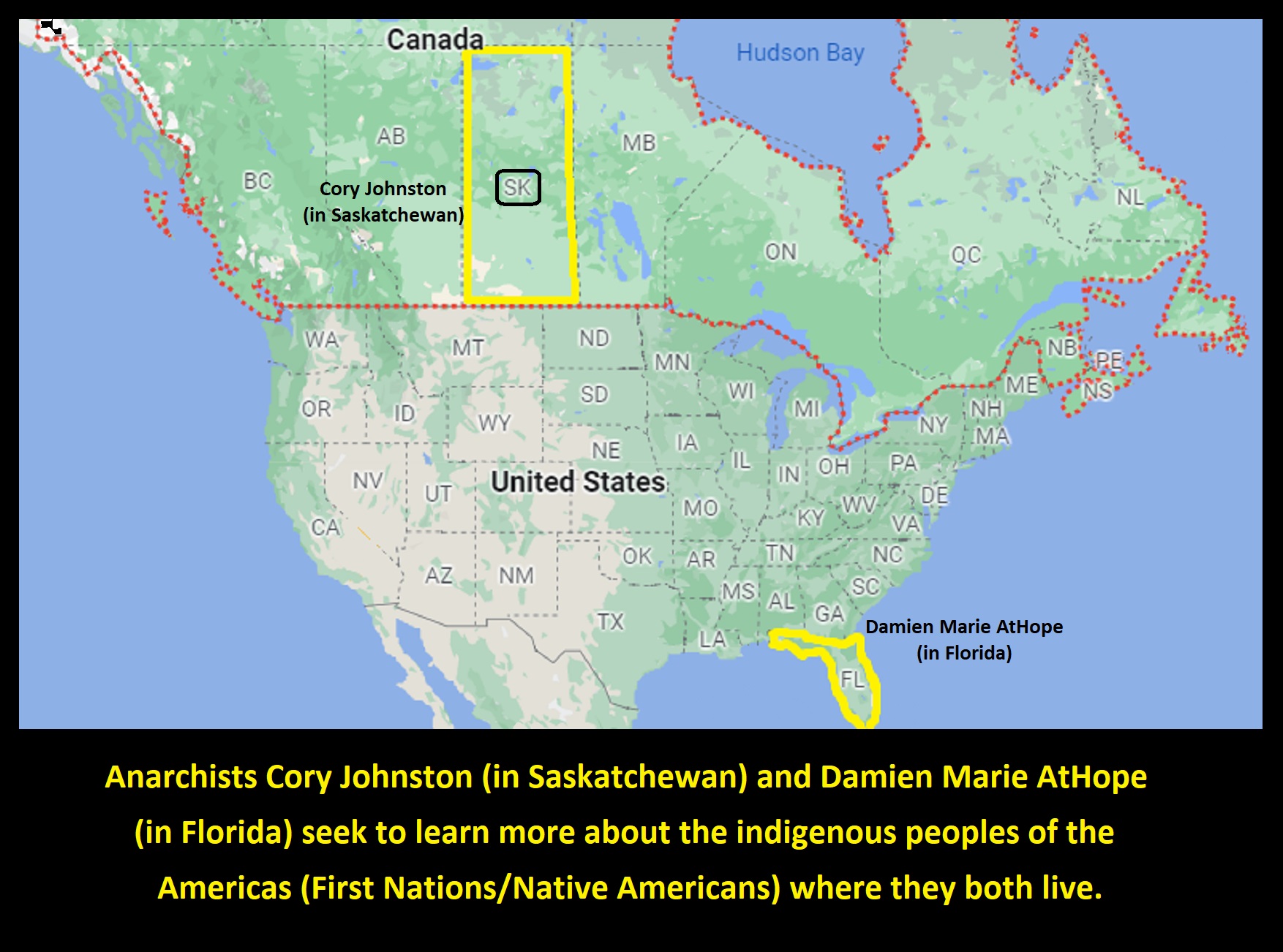
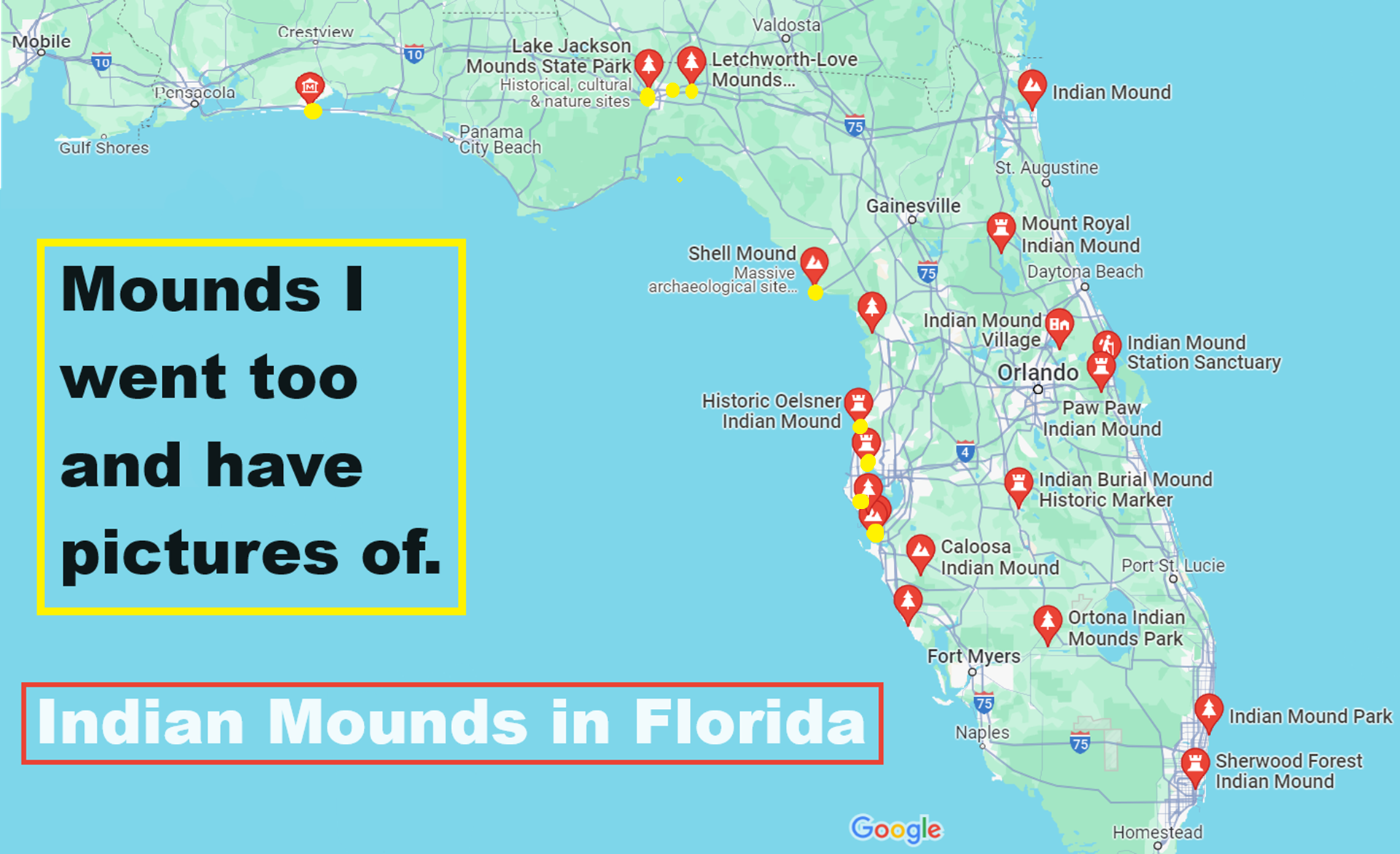

I visited and Investigated several Indian Mounds in Florida: the Crystal River Mounds, the Fort Walton Mound, Velda Mound, Lake Jackson Mounds, Letchworth-Love Mounds, Oelsner Indian Mound, Tocobaga Temple Mound, Indian Burial Mounds, and Madira Bickel Mound. It also addresses the cultures related to them as well as offers the origins of the mounds and the DNA origins of the related peoples.

Crystal River Mounds site photo by Damien Marie AtHope
Crystal River Archaeological State Park
“Crystal River State Archaeological Site is a 61-acre (250,000 m2) Florida State Park located on the Crystal River and within the Crystal River Preserve State Park. The park is located two miles (3 km) northwest of the city of Crystal River, on Museum Point off U.S. 19/98. Under the title of Crystal River Indian Mounds, it is also a U.S. National Historic Landmark (designated as such on June 21, 1990). Activities include salt and freshwater fishing, picnicing, bird watching, and a boat tour of Crystal River. Amenities include a small picnic area. The visitor center/museum features an open captioned video about the tribes that once lived in the area, and houses a collection of artifacts from the site, including arrowheads, pottery, jewelry, stone and bone tools. A centerpiece diorama dominates the interior of the museum, depicting a scale model of the site as it may have looked centuries before its abandonment.” ref
“The park contains a six-mound complex, occupied from the Deptford period through Santa Rosa-Swift Creek culture and up to the Late Fort Walton period. This timespan makes it one of the longest continually occupied sites in Florida, believed to have been occupied for 1,600 years. Native Americans traveled long distances to the complex to bury their dead and to engage in trading activities. An estimated 7,500 people may have visited the complex annually when it was occupied. The complex contains burial mounds, temple/platform mounds, a plaza area, and a midden. The earliest burials at the site are believed to be located in the conical mound and date back to about 250 BCE. Many of the people buried in this mound had copper tools and ornaments buried with them. The copper artifacts came from the Ohio River area through a trade network developed by the Hopewell culture that existed at the time.” ref
“There seemed to be indirect trading between the people who lived here and the Hopewell culture. People who were buried later did not have this type of artifact buried with them, and some burials do not contain artifacts. This tells us that over the 2,000 years that ancient people used the site, burial practices, and ceremonies changed. It also tells us that trading with the northern portions of North America changed. The shell and sand ring also contain burials, some of which were placed between layers of shells while others were not. It is not clear why this occurred or whether it was related to status or just a change in the burial customs. The platform was constructed as burials filled in the gap between the ring and the cone. It is estimated that about 1,200 to 1,500 people are buried in this complex.” ref
“Over a period of approximately 1,900 years, beginning about 500 BCE, the Native Americans at the Crystal River Site threw away great quantities of materials that would form the middens that adorn the site. This “midden material” contained various kinds of woodland animal bones, fish bones, turtle shells, broken pottery, broken hand tools, and arrowheads. By the time of abandonment, the midden area had reached 1,300 feet (400 m) in length, 100 feet (30 m) in width, 7 feet (2 m) in depth, and was formed into a crescent shape. Two large platform mounds are believed to have been used primarily for ceremonial purposes. A 1⁄2 mile (800 m) paved loop trail passes by each mound, with signs interpreting the mounds. A 55-step observation deck atop the park’s largest mound, Temple Mound, provides a panoramic view of the area. The park contains a coastal marsh and is part of the Great Florida Birding Trail.” ref
“The park is also home to a limestone slab, possibly a “stele“, on which is a crudely carved human face and torso. This is odd because the slab is one that is not found on other mound sites except in locations such as the Caribbean, South America, and Central America. At this particular site there were at least four of these large stones placed by the inhabitants in their ancient time. This carving shows that the person represented possessed long hair in a plume over the left shoulder. There has been debate as to how strongly this inscribed stone slab was influenced by the monumental stelae of Mesoamerica. Although there may be some evidence for contact between the Huastec Culture of the Mexican Gulf Coast and the American Southeast, those claims which suggest the most direct connections are probably unfounded. The slab is today housed on the site within a metal cage.” ref
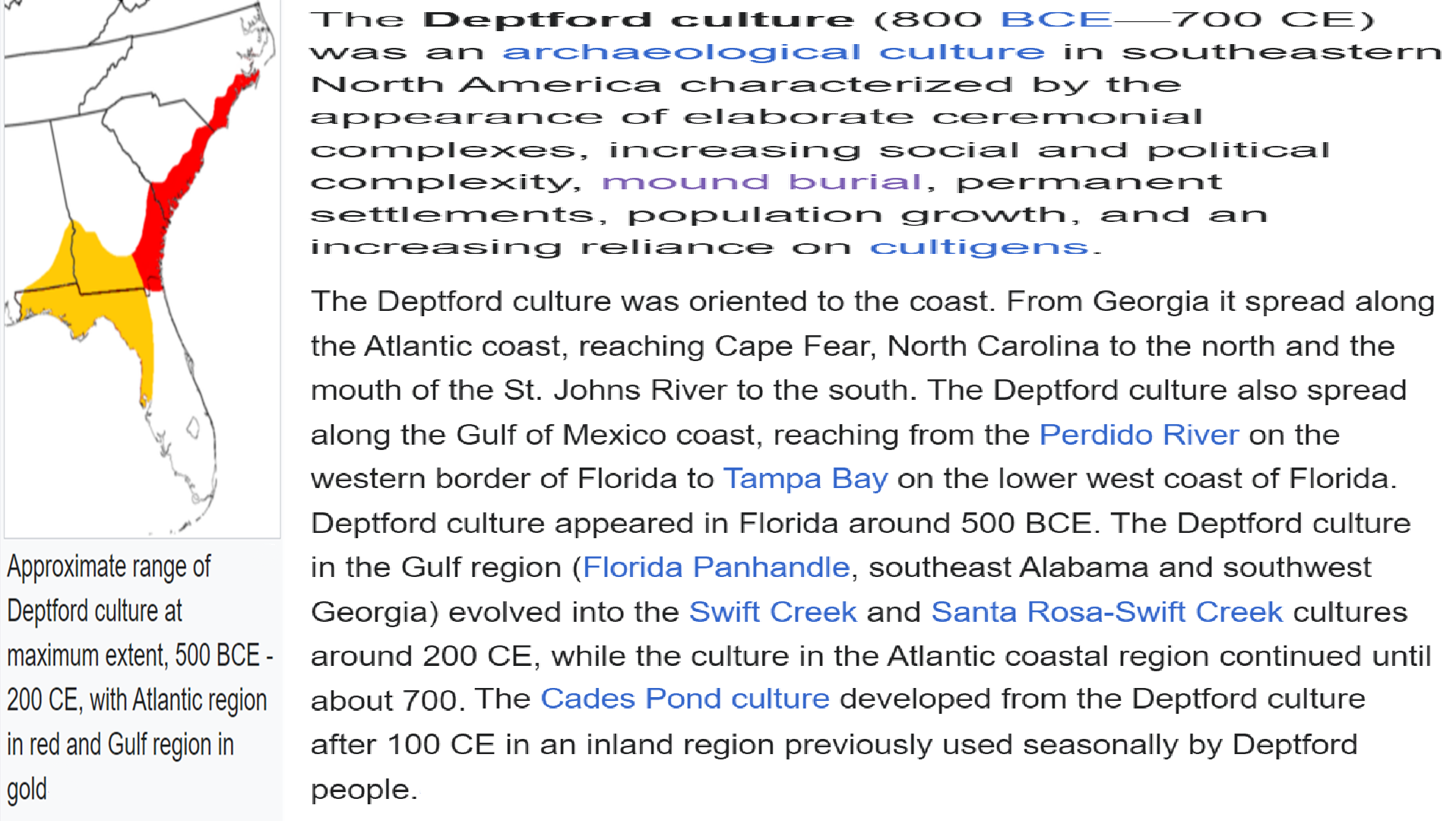
Deptford culture
“The Deptford culture (800 BCE—700 CE) was an archaeological culture in southeastern North America characterized by the appearance of elaborate ceremonial complexes, increasing social and political complexity, mound burial, permanent settlements, population growth, and an increasing reliance on cultigens. Deptford is named for the Deptford area near Savannah, Georgia. The culture is defined by the presence of sand-tempered pottery decorated with the impressions of carved wooden paddles that were pressed against the vessels before they were fired. The sand-tempering distinguishes Deptford ceramics from the fiber-tempered ceramics of the late-Archaic Stallings Island/St. Simons, Orange, and Norwood cultures that preceded it. Other contemporary cultures of the southeastern United States also produced paddle decorated ceramics.” ref
“The Deptford culture was oriented to the coast. From Georgi, it spread along the Atlantic coast, reaching Cape Fear, North Carolina, to the north, and the mouth of the St. Johns River to the south. The Deptford culture also spread along the Gulf of Mexico coast, reaching from the Perdido River on the western border of Florida to Tampa Bay on the lower west coast of Florida. Deptford culture appeared in Florida around 500 BCE. The Deptford culture in the Gulf region (Florida Panhandle, southeast Alabama, and southwest Georgia) evolved into the Swift Creek and Santa Rosa-Swift Creek cultures around 200 CE, while the culture in the Atlantic coastal region continued until about 700.” ref
“The Cades Pond culture developed from the Deptford culture after 100 CE in an inland region previously used seasonally by Deptford people. In the eastern Florida Panhandle the Deptford culture has been divided into an early Deptford period, in which fiber-tempered and Deptford series ceramics are found together; a middle Deptford period, with only Deptford series ceramics present, and a late Deptford period with both Deptford series and Swift Creek series ceramics present.” ref
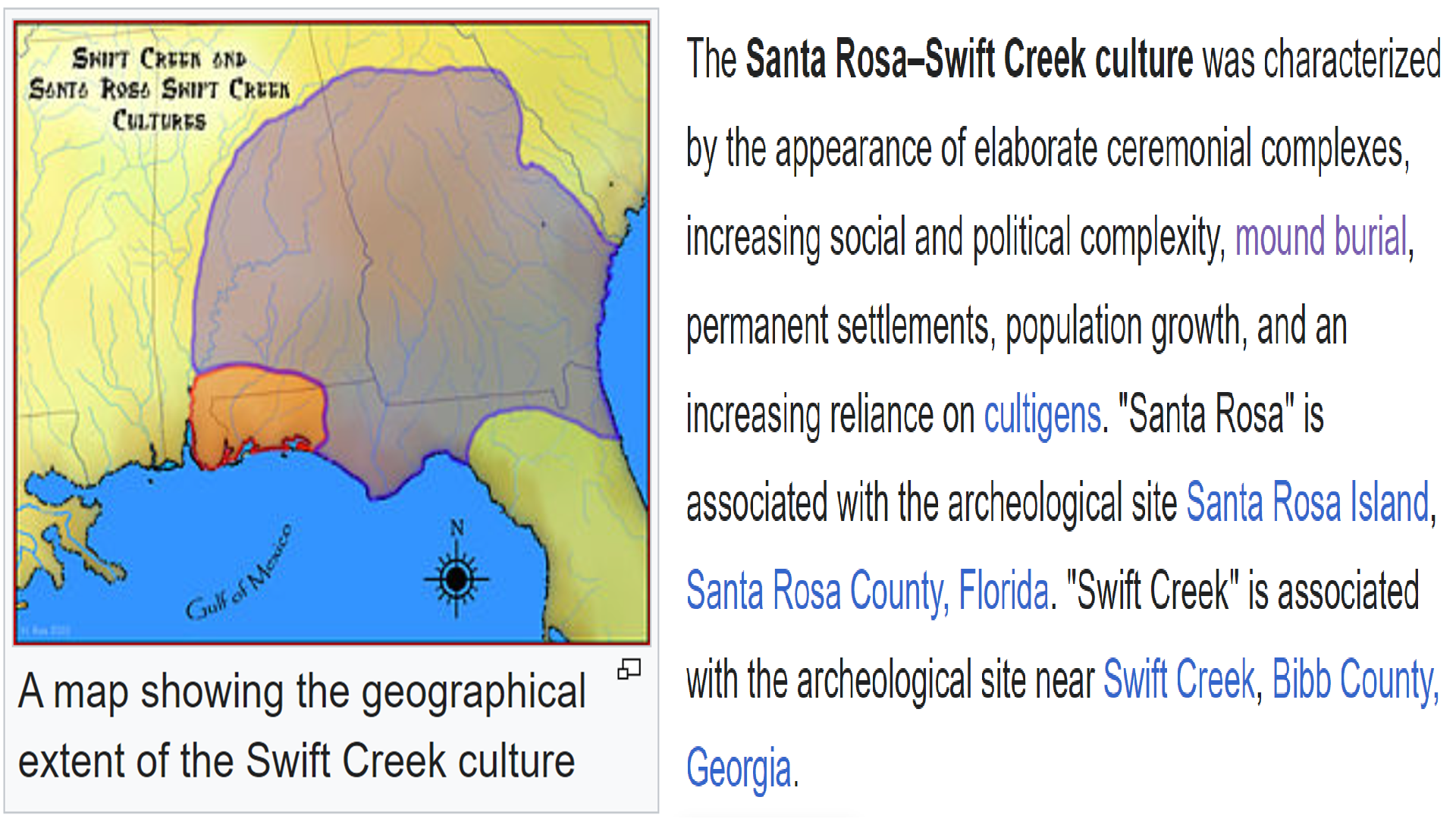
Santa Rosa–Swift Creek culture
“The Santa Rosa–Swift Creek culture was characterized by the appearance of elaborate ceremonial complexes, increasing social and political complexity, mound burial, permanent settlements, population growth, and an increasing reliance on cultigens. “Santa Rosa” is associated with the archeological site Santa Rosa Island, Santa Rosa County, Florida. “Swift Creek” is associated with the archeological site near Swift Creek, Bibb County, Georgia. The Early Woodland Deptford culture evolved in place to become the Santa Rosa–Swift Creek culture. Burial mounds have yielded trade items which include copper panpipes, ear ornaments, stone plummets, and stone gorgets. These show this area’s incorporation within the Hopewellian Interaction Sphere by about CE 100.” ref
“The Santa Rosa–Swift Creek culture extended over the western half of the Florida panhandle and immediately adjacent parts of Alabama. Sites have been found primarily around estuaries from St. Andrews Bay to Pensacola Bay. It is defined by a mixture of Swift Creek and Santa Rosa pottery types in village middens (Santa Rosa pottery is a variant of Marksville pottery). Four Santa Rosa–Swift Creek sites have been radiocarbon dated. Two sites in the Choctawhatchee Bay area have been dated to the period 150 to 450, while two sites in the Pensacola Bay area have been dated to the period 350 to 650. The later dates for the Santa Rosa–Swift Creek culture in the Pensacola Bay area seem to indicate a later adoption of the Santa Rosa–Swift Creek culture, as late Deptford ceramics have been dated to 260 in the Pensacola Bay area, but only to 150 in the Choctawhatchee Bay area. Santa Rosa ceramics appeared in both the Choctawhatchee Bay and Pensacola Bay areas by about 50 BCE.” ref
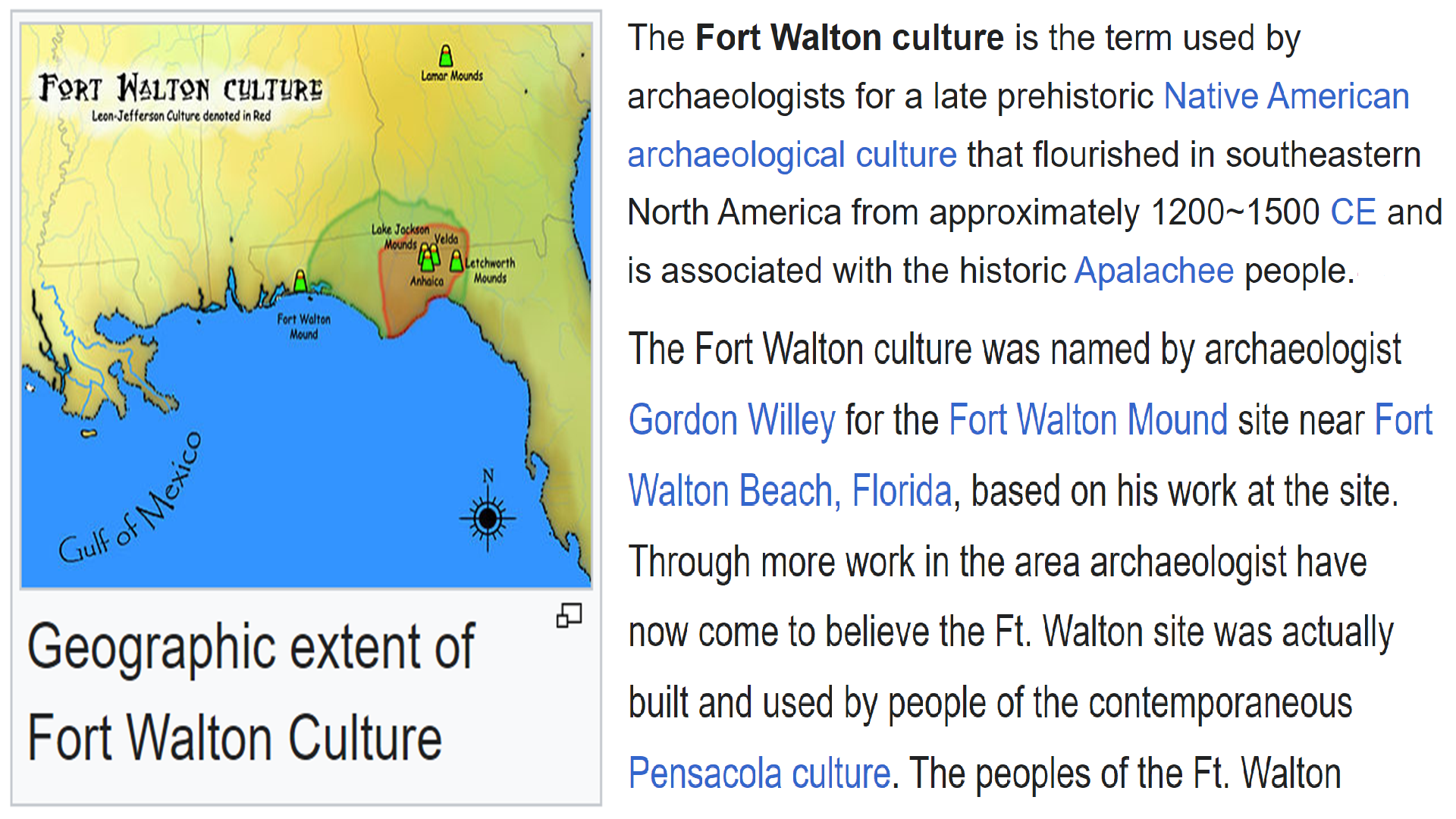
Fort Walton culture
“The Fort Walton culture is the term used by archaeologists for a late prehistoric Native American archaeological culture that flourished in southeastern North America from approximately 1200~1500 CE and is associated with the historic Apalachee people. The Fort Walton culture was named by archaeologist Gordon Willey for the Fort Walton Mound site near Fort Walton Beach, Florida, based on his work at the site. Through more work in the area archaeologist have now come to believe the Ft. Walton site was actually built and used by people of the contemporaneous Pensacola culture. The peoples of the Ft. Walton culture used mostly sand, grit, grog, or combinations of these materials as tempering agents in their pottery, whereas the Pensacola culture peoples used the more typical Mississippian culture shell tempering for their pottery. Using this unique combination of sand/grit/grog tempering as its criterion Fort Walton culture is now defined within the geographical area stretching from the Aucilla River in the east to a Pensacola–Fort Walton transitional area around Choctawhatchee Bay in the west and north into the interior of south Alabama and Georgia, 107 miles (172 km) up the Apalachicola River and 50 miles (80 km) up the Chattahoochee River.” ref
“Approximately 1000 to 1200 CE local Weeden Island peoples began adapting and adopting intensive maize agriculture, the building of platform mounds for ceremonial, political and religious purposes and making a new variety of ceramics, changes likely influenced by contact with the major Mississippian culture centers to the north and west. Early archaeologists thought that the Fort Walton culture represented the intrusion of peoples from Mexico or Mississippian cultures from the northwest replacing the indigenous Weeden Island peoples, but by the late 1970s this theory was generally discounted. Layouts and locations for Fort Walton sites are similar to other Mississippian culture sites, with the exception of sites in the Tallahassee Hills area, which, because of the local geography, are located around lakes and swamps instead of rivers. Settlement types include single-family homesteads, multi-family hamlets, small single mound centers, and large multi mound centers.” ref
“The hierarchical settlement patterns suggests the area may have had one or more paramount chiefdoms. By the Late Fort Walton period, increased contact with Lamar phase peoples from central Georgia saw another change in styles of decoration and manufacture of ceramics. This new phase is known as the Leon-Jefferson culture. This period saw the collapse of the chiefdoms as aboriginal populations declined following contact with European explorers and colonizers, such as the Hernando de Soto Expedition in 1539. The Fort Walton and later Leon-Jefferson peoples are the direct ancestors of the Apalachee peoples. Also, Mississippian culture pottery is found in the Fort Walton site.” ref
“The Lake Jackson Mounds site in Leon County is the largest known ceremonial center of the Fort Walton culture, although there are eight other known ceremonial sites in the Apalachee Province. It was occupied during the entire Fort Walton period, but abandoned at about 1500 CE when the capital of the chiefdom was moved to nearby Anhaica, the capital when the de Soto entrada encamped there in the winter of 1539. Another large site located nearby is the Velda Mound, which was occupied from approximately 1450 to 1625. Other sites include the Yon Mound and Village Site in Liberty County, and the Thick Greenbriar Site in Jackson County.” ref
Paramount Chief?
“A paramount chief is the English-language designation for a King/Queen or the highest-level political leader in a regional or local polity or country administered politically with a chief-based system. This term is used occasionally in anthropological and archaeological theory to refer to the rulers of multiple chiefdoms or the rulers of exceptionally powerful chiefdoms that have subordinated others. Paramount chiefs were identified by English-speakers as existing in Native American confederacies and regional chiefdoms, such as the Powhatan Confederacy and Piscataway Native Americans encountered by European colonists in the Chesapeake Bay region of North America. During the Victoria era, paramount chief was a formal title created by British colonial administrators in the British Empire and applied in Britain’s colonies in Asia and Africa. They used it as a substitute for the word “king” to ensure that only the British monarch held that title. Since the title “chief” was already used in terms of district and town administrators, the addition of “paramount” was made so as to distinguish between the ruling monarch and the local aristocracy.” ref
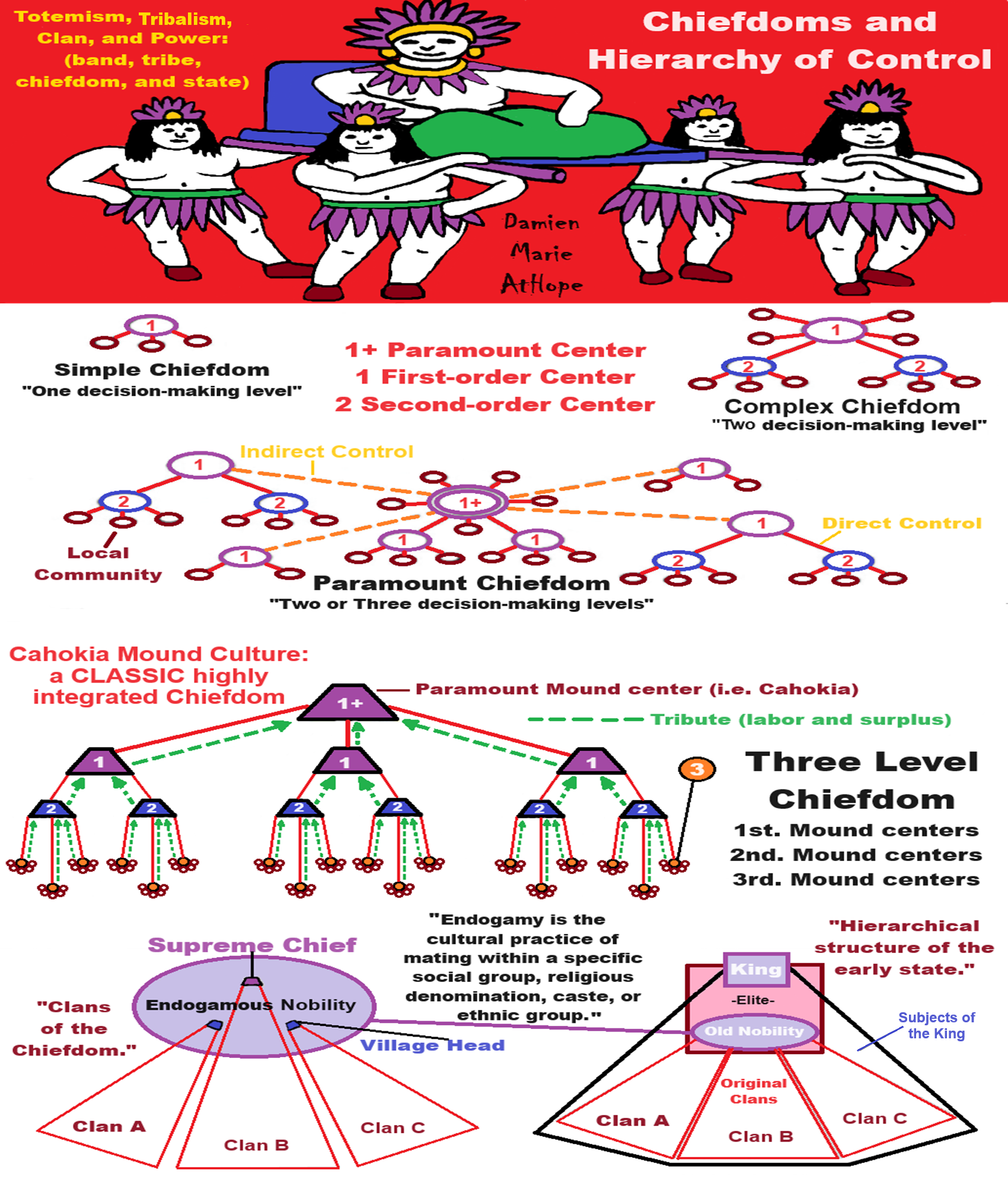
Bands, Tribes, Chiefdoms
“Another means of identifying the boundaries between modern and traditional societies was the categorization of the differences between the manner of their social organization and their driving mechanism. Based on the multi-criteria approach the American Elman Service was the first anthropologist to define the division of society into four groups, while his typology also reflected its evolutionary aspect. The division into bands, tribes, chieftain units, and states is still in current use today, though not without certain reservations. Critics point in particular to the problems that are associated with attempts to apply a typology that was created in relation to recent pre-industrial populations to societies that are identified only in historical or archaeological sources.” ref
“Smaller groups of hunter-gatherers are referred to as bands. In general, their members were related either by blood or by marriage. The bands lacked any formal chieftains, nor were there any striking differences in regard to the ownership of property or of social status between the members. The fact that the bands were both quite small and mobile was also reflected in the size and structure of their settlements. Modern examples of bands of this nature are the Bushmen of southern Africa and the Hadza in Tanzania.” ref
“According to Elman Service, generally the tribes were more significant than the bands, but only rarely did the number of their members attain several thousand people. Their diet usually comprised domestic resources. They were both sedentarised farmers and migrant herders. The tribe comprised a collection of individual communities (families, villages, etc.) that were mutually linked by family ties, either real or declared (i.e. claimed). Tribes usually lacked both official representatives and a “Capital City” because there was no need for an economic base in order to create power structures. The settlements took the form of homesteads or of villages. According to Service, this grouping was supposed to represent some sort of transitional form, somewhere between a band and a chiefdom.” ref
“As social organizations, chiefdoms were made up of several branches of various kinship groups or conical clans. Their members were internally differentiated in them on the basis of their kinship with a real or a mythological ancestor who was viewed as being the founder. The political representative of a society of this nature was a chieftain who inherited his position from within a specific defined circle of relatives. Prestige and status in the society were derived from how close the relationship between the individual and the chieftain was. This was also reflected in the funeral rites. The centralization of power was manifested primarily in the area of spiritual ceremonies and rituals. The authority of the chieftain largely coincided with his priestly functions. Another feature, therefore, was also the existence of a permanent sacred place. It must be admitted that there could be a large number of chieftain systems with different mechanisms of functioning that could co-exist. Historical traces of this can be found on the northwest coast of North America, for example.” ref
“The last category is that of the early states. They gave rise to a complexity that characterizes the more intricate social formations. Though the early states retained a number of the features of the chieftain groups, unlike them, these were societies of a non-relational type (i.e., status was acquired based on qualities, not on origin) stratified into different social classes. This gave rise to an elite that included officials, soldiers, and priests. The top level of this imaginary pyramid was occupied by the King. He had explicitly been given the power to implement laws and to enforce them, even by violent means. The institution of donation also ended in the early stages and was replaced by the levying of taxes.” ref
“Usually, the early states were small in terms of the size of their territory, often consisting of a single dominant city together with its economic hinterland. Because the state-building process was also regionally contagious, so to speak, several states coexisted in the area more or less on a regular basis. Inevitably, together, they formed an interactive network that dynamically transformed its goals from peacekeeping to war. The King had become the King of Kings by conquering the neighboring rulers, and inevitably, his empires ceased to meet the requisite criteria for being an early stage.” ref
“All cultures have one element in common: they somehow exercise social control over their own members. Like the “invisible hand” of the market to which Adam Smith refers in analyzing the workings of capitalism, two forces govern the workings of politics: power—the ability to induce behavior of others in specified ways by means of coercion or use or threat of physical force—and authority—the ability to induce behavior of others by persuasion. Extreme examples of the exercise of power are the gulags (prison camps) in Stalinist Russia, the death camps in Nazi-ruled Germany and Eastern Europe, and so-called Supermax prisons such as Pelican Bay in California and the prison for “enemy combatants” in Guantanamo Bay, Cuba, by the United States. In all of these settings, prisoners comply or are punished or executed. At the other extreme are most forager societies, which typically exercise authority more often than power. Groups in those societies comply with the wishes of their most persuasive members.” ref
“In actuality, power and authority are points on a continuum, and both are present in every society to some degree. Even Hitler, who exercised absolute power in many ways, had to hold the Nuremberg rallies to generate popular support for his regime and persuade the German population that his leadership was the way to national salvation. In the Soviet Union, leaders had a great deal of coercive and physical power but still felt the need to hold parades and mass rallies on May Day every year to persuade people to remain attached to their vision of a communal society. At the other end of the political spectrum, societies that tend to use persuasion through authority also have some forms of coercive power. Among the Inuit, for example, individuals who flagrantly violated group norms could be punished, including by homicide.” ref
“A related concept in both politics and law is legitimacy: the perception that an individual has a valid right to leadership. Legitimacy is particularly applicable to complex societies that require centralized decision-making. Historically, the right to rule has been based on various principles. In agricultural states such as ancient Mesopotamia, the Aztec, and the Inca, justification for the rule of particular individuals was based on hereditary succession and typically granted to the eldest son of the ruler. Even this principle could be uncertain at times, as was the case when the Inca emperor Atahualpa had just defeated his rival and brother Huascar when the Spaniards arrived in Peru in 1533.” ref
“In many cases, supernatural beliefs were invoked to establish legitimacy and justify rule by an elite. Incan emperors derived their right to rule from the Sun God and Aztec rulers from Huitzilopochtli (Hummingbird-to-the-Left). European monarchs invoked a divine right to rule that was reinforced by the Church of England in Britain and by the Roman Catholic Church in other countries prior to the Reformation. In India, the dominance of the Brahmin elite over the other castes is justified by karma, cumulative forces created by good and evil deeds in past lives. Secular equivalents also serve to justify rule by elites; examples include the promise of a worker’s paradise in the former Soviet Union and racial purity of Aryans in Nazi Germany. In the United States and other democratic forms of government, legitimacy rests on the consent of the governed in periodic elections (though in the United States, the incoming president is sworn in using a Christian Bible despite the alleged separation of church and state).” ref
“In some societies, dominance by an individual or group is viewed as unacceptable. Christopher Boehm (1999) developed the concept of reverse dominance to describe societies in which people rejected attempts by any individual to exercise power. They achieved this aim using ridicule, criticism, disobedience, and strong disapproval and could banish extreme offenders. Richard Lee encountered this phenomenon when he presented the !Kung with whom he had worked over the preceding year with a fattened ox. Rather than praising or thanking him, his hosts ridiculed the beast as scrawny, ill fed, and probably sick. This behavior is consistent with reverse dominance.” ref
“Even in societies that emphasize equality between people, decisions still have to be made. Sometimes, particularly persuasive figures such as headmen make them, but persuasive figures who lack formal power are not free to make decisions without coming to a consensus with their fellows. To reach such a consensus, there must be general agreement. Essentially, then, even if in a backhanded way, legitimacy characterizes societies that lack institutionalized leadership. Another set of concepts refers to the reinforcements or consequences for compliance with the directives and laws of a society. Positive reinforcements are the rewards for compliance; examples include medals, financial incentives, and other forms of public recognition. Negative reinforcements punish noncompliance through fines, imprisonment, and death sentences. These reinforcements can be identified in every human society, even among foragers or others who have no written system of law. Reverse dominance is one form of negative reinforcement.” ref
“If cultures of various sizes and configurations are to be compared, there must be some common basis for defining political organization. In many small communities, the family functions as a political unit. As Julian Steward wrote about the Shoshone, a Native American group in the Nevada basin, “all features of the relatively simple culture were integrated and functioned on a family level. The family was the reproductive, economic, educational, political, and religious unit.” In larger more complex societies, however, the functions of the family are taken over by larger social institutions. The resources of the economy, for example, are managed by authority figures outside the family who demand taxes or other tribute. The educational function of the family may be taken over by schools constituted under the authority of a government, and the authority structure in the family is likely to be subsumed under the greater power of the state. Therefore, anthropologists need methods for assessing political organizations that can be applied to many different kinds of communities. This concept is called levels of socio-cultural integration.” ref
“Elman Service developed an influential scheme for categorizing the political character of societies that recognized four levels of socio-cultural integration: band, tribe, chiefdom, and state. A band is the smallest unit of political organization, consisting of only a few families and no formal leadership positions. Tribes have larger populations but are organized around family ties and have fluid or shifting systems of temporary leadership. Chiefdoms are large political units in which the chief, who usually is determined by heredity, holds a formal position of power. States are the most complex form of political organization and are characterized by a central government that has a monopoly over legitimate uses of physical force, a sizeable bureaucracy, a system of formal laws, and a standing military force.” ref
“Each type of political integration can be further categorized as egalitarian, ranked, or stratified. Band societies and tribal societies generally are considered egalitarian—there is no great difference in status or power between individuals and there are as many valued status positions in the societies as there are persons able to fill them. Chiefdoms are ranked societies; there are substantial differences in the wealth and social status of individuals based on how closely related they are to the chief. In ranked societies, there are a limited number of positions of power or status, and only a few can occupy them. State societies are stratified. There are large differences in the wealth, status, and power of individuals based on unequal access to resources and positions of power. Socio-economic classes, for instance, are forms of stratification in many state societies.” ref
“In a complex society, it may seem that social classes—differences in wealth and status—are, like death and taxes, inevitable: that one is born into wealth, poverty, or somewhere in between and has no say in the matter, at least at the start of life, and that social class is an involuntary position in society. However, is social class universal? As they say, let’s look at the record, in this case, ethnographies. We find that among foragers, there is no advantage to hoarding food; in most climates, it will rot before one’s eyes. Nor is there much personal property, and leadership, where it exists, is informal. In forager societies, the basic ingredients for social class do not exist. Foragers such as the !Kung, Inuit, and aboriginal Australians, are egalitarian societies in which there are few differences between members in wealth, status, and power. Highly skilled and less skilled hunters do not belong to different strata in the way that the captains of industry do from you and me. The less skilled hunters in egalitarian societies receive a share of the meat and have the right to be heard on important decisions. Egalitarian societies also lack a government or centralized leadership. Their leaders, known as headmen or big men, emerge by consensus of the group. Foraging societies are always egalitarian, but so are many societies that practice horticulture or pastoralism. In terms of political organization, egalitarian societies can be either bands or tribes.” ref
BAND-LEVEL POLITICAL ORGANIZATION
“Societies organized as a band typically comprise foragers who rely on hunting and gathering and are therefore nomadic, are few in number (rarely exceeding 100 persons), and form small groups consisting of a few families and a shifting population. Bands lack formal leadership. Richard Lee went so far as to say that the Dobe! Kung had no leaders. To quote one of his informants, “Of course, we have headmen. Each one of us is headman over himself.” At most, a band’s leader is primus inter pares or “first among equals” assuming anyone is first at all. Modesty is a valued trait; arrogance and competitiveness are not acceptable in societies characterized by reverse dominance. What leadership there is in band societies tends to be transient and subject to shifting circumstances. For example, among the Paiute in North America, “rabbit bosses” coordinated rabbit drives during the hunting season but played no leadership role otherwise. Some “leaders” are excellent mediators who are called on when individuals are involved in disputes, while others are perceived as skilled shamans or future-seers who are consulted periodically. There are no formal offices or rules of succession.” ref
“Bands were probably the first political unit to come into existence outside the family itself. There is some debate in anthropology about how the earliest bands were organized. Elman Service argued that patrilocal bands organized around groups of related men served as the prototype, reasoning that groups centered on male family relationships made sense because male cooperation was essential to hunting. M. Kay Martin and Barbara Voorhies pointed out in rebuttal that gathering vegetable foods, which typically was viewed as women’s work, actually contributed a greater number of calories in most cultures and thus that matrilocal bands organized around groups of related women would be closer to the norm..Indeed, in societies in which hunting is the primary source of food, such as the Inuit, women tend to be subordinate to men while men and women tend to have roughly equal status in societies that mainly gather plants for food.” ref
Law in Band Societies
“Within bands of people, disputes are typically resolved informally. There are no formal mediators or any organizational equivalent of a court of law. A good mediator may emerge—or may not. In some cultures, duels are employed. Among the Inuit, for example, disputants engage in a duel using songs in which, drum in hand, they chant insults at each other before an audience. The audience selects the better chanter and thereby the winner in the dispute. The Mbuti of the African Congo use ridicule; even children berate adults for laziness, quarreling, or selfishness. If ridicule fails, the Mbuti elders evaluate the dispute carefully, determine the cause, and, in extreme cases, walk to the center of the camp and criticize the individuals by name, using humor to soften their criticism—the group, after all, must get along.” ref
Warfare in Band Societies
“Nevertheless, conflict does sometimes break out into war between bands and, sometimes, within them. Such warfare is usually sporadic and short-lived since bands do not have formal leadership structures or enough warriors to sustain conflict for long. Most of the conflict arises from interpersonal arguments. Among the Tiwi of Australia, for example, failure of one band to reciprocate another band’s wife-giving with one of its own female relative led to abduction of women by the aggrieved band, precipitating a “war” that involved some spear-throwing (many did not shoot straight and even some of the onlookers were wounded) but mostly violent talk and verbal abuse. For the Dobe !Kung, Lee found 22 cases of homicide by males and other periodic episodes of violence, mostly in disputes over women—not quite the gentle souls Elizabeth Marshall Thomas depicted in her Harmless People.” ref
TRIBAL POLITICAL ORGANIZATION
“Whereas bands involve small populations without structure, tribal societies involve at least two well-defined groups linked together in some way and range in population from about 100 to as many as 5,000 people. Though their social institutions can be fairly complex, there are no centralized political structures or offices in the strict sense of those terms. There may be headmen, but there are no rules of succession, and sons do not necessarily succeed their fathers as is the case with chiefdoms. Tribal leadership roles are open to anyone—in practice, usually men, especially elder men who acquire leadership positions because of their personal abilities and qualities. Leaders in tribes do not have a means of coercing others or formal powers associated with their positions. Instead, they must persuade others to take actions they feel are needed. A Yanomami headsman, for instance, said that he would never issue an order unless he knew it would be obeyed. The headman Kaobawä exercised influence by example and by making suggestions and warning of consequences of taking or not taking an action.” ref
“Like bands, tribes are egalitarian societies. Some individuals in a tribe do sometimes accumulate personal property but not to the extent that other tribe members are deprived. And every (almost always male) person has the opportunity to become a headman or leader and, like bands, one’s leadership position can be situational. One man may be a good mediator, another an exemplary warrior, and a third capable of leading a hunt or finding a more ideal area for cultivation or grazing herds. An example illustrating this kind of leadership is the big man of New Guinea; the term is derived from the languages of New Guinean tribes (literally meaning “man of influence”). The big man is one who has acquired followers by doing favors they cannot possibly repay, such as settling their debts or providing bride-wealth. He might also acquire as many wives as possible to create alliances with his wives’ families. His wives could work to care for as many pigs as possible, for example, and in due course, he could sponsor a pig feast that would serve to put more tribe members in his debt and shame his rivals. It is worth noting that the followers, incapable of repaying the Big Man’s gifts, stand metaphorically as beggars to him.” ref
“Still, a big man does not have the power of a monarch. His role is not hereditary. His son must demonstrate his worth and acquire his own following—he must become a big man in his own right. Furthermore, there usually are other big men in the village who are his potential rivals. Another man who proves himself capable of acquiring a following can displace the existing big man. The big man also has no power to coerce—no army or police force. He cannot prevent a follower from joining another big man, nor can he force the follower to pay any debt owed. There is no New Guinean equivalent of a U.S. marshal. Therefore, he can have his way only by diplomacy and persuasion—which do not always work.” ref
Tribal Systems of Social Integration
Tribal societies have much larger populations than bands and thus must have mechanisms for creating and maintaining connections between tribe members. The family ties that unite members of a band are not sufficient to maintain solidarity and cohesion in the larger population of a tribe. Some of the systems that knit tribes together are based on family (kin) relationships, including various kinds of marriage and family lineage systems, but there are also ways to foster tribal solidarity outside of family arrangements through systems that unite members of a tribe by age or gender.” ref
Integration through Age Grades and Age Sets
Tribes use various systems to encourage solidarity or feelings of connectedness between people who are not related by family ties. These systems, sometimes known as sodalities, unite people across family groups. In one sense, all societies are divided into age categories. In the U.S. educational system, for instance, children are matched to grades in school according to their age—six-year-olds in first grade and thirteen-year-olds in eighth grade. Other cultures, however, have established complex age-based social structures. Many pastoralists in East Africa, for example, have age grades and age sets. Age sets are named categories to which men of a certain age are assigned at birth. Age grades are groups of men who are close to one another in age and share similar duties or responsibilities. All men cycle through each age grade over the course of their lifetimes. As the age sets advance, the men assume the duties associated with each age grade.” ref
“An example of this kind of tribal society is the Tiriki of Kenya. From birth to about fifteen years of age, boys become members of one of seven named age sets. When the last boy is recruited, that age set closes, and a new one opens. For example, young and adult males who belonged to the “Juma” age set in 1939 became warriors by 1954. The “Mayima” were already warriors in 1939 and became elder warriors during that period. In precolonial times, men of the warrior age grade defended the herds of the Tiriki and conducted raids on other tribes while the elder warriors acquired cattle and houses and took on wives. There were recurring reports of husbands who were much older than their wives, who had married early in life, often as young as fifteen or sixteen. As solid citizens of the Tiriki, the elder warriors also handled decision-making functions of the tribe as a whole; their legislation affected the entire village while also representing their own kin groups. The other age sets also moved up through age grades in the fifteen-year period.” ref
“The elder warriors in 1939, “Nyonje,” became the judicial elders by 1954. Their function was to resolve disputes that arose between individuals, families, and kin groups, of which some elders were a part. The “Jiminigayi,” judicial elders in 1939, became ritual elders in 1954, handling supernatural functions that involved the entire Tiriki community. During this period, the open age set was “Kabalach.” Its prior members had all grown old or died by 1939 and new boys joined it between 1939 and 1954. Thus, the Tiriki age sets moved in continuous 105-year cycles. This age grade and age set system encourages bonds between men of similar ages. Their loyalty to their families is tempered by their responsibilities to their fellows of the same age.” ref
“Among most, if not all, tribes of New Guinea, the existence of men’s houses serves to cut across family lineage groups in a village. Perhaps the most fastidious case of male association in New Guinea is the bachelor association of the Mae-Enga, who live in the northern highlands. In their culture, a boy becomes conscious of the distance between males and females before he leaves home at age five to live in the men’s house. Women are regarded as potentially unclean, and strict codes that minimize male-female relations are enforced. Sanggai festivals reinforce this division. During the festival, every youth of age 15 or 16 goes into seclusion in the forest and observes additional restrictions, such as avoiding pigs (which are cared for by women) and avoiding gazing at the ground lest he see female footprints or pig feces. One can see, therefore, that every boy commits his loyalty to the men’s house early in life even though he remains a member of his birth family. Men’s houses are the center of male activities. There, they draw up strategies for warfare, conduct ritual activities involving magic and honoring of ancestral spirits, and plan and rehearse periodic pig feasts.” ref
“Exchanges and the informal obligations associated with them are primary devices by which bands and tribes maintain a degree of order and forestall armed conflict, which was viewed as the “state of nature” for tribal societies by Locke and Hobbes, in the absence of exercises of force by police or an army. Marcel Mauss, nephew and student of eminent French sociologist Emile Durkheim, attempted in 1925 to explain gift giving and its attendant obligations cross-culturally in his book, The Gift: Forms and Functions of Exchange in Archaic Societies. He started with the assumption that two groups have an imperative to establish a relationship of some kind. There are three options when they meet for the first time. They could pass each other by and never see each other again. They may resort to arms with an uncertain outcome. One could wipe the other out or, more likely, win at great cost of men and property or fight to a draw. The third option is to “come to terms” with each other by establishing a more or less permanent relationship. Exchanging gifts is one way for groups to establish this relationship.” ref
“These gift exchanges are quite different from Western ideas about gifts. In societies that lack a central government, formal law enforcement powers, and collection agents, the gift exchanges are obligatory and have the force of law in the absence of law. Mauss referred to them as “total prestations.” Though no Dun and Bradstreet agents would come to collect, the potential for conflict that could break out at any time reinforced the obligations. According to Mauss, the first obligation is to give; it must be met if a group is to extend social ties to others. The second obligation is to receive; refusal of a gift constitutes rejection of the offer of friendship as well. Conflicts can arise from the perceived insult of a rejected offer. The third obligation is to repay. One who fails to make a gift in return will be seen as in debt—in essence, a beggar. Mauss offered several ethnographic cases that illustrated these obligations. Every gift conferred power to the giver, expressed by the Polynesian terms mana (an intangible supernatural force) and hau (among the Maori, the “spirit of the gift,” which must be returned to its owner). Marriage and its associated obligations also can be viewed as a form of gift-giving as one family “gives” a bride or groom to the other.” ref
“Understanding social solidarity in tribal societies requires knowledge of family structures, which are also known as kinship systems. The romantic view of marriage in today’s mass media is largely a product of Hollywood movies and romance novels from mass-market publishers such as Harlequin. In most cultures around the world, marriage is largely a device that links two families together; this is why arranged marriage is so common from a cross-cultural perspective. And, as Voltaire admonished, if we are to discuss anything, we need to define our terms. Marriage is defined in numerous ways, usually (but not always) involving a tie between a woman and a man. Same-sex marriage is also common in many cultures. Nuclear families consist of parents and their children. Extended families consist of three generations or more of relatives connected by marriage and descent.” ref
“Bilateral descent (commonly used in the United States) recognizes both the mother’s and the father’s “sides” of the family while unilineal descent recognizes only one sex-based “side” of the family. Unilineal descent can be patrilineal, recognizing only relatives through a line of male ancestors, or matrilineal, recognizing only relatives through a line of female ancestors. Groups made up of two or more extended families can be connected as larger groups linked by kinship ties. A lineage consists of individuals who can trace or demonstrate their descent through a line of males or females to the founding ancestor. Most tribal societies’ political organizations involve marriage, which is a logical vehicle for creating alliances between groups. One of the most well-documented types of marriage alliance is bilateral cross-cousin marriage in which a man marries his cross-cousin—one he is related to through two links, his father’s sister and his mother’s brother.” ref
“These marriages have been documented among the Yanomami, an indigenous group living in Venezuela and Brazil. Yanomami villages are typically populated by two or more extended family groups also known as lineages. Disputes and disagreements are bound to occur, and these tensions can potentially escalate to open conflict or even physical violence. Bilateral cross-cousin marriage provides a means of linking lineage groups together over time through the exchange of brides. Because cross-cousin marriage links people together by both marriage and blood ties (kinship), these unions can reduce tension between the groups or at least provide an incentive for members of rival lineages to work together.” ref
“Another type of kin-based integrative mechanism is a segmentary lineage. As previously noted, a lineage is a group of people who can trace or demonstrate their descent from a founding ancestor through a line of males or a line of females. A segmentary lineage is a hierarchy of lineages that contains both close and relatively distant family members. At the base are several minimal lineages whose members trace their descent from their founder back two or three generations. At the top is the founder of all of the lineages, and two or more maximal lineages can derive from the founder’s lineage. Between the maximal and the minimal lineages are several intermediate lineages.” ref
“The classic examples of segmentary lineages were described by E. E. Evans-Pritchard (1940) in his discussion of the Nuer, pastoralists who lived in southern Sudan. Paul Bohannan also described this system among the Tiv, who were West African pastoralists, and Robert Murphy and Leonard Kasdan analyzed the importance of these lineages among the Bedouin of the Middle East. Segmentary lineages often develop in environments in which a tribal society is surrounded by several other tribal societies. Hostility between the tribes induces their members to retain ties with their kin and to mobilize them when external conflicts arise. An example of this is ties maintained between the Nuer and the Dinka. Once a conflict is over, segmentary lineages typically dissolve into their constituent units. Another attribute of segmentary lineages is local genealogical segmentation, meaning close lineages dwell near each other, providing a physical reminder of their genealogy.” ref
Law in Tribal Societies
“Tribal societies generally lack systems of codified law whereby damages, crimes, remedies, and punishments are specified. Only state-level political systems can determine, usually by writing formal laws, which behaviors are permissible and which are not (discussed later in this chapter). In tribes, there are no systems of law enforcement whereby an agency such as the police, the sheriff, or an army can enforce laws enacted by an appropriate authority. And, as already noted, headman and big men cannot force their will on others.” ref
In tribal societies, as in all societies, conflicts arise between individuals. Sometimes the issues are equivalent to crimes—taking of property or commitment of violence—that are not considered legitimate in a given society. Other issues are civil disagreements—questions of ownership, damage to property, an accidental death. In tribal societies, the aim is not so much to determine guilt or innocence or to assign criminal or civil responsibility as it is to resolve conflict, which can be accomplished in various ways. The parties might choose to avoid each other. Bands, tribes, and kin groups often move away from each other geographically, which is much easier for them to do than for people living in complex societies.” ref
One issue in tribal societies, as in all societies, is guilt or innocence. When no one witnesses an offense or an account is deemed unreliable, tribal societies sometimes rely on the supernatural. Oaths, for example, involve calling on a deity to bear witness to the truth of what one says; the oath given in court is a holdover from this practice. An ordeal is used to determine guilt or innocence by submitting the accused to dangerous, painful, or risky tests believed to be controlled by supernatural forces. The poison oracle used by the Azande of the Sudan and the Congo is an ordeal based on their belief that most misfortunes are induced by witchcraft (in this case, witchcraft refers to ill feeling of one person toward another). A chicken is force fed a strychnine concoction known as benge just as the name of the suspect is called out. If the chicken dies, the suspect is deemed guilty and is punished or goes through reconciliation.” ref
“A more commonly exercised option is to find ways to resolve the dispute. In small groups, an unresolved question can quickly escalate to violence and disrupt the group. The first step is often negotiation; the parties attempt to resolve the conflict by direct discussion in hope of arriving at an agreement. Offenders sometimes make a ritual apology, particularly if they are sensitive to community opinion. In Fiji, for example, offenders make ceremonial apologies called i soro, one of the meanings of which is “I surrender.” An intermediary speaks, offers a token gift to the offended party, and asks for forgiveness, and the request is rarely rejected.” ref
“When negotiation or a ritual apology fails, often the next step is to recruit a third party to mediate a settlement as there is no official who has the power to enforce a settlement. A classic example in the anthropological literature is the Leopard Skin Chief among the Nuer, who is identified by a leopard skin wrap around his shoulders. He is not a chief but is a mediator. The position is hereditary, has religious overtones, and is responsible for the social well-being of the tribal segment. He typically is called on for serious matters such as murder. The culprit immediately goes to the residence of the Leopard Skin Chief, who cuts the culprit’s arm until blood flows. If the culprit fears vengeance by the dead man’s family, he remains at the residence, which is considered a sanctuary, and the Leopard Skin Chief then acts as a go-between for the families of the perpetrator and the dead man.” ref
“The Leopard Skin Chief cannot force the parties to settle and cannot enforce any settlement they reach. The source of his influence is the desire for the parties to avoid a feud that could escalate into an ever-widening conflict involving kin descended from different ancestors. He urges the aggrieved family to accept compensation, usually in the form of cattle. When such an agreement is reached, the chief collects the 40 to 50 head of cattle and takes them to the dead man’s home, where he performs various sacrifices of cleansing and atonement. This discussion demonstrates the preference most tribal societies have for mediation given the potentially serious consequences of a long-term feud. Even in societies organized as states, mediation is often preferred. In the agrarian town of Talea, Mexico, for example, even serious crimes are mediated in the interest of preserving a degree of local harmony. The national authorities often tolerate local settlements if they maintain the peace.” ref
Warfare in Tribal Societies
“What happens if mediation fails and the Leopard Skin Chief cannot convince the aggrieved clan to accept cattle in place of their loved one? War. In tribal societies, wars vary in cause, intensity, and duration, but they tend to be less deadly than those run by states because of tribes’ relatively small populations and limited technologies. Tribes engage in warfare more often than bands, both internally and externally. Among pastoralists, both successful and attempted thefts of cattle frequently spark conflict. Among pre-state societies, pastoralists have a reputation for being the most prone to warfare.” ref
“However, horticulturalists also engage in warfare, as the film Dead Birds, which describes warfare among the highland Dani of west New Guinea (Irian Jaya), attests. Among anthropologists, there is a “protein debate” regarding causes of warfare. Marvin Harris in a 1974 study of the Yanomami claimed that warfare arose there because of a protein deficiency associated with a scarcity of game, and Kenneth Good supported that thesis in finding that the game a Yanomami villager brought in barely supported the village. He could not link this variable to warfare, however. In rebuttal, Napoleon Chagnon linked warfare among the Yanomami with abduction of women rather than disagreements over hunting territory, and findings from other cultures have tended to agree with Chagnon’s theory.” ref
“Tribal wars vary in duration. Raids are short-term uses of physical force that are organized and planned to achieve a limited objective such as acquisition of cattle (pastoralists) or other forms of wealth and, often, abduction of women, usually from neighboring communities. Feuds are longer in duration and represent a state of recurring hostilities between families, lineages, or other kin groups. In a feud, the responsibility to avenge rests with the entire group, and the murder of any kin member is considered appropriate because the kin group as a whole is considered responsible for the transgression. Among the Dani, for example, vengeance is an obligation; spirits are said to dog the victim’s clan until its members murder someone from the perpetrator’s clan.” ref
RANKED SOCIETIES AND CHIEFDOMS
“Unlike egalitarian societies, ranked societies (sometimes called “rank societies”) involve greater differentiation between individuals and the kin groups to which they belong. These differences can be, and often are, inherited, but there are no significant restrictions in these societies on access to basic resources. All individuals can meet their basic needs. The most important differences between people of different ranks are based on sumptuary rules—norms that permit persons of higher rank to enjoy greater social status by wearing distinctive clothing, jewelry, and/or decorations denied those of lower rank. Every family group or lineage in the community is ranked in a hierarchy of prestige and power. Furthermore, within families, siblings are ranked by birth order, and villages can also be ranked.” ref
“The concept of a ranked society leads us directly to the characteristics of chiefdoms. Unlike the position of headman in a band, the position of chief is an office—a permanent political status that demands a successor when the current chief dies. There are, therefore, two concepts of chief: the man (women rarely, if ever, occupy these posts) and the office. Thus the expression “The king is dead, long live the king.” With the New Guinean big man, there is no formal succession. Other big men will be recognized and eventually take the place of one who dies, but there is no rule stipulating that his eldest son or any son must succeed him. For chiefs, there must be a successor, and there are rules of succession.” ref
“Political chiefdoms usually are accompanied by an economic exchange system known as redistribution in which goods and services flow from the population at large to the central authority represented by the chief. It then becomes the task of the chief to return the flow of goods in another form. The chapter on economics provides additional information about redistribution economies. These political and economic principles are exemplified by the potlatch custom of the Kwakwaka’wakw and other indigenous groups who lived in chiefdom societies along the northwest coast of North America from the extreme northwest tip of California through the coasts of Oregon, Washington, British Columbia, and southern Alaska. Potlatch ceremonies observed major events such as births, deaths, marriages of important persons, and installment of a new chief.” ref
“Families prepared for the event by collecting food and other valuables such as fish, berries, blankets, animal skins, carved boxes, and copper. At the potlatch, several ceremonies were held, dances were performed by their “owners,” and speeches delivered. The new chief was watched very carefully. Members of the society noted the eloquence of his speech, the grace of his presence, and any mistakes he made, however egregious or trivial. Next came the distribution of gifts, and again the chief was observed. Was he generous with his gifts? Was the value of his gifts appropriate to the rank of the recipient or did he give valuable presents to individuals of relatively low rank? Did his wealth allow him to offer valuable objects?” ref
“The next phase of the potlatch was critical to the chief’s validation of his position. Visitor after visitor would arise and give long speeches evaluating the worthiness of this successor to the chieftainship of his father. If his performance had so far met their expectations, if his gifts were appropriate, the guests’ speeches praised him accordingly. They were less than adulatory if the chief had not performed to their expectations and they deemed the formal eligibility of the successor insufficient. He had to perform. If he did, then the guests’ praise not only legitimized the new chief in his role, but also it ensured some measure of peace between villages. Thus, in addition to being a festive event, the potlatch determined the successor’s legitimacy and served as a form of diplomacy between groups.” ref
“Much has been made among anthropologists of rivalry potlatches in which competitive gifts were given by rival pretenders to the chieftainship. Philip Drucker argued that competitive potlatches were a product of sudden demographic changes among the indigenous groups on the northwest coast. When smallpox and other diseases decimated hundreds, many potential successors to the chieftainship died, leading to situations in which several potential successors might be eligible for the chieftainship. Thus, competition in potlatch ceremonies became extreme with blankets or copper repaid with ever-larger piles and competitors who destroyed their own valuables to demonstrate their wealth. The events became so raucous that the Canadian government outlawed the displays in the early part of the twentieth century. Prior to that time, it had been sufficient for a successor who was chosen beforehand to present appropriate gifts.” ref
Kin-Based Integrative Mechanisms: Conical Clans
“With the centralization of society, kinship is most likely to continue playing a role, albeit a new one. Among Northwest Coast Indians, for example, the ranking model has every lineage ranked, one above the other, siblings ranked in order of birth, and even villages in a ranking scale. Drucker points out that the further north one goes, the more rigid the ranking scheme is. The most northerly of these coastal peoples trace their descent matrilineally; indeed, the Haida consist of four clans. Those further south tend to be patrilineal, and some show characteristics of an ambilineal descent group. It is still unclear, for example, whether the Kwakiutl numaym are patrilineal clans or ambilineal descent groups.” ref
“Because chiefdoms cannot enforce their power by controlling resources or by having a monopoly on the use of force, they rely on integrative mechanisms that cut across kinship groups. As with tribal societies, marriage provides chiefdoms with a framework for encouraging social cohesion. However, since chiefdoms have more-elaborate status hierarchies than tribes, marriages tend to reinforce ranks. The patrilineal cross-cousin marriage system also operates in a complex society in highland Burma known as the Kachin. In that system, the wife-giving lineage is known as mayu and the wife-receiving lineage as dama to the lineage that gave it a wife. Thus, in addition to other mechanisms of dominance, higher-ranked lineages maintain their superiority by giving daughters to lower-ranked lineages and reinforce the relations between social classes through the mayu-dama relationship.” ref
“The Kachin are not alone in using interclass marriage to reinforce dominance. The Natchez peoples, a matrilineal society of the Mississippi region of North America, were divided into four classes: Great Sun chiefs, noble lineages, honored lineages, and inferior “stinkards.” Unlike the Kachin, however, their marriage system was a way to upward mobility. The child of a woman who married a man of lower status assumed his/her mother’s status. Thus, if a Great Sun woman married a stinkard, the child would become a Great Sun. If a stinkard man were to marry a Great Sun woman, the child would become a stinkard. The same relationship obtained between women of noble lineage and honored lineage and men of lower status. Only two stinkard partners would maintain that stratum, which was continuously replenished with people in warfare.” ref
“Other societies maintained status in different ways. Brother-sister marriages, for example, were common in the royal lineages of the Inca, the Ancient Egyptians, and the Hawaiians, which sought to keep their lineages “pure.” Another, more-common type was patrilateral parallel-cousin marriage in which men married their fathers’ brothers’ daughters. This marriage system, which operated among many Middle Eastern nomadic societies, including the Rwala Bedouin chiefdoms, consolidated their herds, an important consideration for lineages wishing to maintain their wealth.” ref
“Poro and sande secret societies for men and women, respectively, are found in the Mande-speaking peoples of West Africa, particularly in Liberia, Sierra Leone, the Ivory Coast, and Guinea. The societies are illegal under Guinea’s national laws. Elsewhere, they are legal and membership is universally mandatory under local laws. They function in both political and religious sectors of society. So how can such societies be secret if all men and women must join? According to Beryl Bellman, who is a member of a poro association, the standard among the Kpelle of Liberia is an ability to keep secrets. Members of the community are entrusted with the political and religious responsibilities associated with the society only after they learn to keep secrets. There are two political structures in poros and sandes: the “secular” and the “sacred.” ref
“The secular structure consists of the town chief, neighborhood and kin group headmen, and elders. The sacred structure (the zo) is composed of a hierarchy of “priests” of the poro and the sande in the neighborhood, and among the Kpelle the poro and sande zo take turns dealing with in-town fighting, rapes, homicides, incest, and land disputes. They, like leopard skin chiefs, play an important role in mediation. The zo of both the poro and sande are held in great respect and even feared. Some authors have suggested that sacred structure strengthens the secular political authority because chiefs and landowners occupy the most powerful positions in the zo. Consequently, these chiefdoms seem to have developed formative elements of a stratified society and a state, as we see in the next section.” ref
STRATIFIED SOCIETIES
“Opposite from egalitarian societies in the spectrum of social classes is the stratified society, which is defined as one in which elites who are a numerical minority control the strategic resources that sustain life. Strategic resources include water for states that depend on irrigation agriculture, land in agricultural societies, and oil in industrial societies. Capital and products and resources used for further production are modes of production that rely on oil and other fossil fuels such as natural gas in industrial societies. (Current political movements call for the substitution of solar and wind power for fossil fuels.)” ref
“Operationally, stratification is, as the term implies, a social structure that involves two or more largely mutually exclusive populations. An extreme example is the caste system of traditional Indian society, which draws its legitimacy from Hinduism. In caste systems, membership is determined by birth and remains fixed for life, and social mobility—moving from one social class to another—is not an option. Nor can persons of different castes marry; that is, they are endogamous. Although efforts have been made to abolish castes since India achieved independence in 1947, they still predominate in rural areas.” ref
“India’s caste system consists of four varna, pure castes, and one collectively known as Dalit and sometimes as Harijan—in English, “untouchables,” reflecting the notion that for any varna caste member to touch or even see a Dalit pollutes them. The topmost varna caste is the Brahmin or priestly caste. It is composed of priests, governmental officials and bureaucrats at all levels, and other professionals. The next highest is the Kshatriya, the warrior caste, which includes soldiers and other military personnel and the police and their equivalents. Next are the Vaishyas, who are craftsmen and merchants, followed by the Sudras (pronounced “shudra”), who are peasants and menial workers. Metaphorically, they represent the parts of Manu, who is said to have given rise to the human race through dismemberment. The head corresponds to Brahmin, the arms to Kshatriya, the thighs to Vaishya, and the feet to the Sudra.” ref
“There are also a variety of subcastes in India. The most important are the hundreds, if not thousands, of occupational subcastes known as jatis. Wheelwrights, ironworkers, landed peasants, landless farmworkers, tailors of various types, and barbers all belong to different jatis. Like the broader castes, jatis are endogamous, and one is born into them. They form the basis of the jajmani relationship, which involves the provider of a particular service, the jajman, and the recipient of the service, the kamin. Training is involved in these occupations but one cannot change vocations. Furthermore, the relationship between the jajman and the kamin is determined by previous generations. If I were to provide you, my kamin, with haircutting services, it would be because my father cut your father’s hair. In other words, you would be stuck with me regardless of how poor a barber I might be. This system represents another example of an economy as an instituted process, an economy embedded in society.” ref
“Similar restrictions apply to those excluded from the varna castes, the “untouchables” or Dalit. Under the worst restrictions, Dalits were thought to pollute other castes. If the shadow of a Dalit fell on a Brahmin, the Brahmin immediately went home to bathe. Thus, at various times and locations, the untouchables were also unseeable, able to come out only at night. Dalits were born into jobs considered polluting to other castes, particularly work involving dead animals, such as butchering (Hinduism discourages consumption of meat so the clients were Muslims, Christians, and believers of other religions), skinning, tanning, and shoemaking with leather. Contact between an upper caste person and a person of any lower caste, even if “pure,” was also considered polluting and was strictly forbidden.” ref
“The theological basis of caste relations is karma—the belief that one’s caste in this life is the cumulative product of one’s acts in past lives, which extends to all beings, from minerals to animals to gods. Therefore, though soul class mobility is nonexistent during a lifetime, it is possible between lifetimes. Brahmins justified their station by claiming that they must have done good in their past lives. However, there are indications that the untouchable Dalits and other lower castes are not convinced of their legitimation.” ref
“Although India’s system is the most extreme, it not the only caste system. In Japan, a caste known as Burakumin is similar in status to Dalits. Though they are no different in physical appearance from other Japanese people, the Burakumin people have been forced to live in ghettos for centuries. They descend from people who worked in the leather tanning industry, a low-status occupation, and still work in leather industries such as shoemaking. Marriage between Burakumin and other Japanese people is restricted, and their children are excluded from public schools.” ref
“Some degree of social mobility characterizes all societies, but even so-called open-class societies are not as mobile as one might think. In the United States, for example, actual movement up the social latter is rare despite Horatio Alger and rags-to-riches myths. Stories of individuals “making it” through hard work ignore the majority of individuals whose hard work does not pay off or who actually experience downward mobility. Indeed, the Occupy Movement, which began in 2011, recognizes a dichotomy in American society of the 1 percent (millionaires and billionaires) versus the 99 percent (everyone else), and self-styled socialist Bernie Sanders made this the catch phrase of his campaign for the Democratic Party’s presidential nomination. In India (a closed-class society), on the other hand, there are exceptions to the caste system. In Rajasthan, for example, those who own or control most of the land are not of the warrior caste as one might expect; they are of the lowest caste and their tenants and laborers are Brahmins.” ref
STATE LEVEL OF POLITICAL ORGANIZATION
“The state is the most formal of the four levels of political organization under study here. In states, political power is centralized in a government that exercises a monopoly over the legitimate use of force. It is important to understand that the exercise of force constitutes a last resort; one hallmark of a weak state is frequent use of physical force to maintain order. States develop in societies with large, often ethnically diverse populations—hundreds of thousands or more—and are characterized by complex economies that can be driven by command or by the market, social stratification, and an intensive agricultural or industrial base.” ref
“Several characteristics accompany a monopoly over use of legitimate force in a state. First, like tribes and chiefdoms, states occupy a more or less clearly defined territory or land defined by boundaries that separate it from other political entities that may or not be states (exceptions are associated with the Islamic State and are addressed later). Ancient Egypt was a state bounded on the west by desert and possibly forager or tribal nomadic peoples. Mesopotamia was a series of city-states competing for territory with other city-states.” ref
“Heads of state can be individuals designated as kings, emperors, or monarchs under other names or can be democratically elected, in fact or in name—military dictators, for example, are often called presidents. Usually, states establish some board or group of councilors (e.g., the cabinet in the United States and the politburo in the former Soviet Union.) Often, such councils are supplemented with one or two legislative assemblies. The Roman Empire had a senate (which originated as a body of councilors) and as many as four assemblies that combined patrician (elite) and plebian (general population) influences. Today, nearly all of the world’s countries have some sort of an assembly, but many rubber-stamp the executive’s decisions (or play an obstructionist role, as in the U.S. Congress during the Obama administration).” ref
“States also have an administrative bureaucracy that handles public functions provided for by executive orders and/or legislation. Formally, the administrative offices are typically arranged in a hierarchy, and the top offices delegate specific functions to lower ones. Similar hierarchies are established for the personnel in a branch. In general, agricultural societies tend to rely on inter-personal relations in the administrative structure while industrial states rely on rational hierarchical structures. An additional state power is taxation—a system of redistribution in which all citizens are required to participate. This power is exercised in various ways. Examples include the mitá or labor tax of the Inca, the tributary systems of Mesopotamia, and monetary taxes familiar to us today and to numerous subjects throughout the history of the state. Control over others’ resources is an influential mechanism undergirding the power of the state.” ref
“A less tangible but no less powerful characteristic of states is their ideologies, which are designed to reinforce the right of powerholders to rule. Ideologies can manifest in philosophical forms, such as the divine right of kings in pre-industrial Europe, karma and the caste system in India, consent of the governed in the United States, and the metaphorical family in Imperial China. More often, ideologies are less indirect and less perceptible as propaganda. We might watch the Super Bowl or follow the latest antics of the Kardashians, oblivious to the notion that both are diversions from the reality of power in this society. Young Americans, for example, may be drawn to military service to fight in Iraq by patriotic ideologies just as their parents or grandparents were drawn to service during the Vietnam War. In a multitude of ways across many cultures, Plato’s parable of the shadows in the cave—that watchers misperceive shadows as reality—has served to reinforce political ideologies.” ref
“Finally, there is delegation of the state’s coercive power. The state’s need to use coercive power betrays an important weakness—subjects and citizens often refuse to recognize the powerholders’ right to rule. Even when the legitimacy of power is not questioned, the use and/or threat of force serves to maintain the state, and that function is delegated to agencies such as the police to maintain internal order and to the military to defend the state against real and perceived enemies and, in many cases, to expand the state’s territory. Current examples include a lack of accountability for the killing of black men and women by police officers; the killing of Michael Brown by Darren Wilson in Ferguson, Missouri, is a defining example.” ref
State and Nation
“Though state and nation are often used interchangeably, they are not the same thing. A state is a coercive political institution; a nation is an ethnic population. There currently are about 200 states in the world, and many of them did not exist before World War II. Meanwhile, there are around 5,000 nations identified by their language, territorial base, history, and political organization. Few states are conterminous with a nation (a nation that wholly comprises the state). Even in Japan, where millions of the country’s people are of a single ethnicity, there is a significant indigenous minority known as the Ainu who at one time were a distinct biological population as well as an ethnic group. Only recently has Japanese society opened its doors to immigrants, mostly from Korea and Taiwan. The vast majority of states in the world, including the United States, are multi-national.” ref
Some ethnicities/nations have no state of their own. The Kurds, who reside in adjacent areas of Turkey, Syria, Iraq, and Iran, are one such nation. In the colonial era, the Mande-speaking peoples ranged across at least four West African countries, and borders between the countries were drawn without respect to the tribal identities of the people living there. Diasporas, the scattering of a people of one ethnicity across the globe, are another classic example. The diaspora of Ashkenazi and Sephardic Jews is well-known. Many others, such as the Chinese, have more recently been forced to flee their homelands. The current ongoing mass migration of Syrians induced by formation of the Islamic State and the war in Syria is but the most recent example.” ref
Formation of States
“How do states form? One precondition is the presence of a stratified society in which an elite minority controls life-sustaining strategic resources. Another is increased agricultural productivity that provides support for a larger population. Neither, however, is a sufficient cause for development of a state. A group of people who are dissatisfied with conditions in their home region has a motive to move elsewhere—unless there is nowhere else to go and they are circumscribed. Circumscription can arise when a region is hemmed in by a geographic feature such as mountain ranges or desert and when migrants would have to change their subsistence strategies, perhaps having to move from agriculture back to foraging, herding, or horticulture or to adapt to an urban industrialized environment. The Inca Empire did not colonize on a massive scale beyond northern Chile to the south or into the Amazon because indigenous people there could simply pick up and move elsewhere. Still, the majority of the Inca population did not have that option. Circumscription also results when a desirable adjacent region is taken by other states or chiefdoms.” ref
“Who, then, were the original subjects of these states? One short answer is peasants, a term derived from the French paysan, which means “countryman.” Peasantry entered the anthropological literature relatively late. In his 800-page tome Anthropology published in 1948, Alfred L. Kroeber defined peasantry in less than a sentence: “part societies with part cultures.” Robert Redfield defined peasantry as a “little tradition” set against a “great tradition” of national state society. Louis Fallers argued in 1961 against calling African cultivators “peasants” because they had not lived in the context of a state-based civilization long enough.” ref
“Thus, peasants had been defined in reference to some larger society, usually an empire, a state, or a civilization. In light of this, Wolf sought to place the definition of peasant on a structural footing. Using a funding metaphor, he compared peasants with what he called “primitive cultivators.” Both primitive cultivators and peasants have to provide for a “caloric fund” by growing food and, by extension, provide for clothing, shelter, and all other necessities of life. Second, both must provide for a “replacement fund”—not only reserving seeds for next year’s crop but also repairing their houses, replacing broken pots, and rebuilding fences. And both primitive cultivators and peasants must provide a “ceremonial fund” for rites of passage and fiestas. They differ in that peasants live in states, and primitive cultivators do not. The state exercises domain over peasants’ resources, requiring peasants to provide a “fund of rent.” That fund appears in many guises, including tribute in kind, monetary taxes, and forced labor to an empire or lord. In Wolf’s conception, primitive cultivators are free of these obligations to the state.” ref
Subjects of states are not necessarily landed; there is a long history of landless populations. Slavery has long coexisted with the state, and forced labor without compensation goes back to chiefdoms such as Kwakwaka’wakw. Long before Portuguese, Spanish, and English seafarers began trading slaves from the west coast of Africa, Arab groups enslaved people from Africa and Europe. For peasants, proletarianization— loss of land—has been a continuous process. One example is landed gentry in eighteenth century England who found that sheepherding was more profitable than tribute from peasants and removed the peasants from the land. A similar process occurred when Guatemala’s liberal president privatized the land of Mayan peasants that, until 1877, had been held communally.” ref
Law and Order in States
“At the level of the state, the law becomes an increasingly formal process. Procedures are more and more regularly defined, and categories of breaches in civil and criminal law emerge, together with remedies for those breaches. Early agricultural states formalized legal rules and punishments through codes, formal courts, police forces, and legal specialists such as lawyers and judges. Mediation could still be practiced, but it often was supplanted by adjudication in which a judge’s decision was binding on all parties. Decisions could be appealed to a higher authority, but any final decision must be accepted by all concerned. The first known system of codified law was enacted under the warrior king Hammurabi in Babylon (present day Iraq). This law was based on standardized procedures for dealing with civil and criminal offenses, and subsequent decisions were based on precedents (previous decisions).” ref
“Crimes became offenses not only against other parties but also against the state. Other states developed similar codes of law, including China, Southeast Asia, and state-level Aztec and Inca societies. Two interpretations, which are not necessarily mutually exclusive, have arisen about the political function of codified systems of law. Fried (1978) argued, based on his analysis of the Hammurabi codes, that such laws reinforced a system of inequality by protecting the rights of an elite class and keeping peasants subordinates. This is consistent with the theory of a stratified society as already defined. Another interpretation is that maintenance of social and political order is crucial for agricultural states since any disruption in the state would lead to neglect of agricultural production that would be deleterious to all members of the state regardless of their social status. Civil laws ensure, at least in theory, that all disputing parties receive a hearing—so long as high legal expenses and bureaucratic logjams do not cancel out the process. Criminal laws, again in theory, ensure the protection of all citizens from offenses ranging from theft to homicide.” ref
“Inevitably, laws fail to achieve their aims. The United States, for example, has one of the highest crime rates in the industrial world despite having an extensive criminal legal system. The number of homicides in New York City in 1990 exceeded the number of deaths from colon and breast cancer and all accidents combined. Although the rate of violent crime in the United States declined during the mid-1990s, it occurred thanks more to the construction of more prisons per capita (in California) than of schools. Nationwide, there currently are more than one million prisoners in state and federal correctional institutions, one of the highest national rates in the industrial world. Since the 1990s, little has changed in terms of imprisonment in the United States. Funds continue to go to prisons rather than schools, affecting the education of minority communities and expanding “slave labor” in prisons, according to Michelle Alexander who, in 2012, called the current system the school-to-prison pipeline.” ref
Warfare in States
“Warfare occurs in all human societies but at no other level of political organization is it as widespread as in states. Indeed, warfare was integral to the formation of the agricultural state. As governing elites accumulated more resources, warfare became a major means of increasing their surpluses. And as the wealth of states became a target of nomadic pastoralists, the primary motivation for warfare shifted from control of resources to control of neighboring populations.” ref
“A further shift came with the advent of industrial society when industrial technologies driven by fossil fuels allowed states to invade distant countries. A primary motivation for these wars was to establish economic and political hegemony over foreign populations. World War I, World War II, and lesser wars of the past century have driven various countries to develop ever more sophisticated and deadly technologies, including wireless communication devices for remote warfare, tanks, stealth aircraft, nuclear weapons, and unmanned aircraft called drones, which have been used in conflicts in the Middle East and Afghanistan. Competition among nations has led to the emergence of the United States as the most militarily powerful nation in the world.” ref
“The expansion of warfare by societies organized as states has not come without cost. Every nation-state has involved civilians in its military adventures, and almost everyone has been involved in those wars in some way—if not as militarily, then as member of the civilian workforce in military industries. World War II created an unprecedented armament industry in the United States, Britain, Germany, and Japan, among others, and the aerospace industry underwent expansion in the so-called Cold War that followed. Today, one can scarcely overlook the role of the process of globalization to explain how the United States, for now an empire, has influenced the peoples of other countries in the world.” ref
Stability and Duration of States
“It should be noted that states have a clear tendency toward instability despite trappings designed to induce awe in the wider population. Few states have lasted a thousand years. The American state is more than 240 years old but increases in extreme wealth and poverty, escalating budget and trade deficits, a war initiated under false pretenses, escalating social problems, and a highly controversial presidential election suggest growing instability. Jared Diamond’s book Collapse compared the decline and fall of Easter Island, Chaco Canyon, and the Maya with contemporary societies such as the United States, and he found that overtaxing the environment caused the collapse of those three societies. Chalmers Johnson (2004) similarly argued that a state of perpetual war, loss of democratic institutions, systematic deception by the state, and financial overextension contributed to the decline of the Roman Empire and will likely contribute to the demise of the United States “with the speed of FedEx.” ref
“Why states decline is not difficult to fathom. Extreme disparities in wealth, use of force to keep populations in line, the stripping of people’s resources (such as the enclosures in England that removed peasants from their land), and the harshness of many laws all should create a general animosity toward the elite in a state. Yet, until recently (following the election of Donald Trump), no one in the United States was taking to the streets calling for the president to resign or decrying the government as illegitimate. In something of a paradox, widespread animosity does not necessarily lead to dissolution of a state or to an overthrow of the elite. Thomas Frank addressed this issue in What’s the Matter with Kansas? (2004). Despite the fact that jobs have been shipped abroad, that once-vibrant cities like Wichita are virtual ghost towns, and that both congress and the state legislature have voted against social programs time and again, Kansans continue to vote the Republicans whose policies are responsible for these conditions into office.” ref
“Nor is this confined to Kansas or the United States. That slaves tolerated slavery for hundreds of years (despite periodic revolts such as the one under Nat Turner in 1831), that workers tolerated extreme conditions in factories and mines long before unionization, that there was no peasant revolt strong enough to reverse the enclosures in England—all demand an explanation. Frank discusses reinforcing variables, such as propaganda by televangelists and Rush Limbaugh but offers little explanation beside them. However, recent works have provided new explanations. Days before Donald Trump won the presidential election on November 8, 2016, sociologist Arlie Russell Hochschild released a book that partially explains how Trump appealed to the most marginalized populations of the United States, residents around Lake Charles in southwestern Louisiana.” ref
“In the book, Strangers in Their Own Land (2016), Hochschild contends that the predominantly white residents there saw the federal government providing preferential treatment for blacks, women, and other marginalized populations under affirmative action programs while putting white working-class individuals further back in line for governmental assistance. The people Hochschild interviewed were fully aware that a corporate petroleum company had polluted Lake Charles and hired nonlocal technicians and Filipino workers to staff local positions, but they nonetheless expressed their intent to vote for a billionaire for president based on his promise to bring outsourced jobs back to “America” and to make the country “great again.” Other books, including Thomas Frank’s Listen Liberal (2016), Nancy Isenberg’s White Trash (2016), and Matt Wray’s Not Quite White: White Trash and the Boundaries of Whiteness (2006), address the decline of the United States’ political power domestically and worldwide. These books all link Trump’s successful election to the marginalization of lower-class whites and raise questions about how dissatisfaction with the state finds expression in political processes.” ref
Stratification and the State: Recent Developments
“States elsewhere and the stratified societies that sustain them have undergone significant changes and, in some instances, dramatic transformations in recent years. Consider ISIS, formed in reaction to the ill-advised U.S. intervention in Iraq in 2003, which will be discussed in greater detail below. Other states have failed; Somalia has all but dissolved and is beset by piracy, Yemen is highly unstable due in part to the Saudi invasion, and Syria is being decimated by conflict between the Bashar Assad government and a variety of rebel groups from moderate reform movements to extremist jihadi groups, al-Nusra and ISIS. Despite Myanmar’s (formerly Burma) partial transition from a militarized government to an elective one, the Muslim minority there, known as Rohingya, has been subjected to discrimination and many have been forced to flee to neighboring Bangladesh. Meanwhile, Bangladesh has been unable to enforce safety regulations to foreign investors as witnessed by the collapse of a clothing factory in 2013 that took the lives of more than 1,100 workers.” ref
Chiefdom Structure of Influence
“The chiefdom structure of influence is modeled using status characteristics theory as supplemented by network formulations. Influence relations organized by that status structure solves problems of social organization, including collective action problems such as inter-polity conflict, while maintaining the system of privilege.” ref
“All chiefdoms that have been anthropologically identified were based on horticulture or intensive agriculture with one notable exception. In the Pacific Northwest of North America, chiefdoms emerged based on foraging.” ref
“GENDER DIFFERENCES IN COMPETITION: EVIDENCE FROM A MATRILINEAL AND A PATRIARCHAL SOCIETY Women are less competitive than men in patriarchal societies, but this result reverses in matrilineal societies, where women are more competitive than men.” ref
Woman Chief
“Bíawacheeitchish, in English Woman Chief (c. 1806 – 1858), was a bacheeítche (chief) and warrior of the Crow people. Interested in traditionally male pursuits from an early age, she became one of the Crows’ most significant leaders, joining the Council of Chiefs as the third ranking member. However, unlike other Two-Spirits, she wore typical female clothing rather than adopting men’s garments.” ref
“Tlingit clans: Each clan has its own history, songs, and totems, and each forms a social network of extended families which functions as a political unit in Tlingit society. Clan allegiance is governed through a matrilineal system; children are born to the mother’s clan and gain their status within her family, including what was traditionally hereditary leadership positions.” ref
Tlingit tribes, clans and clan houses
http://www.ankn.uaf.edu/ancr/southeast/tlingitmap/tlingitmap.pdf
“The Haida Nation and the Tlingit Nation have existed as two separate and distinct people since time immemorial. This great land (Aani) known as Southeast Alaska is the ancestral home of the Tlingit and Haida people. Tlingit people and Haida people are born into their identity through a matrilineal clan system: One’s identity is established through the mother’s clan. All Haida and Tlingit clans are organized into two major moieties: Eagle and Raven. In Tlingit, Yeil is Raven and Ch’aak is Eagle (Wolf is sometimes used interchangeably with Eagle). Each clan is made up of clan houses.” ref
Clan Systems
“The Iroquois clans were developed at a time in our history when there were a lot less people than there are today. It was a time when the people were not sure who they were related to. The elders were worried that the young people were getting together with their closely related family members. There was much apprehension about how to relate with each other. The elders began to meet about how this was going to be addressed.” ref
“After a few meetings had failed to bring any ideas to address this, a young man stood up and asked if it would be ok to address them. He was the kind of man that was usually very quiet and reserved. He told the Council about his idea to alleviate the problems that people were having. He said the animal world all have their own ways of doing things. The birds all have their own ways, each species. The trees have their own ways also, each family. He suggested that each family have their eldest woman intently pay attention to what she sees in the next morning. Each woman seen a different animal in the morning. This animal is to represent the clan for each of the women’s families.” ref
TURTLE CLAN
“In the Iroquois Creation Story, the earth was created on the back of a turtle. It was there that life began to grow. The Turtle Clan represents the shifting of the earth and the cycles of the moon. The people of the Turtle Clan are considered the well of information and the keepers of the land. The responsibility of the Turtle Clan is everything that has to do with the environment.” ref
BEAR CLAN
“The Bear Clan people are known as Medicine People, the healers. There are stories passed down about how the Bear Clan people were given the gift of medicine from an elder woman who had the knowledge of all the medicine plants here on earth. The Great Law speaks of how all members of each clan have a relationship to each other. The laws of clanship are quite rigid. For instance, since you have a family relationship with everyone in your clan it is forbidden to marry a person of the same clan, even if one is Mohawk and their partner is Oneida. Additionally, the clans have a relationship to each other. The Wolf Clan is considered a cousin to the Turtle Clan and an uncle to the Bear Clan. The Turtle Clan is the older brother to the Bear Clan.” ref
“Symbols of the clans can be seen everywhere throughout the Oneida Nation Reservation; on the tribal logo, the Human Resources Department orientation folder, and throughout the Oneida Tribal School. Each wing of the Elder Complex on Overland Drive is named for one of the clans. The Oneida Nation Elementary School was designed in the shape of a turtle and is recognized as a point of interest to incoming and outgoing airline passengers who travel through Austin Straubel Airport. Even the Oneida tribal license plates bear symbols of the clans.” ref
WOLF CLAN
“The Wolf Clan represents the path finders. Their responsibility is to guide the people in living their lives in the way the Creator intended.” ref
FAMILY STRUCTURE & GENDER ROLES
“The Iroquois people are a matrilineal society, which means they follow the mother’s side of the family when it comes to identity and family. If a man would marry a woman, then he would move in with her family. The woman’s family would include her mother, father, brothers and sisters, aunts, uncles, cousins, grandmothers, and grandfathers. The women in the household took care of everyone’s children. Any and all children in the house were considered a son or daughter. All aunties were looked at as mother. Uncles were looked at as father figures, and grandparents were of highest graces to all. The grandmothers and grandfathers had small duties but major roles in helping to raise the children. As the children grew older, the young men would go with the men and learn how to hunt, fish, gather wood, and they would learn how to fight if it were ever necessary. The young women would stay home with the women and grandparents and learn household chores like cooking, cleaning, sewing, and gathering foods to be prepared later.” ref
“All the children would listen to the elders’ stories of the old times and they would learn from them. Their stories would explain a life lesson and they would be able to apply it to their everyday life. As the young men became men, they would start to travel to find a wife. They would find a good woman and court her in the proper way. He would go home and tell his mother who she was and who her family is. Then they would prepare a basket for that family and the parents would negotiate a deal as to weather he is good enough for their daughter to marry their son. Sometimes there were arranged marriages. One thing that occurred during these negotiations was the man’s brother would also come and live in the same village as the son, so he doesn’t get to lonely for his family. Sometimes even if the man finds a woman it is still up to the mothers to make an agreement. When a girl is ready to become a mother, the grandmothers let her know when it is her time. She then waits for the right man and finds out what her life is going to be. She could find a man and bring him to her mother and then her mother and his mother go through the process of getting married.” ref
CLAN MOTHERS
“The clan mothers are responsible for appointing the chiefs on the peoples’ behalf. The clan mothers watch young boys and see how they act and how they mature over time. They look at the progress the child into young adulthood and determine which young man could be a potential chief. The clan mothers are the leaders when it came to voicing opinions of the people. They have the first and last say as to what the Chiefs do to help the people. They meet and tell the chief what the people want to be done. The clan mothers are also responsible for informing and listening to the men, women and children in their respective clan families. They are counselors for the people. If the people have a problem they can always go to the clan mothers for advice or knowledge. The clan mothers are the backbone of the Iroquois people.” ref
“Clan Mothers in the Onondaga Nation, The Clan Mother is very important in the role of Haudenosaunee culture. When the Peacemaker came to the warring people, it was a woman who first accepted Peacemaker’s vision of peace. The Clan Mother holds much weight in the Haudenosaunee. The Clan Mother is a leader not only of her clan, but of the nation as well. The Clan Mother selects their spokesman (Hoyane or Chief) to represent them in council. If their Hoyane doesn’t represent their clan, the Clan Mother has the authority to remove their leader as well after warnings. The Hoyane and the Clan Mother work together to best represent the people of her clan. Not only is the Clan Mother working with the chiefs in making decisions for the people, they also have the duty to ensure that our way of life continues. The Clan Mothers gather and sit to decide when the ceremonies will begin.” ref
“Then the Clan Mothers supervise the procedures of the ceremony, the food, and soups that are needed. The Clan Mothers are so integral, that the ceremonies cannot begin without the Clan Mothers present. Children are the future of any community and the Clan Mothers are important in raising the children. When a new baby is born, it is the Clan Mother who provides the name of the baby of her clan. It is said that the Clan Mother has a bag of names at the ready. When a person passes away from her clan, she takes back that name to be used again for future member of the clan. The Clan Mothers also make sure that the children are raised in the ways and customs of the Longhouse. They are often teaching the young and old of the ways of the Haudenosaunee. Often when people have questions or there is a dispute among families, often it is the Clan Mother who is sought after for guidance. Their words hold great weight in the community. The Clan Mother holds an important role in both the political and social world of the Onondaga.” ref
CHIEFS
“The chiefs are responsible for making the right decision in the community’s best interests. The chiefs listen to what the clan mothers say and they then become the voice of the people. The chiefs are the advisors for the people. They are there as support for the community. They also act as counselors for the people. If the people have problems or needed advice they can go to the chief and ask him. The chief also helps conduct the ceremonies a long side of the faithkeepers. Most times he will be the one to conduct the traditional ceremonies. The chiefs are there for the people and the advisors at chiefs meetings. They bring back what they talked about in Grand Council and tell the clan mothers what went on. They then let the people know, and if there were a problem or a decision that had to be made by the community they all would have a chance to speak. Then the chiefs would take it back to the clan mothers and figure out the best decisions for the people are. The chief would then go back and let the rest of the chiefs know what his community wants to do. The chief is the voice, ears, and advocate for his people.” ref
FAITHKEEPERS
“The faithkeepers are the operatives of the actions that the clan mothers, chiefs, and community’s decide. They get the longhouse ready for anything that may be happening on the grounds, whether it be a ceremony, a social gathering or anything like that. They make sure the ceremonies are ran as they are supposed at the right times of the year. They are also responsible for bringing the people together. The faithkeepers let the people know when there is something going on. They organize the longhouse and keep everything running smoothly. They are also the ones who find helpers around the community. They are responsible for the wellbeing of the people. The faithkeepers act as spiritual advisors for the people. The faithkeepers are the ones who carryout what the chiefs and clan mothers say. Their primary responsibility is to insure that the four sacred ceremonies are being conducted. The four sacred ceremonies are The Great Feather Dance, Mens Chant, Water Drum Dance, and the Peachstone Game. They see to it that these four ceremonies stay active within the longhouse.” ref
A man’s world? Not according to biology or history.
“For proof, we can look to the many matrilineal societies dotted all over the world. In some regions, these traditions may date back thousands of years.” ref
Matrilineality and Matrilineal society
“Matrilineality is the tracing of kinship through the female line. It may also correlate with a social system in which each person is identified with their matriline, their mother’s lineage, and which can involve the inheritance of property and titles. A matriline is a line of descent from a female ancestor to a descendant of either gender in which the individuals in all intervening generations are mothers. In a matrilineal descent system, an individual is considered to belong to the same descent group as their mother. This ancient matrilineal descent pattern is in contrast to the currently more popular pattern of patrilineal descent from which a family name is usually derived. The matriline of historical nobility was also called their enatic or uterine ancestry, corresponding to the patrilineal or “agnatic” ancestry.” ref
“Matrilineal surnames are names transmitted from mother to daughter, in contrast to the more familiar patrilineal surnames transmitted from father to son, the pattern most common among family names today. For clarity and for brevity, the scientific terms patrilineal surname and matrilineal surname are usually abbreviated as patriname and matriname. There appears to be some evidence for the presence of matrilineality in Pre-Islamic Arabia, in a very limited number of the Arabian peoples (first of all among the Amorites of Yemen, and among some strata of Nabateans in Northern Arabia); A modern example from South Africa is the order of succession to the position of the Rain Queen in a culture of matrilineal primogeniture: not only is dynastic descent reckoned through the female line, but only females are eligible to inherit.” ref
“In some traditional societies and cultures, membership in their groups was – and, in the following list, still is if shown in italics – inherited matrilineally. Examples include the Cherokee, Choctaw, Gitksan, Haida, Hopi, Iroquois, Lenape, Navajo and Tlingit of North America; the Cabécar and Bribri of Costa Rica; the Naso and Kuna people of Panama; the Kogi, Wayuu and Carib of South America; the Minangkabau people of West Sumatra, Indonesia and Negeri Sembilan, Malaysia; the Trobrianders, Dobu and Nagovisi of Melanesia; the Nairs, some Thiyyas & Muslims of Kerala and the Mogaveeras, Billavas & the Bunts of Karnataka in south India; the Khasi, Jaintia and Garo of Meghalaya in northeast India and Bangladesh; the Ngalops and Sharchops of Bhutan; the Mosuo of China; the Kayah of Southeast Asia, the Picti of Scotland, the Basques of Spain and France; the Ainu of Japan, the Akan including the Ashanti, Bono, Akwamu, Fante of Ghana; most groups across the so-called “matrilineal belt” of south-central Africa; the Nubians of Southern Egypt & Sudan and the Tuareg of west and north Africa; the Serer of Senegal, The Gambia and Mauritania.” ref
Clan names vs. surnames
“Most of the example cultures in this article are based on (matrilineal) clans. Any clan might possibly contain from one to several or many descent groups or family groups – i.e., any matrilineal clan might be descended from one or several or many unrelated female ancestors. Also, each such descent group might have its own family name or surname, as one possible cultural pattern. Note well that if a culture did include one’s clan name in one’s name and routinely handed it down to all children in the descent group then it would automatically be the family name or surname for one’s descent group (as well as for all other descent groups in one’s clan).” ref
“The following two example cultures each follow a different pattern, however:
Example 1. Members of the (matrilineal) clan culture Minangkabau do not even have a surname or family name, see this culture’s own section below. In contrast, members do have a clan name, which is important in their lives although not included in the member’s name. Instead, one’s name is just one’s given name.
Example 2. Members of the (matrilineal) clan culture Akan, see its own section below, also do not have matrilineal surnames and likewise their important clan name is not included in their name. However, members’ names do commonly include second names which are called surnames but which are not routinely passed down from either father or mother to all their children as a family name.” ref
Care of children
“While a mother normally takes care of her own children in all cultures, in some matrilineal cultures an “uncle-father” will take care of his nieces and nephews instead: in other words social fathers here are uncles. There is not a necessary connection between the role of father and genitor. In many such matrilineal cultures, especially where residence is also matrilocal, a man will exercise guardianship rights not over the children he fathers but over his sisters’ children, who are viewed as ‘his own flesh’. These children’s biological father – unlike an uncle who is their mother’s brother and thus their caregiver – is in some sense a ‘stranger’ to them, even when affectionate and emotionally close. According to Steven Pinker, attributing to Kristen Hawkes, among foraging groups matrilocal societies are less likely to commit female infanticide than are patrilocal societies.” ref
“In the Americas, the Bororo people of Brazil and Bolivia live in matrilineal clans, with husbands moving to live with their wives’ extended families. The clan system of the Bribri people of Costa Rica and Panama is matrilineal; that is, a child’s clan is determined by the clan his or her mother belongs to. Only women can inherit land. The social organization of the Cabécar people of Costa Rica is predicated on matrilineal clans in which the mother is the head of household. Each matrilineal clan controls marriage possibilities, regulates land tenure, and determines property inheritance for its members. In the traditional culture of the Guna people of Panama and Colombia, families are matrilinear and matrilocal, with the groom moving to become part of the bride’s family. The groom also takes the last name of the bride.” ref
“The Hopi (in what is now the Hopi Reservation in northeastern Arizona), according to Alice Schlegel, had as its “gender ideology … one of female superiority, and it operated within a social actuality of sexual equality.” According to LeBow (based on Schlegel’s work), in the Hopi, “gender roles … are egalitarian …. [and] [n]either sex is inferior.” LeBow concluded that Hopi women “participate fully in … political decision-making.” According to Schlegel, “the Hopi no longer live as they are described here” and “the attitude of female superiority is fading”. Schlegel said the Hopi “were and still are matrilinial” and “the household … was matrilocal.” ref
“Schlegel explains why there was female superiority as that the Hopi believed in “life as the highest good … [with] the female principle … activated in women and in Mother Earth … as its source” and that the Hopi “were not in a state of continual war with equally matched neighbors” and “had no standing army” so that “the Hopi lacked the spur to masculine superiority” and, within that, as that women were central to institutions of clan and household and predominated “within the economic and social systems (in contrast to male predominance within the political and ceremonial systems)”, the Clan Mother, for example, being empowered to overturn land distribution by men if she felt it was unfair, since there was no “countervailing … strongly centralized, male-centered political structure.” ref
“The Iroquois Confederacy or League, combining five to six Native American Haudenosaunee nations or tribes before the U.S. became a nation, operated by The Great Binding Law of Peace, a constitution by which women retained matrilineal-rights and participated in the League’s political decision-making, including deciding whether to proceed to war, through what may have been a matriarchy or “gyneocracy.” The dates of this constitution’s operation are unknown: the League was formed in approximately 1000–1450, but the constitution was oral until written in about 1880. The League still exists. Other Iroquoian-speaking peoples such as the Wyandot and the Meherrin, that were never part of the Iroquois League, nevertheless have traditionally possessed a matrilineal family structure.” ref
“The Kogi people of northern Colombia practice bilateral inheritance, with certain rights, names or associations descending matrilineally. Occupied for 10,000 years by Native Americans, the land that is present-day New Jersey was overseen by clans of the Lenape, who farmed, fished, and hunted upon it. The pattern of their culture was that of a matrilineal agricultural and mobile hunting society that was sustained with fixed, but not permanent, settlements in their matrilineal clan territories. Leadership by men was inherited through the maternal line, and the women elders held the power to remove leaders of whom they disapproved.” ref
“Villages were established and relocated as the clans farmed new sections of the land when soil fertility lessened and when they moved among their fishing and hunting grounds by seasons. The area was claimed as a part of the Dutch New Netherland province dating from 1614, where active trading in furs took advantage of the natural pass west, but the Lenape prevented permanent settlement beyond what is now Jersey City. “Early Europeans who first wrote about these Indians found matrilineal social organization to be unfamiliar and perplexing. As a result, the early records are full of ‘clues’ about early Lenape society, but were usually written by observers who did not fully understand what they were seeing.” ref
“The Mandan people of the northern Great Plains of the United States historically lived in matrilineal extended family lodges. The Naso (Teribe or Térraba) people of Panama and Costa Rica describe themselves as a matriarchal community, although their monarchy has traditionally been inherited in the male line. The Navajo people of the American southwest are a matrilineal society in which kinship, children, livestock and family histories are passed down through the female. In marriage the groom moved to live with the brides family. Children also came from their mother’s clan living in hogans of the females family. The Tanana Athabaskan people, the original inhabitants of the Tanana River basin in Alaska and Canada, traditionally lived in matrilineal semi-nomadic bands.” ref
“The Powhatan and other tribes of the Tsenacommacah, also known as the Powhatan Confederacy, practiced a version of male-preference matrilineal seniority, favoring brothers over sisters in the current generation (but allowing sisters to inherit if no brothers remained), but passing to the next generation through the eldest female line. In A Map of Virginia John Smith of Jamestown explains: His [Chief Powhatan‘s] kingdome descendeth not to his sonnes nor children: but first to his brethren, whereof he hath 3 namely Opitchapan, Opechancanough, and Catataugh; and after their decease to his sisters. First to the eldest sister, then to the rest: and after them to the heires male and female of the eldest sister; but never to the heires of the males.” ref
“The Upper Kuskokwim people are the original inhabitants of the Upper Kuskokwim River basin. They speak an Athabaskan language more closely related to Tanana than to the language of the Lower Kuskokkwim River basin. They were traditionally hunter-gatherers who lived in matrilineal semi-nomadic bands. The Wayuu people of Colombia and Venezuela live in matrilineal clans, with paternal relationships in the background.” ref
“Originally, Chinese surnames were derived matrilineally, although by the time of the Shang dynasty (1600 to 1046 BCE) they had become patrilineal. Archaeological data supports the theory that during the Neolithic period (7000 to 2000 BCE) in China, Chinese matrilineal clans evolved into the usual patrilineal families by passing through a transitional patrilineal clan phase. Evidence includes some “richly furnished” tombs for young women in the early Neolithic Yangshao culture, whose multiple other collective burials imply a matrilineal clan culture. Toward the late Neolithic period, when burials were apparently of couples, “a reflection of patriarchy,” an increasing elaboration of presumed chiefs’ burials is reported. Relatively isolated ethnic minorities such as the Mosuo (Na) in southwestern China are highly matrilineal.” ref
“While men held positions of religious and political power, the Spartan constitution mandated that inheritance and proprietorship pass from mother to daughter. In Pictish society, succession in leadership (later kingship) was matrilineal (through the mother’s side), with the reigning chief succeeded by either his brother or perhaps a nephew but not through patrilineal succession of father to son.” ref
“Matrilineality in Judaism or matrilineal descent in Judaism is the tracing of Jewish descent through the maternal line. Close to all Jewish communities have followed matrilineal descent from at least early Tannaitic (c. 10–70 CE) times through modern times. The origins and date-of-origin of matrilineal descent in Judaism are uncertain. Orthodox Judaism maintains that matrilineal descent is an Oral Law from at least the time of the Receiving of the Torah on Mount Sinai (c. 1310 BCE). According to some modern academic opinions, it was likely instituted in either the early Tannaitic period (c. 10–70 CE) or the time of Ezra (c. 460 BCE).” ref
“In practice, Jewish denominations define “Who is a Jew?” via descent in different ways. All denominations of Judaism have protocols for conversion for those who are not Jewish by descent. Orthodox Judaism and Conservative Judaism still practice matrilineal descent. Karaite Judaism, which rejects the Oral Law, generally practices patrilineal descent. Reconstructionist Judaism has recognized Jews of patrilineal descent since 1968.” ref
“In 1983, the Central Conference of American Rabbis of Reform Judaism passed a resolution waiving the need for formal conversion for anyone with at least one Jewish parent, provided that either (a) one is raised as a Jew, by Reform standards, or (b) one engages in an appropriate act of public identification, formalizing a practice that had been common in Reform synagogues for at least a generation. This 1983 resolution departed from the Reform Movement’s previous position requiring formal conversion to Judaism for children without a Jewish mother. However, the closely associated Israel Movement for Reform and Progressive Judaism has rejected this resolution and requires formal conversion for anyone without a Jewish mother.” ref
Family ties: Examining ideas of kinship in the early Bronze Age
“New analysis of two Bronze Age burials discovered more than a century – and over 300 miles – apart has raised intriguing questions about prehistoric ideas of family relationships, highlighting cross-Channel cultural links stretching back 5,000 years. Carly Hilts reports. Excavations on Bedfordshire’s Dunstable Downs revealed a poignant prehistoric scene. Within the remains of a Bronze Age bowl barrow, the skeletons of a young woman and a child lay face to face, their arms entwined as if in a protective embrace. Such a carefully curated grave must have been full of symbolic or emotional significance for the people who had laid this pair to rest. Now new light has been shed on the possible motivations behind this arrangement, following the discovery of a strikingly similar grave hundreds of miles away in Luxembourg.” ref
“The Bedfordshire burial formed part of a dispersed cemetery, and while most of its neighbors had been heavily disturbed by looters as well as by agricultural activity, ‘Barrow 8’ still had secrets to reveal. Within the mound, a large central grave had been cut into the underlying chalk, with seven less substantial graves scattered around it. Although most had been rifled and their contents lost to scrutiny, one was more intact: that of the woman and child. They were accompanied by grave goods including pots, animal bones, a white pebble, and a handful of stone tools, also reportedly an arrowhead.” ref
“Rather more unexpected, however, was the presence of dozens of small stone spheres, each marked with a five-pointed star: fossilized sea urchins. Twelve were found arranged around the paired skeletons, but more than 200 in total were claimed to have been recovered from the wider area of the grave and the disturbed barrow material. It is not known why these items had been selected for inclusion alongside the more conventional grave goods, but fossils appear to have attracted attention throughout prehistory (and into more recent centuries; see box opposite).” ref
“The double-burial dates to the early Bronze Age, a transformative time when the Beaker ‘cultural package’ crossed the Channel to bring dramatic technological changes and significant genetic turnover to Britain c.2500 BCE. This movement also brought distinctive new burial traditions to these shores – and we can now understand the Bedfordshire grave in the context of this cultural shift and Continental connections, thanks to research that was recently published in Scientific Reports. Key to these new insights was the discovery of another Beaker-period burial in Luxembourg, which was uncovered in 2000 during highway construction works at Altwies near the French border. Like the Bedfordshire burial, it contained the skeletons of a woman and a child, and these individuals had also been laid on their sides, facing each other, with the adult’s hand tucked beneath the child’s head.” ref
“Strikingly, they were surrounded by a ring of stones, too, possibly fossilized shells. This aspect invites intriguing comparisons with the Bedfordshire pair, as a drawing showed, with them nestled within an oval of urchins. Given that only 12 were said to have been found around the skeletons themselves, however, the suspiciously even, thick line of fossils might reflect the artist’s desire for a decorative border to frame his drawing more than any archaeological reality. Other Bronze Age burials where nodules of flint and chalk have been carefully placed around bodies are known from sites in Yorkshire and Wessex, however.” ref
Different Graves in Different areas, yet have Striking Similarities
“The striking similarities between both burials were noted during a recent wider project investigating Luxembourg’s prehistory, and a team was quickly put together to analyze the skeletal remains and associated objects from each in order to investigate whether there were any other links between them. Although over a century has passed since the Bedfordshire remains were excavated, the two skeletons were still well-preserved in the collections of The Culture Trust Luton, enabling the team (led by researchers from the universities of Mainz and Ferrara) to carry out genetic analysis of both individuals, as well as the adult and child from Altwies. This revealed that, while the pairs were buried far apart, they all drew most of their ancestry from Steppe pastoralists who migrated from Eastern and Central Europe in the 3rd millennium BCE. It was also possible to establish the biological relationships between each pairing, providing the first genetic evidence that Bell Beaker communities in north-western Europe buried children with their close relatives.” ref
“The Altwies pair, it was revealed, were mother and son (the child being around 3 years old), while the young woman (aged 18-25) and girl (c.6 years old) from Bedfordshire were paternal aunt and niece. Now that we know the individuals’ biological sex, interesting insights are provided by the way that they were arranged in their respective graves. In Beaker-period Continental Europe, the researchers note, women and girls were strictly laid to rest on their right side with their head pointing to the south, while men and boys were placed on their left side, with their head to the north (this rule seems to have been loosened by the time Beaker people reached Britain). In the mixed-sex burial from Altwies, however, alignment has defaulted to reflect the male child, not the adult woman, with both individuals lying with their head to the north. Might this reflect the existence of a patrilineal society at this time, the researchers wonder – something that might have also influenced the choice of a paternal aunt to accompany the Bedfordshire child?” ref
“In neither case was there any sign of what had caused the pair’s death. Although Smith darkly speculates on themes of human sacrifice, suggesting that the Bedfordshire child may have been buried alive with its deceased mother, the pair’s peaceful posture belies such a traumatic death – and the fact that Smith’s report forms part of a book that he titled Man, the Primeval Savage rather hints at prejudices about ‘primitive’ prehistoric practices. With no indication of violence on any of the skeletons, disease may be a more likely explanation. The turn of the 3rd millennium BCE marks a watershed in later prehistoric European burial practices, moving away from communal burials to individual graves. Exceptions continued to be made for adult–child pairings, however, and the team went on to study 131 more burials of this kind, from 88 sites, all dating to the 3rd and 2nd millennium BCE, scattered across Eurasia.” ref
“It is thought that these graves might reflect the spread of burial practices linked to Steppe pastoralists and their descendants, perhaps hinting at evolving ideas of family identity or kinship. It could be that child burials became more archaeologically prominent at this time because children were becoming more culturally or socially important, the researchers suggest, with their pairing with an adult perhaps representing an individual or their community’s fertility or status, or links between or within social groups, perhaps even between the past and the present. Where children are buried with people who are not their biological parents, could the exchange of foster children have helped to create or strengthen social/political networks?” ref
“The aunt-niece pairing could represent the child’s primary caregiver in life, or the woman might have been chosen as a ‘substitute parent’ to ensure the girl’s safe passage into death. Whatever their precise meaning, though, these rites seem to have been sufficiently formalized and sufficiently important to have been transmitted across the Channel with the Beaker migration. As the research paper concludes: ‘the body of a woman, lying as though sleeping, clasping a child in her arms, obviously had a specific meaning to early Bronze Age peoples, a meaning retained across thousands of miles and amongst many diverse and fluid contemporary funerary practices. Whatever it was, it represented something powerful and emotive.” ref
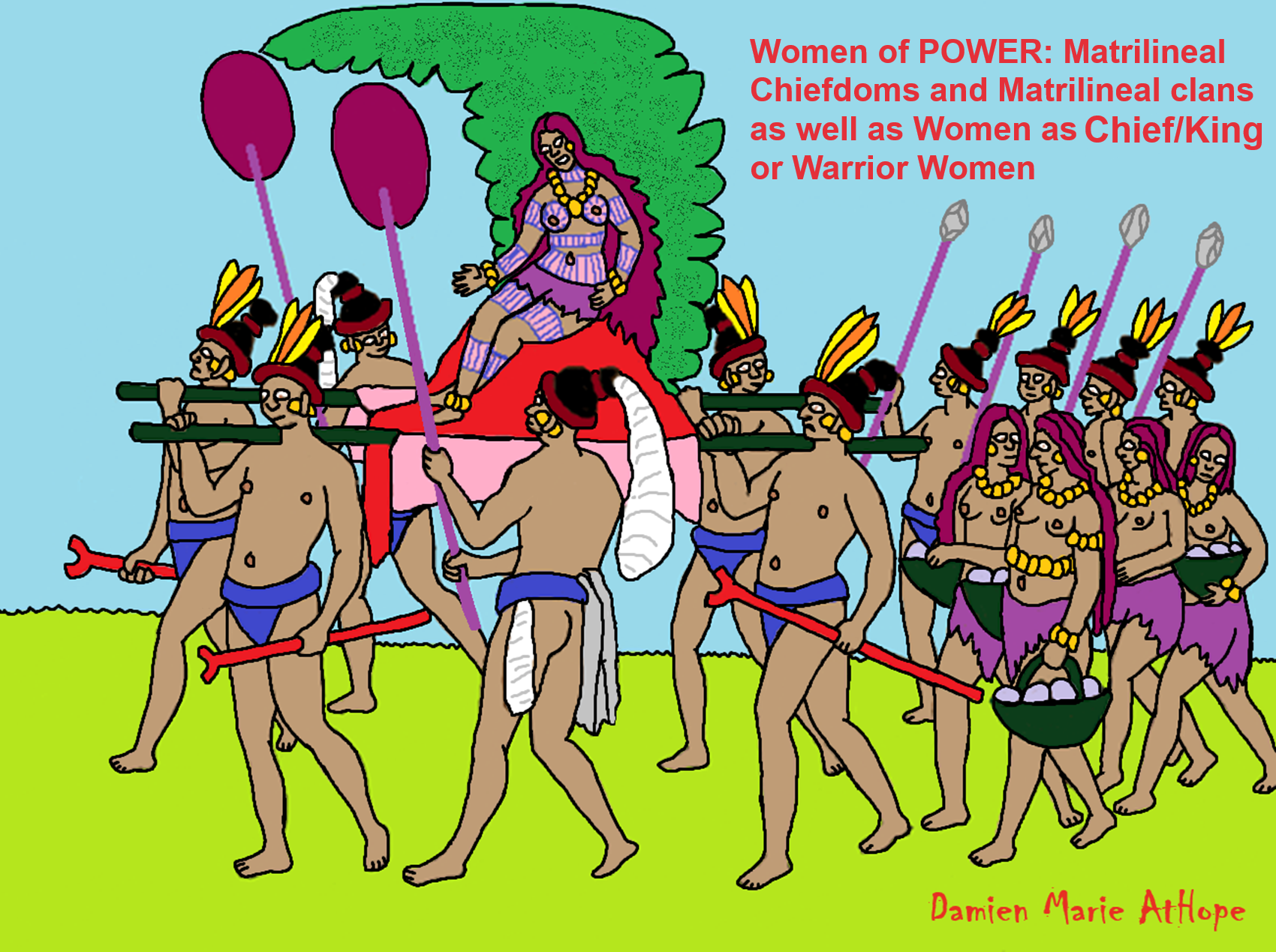
(List of matrilineal or matrilocal societies) “Matrilineal means kinship is passed down through the maternal line, the mother’s lineage, which can involve the inheritance of property and titles.” ref, ref
Chiefdoms are powers that are often believed to mobilize due to surplus labor, food, and prestige items. However, I see it as a cultural package that started with hunter-gather/fisher-foragers in west Siberia with the switch from a Matrilineal society to a patrilineal society from 8,000 to 7,000 years ago and from there spread this new war and powerful male thinking, but some Matrilineal societies changed to the war and power modal as well but kept being female-centered. I often talk as if they were completely wiped out by male clans, but not all were, and some became as horrible as male clans. One such major transfer of such ideas, which I think relates to the Tlingit (Matrilineal Na-Dene language connected to patrilineal Yeniseian languages such as the Ket People of Siberia with mostly to Y-DNA haplogroup Q-M242 linking Tlingit and South America) of the Pacific Northwest Coast of North America, were a Slaveholding, matrilineal clan chiefdom. And like 90% of South America shares their DNA and also, to me, likely somewhat influenced all Mesoamerican cultures and Moundbuilding cultures that had “Big Men/Big Women” pre/proto-chiefdoms, chiefdoms, and then clan monarchs: Kings/Empresses.

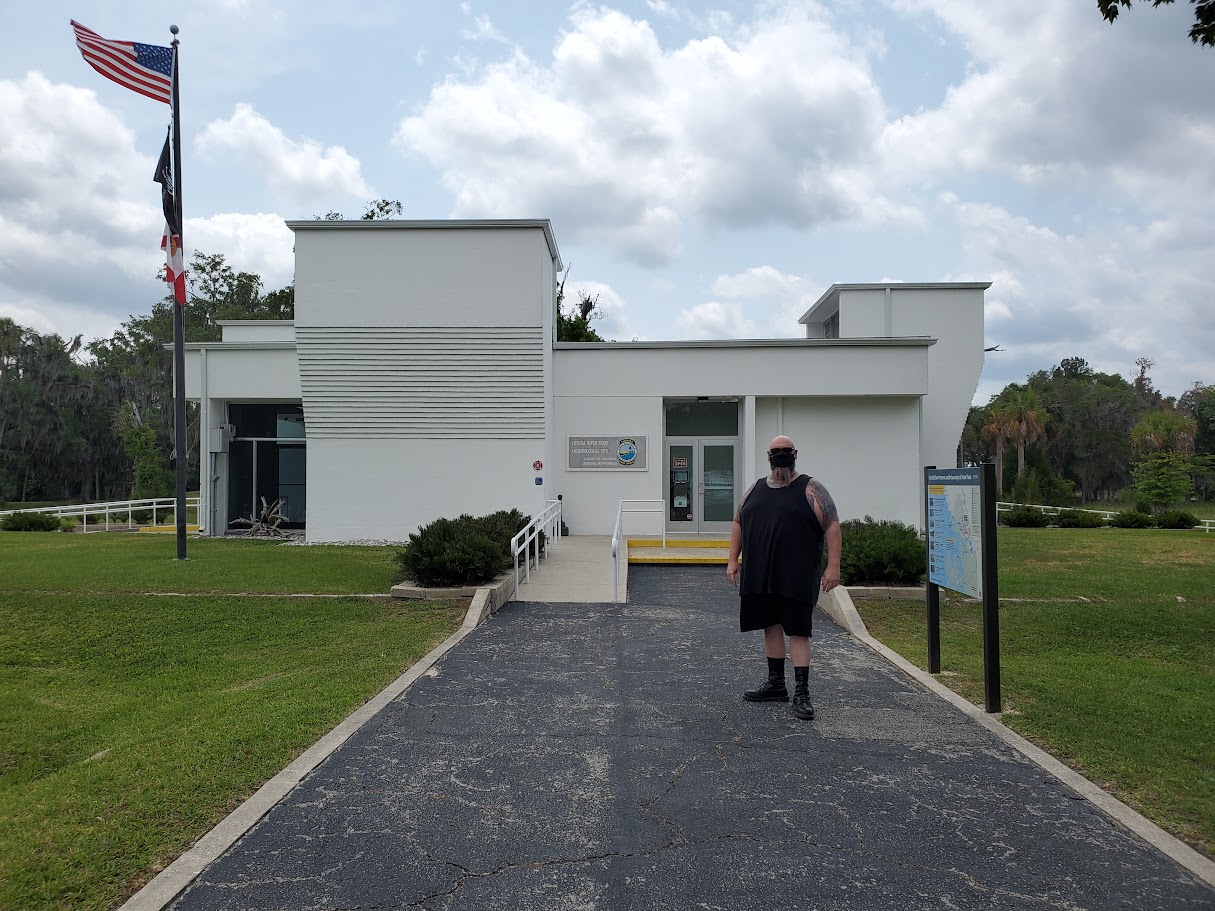
Crystal River Mounds site photo by Shayna Marie AtHope
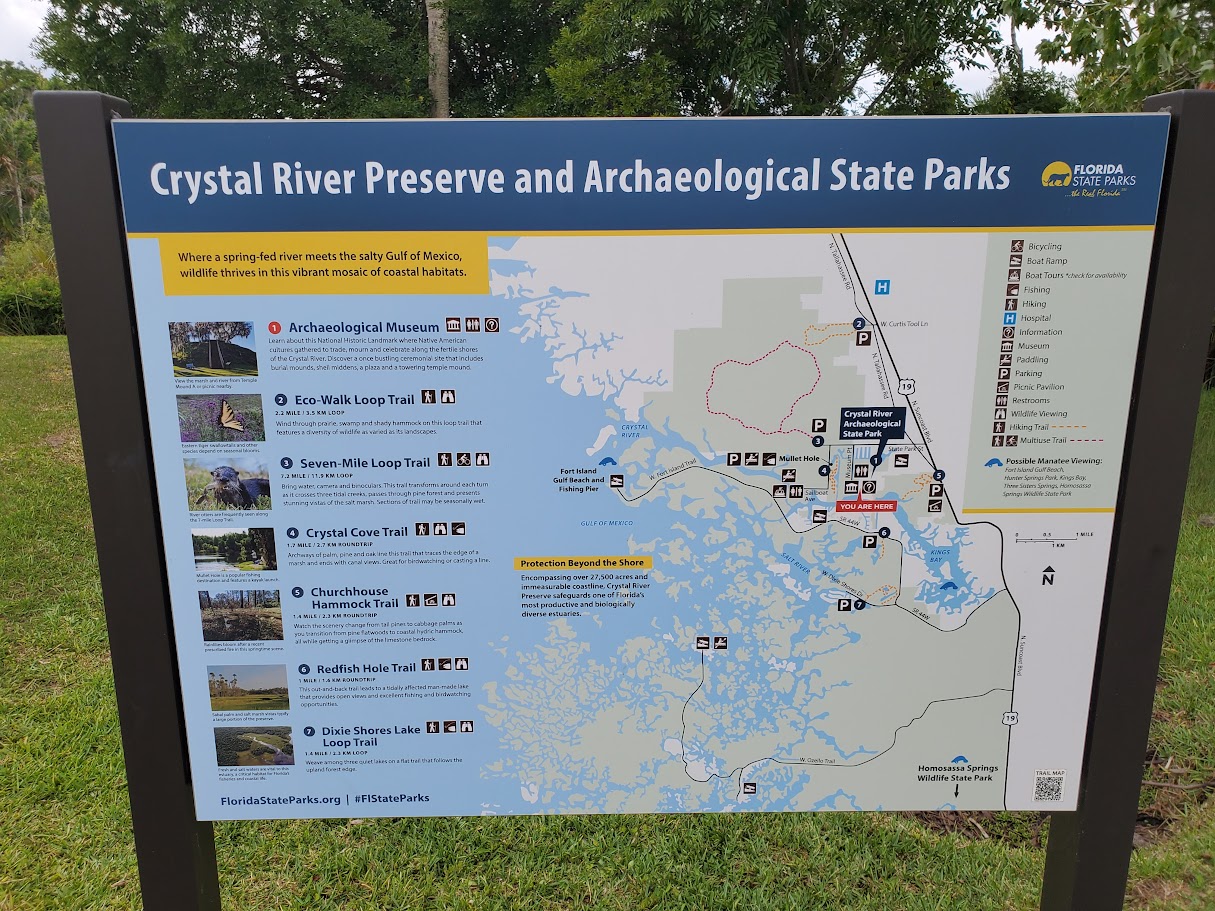
Crystal River Mounds site photo by Damien Marie AtHope

Crystal River Mounds site photo by Damien Marie AtHope

Crystal River Mounds site photo by Damien Marie AtHope

Crystal River Mounds site photo by Damien Marie AtHope
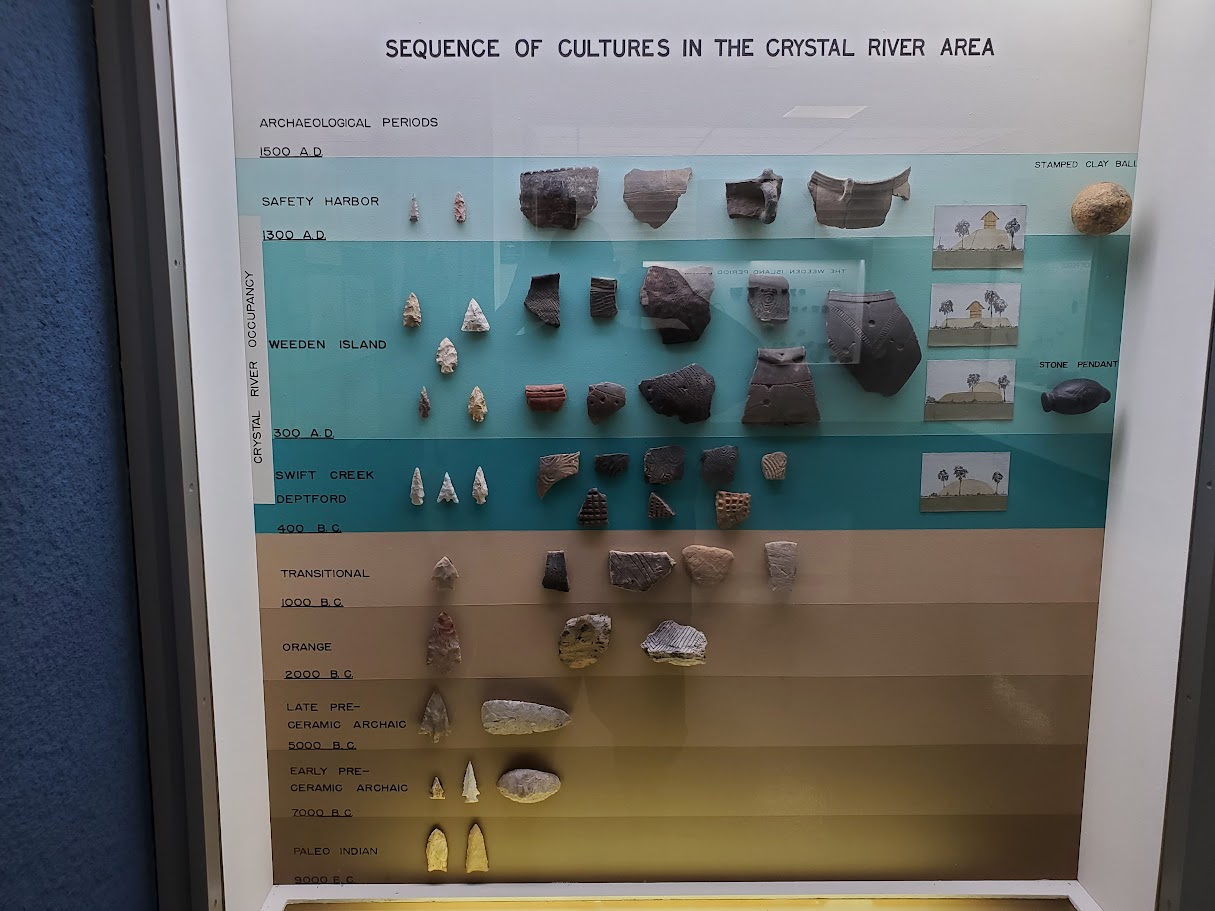
Crystal River Mounds site photo by Damien Marie AtHope
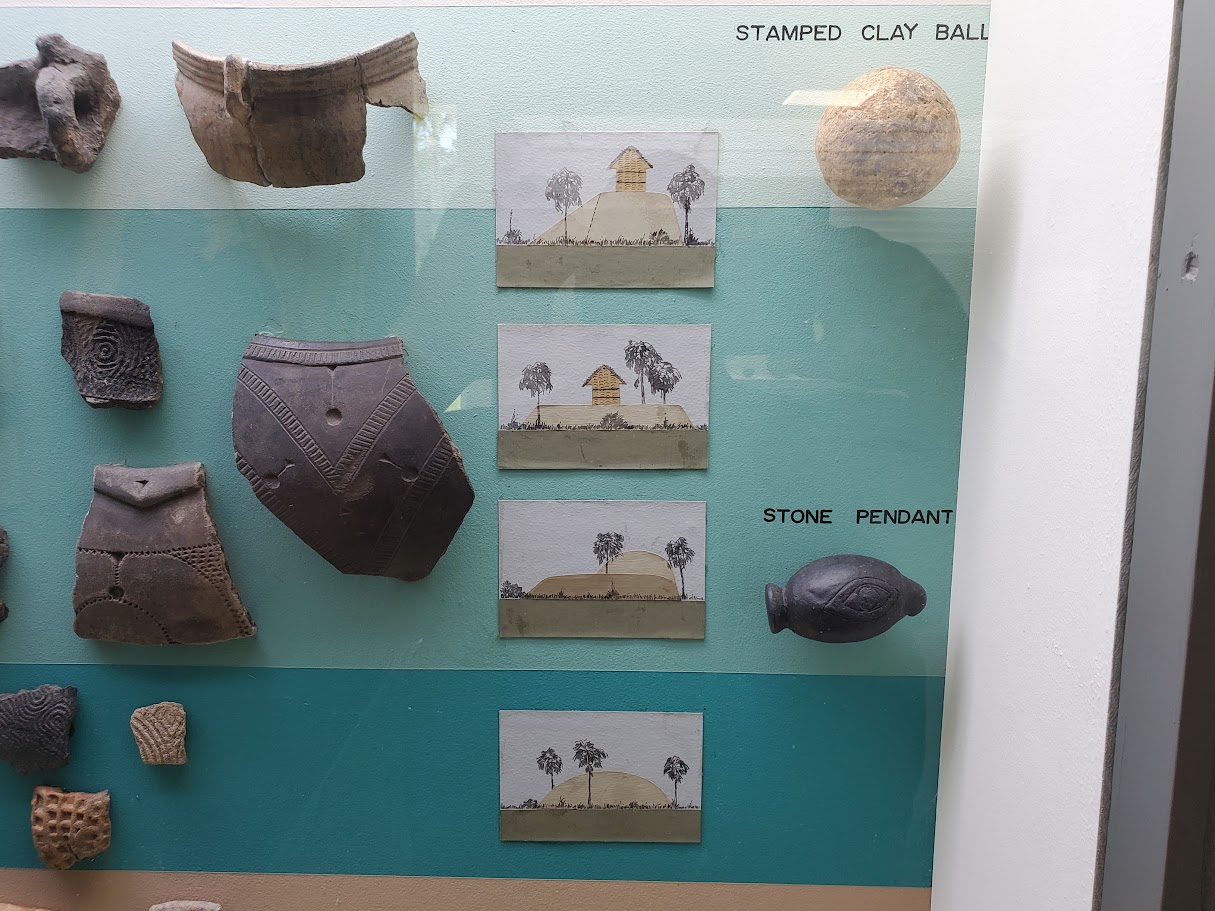
Crystal River Mounds site photo by Damien Marie AtHope
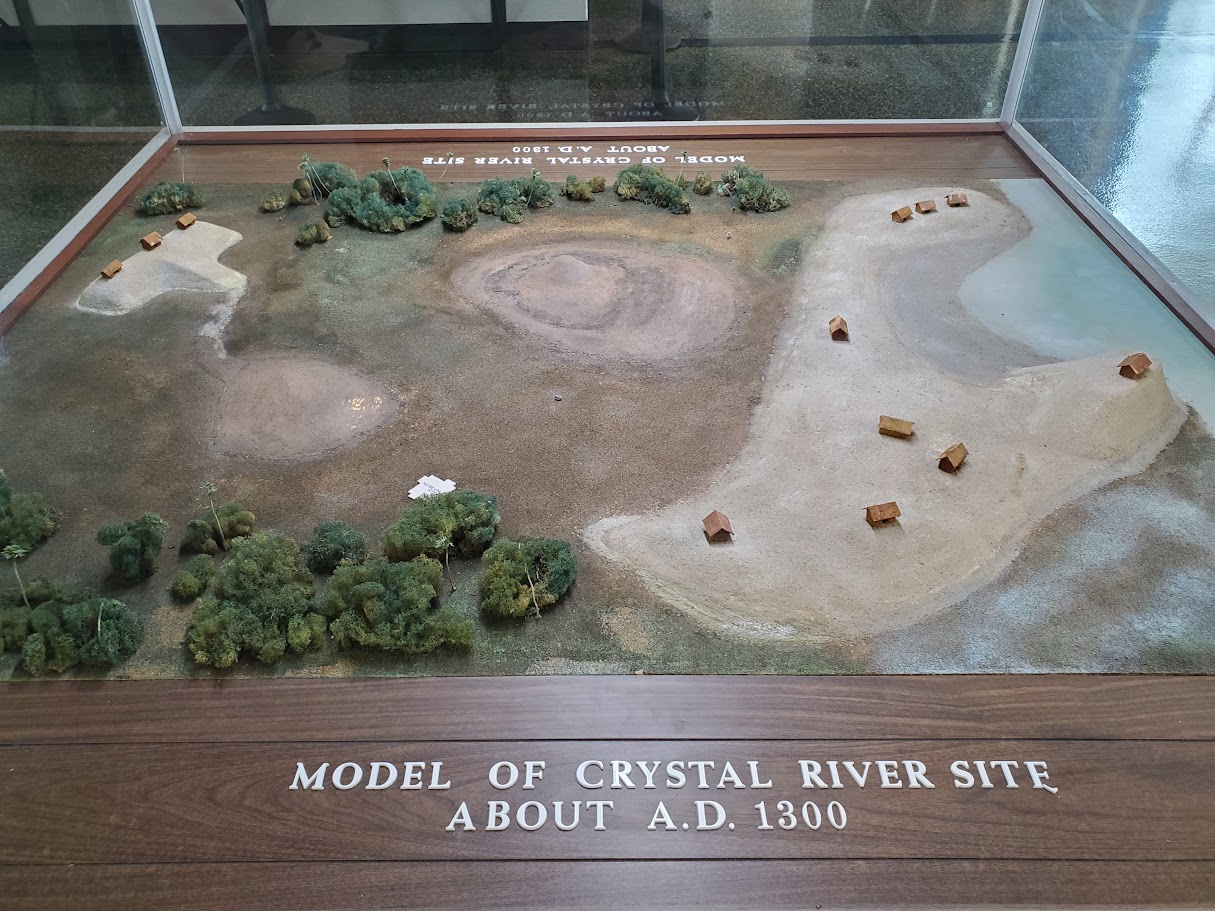
Crystal River Mounds site photo by Damien Marie AtHope
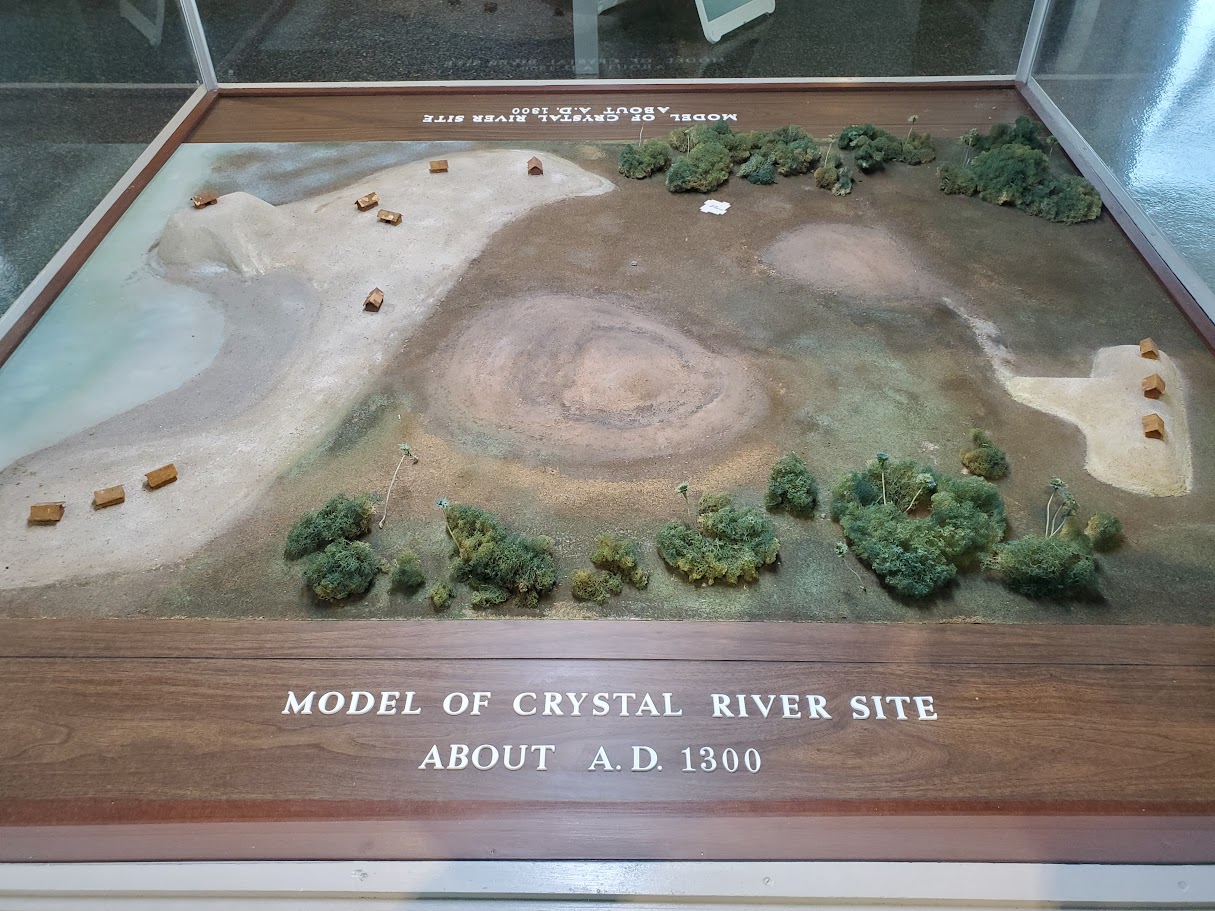
Crystal River Mounds site photo by Damien Marie AtHope

Crystal River Mounds site photo by Damien Marie AtHope

Crystal River Mounds site photo by Damien Marie AtHope
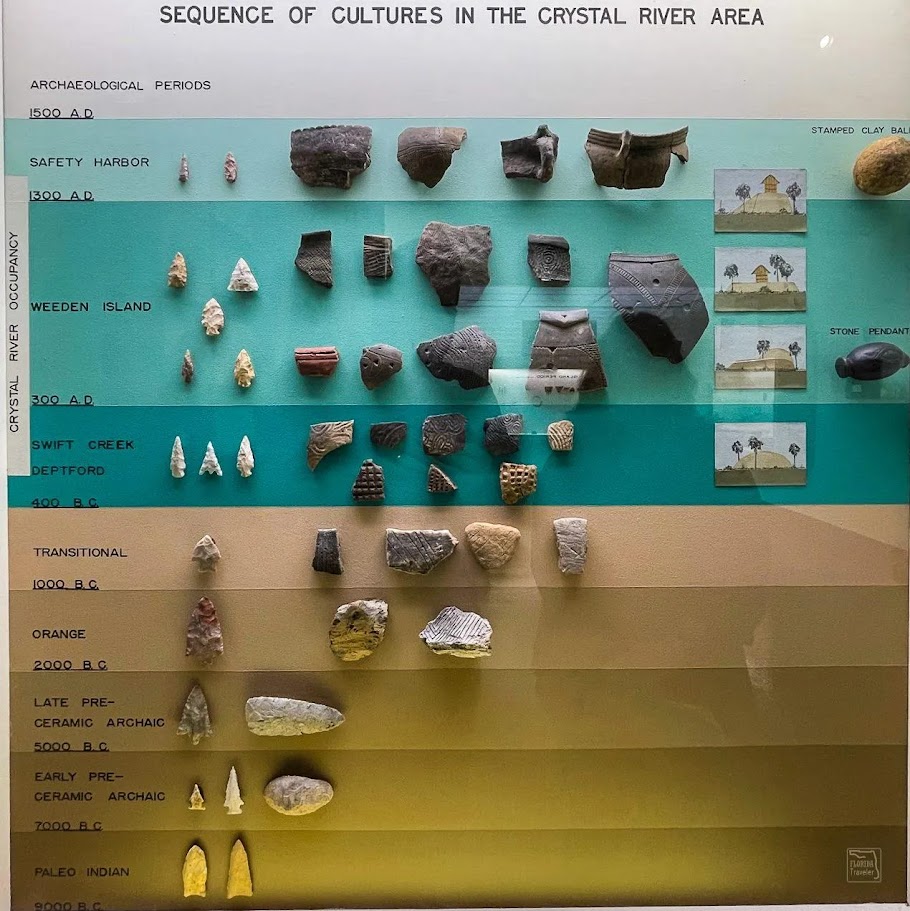
Crystal River Mounds site photo by Damien Marie AtHope
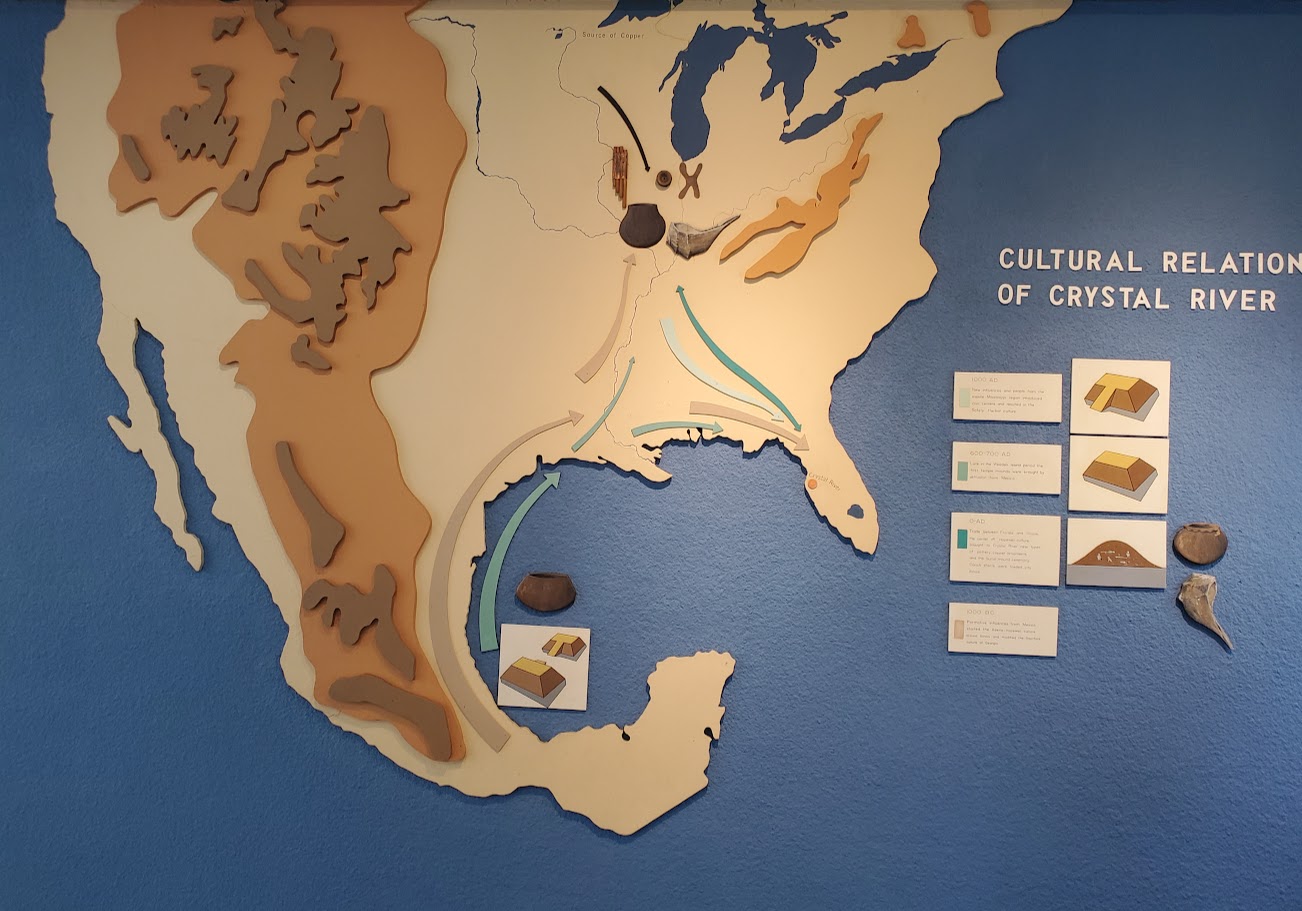
Crystal River Mounds site photo by Damien Marie AtHope
Here is a cool map of related migrations at the Crystal River Mounds Museum.
Crystal River Mounds (150 BCE or 2,150 years ago)
“The Crystal River site is located on the Central Gulf Coast of Florida near the Three Sisters Springs. These springs are the source of the Crystal River and the reason for its name. It is likely the Crystal River site was chosen precisely due to its location near these springs. The site features at least three, flat-topped pyramid mounds, a large plaza, two burial mounds, and three erect standing stones referred to as stelae. The site is full of firsts. The flat-topped pyramid mounds are the first such architectural features in Florida and perhaps the entire Southeastern U.S. The mound-and-plaza site plan is the earliest such site plan north of Mexico. A T-shaped flat-topped pyramid mound (Mound H) is unique in the U.S. Its construction method, being made mostly of limestone rocks, is rare in the southeastern U.S. and the first in Florida.” ref
“The three standing stone stelae, one carved with a human face, are also unique and the only such objects north of Mexico. The central burial mound (Mound F) is surrounded by a circular embankment of sand (Mound C), which also housed burials. The two structures form what archaeologists call the Main Burial Complex. Exotic artifacts unearthed from the central burial mound showed a trade connection with the Hopewell civilization of Ohio. The Crystal River site was the southernmost site with such exotic Hopewell artifacts. Another burial mound at the site (Mound G) showed no such exotic artifacts. This difference in grave goods suggests one burial mound was for the elites and the other for commoners.” ref
“Some of these elite goods included jewelry such as ear flares made from copper, (some overlaid with silver and meteoric iron), which helps paint a picture of how the elites of the site adorned themselves. Copper pan pipes, a type of musical instrument, were also unearthed from these elite burials. This helps us imagine what the site must have sounded like when these instruments were played. The site was not built all at once, and what we see today is the end result of centuries of work. It appears the burial mounds were constructed first, and then years later, the village with its flat-topped pyramid mounds commenced construction. This suggests the site began as a ceremonial site associated with funeral rites and later grew into a village.” ref
“The first structure at the Crystal River site was a circular embankment of sand. Multiple burials were found in this embankment. Two of the oldest burials suggest the individuals were buried sometime between 2049 BCE – 899 BCE. Pottery vessels with small feet (tetrapodal vessels) were found in the earliest burials, which supports these early dates since these vessels were known from other sites of a similar age. Plummets– decorative jewelry used to adorn clothing– were found with another burial. The River Styx and Fort Center sites are the closest other locations in Florida to feature such a circular structure.” ref
“At some point, a conical, flat-topped burial mound was built in the center of the circular embankment. It was constructed over a long period of time. The aforementioned exotic Hopewell grave goods were found in the lower parts of this mound while later burials in the upper part of the mound showed no such grave goods. Radiocarbon dates retrieved from the upper part of the mound (i.e., the youngest part) show it was constructed sometime between 723 BCE – 4 AD. No dates were retrieved for the older, lower part of the mound but clearly they would date before 723 BCE. This suggests this burial mound was likely constructed at the same time as the encircling sand embankment. If so, it would create a symbol known as a circled-dot or circumpunct. The circumpunct was a known star symbol among later Native Americans in the Southeastern U.S. These natives believed the souls of the dead resided in stars and that falling stars were the souls of the dead returning to Earth.” ref
“Creating a burial mound in the shape of a star symbol would be consistent with these beliefs. Thus, this mound complex formed a geoglyph, a symbol constructed on the landscape. Similar conical burial mounds with circular enclosures were constructed in Ohio among the Adena culture during this same time period. Since grave goods made of marine shells were unearthed from these Adena mounds, it is known they had trade contacts with Florida. The Adena culture is believed to have evolved into the Hopewell culture. Since Hopewell artifacts were found in Crystal River’s burial mound it seems Crystal River had an extended relationship with natives from the Ohio region. Construction on a second burial mound was initiated between 80 BCE – 125 CE. Few grave goods were recovered from this mound, and none were of the exotic Hopewell type. This suggests this mound was reserved for non-elite or commoners.” ref
“Researchers have noted for the Adena and Hopewell societies with which the Crystal River site was connected through trade,
“most individuals never made it to burial mounds. We don’t know where or how these individuals were disposed of in death, but we can assume that their bodies were scattered ‘in dispersed and isolating circumstances that may be difficult to identify archaeologically today….it took deliberate actions of agents or teams to deploy some of their dead or their transformed remains in contrived archaeological contexts.” ref
“Archaeologists who studied the site noted:
“By the first century CE, if not earlier, the still vacant ceremonial center at Crystal River had developed a complexity unparalleled among its peers, with one burial mound surrounded by an encircling embankment, and another singular burial mound across an apparent plaza…we see the elaboration of mortuary construction at Crystal River as an indication that ceremonies here were attracting more, and more varied, people.” ref
“They concluded:
“To summarize, Crystal River emerged as a center for ceremony in the last millennium BCE, perhaps as early as 1000 BCE but certainly by the last few centuries BCE….People from the surrounding area apparently came together at certain times of the year to bury their dead in the circular embankment and Mound F….it seems clear that theindividuals who were buried with the plummets, copper plates, and other finery—or perhaps the people who buried them—enjoyed a higher status than those who were buried without such objects…[T]he apparent emphasis on ritual parapherinalia and animalimagery suggests that high status may have been tied primarily to religious leadership…” ref
“Even at this stage, Crystal River was like nothing else in Florida:
“Crystal River, with its circular embankment and burial mound, was emerging as the paramount center for ceremony in thelocal area. In scale and elaboration, it already exceeded other cermonial centers on the pininsular Gulf coast. Its closest peers were at the Yent and Pierce sites in the Florida Panhandle, and the Mandeville site in the interior of the Chattahoochee River Valley of southwestern Georgia, where we see similarly elaborate mounds and comparable quantities of exotic Hopewell artifacts. There was no doubt competition between these centers and their respective leaders for access toexotic goods, and in attracting people.” ref
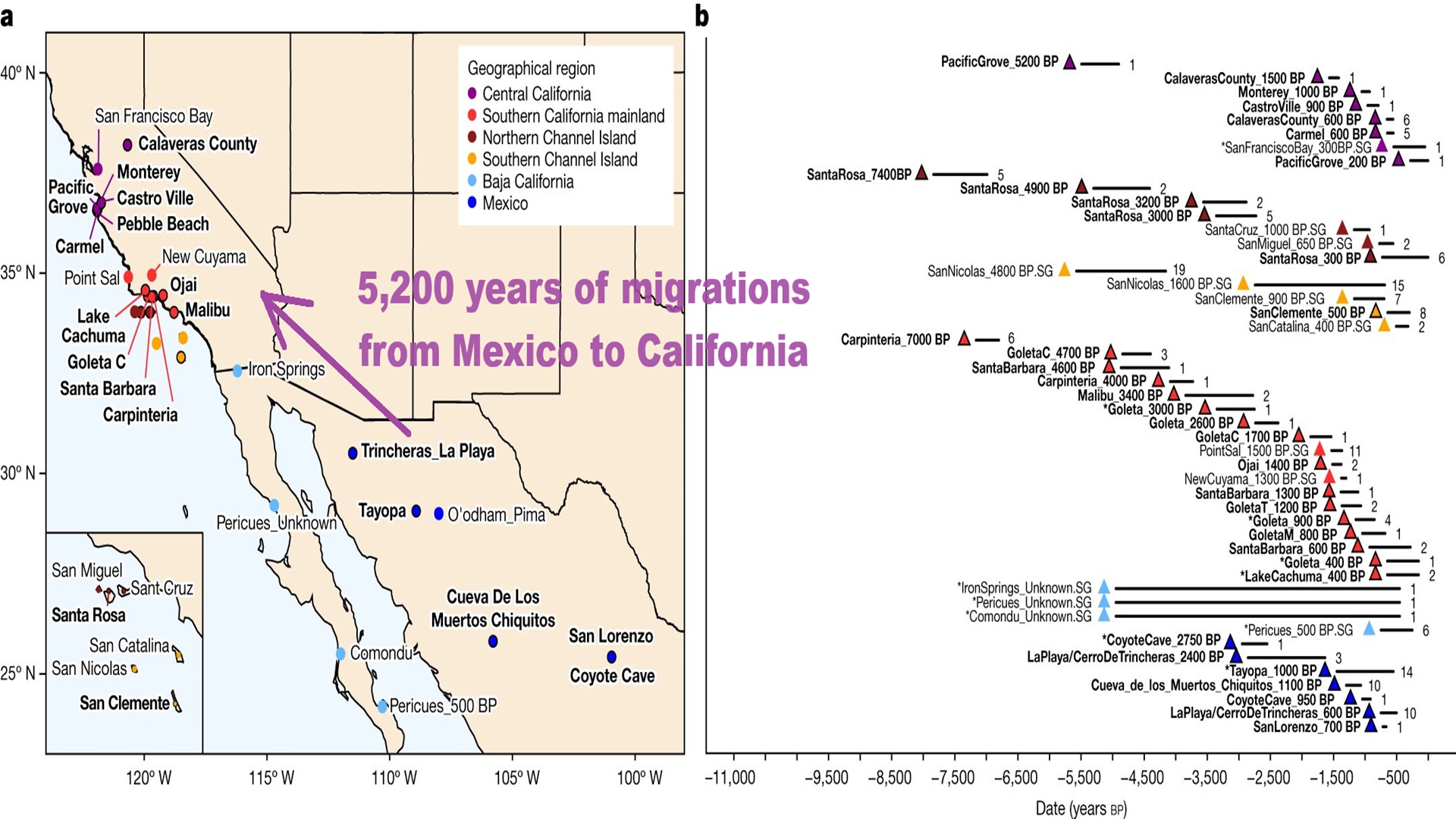
5,200 years of migrations from Mexico to California may be the origin of a mystery language
“Research led by Nathan Nakatsuka of the Department of Genetics at Harvard Medical School, Boston, has found evidence supporting migrations into California from Mexico and the presence of Mexican-related ancestry in Central and Southern California starting around 5,200 years ago. The Uto-Aztecan language family has long been a mystery, stretching from Shoshone in Idaho to Pipil in Costa Rica and covering the American Southwest down into Mexico. While the language is diverse, with dozens of distinct versions, the shared root of the language has puzzled researchers because it has yet to offer a precise location of origin. There are many proposed homelands for Uto-Aztecan, including the Great Basin, California’s central valley, the Sonora desert, Southern Arizona, and Central and Northern Mexico, with different linguistic and archaeological evidence for each model.” ref
“Using genetic clustering of individuals by geography and language with groups likely to have spoken Chumashan, Uto-Aztecan, and Utian, the study finds evidence for large-scale movement of genetic lineages characteristic of ancient and modern individuals from Northwest Mexico into both Southern and Central California by at least around 5,200 years ago. This result raises the possibility that this movement was responsible for spreading Uto-Aztecan languages and documents a significant migration period from the south before the spread of maize agriculture. A robust genetic relationship was found between the earliest individual from Pacific Grove, Central California, dated around 5,200 years ago, and ancient individuals from Baja California. This result further supports the theory that people speaking languages from an earlier linguistic substrate were once dispersed across large parts of California and that populations of the region were transformed by new migrants who changed both the genetic and linguistic landscapes.” ref
Indigenous Mexicans migrated to California 5,200 years ago, likely bringing their languages with them, ancient DNA reveals
“The research challenges the idea that languages from prehistoric Mexico spread along with maize farming in California. Hunter-gatherers from Mexico migrated into California more than 5,000 years ago, potentially spreading distinctive languages from the south into the region nearly 1,000 years earlier than previously thought, a new genetic study details. The finding challenges the idea that what are known as the Uto-Aztecan languages — which include the Aztec and Toltec languages Nahuatl, as well as Hopi and Shoshoni — were spread northward by prehistoric migrants from Mexico along with maize farming technologies. “The dating and the location of this genetic material coming into California is really important for understanding the Uto-Aztecan migration,” study lead author Nathan Nakatsuka, a population geneticist and a postdoctoral fellow at the New York Genome Center, told Live Science.” ref
“By comparing the ancient genomes, the researchers found evidence for increased migration from northern Mexico into southern and central California about 5,200 years ago. The timing of this migration refutes an existing idea that the spread of maize farming from about 4,300 years ago led to the spread of Uto-Aztecan languages, as migrant farmers prospered more than the hunter-gatherers who lived there before them. But the new study indicates that such languages may have been spread instead by a migration of hunter-gatherers that occurred nearly 1,000 years earlier. Nakatsuka acknowledged the possibility that the later spread of maize farming into California may have been the result of the earlier migration, when the first wave of migrants were joined by related people who farmed corn by that time. “But at the very least, we see that people are coming up here into California earlier than maize farming,” he said.” ref
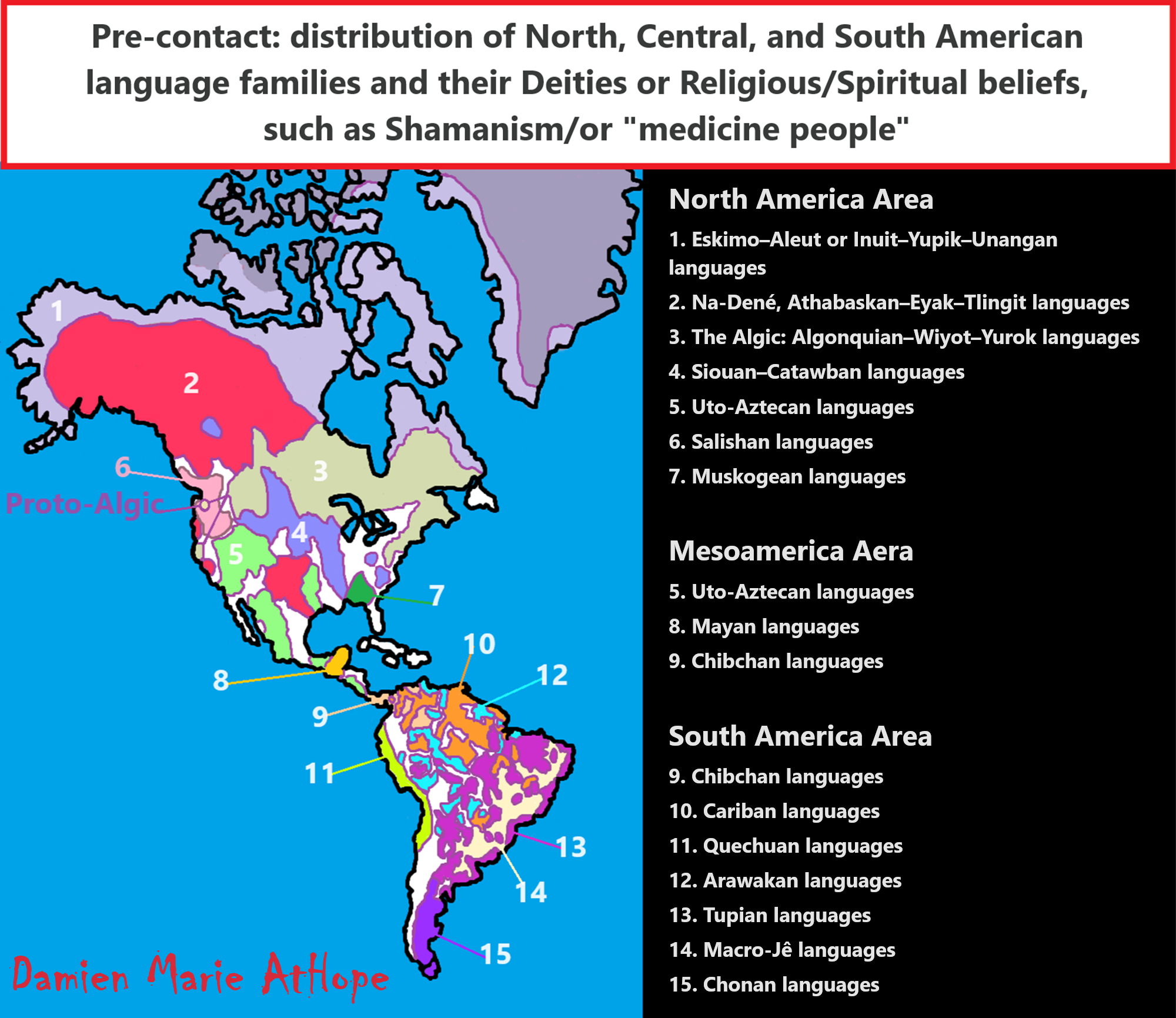
North America Area (with Deities/paganism and Shamanism/or “medicine people”)
- Eskimo–Aleut or Inuit–Yupik–Unangan languages
- Na-Dené, Athabaskan–Eyak–Tlingit languages
- The Algic: Algonquian–Wiyot–Yurok languages
- Siouan–Catawban languages
- Uto-Aztecan languages
- Salishan languages
- Muskogean languages
Mesoamerica Aera (with Deities/paganism and Shamanism/or “medicine people”)
South America Area (with Deities/paganism and Shamanism/or “medicine people”)
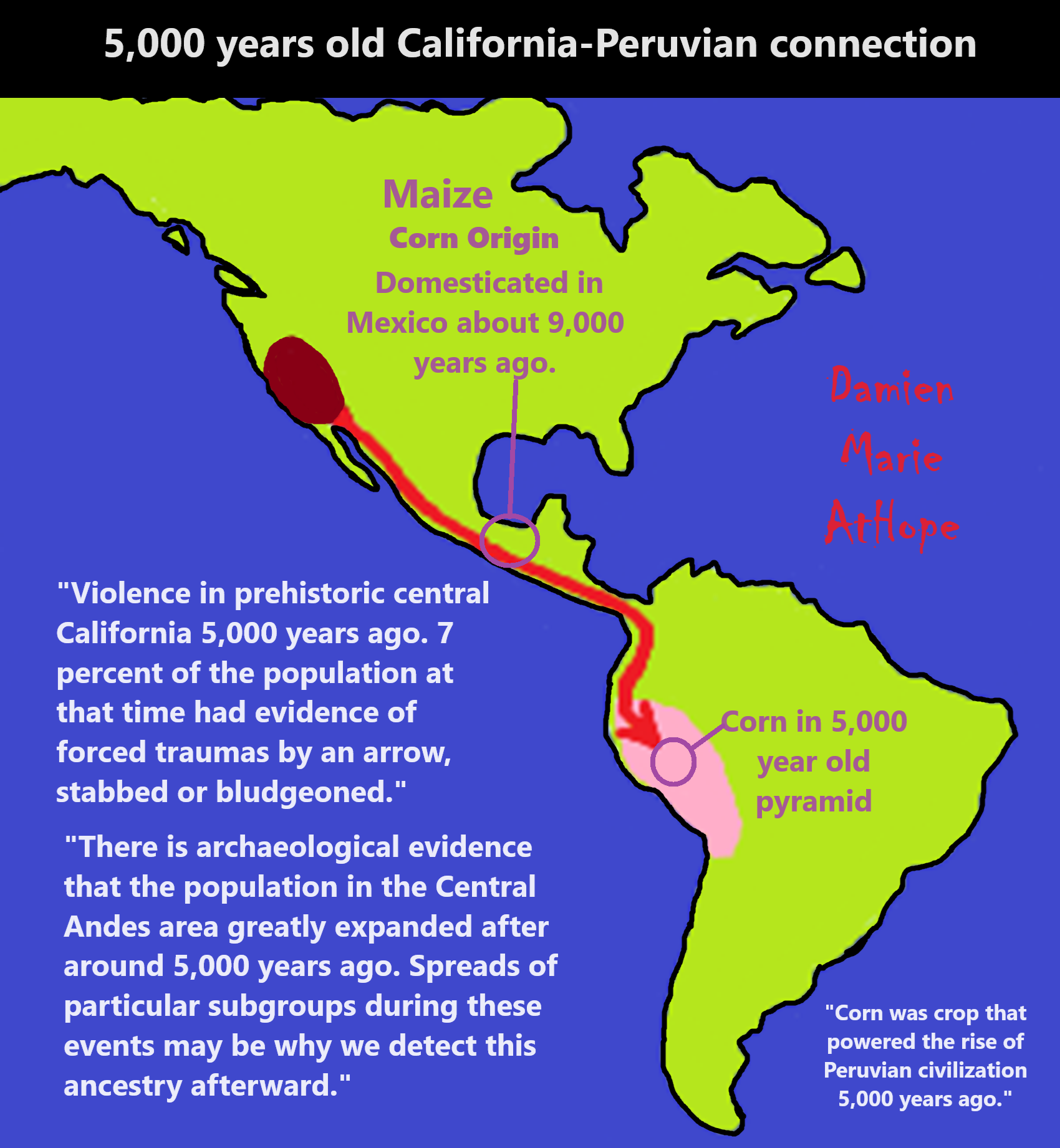
California-Peruvian connection
“The Cell study also revealed a surprising connection between ancient people living in California’s Channel Islands and the southern Peruvian Andes at least 4,200 years ago. It appears that these two geographically distant groups have a shared ancestry, the researchers found. It’s unlikely that people living in the Channel Islands actually traveled south to Peru, the researchers said. Rather, it’s possible that these groups’ ancestors sallied forth thousands of years earlier, with some ending up in the Channel Islands and others in South America. But those genes didn’t become common in Peru until much later, around 4,200 years ago, when the population may have exploded, the researchers said. It could be that this ancestry arrived in South America thousands of years before and we simply don’t have earlier individuals showing it,” study co-lead researcher Nathan Nakatsuka, a research assistant in the Reich lab at Harvard Medical School, said in the statement. “There is archaeological evidence that the population in the Central Andes area greatly expanded after around 5,000 years ago. Spreads of particular subgroups during these events may be why we detect this ancestry afterward.” ref
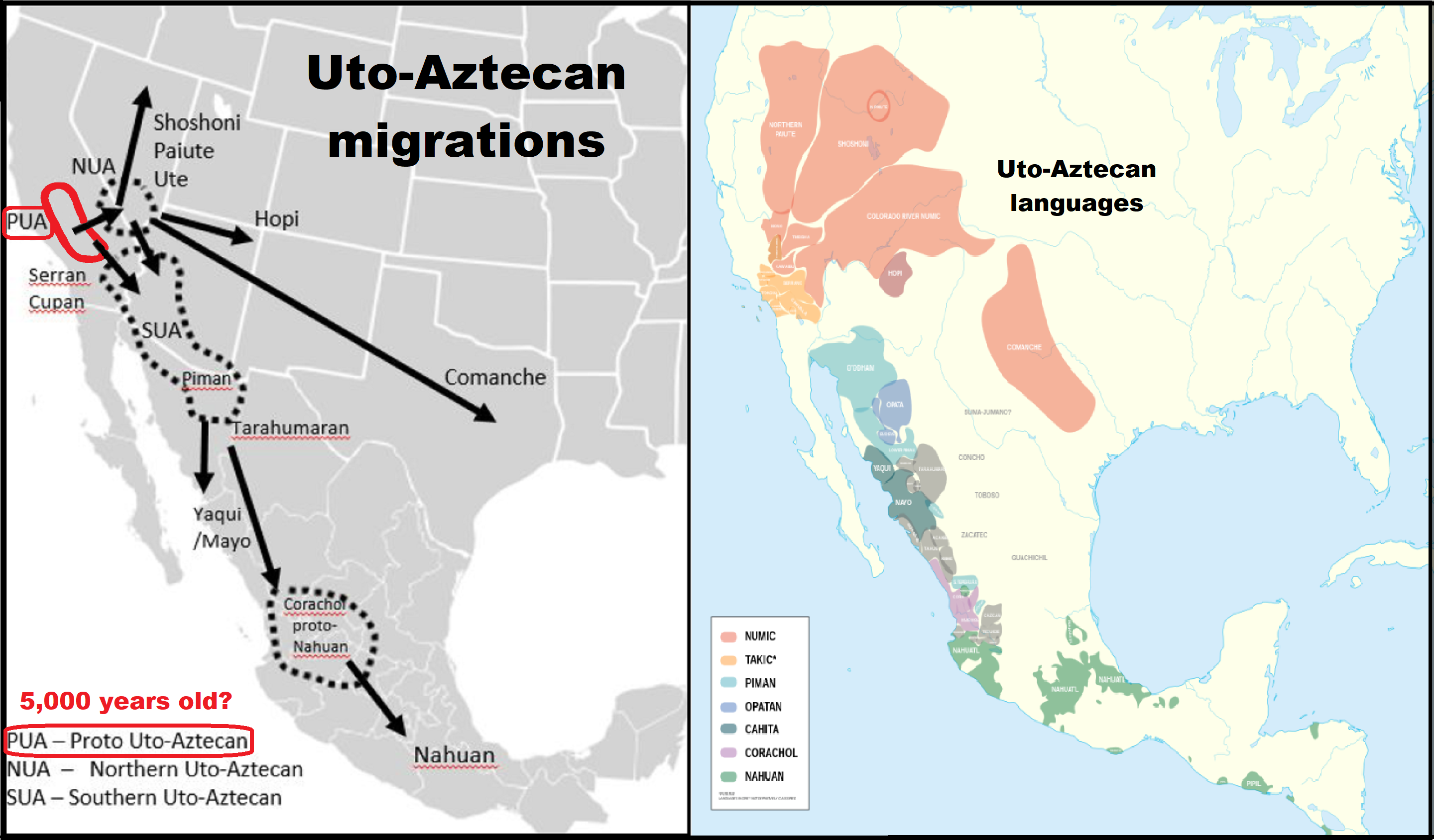
“Uto-Aztecan languages is a family of indigenous languages of the Americas, consisting of over thirty languages. Uto-Aztecan languages are found almost entirely in the Western United States and Mexico. The name of the language family was created to show that it includes both the Ute language of Utah and the Nahuan languages (also known as Aztecan) of Mexico. The Uto-Aztecan language family is one of the largest linguistic families in the Americas in terms of number of speakers, number of languages, and geographic extension. The northernmost Uto-Aztecan language is Shoshoni, which is spoken as far north as Salmon, Idaho, while the southernmost is the Pipil language of El Salvador and Nicaragua. Most scholars view the breakup of Proto-Uto-Aztecan as a case of the gradual disintegration of a dialect continuum.” ref
Uto-Aztecan Religion (Deities and Shamanism/or “medicine people”)
“There are similarities and differences in the religions and cosmologies of the various Uto-Aztecan societies. The one promotes a comparative discussion of cosmological structural systems, and the other attempts to identify one or more motifs which might prove to be evident in Uto-Aztecan mythologies Based on the religion of the Hopi Indians of Arizona, I suggest that one of the most productive motifs is that of gender For the Hopis it is shown that cosmology and gender seem to converge in social and religious statements about gender that include androgynous and duogynous themes Insights from mythology and ritual are then applied to the social ideals and practices of the Hopis.” ref
“Numic is the northernmost branch of the Uto-Aztecan language family that includes Comanche and Shoshoni. It includes seven languages spoken by Native American peoples traditionally living in the Great Basin, Colorado River basin, Snake River basin, and southern Great Plains.” ref
“The language spoken by the Comanche people, Comanche (Numu tekwapu), is a Numic language of the Uto-Aztecan language group. It is closely related to the language of the Shoshone, from which the Comanche diverged around 1700. Sometimes a man named his child, but mostly the father asked a medicine man (or another man of distinction) to do so.” ref
“Comanche religious practice was very individualistic, with the emphasis being laid on the male vision quest. The quest gave power to individuals but entailed restrictive practices and taboos. There were no priests and few group ceremonies. The Comanche believed in a creator spirit and its counterpart, an evil spirit, and accepted the Sun, the Earth, and the Moon as deities. The religion was animistic with natural objects and animal spirits (except for dogs and horses) having various powers. Medicine men served as intermediaries and helpers with the spirits and also served practically as curers. The Comanche had few ceremonies, but had developed or practiced the Beaver Ceremony and the Eagle Dance. Unlike most of the other Plains tribes, they never accepted the Sun Dance.” ref
“The Aztec religion is a polytheistic and monistic pantheism in which the Nahua concept of teotl was construed as the supreme god Ometeotl, as well as a diverse pantheon of lesser gods and manifestations of nature. The popular religion tended to embrace the mythological and polytheistic aspects, and the Aztec Empire‘s state religion sponsored both the monism of the upper classes and the popular heterodoxies.” ref
“The Aztec Empire officially recognized the most popular cults such that the deity was represented in the central temple precinct of the capital Tenochtitlan. The imperial cult was specifically that of the distinctive warlike patron god of the Mexica Huitzilopochtli. Subjugated peoples were allowed to retain their own religious traditions in conquered provinces so long as they added the imperial god Huitzilopochtli to their local pantheons, while the Empire would often incorporate practices from its new territories into the mainstream religion.” ref
“In common with many other indigenous Mesoamerican civilizations, the Aztecs put great ritual emphasis on calendrics, and scheduled festivals, government ceremonies, and even war around key transition dates in the Aztec calendar. Public ritual practices could involve food, storytelling, and dance, as well as ceremonial warfare, the Mesoamerican ballgame, and human sacrifice. The cosmology of Aztec religion divides the world into thirteen heavens and nine earthly layers or netherworlds. The first heaven overlaps with the first terrestrial layer, so that heaven and the terrestrial layers meet at the surface of the Earth. Each level is associated with a specific set of deities and astronomical objects. The most important celestial entities in Aztec religion are the Sun, the Moon, and the planet Venus (as both “morning star” and “evening star”).” ref
“Many leading deities of the Aztecs are worshiped in the contemporary or present-day world. These deities are known by names such as Tlaloc, Quetzalcoatl, and Tezcatlipoca, who are venerated by different names in multiple cultures and have been throughout the history of Mesoamerica. For the Aztecs, deities of particular importance are the rain god Tlaloc; Huitzilopochtli, patron of the Mexica tribe; Quetzalcoatl, the feathered serpent and god of wind and learning; and Tezcatlipoca, the shrewd, elusive god of destiny and fortune. Tezcatlipoca was also connected to war and sorcery. Tlaloc and Huitzilopochtli were worshipped in shrines at the top of the largest pyramid (Templo Mayor) in the Aztec capital Tenochtitlan. A third monument in the plaza in front of Templo Mayor was devoted to the wind god, Ehecatl, who was an aspect or form of Quetzalcoatl.” ref
“Religion was part of all levels of Aztec society. On the state level, religion was controlled by the Tlatoani and the high priests governing the main temples in the ceremonial precinct of the Aztec capital of Tenochtitlan. This level involved the large monthly festivals and a number of specific rituals centered around the ruler dynasty and attempted to stabilize both the political and cosmic systems. These rituals were the ones that involved a sacrifice of humans. One of these rituals was the feast of Huey Tozoztli, when the ruler himself ascended Mount Tlaloc and engaged in autosacrifice in order to petition the rains. Throughout society, each level had their own rituals and deities and played their part in the larger rituals of the community.” ref
“Aztec temples were basically offering mounds: solid pyramidal structures crammed with special soils, sacrifices, treasures, and other offerings. Buildings around the base of the pyramid, and sometimes a small chamber under the pyramid, stored ritual items and provided lodgings and staging for priests, dancers, and temple orchestras. The pyramids were buried under a new surface every several years (especially every 52 years—the Aztec century). Thus the pyramid-temples of important deities constantly grew in size.” ref
“In front of every major temple lay a large plaza. This sometimes held important ritual platforms such as the “eagle stone” where some victims were slain. Plazas were where the bulk of worshippers gathered to watch rites and dances performed, to join in the songs and sacrifices (the audience often bled themselves during the rites), and to partake in any festival foods. Nobility sat on tiered seating under awnings around the plaza periphery, and some conducted part of the ceremonies on the temple.” ref
“The Aztec world consisted of three main parts: the earth world on which humans lived (including Tamoanchan, the mythical origin of human beings), an underworld which belonged to the dead (called Mictlan, “place of death”), and the upper plane in the sky. The earth and the underworld were both open for humans to enter, whereas the upper plane in the sky was impenetrable to humans. Existence was envisioned as straddling the two worlds in a cycle of birth, life, death and rebirth. Thus as the sun was believed to dwell in the underworld at night to rise reborn in the morning and maize kernels were interred to later sprout anew, the human and divine existence was also envisioned as being cyclical. The upper and nether worlds were both thought to be layered. Mictlan had nine layers which were inhabited by different deities and mythical beings. The sky had thirteen layers, the highest of which was called Omeyocan (“place of duality”) and served as the residence of the progenitor dual god Ometeotl. The lowest layer of the sky was a verdant spring-like place with abundant water called Tlalocan (“the place of Tlaloc”).” ref
“After death, the soul of the Aztec went to one of three places: the sun, Mictlan, or Tlalocan. Souls of fallen warriors and women that died in childbirth would transform into hummingbirds that followed the sun on its journey through the sky. Souls of people who died from less glorious causes would go to Mictlan. Those who drowned would go to Tlalocan. In Aztec cosmology, as in Mesoamerica in general, geographical features such as caves and mountains held symbolic value as places of crossing between the upper and nether worlds. The cardinal directions were symbolically connected to the religious layout of the world as well; each direction was associated with specific colors and gods.” ref
“To the Aztecs, death was instrumental in the perpetuation of creation, and gods and humans alike had the responsibility of sacrificing themselves in order to allow life to continue. This worldview is best described in the myth of the five suns recorded in the Codex Chimalpopoca, which recounts how Quetzalcoatl stole the bones of the previous generation in the underworld and how later the gods created four successive worlds or “suns” for their subjects to live in, all of which were destroyed. Then, by an act of self-sacrifice, one of the gods, Nanahuatzin (“the pimpled one”), caused a fifth and final sun to rise where the first humans, made out of maize dough, could live thanks to his sacrifice. Humans were responsible for the sun’s continued revival. Blood sacrifice in various forms were conducted. Both humans and animals were sacrificed, depending on the god to be placated and the ceremony being conducted, and priests of some gods were sometimes required to provide their own blood through self-mutilation.” ref
“Sacrificial rituals among the Aztecs, and in Mesoamerica in general, must be seen in the context of religious cosmology: sacrifice and death was necessary for the continued existence of the world. Likewise, each part of life had one or more deities associated with it and these had to be paid their dues in order to achieve success. Gods were paid with sacrificial offerings of food, flowers, effigies, and quail. But the larger the effort required of the god, the greater the sacrifice had to be. Blood fed the gods and kept the sun from falling. For some of the most important rites, a priest would offer his own blood by cutting his ears, arms, tongue, thighs, chest, genitals, or offer a human life or a god’s life. The people who were sacrificed came from many segments of society and might have been a war captive, slave, or a member of Aztec society; the sacrifice might also have been man or woman, adult or child, or noble or commoner.” ref
“Cultural God
- Tezcatlipoca: meaning “smoking mirror”, a Pan-Mesoamerican shaman god, omnipotent universal power
- Quetzalcoatl: meaning “feathered serpent”, a Pan-Mesoamerican god of life, the wind, and the morning star
- Tlaloc: a Pan-Mesoamerican god of lightning, rain, water, and thunder
- Mixcoatl: meaning “cloud serpent”, the tribal god of many of the Nahuapeople such as the Tlaxcalteca, god of war, sacrifice and hunting
- Huitzilopochtli: meaning “left-handed hummingbird”, the patron god of the Mexica of Tenochtitlan, the sun
Nature gods
- Metztli: the moon
- Tlaltecuhtli: meaning “earth lord”, goddess of the Earth
- Chalchiuhtlicue: meaning “jade her skirt”, goddess of springs
- Centzon Huitznahua: meaning “the 400 southerners”, gods of the stars
- Ehecatl: the wind, often conflated with Quetzalcoatl and called “Quetzalcoatl-Ehecatl”
Gods of creation
- Ōmeteōtl/Tōnacātēcuhtli: creator gods
- Huehuetéotl/Xiuhtecuhtli: meaning “old god” and “turquoise lord”, god of origin, time, fire, and old age
- Coatlicue/Toci/Teteoinnan/Tonantzin: progenitor goddesses” ref
“Proto-Uto-Aztecan is the hypothetical common ancestor of the Uto-Aztecan languages. Authorities on the history of the language group have usually placed the Proto-Uto-Aztecan homeland in the border region between the United States and Mexico, namely the upland regions of Arizona and New Mexico and the adjacent areas of the Mexican states of Sonora and Chihuahua, roughly corresponding to the Sonoran Desert and the western part of the Chihuahuan Desert. It would have been spoken by Mesolithic foragers in Aridoamerica, about 5,000 years ago.” ref
“Reconstructions of the botanical vocabulary offer clues to the ecological niche inhabited by the Proto-Uto-Aztecans. Fowler placed the center of Proto-Uto-Aztecan in Central Arizona with northern dialects extending into Nevada and the Mojave desert and southern dialects extending south through the Tepiman corridor into Mexico. The homeland of the Numic languages has been placed in Southern California near Death Valley, and the homeland of the proposed Southern Uto-Aztecan group has been placed on the coast of Sonora.” ref
“A contrary proposal suggests the homeland of Proto-Uto-Aztecan to have been much farther to the south; it was published in 2001 by Jane H. Hill, based on her reconstruction of maize-related vocabulary in Proto-Uto-Aztecan. By her theory, the assumed speakers of Proto-Uto-Aztecan were maize cultivators in Mesoamerica, who gradually moved north, bringing maize cultivation with them, during the period of roughly 4,500 to 3,000 years ago. The geographic diffusion of speakers corresponded to the breakup of linguistic unity. The hypothesis has been criticized on several grounds, and it is not generally accepted by Uto-Aztecanists. Using computational phylogenetic methods, Wheeler & Whiteley (2014) also suggest a southern homeland for Proto-Uto-Aztecan in or near the area occupied by historical Cora and some Nahua. Nahuatl forms the most basal clade in Wheeler & Whiteley’s (2014) Uto-Aztecan phylogram.” ref
“A survey of agriculture-related vocabulary by Merrill (2012) found that the agricultural vocabulary can be reconstructed for only Southern Uto-Aztecan. That supports a conclusion that the Proto-Uto-Aztecan speech community did not practice agriculture but adopted it only after entering Mesoamerica from the north. A more recent proposal from 2014, by David L. Shaul, presents evidence suggesting contact between Proto-Uto-Aztecan and languages of central California, such as Esselen and the Yokutsan languages. That leads Shaul to suggest that Proto-Uto-Aztecan was spoken in California’s Central Valley area, and it formed part of an ancient Californian linguistic area.” ref
“Esselen language was the language of the Esselen (or self-designated Huelel) Nation, which aboriginally occupied the mountainous Central Coast of California, immediately south of Monterey. The Esselen are a Native American people belonging to a linguistic group in the hypothetical Hokan language family, who are indigenous to the Santa Lucia Mountains of a region south of the Big Sur River in California. Archaeological and linguistic evidence indicates that the original people’s territory once extended much farther north, into the San Francisco Bay Area, until they were displaced by the entrance of Ohlone people. Breschini and Haversat place the entry of Ohlone speakers into the Monterey area prior to 200 BCE or around 2,200 years ago based on multiple lines of evidence.” ref
“Carbon dating of excavated sites places the Esselen in the Big Sur since circa 2,630 BCE or around 4,630 years ago. Recently, however, researchers have obtained a radiocarbon date from coastal Esselen territory in the Big Sur River drainage dated prior to 6,500 years ago (archeological site CA-MNT-88). The Esselen left hand prints on rock faces in a few locations. About 250 have been found in a single rock shelter located a few miles from Tassajara (designated by archeologists as CA-MNT-44). Smaller numbers of handprints have been found in a few caves or rock shelters in the same area and in the next valley to the west.” ref
“The word “Esselen” means “the people” or “the rock people” in their language. The Esselen had a complex and sophisticated spiritual system, based on their connection to the land and the cosmos. They believed in a supreme creator called Kaknu, who was responsible for everything that existed. They also revered various spirits and ancestors who inhabited the natural features of their environment, such as rocks, trees, mountains, springs, and caves. They performed ceremonies and rituals to honor these beings and to ask for their protection and guidance. They also practiced shamanism, which involved entering altered states of consciousness to communicate with the spirit world.” ref
“Yokuts language: Yokuts, formerly known as Mariposa, is an endangered language spoken in the interior of Northern and Central California in and around the San Joaquin Valley by the Yokuts people. Yokuts is a key member in the proposed Penutian language stock. Some linguists consider most relationships within Penutian to be undemonstrated (cf. Campbell 1997). Others consider a genetic relationship between Yokuts, Utian, Maiduan, Wintuan, and a number of Oregon languages to be definite (cf. DeLancey and Golla 1997). Regardless of higher-order disagreement, Callaghan (1997) provides strong evidence uniting Yokuts and the Utian languages as branches of a Yok-Utian language family.” ref
“Yokuts traditional narratives include myths, legends, tales, and oral histories preserved by the Yokuts people of the San Joaquin Valley and southern Sierra Nevada foothills of central California.” ref
“Yokuts believed that shamans had supernatural powers derived from spirit animals they encountered in dreams or vision quests. Shamans helped conduct ceremonies and treated illnesses, cures for which they charged large fees. The Yokuts are a group of indigenous tribes from the San Joaquin Valley in central California. The word Yokuts means simply people; unlike other California natives, the Yokuts were divided into true tribes — possibly as many as 60 — each with its own name, dialect, and territory.” ref
“The traditional narratives of Native California are the folklore and mythology of the native people of California. For many historic nations of California, there is only a fragmentary record of their traditions. Spanish missions in California from the 18th century Christianized many of these traditions, and the remaining groups were mostly assimilated to US culture by the early 20th century. While there are sparse records from the 18th century, most material was collected during the 19th and the early 20th centuries. Ethnolinguistically, most of the native peoples of California can be categorized into three large groups, Penutian, Hokan and Uto-Aztecan. Of these traditions, one of the best attested and most notable in US mainstream culture is Hopi mythology, the Hopi being a Pueblo people speaking a language of the Uto-Aztecan family.” ref
“Several general traits are recognizable in California’s traditional narratives. These traits are not universally present, but they characterize most of the narratives:
Fluid genres
Folklorists have commonly attempted to distinguish between myths, legends, tales, and histories.
- Mythsare sacred accounts that are believed by narrators and listeners to be true. They are set in a period at or before the origins of the world as it is known, and they usually contain strong supernatural elements.
- Legendsare also believed to be true, and they may also contain fantastic elements. However, they are set later in time, after the world had assumed the form in which it was known to traditional cultures.
- Talesare entertaining stories that narrators and listeners are not required to believe as true.
- Historiesare narratives of actually witnessed events that have been transmitted, with greater or less embellishment, to subsequent generations.” ref
“In the oral literature of native California, the lines between these genres are typically not at all carefully observed. It is often impossible to classify a narrative definitively as a myth, a legend, a tale, or a history. Cognate versions of the same narrative as told by different narrators may fall within different genres.” ref
Sharing among neighbors
“Many of the narratives are entirely unique, existing in only a single version. However, many others are known in multiple versions that vary but are clearly cognate with one another. The versions may come from different narrators within a single ethnolinguistic group, from different groups within a region of the Californias, or from groups that are scattered across the North American continent and even beyond. Patterns in the relative similarity of shared narratives are almost entirely dictated by the historic-period propinquity of the groups sharing narratives. Few if any patterns reflect preferential sharing among historically dispersed groups that originally shared a common linguistic descent. This suggests ongoing, creative modification of narratives, rather than rigid conservatism.” ref
Weak narrative unity
“Lengthy traditional narratives tend to have an episodic or picaresque character. Their unity comes mainly from the presence of a continuing central character or from a causal sequence of events, rather than from any overall theme, plot, or narrative purpose.” ref
Fluidity in content
“As a consequence of weak narrative unity, the stories often have a composite character. Motifs are rather freely added, dropped, or transferred from one narrative to another.” ref
Moral ambiguity
“In the traditional narratives of native North America, the Western expectation of essentially “good” or “evil” characters or events is generally not met. The same character is likely to act beneficently in one episode but malevolently in the next, according to the accepted norms of behavior or to criteria of general welfare. Many of the early discussions of this literature by outside observers were marred by attempts to characterize a mythic personage as either a beloved benefactor or an evil trickster, when both of these labels might be equally true, or equally false.” ref
Surrealism in time
“The events of traditional narratives are rarely set within realistic chronological frameworks. Time spans measured in years or decades are rarely specified. Characters often are conceived and grow to maturity within miraculously short periods.” ref
Animal – human ambiguity
“The characters in many narratives are known by the names of animals (or, less commonly, by the names of plants or other natural features). Often it is understood that the character is the forebear or prototype of the animal species. Its conversation, actions, and motives are usually human, while its physical characteristics may be either human or animal, and commonly the two are mixed in a biologically inconsistent manner.” ref
“Alfred L. Kroeber distinguished three main cultural regions within California. Each of these was seen as having a distinctive pattern in its traditional narratives that set it apart from neighboring regions.
- The small Northwestregion was focused on the Hupa, Karok, and Yurok. A creation myth was lacking in this region. Narratives typically related to a race that had preceded the known human beings in the regions. Long stories about the travels and adventures of a culture hero were characteristic.
- The Centralregion, encompassing most of California, possessed a creation myth that often employed the Earth Diver motif. Kroeber distinguished North Central and South Central divisions within this region, consisting respectively of the Sacramento and San Joaquin valleys plus the coastal and mountain areas adjacent to them.
- The Southernregion included Takic– and Yuman-speaking groups. It had a distinctive creation myth but lacked most of the tales common in the Central region, at least to judge from the surviving records.” ref
“Anna H. Gayton reexamined Kroeber’s regional divisions. While finding them generally valid, she stressed the gradational character of the transitions between the regions. She also suggested that variability in their links with regions outside of California was a key to understanding internal differences:
- Links with the Northwest Coastregion of North America permeated Kroeber’s Northwest region within California. These links extended well beyond the Hupa-Karok-Yurok core, as far south as the Pomo and as far east as the Achomawi.
- Links with the Plateauregion extended throughout northernmost California, from Kroeber’s Northwest region to the Yana and Achomawi in the east.
- Links with the Great Basinwere pronounced not only east of the Sierra Nevada but also in the western foothills of that range and in upper Sacramento Valley and the Mojave Desert, from the Shasta to the Serrano.
- Southern California was strongly tied to the Yuman-speaking area of western Arizona.
- In central California Gayton discerned a relatively discrete nucleus of groups lacking such strong external influences. These included the Miwok, Yokuts, Salinan, Ohlone, and Patwin.” ref
“Penutian languages: Penutian is a proposed grouping of language families that includes many Native American languages of western North America, predominantly spoken at one time in British Columbia, Washington, Oregon, and California. Some of the more recently proposed subgroupings of Penutian have been convincingly demonstrated. The Miwokan and the Costanoan languages have been grouped into an Utian language family by Catherine Callaghan. Callaghan has more recently provided evidence supporting a grouping of Utian and Yokutsan into a Yok-Utian family. There also seems to be convincing evidence for the Plateau Penutian grouping (originally named Shahapwailutan by J. N. B. Hewitt and John Wesley Powell in 1894) which would consist of Klamath–Modoc, Molala, and the Sahaptian languages (Nez Percé and Sahaptin). Consensus was reached at a 1994 workshop on Comparative Penutian at the University of Oregon that the families within the proposed phylum’s California, Oregon, Plateau, and Chinookan clusters would eventually be shown to be genetically related. Subsequently, Marie-Lucie Tarpent reassessed Tsimshianic, a geographically isolated family in northern British Columbia, and concluded that its affiliation within Penutian is also probable. Earlier groupings, such as California Penutian and Takelma–Kalapuyan (“Takelman”) are no longer accepted as valid nodes by many Penutian researchers. However, Plateau Penutian, Coast Oregon Penutian, and Yok-Utian (comprising the Utian and Yokutsan languages) are increasingly supported.” ref
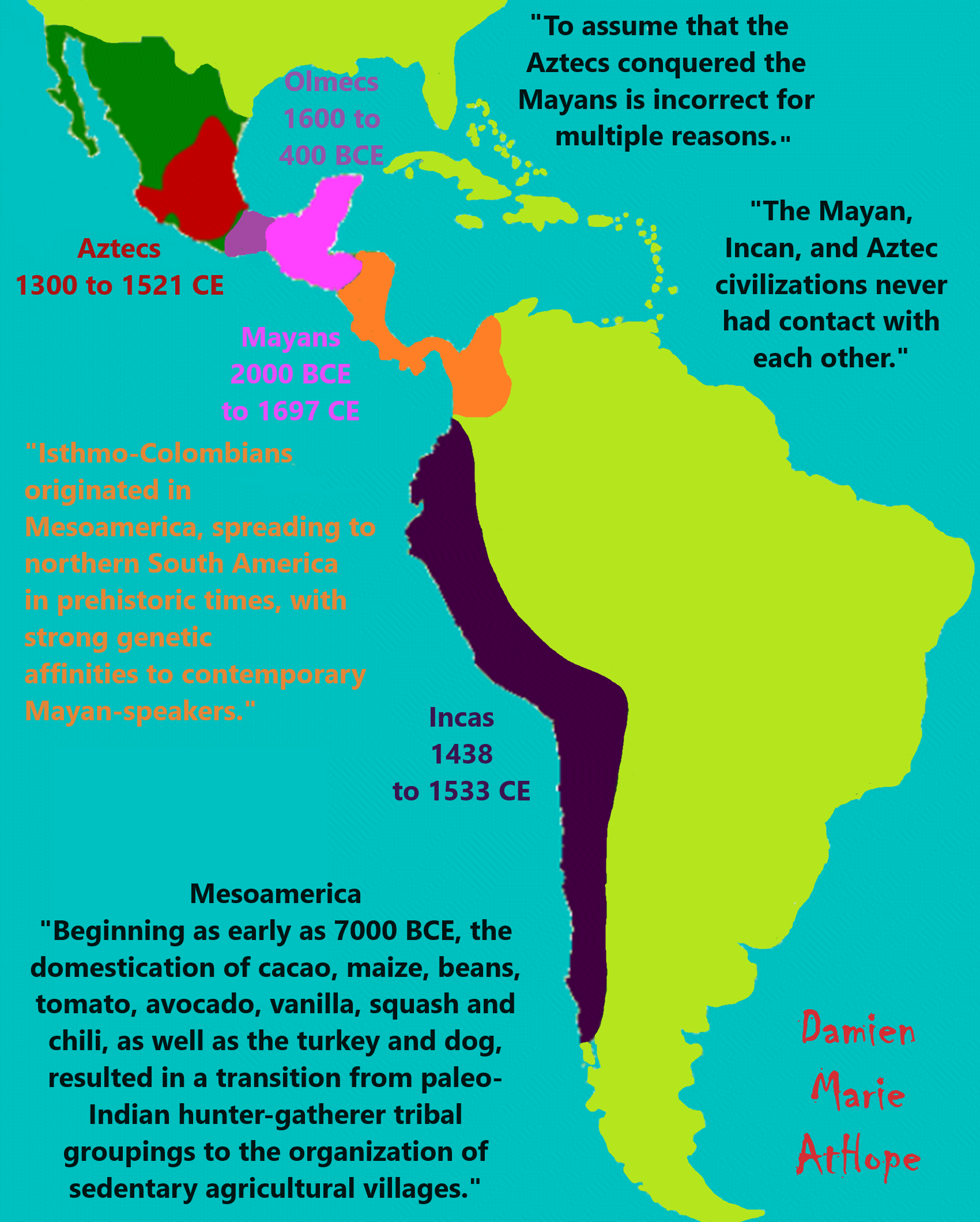
“To assume that the Aztecs conquered the Mayans is incorrect for multiple reasons. The Aztecs and the Mayan were two distinct cultures of indigenous people.” ref
“The haplogroup frequencies found in Aztecs resemble other present-day Central and Southern Mexican and Central American populations, suggesting a great antiquity to this pattern of regional continuity.” ref
“Proto-Uto-Aztecan is the hypothetical common ancestor of the Uto-Aztecan languages dates to 3,000 BCE or around 5,000 years ago. The homeland of the Numic languages has been placed in Southern California near Death Valley, and the homeland of the proposed Southern Uto-Aztecan group has been placed on the coast of Sonora. A more recent proposal from 2014, by David L. Shaul, presents evidence suggesting contact between Proto-Uto-Aztecan and languages of central California, such as Esselen and the Yokutsan languages. That leads Shaul to suggest that Proto-Uto-Aztecan was spoken in California’s Central Valley area, and it formed part of an ancient Californian linguistic area.” ref
“Native Mexican Y chromosome haplogroups Q-MEH2, Q-M3, Q-Z768, Q-L663, Q-Z780, and Q-PV3; affirmed and suggested multiple population dispersals southward in the Americas via Beringia and connected Native Mexicans with indigenous populations from South-Central Siberia and Canada.” ref
“Comparison of Native Mexican data with those from populations of Asia and North, Central, and South America further reveals connections between Aztlan descendants and South-Central Siberians and indigenous populations from both Canada and South America. These findings affirm the southward colonization route for ancestral Native Americans and support the view that Mesoamerica played a crucial role in the diversification of indigenous Y chromosomes in the Americas.” ref
“Isthmo-Colombians originated in Mesoamerica, spreading to northern South America in prehistoric times, with strong genetic affinities to contemporary Mayan-speakers.” ref
“Mayan populations as a group are highly homogeneous, basically made up of only two autochthonous Y-DNA haplogroups, Q1a2a1a1*-M3 and Q1a2a1*-L54. Similar haplotypes among populations, abundance of singletons and absence of population partitioning within networks among Mayan populations suggest recent population expansion and substantial gene flow within the Mayan dominion, possibly due to the development of agriculture, the establishment of interacting City–State systems, and commerce.” ref
“Genetic variation of the Y chromosome in five Chibchan tribes Q-M3 haplogroup, estimated coalescence times of 3,113 and 13,243 years ago; for the mtDNA-restriction haplotypes the estimated coalescence time was between 7,452 and 9,834 years before present.” ref
Mesoamerica
“Mesoamerica is a historical region and cultural area that begins in the southern part of North America and extends to the Pacific coast of Central America, thus comprising the lands of central and southern Mexico, all of Belize, Guatemala, El Salvador, and small parts of Honduras, Nicaragua, and Costa Rica. As a cultural area, Mesoamerica is defined by a mosaic of cultural traits developed and shared by its indigenous cultures.” ref
“The history of human occupation in Mesoamerica is divided into stages or periods. These are known, with slight variation depending on region, as the Paleo-Indian, the Archaic, the Preclassic (or Formative), the Classic, and the Postclassic.” ref
“Beginning as early as 7000 BCE, the domestication of cacao, maize, beans, tomato, avocado, vanilla, squash, and chili, as well as the turkey and dog, resulted in a transition from paleo-Indian hunter-gatherer tribal groupings to the organization of sedentary agricultural villages. In the subsequent Formative period, agriculture and cultural traits such as a complex mythological and religious tradition, a vigesimal numeric system, a complex calendric system, a tradition of ball playing, and a distinct architectural style, were diffused through the area. Villages began to become socially stratified and develop into chiefdoms, and large ceremonial centers were built, interconnected by a network of trade routes for the exchange of luxury goods, such as obsidian, jade, cacao, cinnabar, Spondylus shells, hematite, and ceramics. While Mesoamerican civilization knew of the wheel and basic metallurgy, neither of these became technologically relevant.” ref
“In the pre-Columbian era, many indigenous societies flourished in Mesoamerica for more than 3,000 years before the Spanish colonization of the Americas began on Hispaniola in 1493. In world history, Mesoamerica was the site of two historical transformations: (i) primary urban generation, and (ii) the formation of New World cultures from the mixtures of the indigenous Mesoamerican peoples with the European, African, and Asian peoples who were introduced by the Spanish colonization of the Americas. Mesoamerica is one of the six areas in the world where ancient civilization arose independently (see cradle of civilization), and the second in the Americas, alongside the Caral–Supe in present-day Peru. Mesoamerica is also one of only five regions of the world where writing is known to have independently developed (the others being ancient Egypt, India, Sumer, and China).” ref
“Among the earliest complex civilizations was the Olmec culture, which inhabited the Gulf Coast of Mexico and extended inland and southwards across the Isthmus of Tehuantepec. Frequent contact and cultural interchange between the early Olmec and other cultures in Chiapas, Oaxaca, and Guatemala laid the basis for the Mesoamerican cultural area. All this was facilitated by considerable regional communications in ancient Mesoamerica, especially along the Pacific coast. In the subsequent Preclassic period, complex urban polities began to develop among the Maya, with the rise of centers such as Aguada fénix and Calakmul in Mexico; El Mirador, and Tikal in Guatemala, and the Zapotec at Monte Albán. During this period, the first true Mesoamerican writing systems were developed in the Epi-Olmec and the Zapotec cultures. The Mesoamerican writing tradition reached its height in the Classic Maya logosyllabic script.” ref
“In Central Mexico, the city of Teotihuacan ascended at the height of the Classic period; it formed a military and commercial empire whose political influence stretched south into the Maya area and northward. Upon the collapse of Teotihuacán around 600 CE, competition between several important political centers in central Mexico, such as Xochicalco and Cholula, ensued. At this time during the Epi-Classic period, the Nahua peoples began moving south into Mesoamerica from the North, and became politically and culturally dominant in central Mexico, as they displaced speakers of Oto-Manguean languages. During the early post-Classic period, Central Mexico was dominated by the Toltec culture, and Oaxaca by the Mixtec. The lowland Maya area had important centers at Chichén Itzá and Mayapán. Towards the end of the post-Classic period, the Aztecs of Central Mexico built a tributary empire covering most of central Mesoamerica.” ref
“The distinct Mesoamerican cultural tradition ended with the Spanish conquest in the 16th century. Eurasian diseases such as smallpox and measles, which were endemic among the colonists but new to North America, caused the deaths of upwards of 90% of the indigenous people, resulting in great losses to their societies and cultures. Over the next centuries, Mesoamerican indigenous cultures were gradually subjected to Spanish colonial rule. Aspects of the Mesoamerican cultural heritage still survive among the indigenous peoples who inhabit Mesoamerica. Many continue to speak their ancestral languages and maintain many practices hearkening back to their Mesoamerican roots.” ref
“Some of the significant cultural traits defining the Mesoamerican cultural tradition are:
- Horticulture and plant use: sedentism based on maize agriculture; floating gardens; use of bark paper and agave (see also maguey) for ritual purposes, as a medium for writing, and the use of agave for cooking and clothing; cultivation of cacao; grinding of corn softened with ashes or lime; harpoon-shaped digging stick
- Clothing and personal articles: lip plugs, mirrors of polished stone, turbans, sandals with heels, textiles adorned with rabbit hair
- Architecture: construction of stepped pyramids; stucco floors; ball courts with stone rings (see the use of natural rubber and the practice of the ritual Mesoamerican ballgame)
- Record keeping: use of two different calendars (a 260-day ritual calendar and a 365-day calendar based on the solar year); use of locally developed pictographic and hieroglyphic (logo-syllabic) writing systems; numbers (see also vigesimal (base 20) number system); “century” of fifty-two years; eighteen-month calendar; screen-fold books
- Commerce: specialized markets, “department store” markets subdivided according to specialty
- Weapons and warfare: wooden swords with stone chips set into the edges (see macuahuitl), military orders (eagle knights and jaguar knights), clay pellets for blowguns, cotton-pad armor, traveling merchants who act as spies, wars for the purpose of securing sacrificial victims
- Ritual and myth: the practice of various forms of ritual sacrifice, including human sacrifice and quail sacrifice; paper and rubber as sacrificial offerings; a pantheon of gods or spirits; acrobatic flier dance (see the Danza de los Voladores and the Totonac flier dance; 13 as a ritual number; ritual period of 20 x 13 = 260 days; the mythic concept of one or more afterworlds and the difficult journey in reaching them; good and bad omen days; a religious complex based on a combination of shamanism and natural deities, and a shared system of symbols
- Language: a linguistic area defined by a number of grammatical traits that have spread through the area by diffusion.” ref
South-to-north migration preceded the advent of intensive farming in the Maya region
“The genetic prehistory of human populations in Central America is largely unexplored leaving an important gap in our knowledge of the global expansion of humans. We report genome-wide ancient DNA data for a transect of twenty individuals from two Belize rock-shelters dating between 9,600-3,700 calibrated radiocarbon years before present (cal. BP). The oldest individuals (around 9,600-7,300 years ago) descend from an Early Holocene Native American lineage with only distant relatedness to present-day Mesoamericans, including Mayan-speaking populations. After ~5,600 years ago a previously unknown human dispersal from the south made a major demographic impact on the region, contributing more than 50% of the ancestry of all later individuals. This new ancestry derived from a source related to present-day Chibchan speakers living from Costa Rica to Colombia. Its arrival corresponds to the first clear evidence for forest clearing and maize horticulture in what later became the Maya region.” ref
“Previous ancient DNA analyses have indicated that the earliest Central and South Americans, as well as present-day groups from the same regions, descend primarily from the more southerly of two founding Native American genetic lineages. Published early Holocene (9400–7300 years ago) individuals from Belize (N = 3) are consistent in deriving their ancestry from this same large-scale north-to-south movement of people, but they display only distant relatedness to present-day groups in Mexico and Central America, including local Maya-speaking populations. Instead, Maya people today show the greatest affinities to both South Americans and Indigenous Mexicans, suggesting the potential for further episodes of population movement and admixture in this region during the past 7300 years. The genetic history of the region is essential to understand the evolution of cultures, languages, and technologies, including domesticated plant crops that transformed the neotropics.” ref
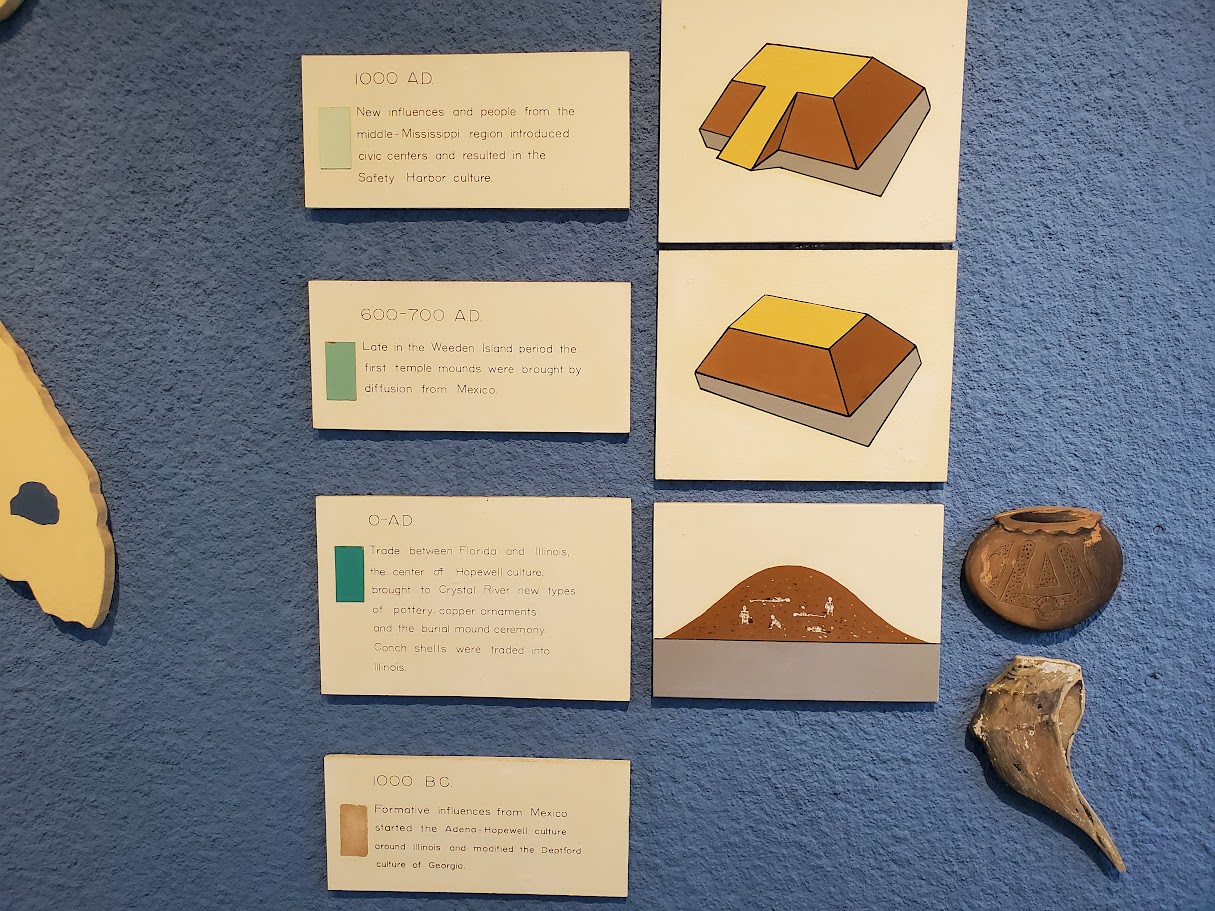
Crystal River Mounds site photo by Damien Marie AtHope
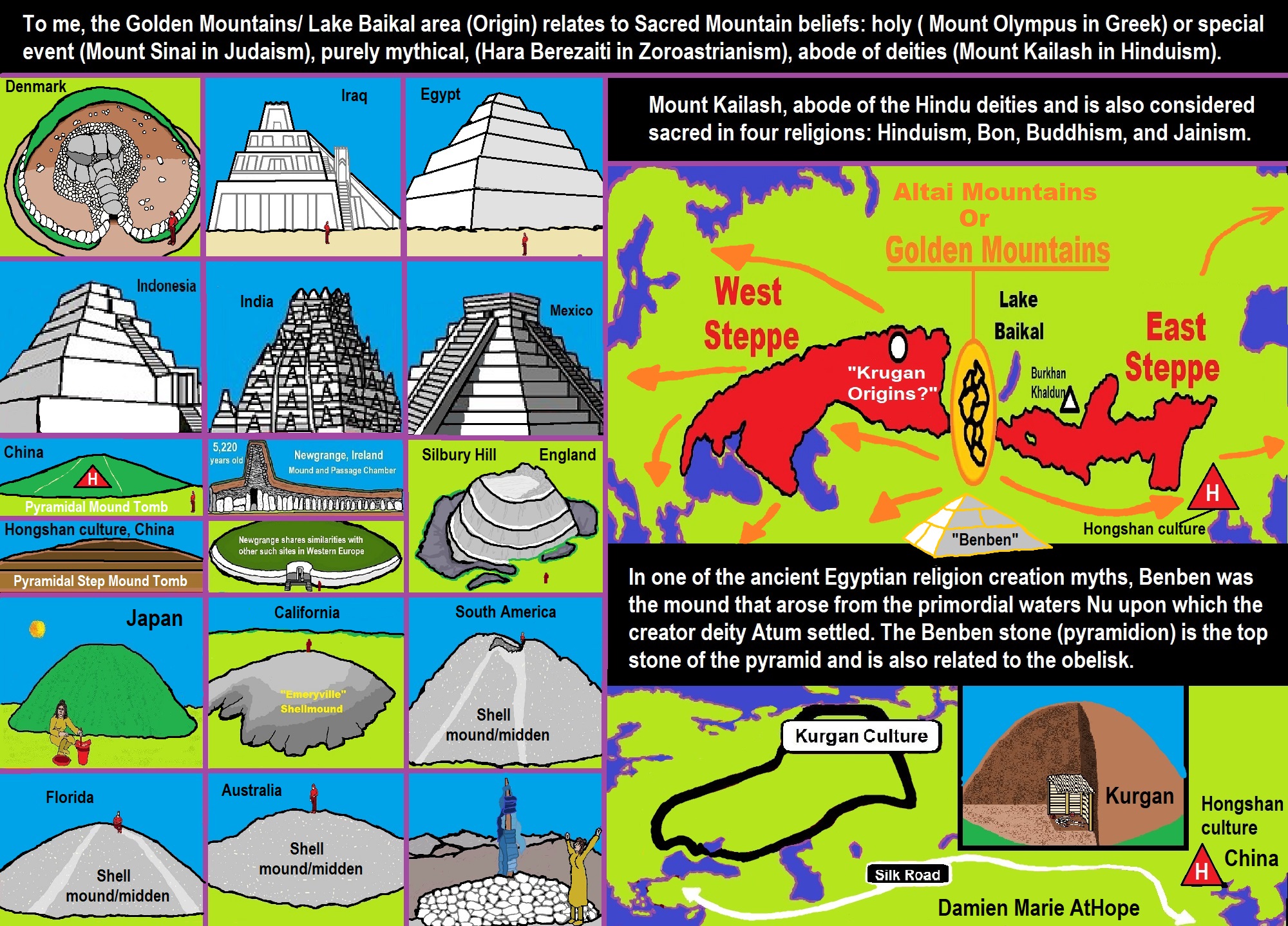

ref, ref, ref, ref, ref, ref, ref, ref, ref, ref, ref, ref, ref, ref, ref, ref, ref, ref, ref, ref, ref, ref, ref, ref, ref, ref, ref, ref
The earliest centers of pottery origin in the Russian Far East and Siberia: Review of chronology for the oldest Neolithic cultures
“Abstract: The earliest pottery from the Russian Far East, Osipovka and Gromatukha cultural complexes, was radiocarbon-dated to c. 13,300-12,300 years ago. In Siberia, the earliest pottery is known from the Ust-Karenga complex, dated to c. 11,200-10,800 years ago. The Osipovka and Gromatukha complexes belong to the Initial Neolithic, and they are contemporaneous with the earliest Neolithic cultures in southern China and Japan. In spite of the very early emergence of pottery in the Russian Far East, there is no evidence of agriculture at the beginning of the Neolithic, and subsistence remains based on hunting and fishing, including anadromous salmonids in the Amur River and its tributaries.” ref
The earliest Neolithic complex in Siberia: the Ust-Karenga 12 site and its significance for the Neolithisation process in Eurasia
“Abstract: The discovery of Neolithic (i.e. pottery-containing) components at the Ust-Karenga 12 site in northern Transbaikal brought to light new data on the appearance of pottery in Siberia. Excavations and geoarchaeological studies identified the pottery complex in layer 7, 14C-dated to c. 12,180–10,750 years ago (charcoal dates) and c. 11,070–10,600 years ago (pottery organics dates). The pottery is thin and plant fibre-tempered; vessels are round-bottomed and with a comb-pattern design. Ust-Karenga 12 thus preserves by far the earliest Neolithic assemblage in Siberia, and is only slightly younger than the Initial Neolithic complexes of the Amur River basin, Russian Far East (c. 13,300–12,400 years ago).” ref
I think the “kurgan Origin” is found in “Stratified Ritual Mounds”
“From the later seventh-millennium cal BCE, in west Siberia, a new site type emerged in this period, the large, stratified mound (Russian kholm), with examples reaching 50m in diameter and up to 6m in height. These Mounds are characterized by unusual features such as groups of human skulls, clay figurines, bone and antler, hearths, and post-row structures, and are interpreted as ritual or sacrificial sites.” ref
I think the “kurgan Origin” is found in “Stratified Ritual Mounds”
“From the later seventh-millennium cal BCE, in west Siberia, a new site type emerged in this period, the large, stratified mound (Russian kholm), with examples reaching 50m in diameter and up to 6m in height. These Mounds are characterized by unusual features such as groups of human skulls, clay figurines, bone and antler, hearths, and post-row structures, and are interpreted as ritual or sacrificial sites.” ref
“A kurgan is a type of tumulus constructed over a grave, often characterized by containing a single human body along with grave vessels, weapons, and horses. Some scepter graves could have been covered with a tumulus, placing the first kurgans as early as the 5th millennium BCE in Eastern Europe. Within the burial chamber at the heart of the kurgan, elite individuals were buried with grave goods and sacrificial offerings, sometimes including horses and chariots. These structures are of the earlier Neolithic period from the 4th to the 3rd millenniums BCE.” ref

ref, ref, ref, ref, ref, ref, ref, ref, ref, ref, ref, ref, ref, ref, ref
“A 2016 study found that the global maximum of Ancient North Eurasian (ANE) ancestry occurs in modern-day Kets, Mansi, Native Americans, and Selkups. ANE ancestry has spread throughout Eurasia and the Americas in various migrations since the Upper Paleolithic, and more than half of the world’s population today derives between 5 and 42% of their genomes from the Ancient North Eurasians. Significant ANE ancestry can be found in Native Americans, as well as in regions of northern Europe, South Asia, Central Asia, and Siberia. It has been suggested that their mythology may have featured narratives shared by both Indo-European and some Native American cultures, such as the existence of a metaphysical world tree and a fable in which a dog guards the path to the afterlife.” ref
Ancient Northern East Asian/ later became Ancient Northeast Asian
Ancient Paleo-Siberian
Mal’ta–Buret’ culture (Mal’ta boy MA-1)
The Kolyma Shaitans: Legends and Reality (I only use just a small part)
“A unique “shaitan” burial was discovered on the bank of Omuk-Kuel Lake in the Middle-Kolyma ulus in Yakutia. According to the legends, buried in it are mummified remains of a shaman woman who died during a devastating smallpox epidemics in the 18th c. In an attempt to overcome the deadly disease, the shaman’s relatives used her remains as an emeget fetish. The author believes that these legends reflect the real events of those far-away years. The Arabic word “shaitan” came to the Russian language from Turkic languages. According to Islamic tradition, a shaitan is a genie, an evil spirit, a demon. During Russian colonization and Christianization of Siberia, all sacred things used by the aborigines as fetishes, patron spirits of the family, and the tribe, grew to be called “shaitans.” There are various facts, dating to the 18th and 19th cc., confirming that this word also referred to the mummified remains of outstanding shamans.” ref
“In the 1740s, a member of the Second Kamchatka Expedition Yakov Lindenau wrote, “Meat is scratched off the [shaman’s] bones and the bones are put together to form a skeleton, which is dressed in human’s clothes and worshipped as a deity. The Yukagirs place such dressed bones…in their yurts, their number can sometimes reach 10 or 15. If somebody commits even a minor sacrilege with respect to these bones, he stirs up rancor on the part of the Yukagirs… While traveling and hunting, the Yukagirs carry these bones in their sledges, and moreover, in their best sledges pulled by their best deer. When the Yukagirs are going to undertake something really important, they tell fortune using these skeletons: lift a skeleton up, and if it seems light, it means that their enterprise will have a favorable outcome. The Yukagirs call these skeletons stariks (old men), endow them with their best furs, and sit them on beds covered with deer hides, in a circle, as though they are alive.” (Lindenau, 1983, p. 155)” ref
“In the late 19th c., a famous explorer of aboriginal culture V. I. Jochelson noted the changes that occurred in the ritual in the last century and a half. So, the Yukagirs divided among themselves the shaman’s meat dried in the sun and then put it in separate tents. The dead bodies of killed dogs were left there as well. “After that,” V. I. Jochelson writes, “they would divide the shaman’s bones, dry them and wrap in clothes. The skull was an object of worshipping. It was put on top of a trunk (body) cut out of wood. A caftan and two hats – a winter and a summer one – were sewn for the idol. The caftan was all embroidered. On the skull, a special mask was put, with holes for the eyes and the mouth… The figure was placed in the front corner of the home. Before a meal, a piece of food was thrown into the fire and the idol was held above it. This feeding of the idol… was committed before each meal.” (V. I. Jochelson, 2005, pp. 236—237)” ref
“The idol was kept by the children of the dead shaman. One of them was inducted into the shamanism mysteries while his father was still alive. The idol was carried in a wooden box. Sometimes, in line with the air burial ritual, the box was erected on poles or trees, and the idol was taken out only before hunting or a long journey so that the outcome of the enterprise planned could be predicted. With time, the Yukagirs began using wooden idols as charms. V. I. Jochelson notes that by the late 19th c. the Yukagirs had developed a skeptical attitude towards idols and referred to them as “shaitans.” In this way, under the influence of Christianity, the worshipped ancestor’s spirit turned into its opposite – an evil spirit, a devil, a Satan.” ref
Ancestral Native American, Ancient Beringian
14,000-year-old Ust-Kyakhta-3 (UKY) individual found near Lake Baikal
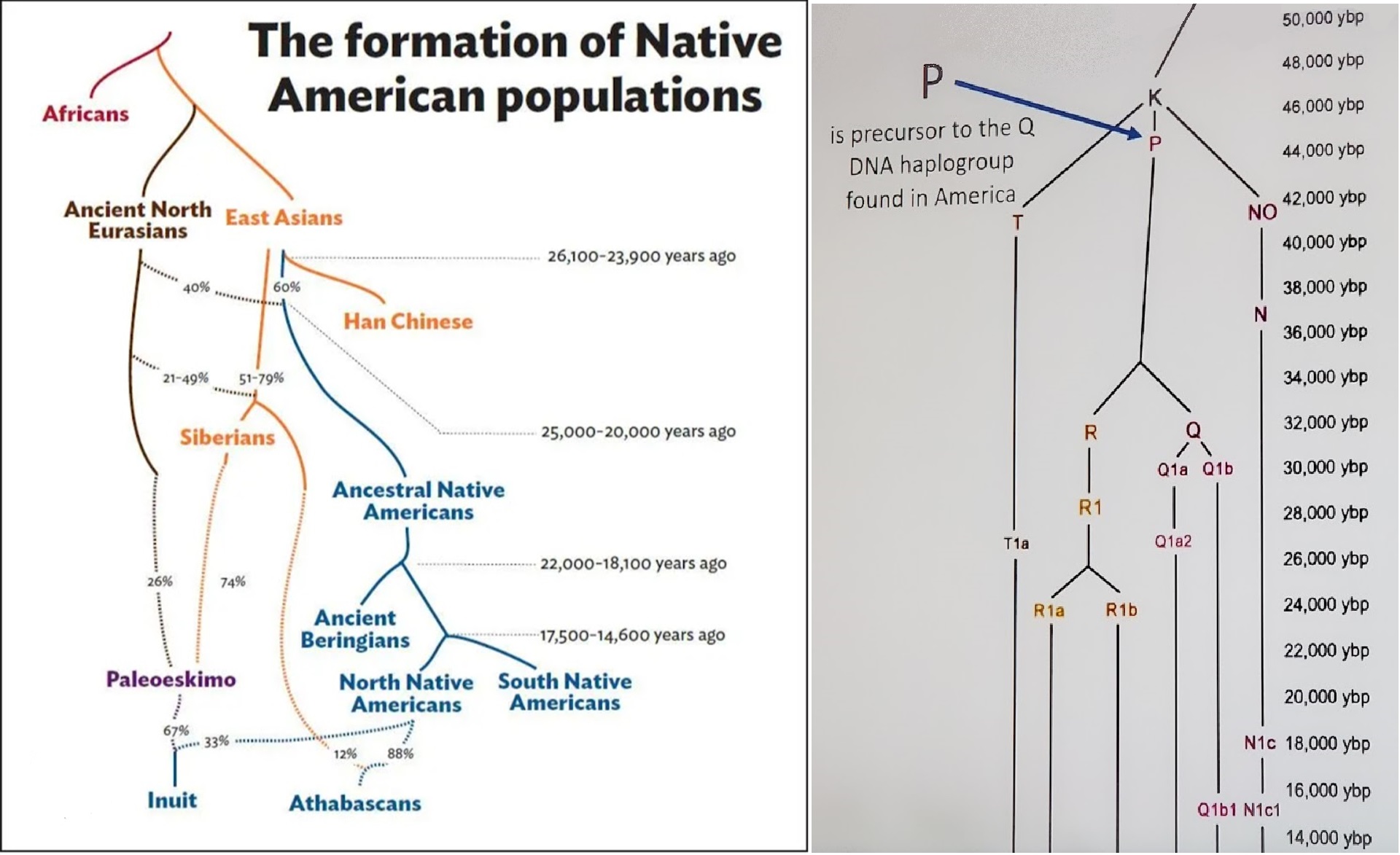
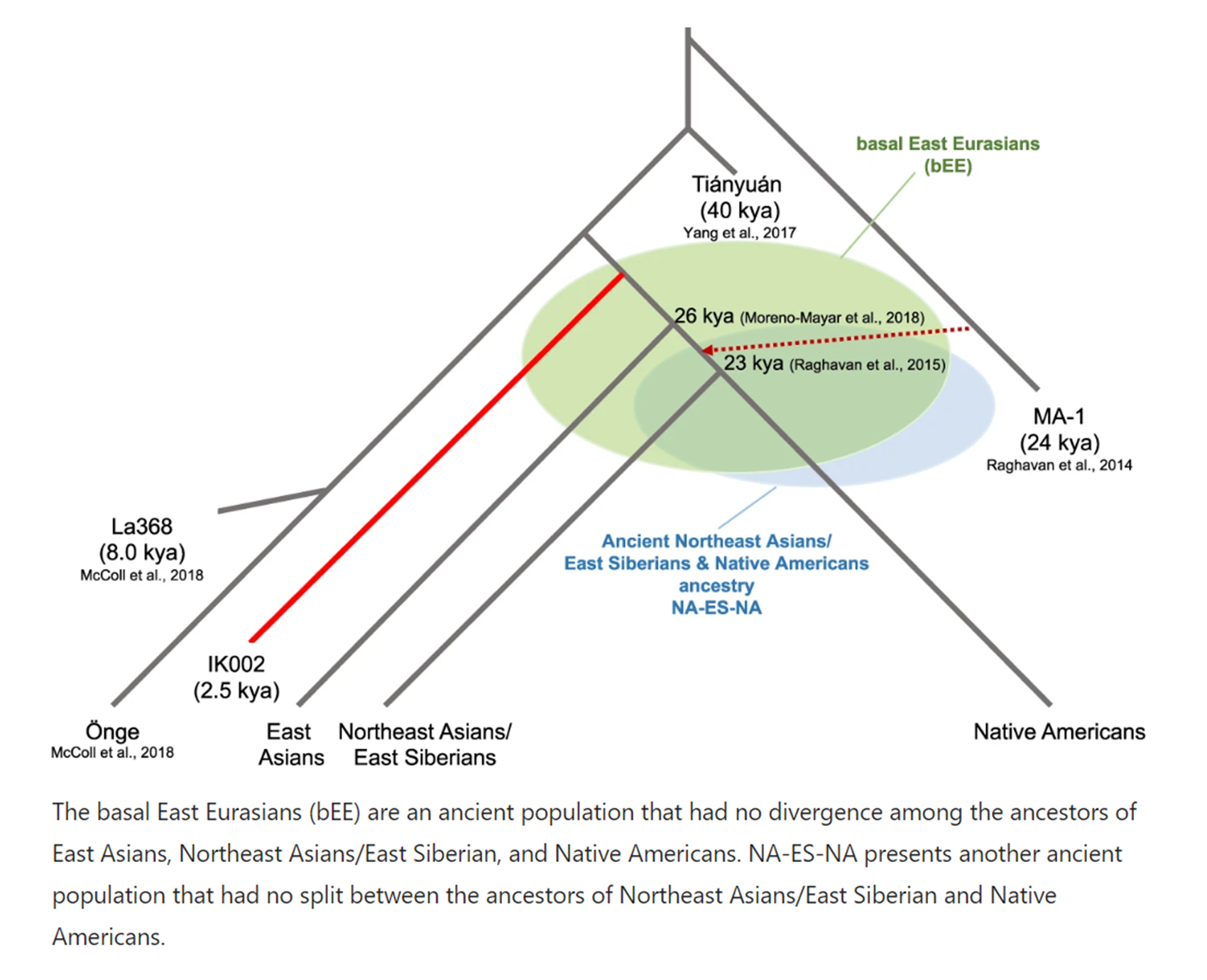
“The basal East Eurasians (bEE) are an ancient population that had no divergence among the ancestors of East Asians, Northeast Asians/East Siberian, and Native Americans. NA-ES-NA presents another ancient population that had no split between the ancestors of Northeast Asians/East Siberian and Native Americans.” ref
“Schematic of peopling history in Southeast and East Asians, Northeast Asian/East Siberians and Native Americans.” ref

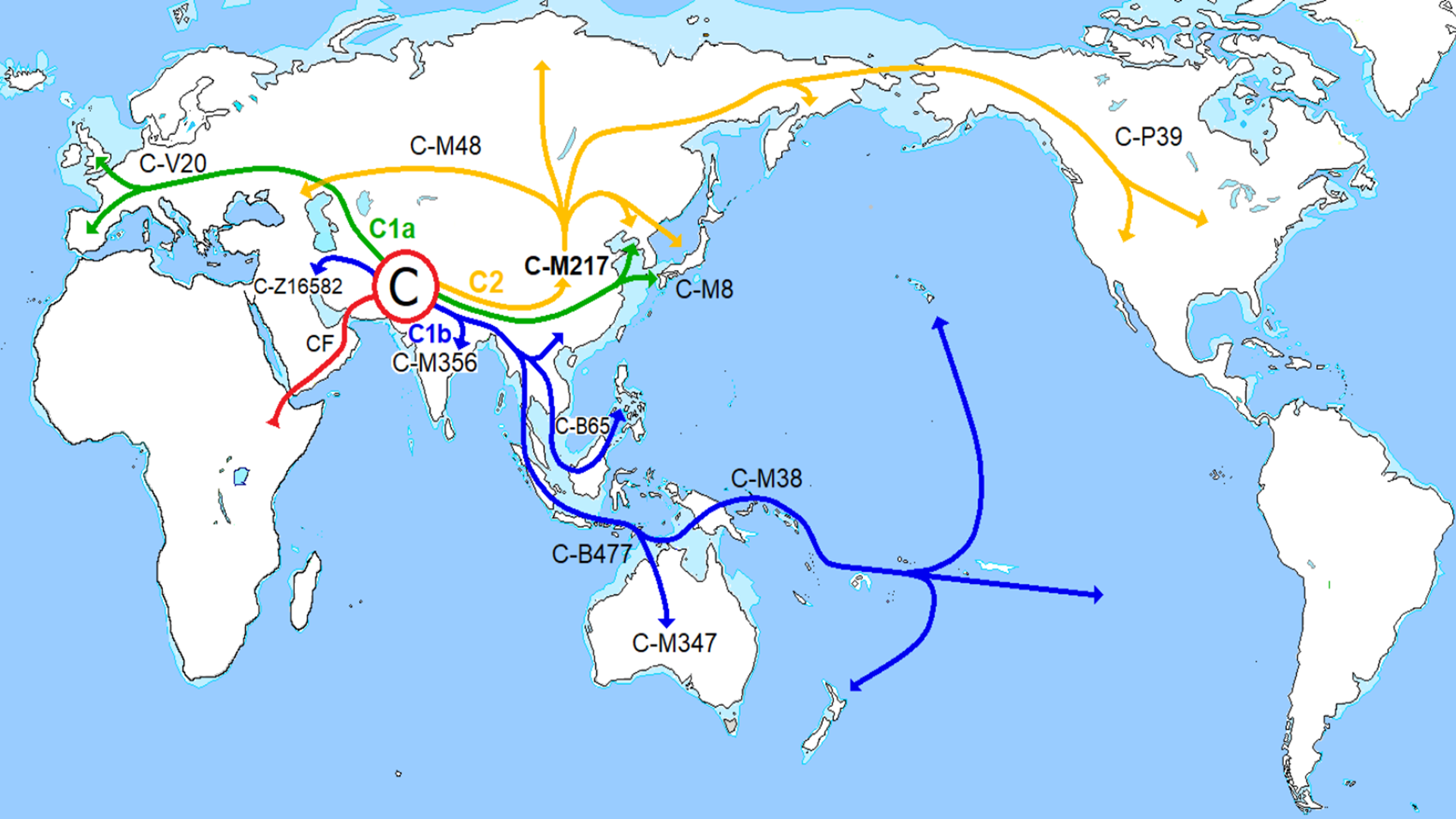
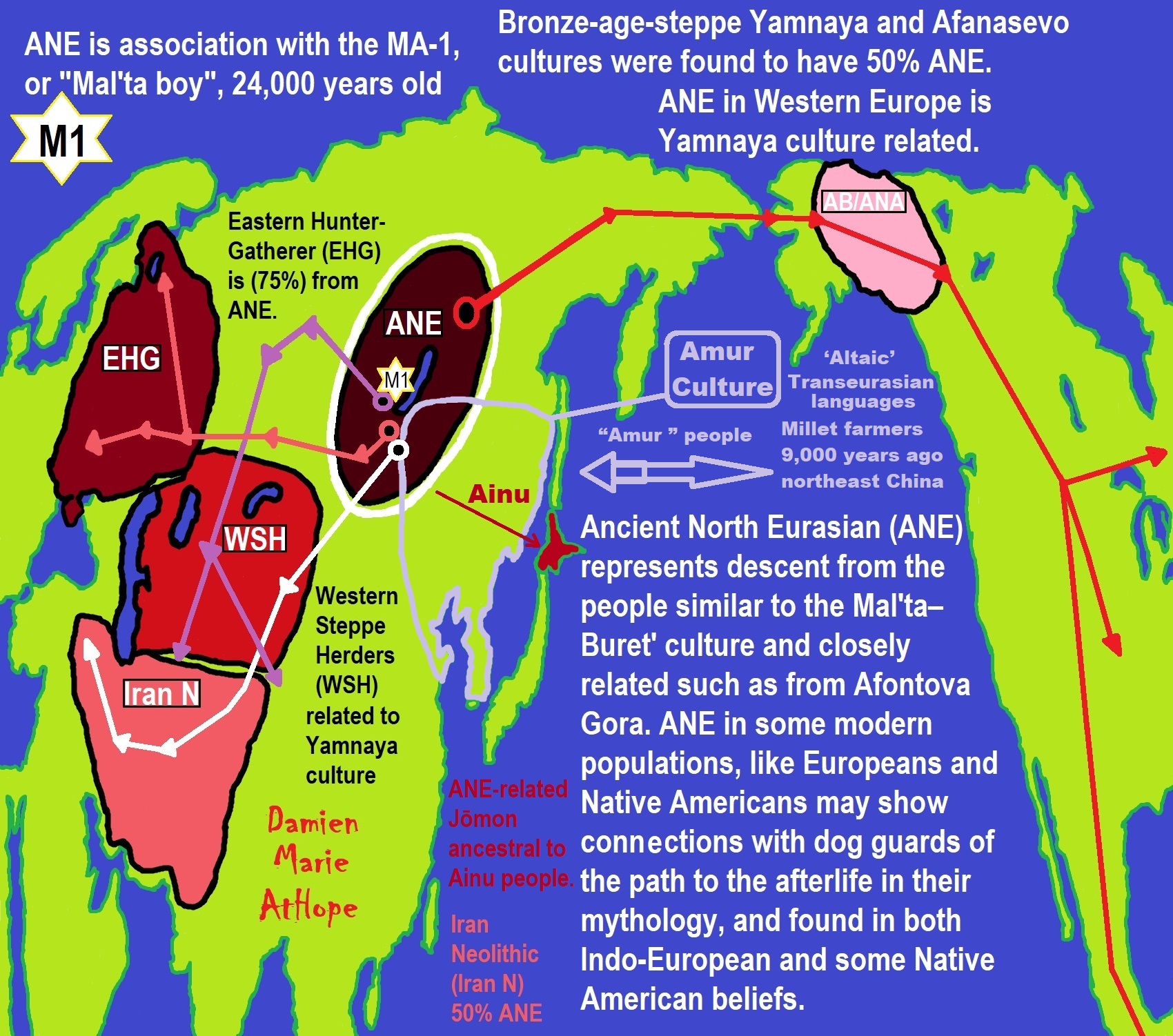
Ancient North Eurasian (ANE)
Ancient Beringian/Ancestral Native American (AB/ANA)
Eastern Hunter-Gatherer (EHG)
Western Hunter-Gatherers (WHG)
Western Steppe Herders (WSH)
Scandinavian Hunter-Gatherer (SHG)
Early European Farmers (EEF)
Jōmon people (Ainu people OF Hokkaido Island)
Neolithic Iranian farmers (Iran_N) (Iran Neolithic)
Haplogroup R possible time of origin about 27,000 years in Central Asia, South Asia, or Siberia:
- Mal’ta–Buret’ culture (24,000-15,000 years ago)
- Afontova Gora culture (21,000-12,000 years ago)
- Trialetian culture (16,000–8000 years ago)
- Samara culture (7,000-6,500 years ago)
- Khvalynsk culture (7,000-6,500 years ago)
- Afanasievo culture (5,300-4,500 years ago)
- Yamna/Yamnaya Culture (5,300-4,500 years ago)
- Andronovo culture (4,000–2,900 years ago) ref
Groups partially derived from the Ancient North Eurasians
“The ANE lineage is defined by association with the MA-1, or “Mal’ta boy”, remains of 24,000 years ago in central Siberia Mal’ta-Buret’ culture 24,000-15,000 years ago. The Ancient North Eurasians (ANE) samples (Afontova Gora 3, Mal’ta 1, and Yana-RHS) show evidence for minor gene flow from an East Asian-related group (simplified by the Amis, Han, or Tianyuan) but no evidence for ANE-related geneflow into East Asians (Amis, Han, Tianyuan), except the Ainu, of North Japan.” ref
“The ANE lineage is defined by association with the MA-1, or “Mal’ta boy”, remains of 24,000 years ago in central Siberia Mal’ta-Buret’ culture 24,000-15,000 years ago “basal to modern-day Europeans”. Some Ancient North Eurasians also carried East Asian populations, such as Tianyuan Man.” ref
“Bronze-age-steppe Yamnaya and Afanasevo cultures were ANE at around 50% and Eastern Hunter-Gatherer (EHG) at around 75% ANE. Karelia culture: Y-DNA R1a-M417 8,400 years ago, Y-DNA J, 7,200 years ago, and Samara, of Y-haplogroup R1b-P297 7,600 years ago is closely related to ANE from Afontova Gora, 18,000 years ago around the time of blond hair first seen there.” ref
Ancient North Eurasian
“In archaeogenetics, the term Ancient North Eurasian (often abbreviated as ANE) is the name given to an ancestral West Eurasian component that represents descent from the people similar to the Mal’ta–Buret’ culture and populations closely related to them, such as from Afontova Gora and the Yana Rhinoceros Horn Site. Significant ANE ancestry are found in some modern populations, including Europeans and Native Americans.” ref
“The ANE lineage is defined by association with the MA-1, or “Mal’ta boy“, the remains of an individual who lived during the Last Glacial Maximum, 24,000 years ago in central Siberia, Ancient North Eurasians are described as a lineage “which is deeply related to Paleolithic/Mesolithic hunter-gatherers in Europe,” meaning that they diverged from Paleolithic Europeans a long time ago.” ref
“The ANE population has also been described as having been “basal to modern-day Europeans” but not especially related to East Asians, and is suggested to have perhaps originated in Europe or Western Asia or the Eurasian Steppe of Central Asia. However, some samples associated with Ancient North Eurasians also carried ancestry from an ancient East Asian population, such as Tianyuan Man. Sikora et al. (2019) found that the Yana RHS sample (31,600 BP) in Northern Siberia “can be modeled as early West Eurasian with an approximately 22% contribution from early East Asians.” ref
“Populations genetically similar to MA-1 were an important genetic contributor to Native Americans, Europeans, Central Asians, South Asians, and some East Asian groups, in order of significance. Lazaridis et al. (2016:10) note “a cline of ANE ancestry across the east-west extent of Eurasia.” The ancient Bronze-age-steppe Yamnaya and Afanasevo cultures were found to have a noteworthy ANE component at ~50%.” ref
“According to Moreno-Mayar et al. 2018 between 14% and 38% of Native American ancestry may originate from gene flow from the Mal’ta–Buret’ people (ANE). This difference is caused by the penetration of posterior Siberian migrations into the Americas, with the lowest percentages of ANE ancestry found in Eskimos and Alaskan Natives, as these groups are the result of migrations into the Americas roughly 5,000 years ago.” ref
“Estimates for ANE ancestry among first wave Native Americans show higher percentages, such as 42% for those belonging to the Andean region in South America. The other gene flow in Native Americans (the remainder of their ancestry) was of East Asian origin. Gene sequencing of another south-central Siberian people (Afontova Gora-2) dating to approximately 17,000 years ago, revealed similar autosomal genetic signatures to that of Mal’ta boy-1, suggesting that the region was continuously occupied by humans throughout the Last Glacial Maximum.” ref
“The earliest known individual with a genetic mutation associated with blonde hair in modern Europeans is an Ancient North Eurasian female dating to around 16000 BCE from the Afontova Gora 3 site in Siberia. It has been suggested that their mythology may have included a narrative, found in both Indo-European and some Native American fables, in which a dog guards the path to the afterlife.” ref
“Genomic studies also indicate that the ANE component was introduced to Western Europe by people related to the Yamnaya culture, long after the Paleolithic. It is reported in modern-day Europeans (7%–25%), but not of Europeans before the Bronze Age. Additional ANE ancestry is found in European populations through paleolithic interactions with Eastern Hunter-Gatherers, which resulted in populations such as Scandinavian Hunter-Gatherers.” ref
“The Ancient North Eurasians (ANE) split from the ancestors of European peoples somewhere in the Middle East or South-central Asia, and used a northern dispersal route through Central Asia into Northern Asia and Siberia. Genetic analyses show that all ANE samples (Afontova Gora 3, Mal’ta 1, and Yana-RHS) show evidence for minor gene flow from an East Asian-related group (simplified by the Amis, Han, or Tianyuan). In contrast, no evidence for ANE-related geneflow into East Asians (Amis, Han, Tianyuan), except the Ainu, was found.” ref
“Genetic data suggests that the ANE formed during the Terminal Upper-Paleolithic (36+-1,5ka) period from a deeply European-related population, which was once widespread in Northern Eurasia, and from an early East Asian-related group, which migrated northwards into Central Asia and Siberia, merging with this deeply European-related population. These population dynamics and constant northwards geneflow of East Asian-related ancestry would later gave rise to the “Ancestral Native Americans” and Paleosiberians, which replaced the ANE as dominant population of Siberia.” ref
Groups partially derived from the Ancient North Eurasians
“Eastern Hunter-Gatherer (EHG) is a lineage derived predominantly (75%) from ANE. It is represented by two individuals from Karelia, one of Y-haplogroup R1a-M417, dated c. 8.4 kya, the other of Y-haplogroup J, dated c. 7.2 kya; and one individual from Samara, of Y-haplogroup R1b-P297, dated c. 7.6 kya. This lineage is closely related to the ANE sample from Afontova Gora, dated c. 18 kya. After the end of the Last Glacial Maximum, the Western Hunter-Gatherers (WHG) and EHG lineages merged in Eastern Europe, accounting for early presence of ANE-derived ancestry in Mesolithic Europe. Evidence suggests that as Ancient North Eurasians migrated West from Eastern Siberia, they absorbed Western Hunter-Gatherers and other West Eurasian populations as well.” ref
“Caucasian Hunter-Gatherer (CHG) is represented by the Satsurblia individual dated ~13 kya (from the Satsurblia cave in Georgia), and carried 36% ANE-derived admixture. While the rest of their ancestry is derived from the Dzudzuana cave individual dated ~26 kya, which lacked ANE-admixture, Dzudzuana affinity in the Caucasus decreased with the arrival of ANE at ~13 kya Satsurblia.” ref
“Scandinavian Hunter-Gatherer (SHG) is represented by several individuals buried at Motala, Sweden ca. 6000 BC. They were descended from Western Hunter-Gatherers who initially settled Scandinavia from the south, and later populations of EHG who entered Scandinavia from the north through the coast of Norway.” ref
“Iran Neolithic (Iran_N) individuals dated ~8.5 kya carried 50% ANE-derived admixture and 50% Dzudzuana-related admixture, marking them as different from other Near-Eastern and Anatolian Neolithics who didn’t have ANE admixture. Iran Neolithics were later replaced by Iran Chalcolithics, who were a mixture of Iran Neolithic and Near Eastern Levant Neolithic.” ref
“Ancient Beringian/Ancestral Native American are specific archaeogenetic lineages, based on the genome of an infant found at the Upward Sun River site (dubbed USR1), dated to 11,500 years ago. The AB lineage diverged from the Ancestral Native American (ANA) lineage about 20,000 years ago.” ref
“West Siberian Hunter-Gatherer (WSHG) are a specific archaeogenetic lineage, first reported in a genetic study published in Science in September 2019. WSGs were found to be of about 30% EHG ancestry, 50% ANE ancestry, and 20% to 38% East Asian ancestry.” ref
“Western Steppe Herders (WSH) is the name given to a distinct ancestral component that represents descent closely related to the Yamnaya culture of the Pontic–Caspian steppe. This ancestry is often referred to as Yamnaya ancestry or Steppe ancestry.” ref
“Late Upper Paeolithic Lake Baikal – Ust’Kyakhta-3 (UKY) 14,050-13,770 BP were mixture of 30% ANE ancestry and 70% East Asian ancestry.” ref
“Lake Baikal Holocene – Baikal Eneolithic (Baikal_EN) and Baikal Early Bronze Age (Baikal_EBA) derived 6.4% to 20.1% ancestry from ANE, while rest of their ancestry was derived from East Asians. Fofonovo_EN near by Lake Baikal were mixture of 12-17% ANE ancestry and 83-87% East Asian ancestry.” ref
“Hokkaido Jōmon people specifically refers to the Jōmon period population of Hokkaido in northernmost Japan. Though the Jōmon people themselves descended mainly from East Asian lineages, one study found an affinity between Hokkaido Jōmon with the Northern Eurasian Yana sample (an ANE-related group, related to Mal’ta), and suggest as an explanation the possibility of minor Yana gene flow into the Hokkaido Jōmon population (as well as other possibilities). A more recent study by Cooke et al. 2021, confirmed ANE-related geneflow among the Jōmon people, partially ancestral to the Ainu people. ANE ancestry among Jōmon people is estimated at 21%, however, there is a North to South cline within the Japanese archipelago, with the highest amount of ANE ancestry in Hokkaido and Tohoku.” ref
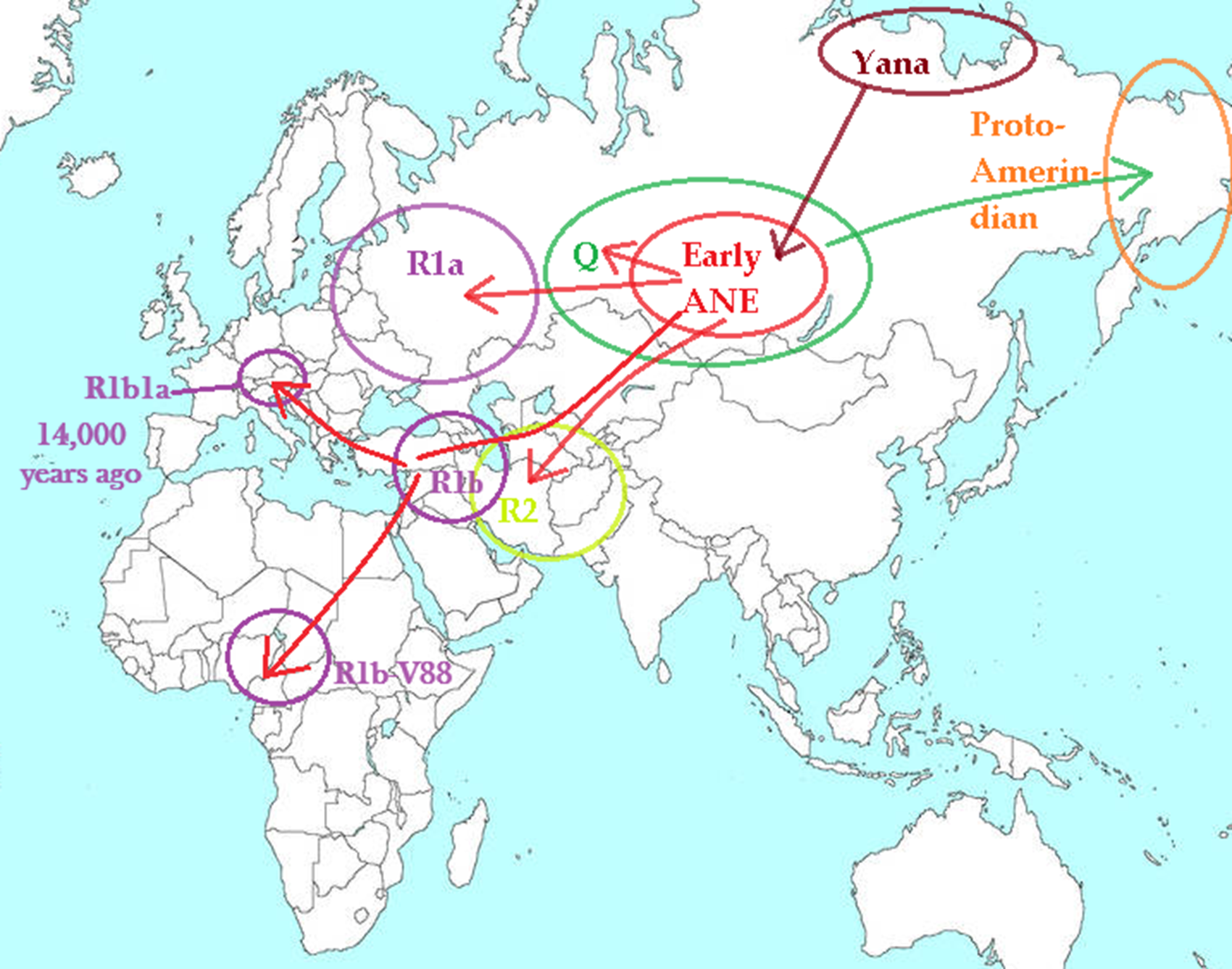
Haplogroup migrations related to the Ancient North Eurasians: I added stuff to this map to help explain.
People reached Lake Baikal Siberia around 25,000 years ago. They (to Damien) were likely Animistic Shamanists who were also heavily totemistic as well. Being animistic thinkers they likely viewed amazing things in nature as a part of or related to something supernatural/spiritual (not just natural as explained by science): spirit-filled, a sprit-being relates to or with it, it is a sprit-being, it is a supernatural/spiritual creature, or it is a great spirit/tutelary deity/goddess-god. From there comes mythology and faith in things not seen but are believed to somehow relate or interact with this “real world” we know exists.
Both areas of Lake Baikal, one on the west side with Ancient North Eurasian culture and one on the east side with Ancient Northern East Asian culture (later to become: Ancient Northeast Asian culture) areas are the connected areas that (to Damien) are the origin ancestry religion area for many mythologies and religious ideas of the world by means of a few main migrations and many smaller ones leading to a distribution of religious ideas that even though are vast in distance are commonly related to and centering on Lake Baikal and its surrounding areas like the Amur region and Altai Mountains region.
To an Animistic Thinker: “Things are not just as they seem, they may have a spirit, or spirit energy relates to them”
To a Totemistic Thinker: “Things are not just as they seem, they may have a spirit, or spirit energy relates to them; they may have religio-cultural importance.”
“Ancient North Eurasian population had Haplogroups R, P, U, and Q DNA types: defined by maternal West-Eurasian ancestry components (such as mtDNA haplogroup U) and paternal East-Eurasian ancestry components (such as yDNA haplogroup P1 (R*/Q*).” ref
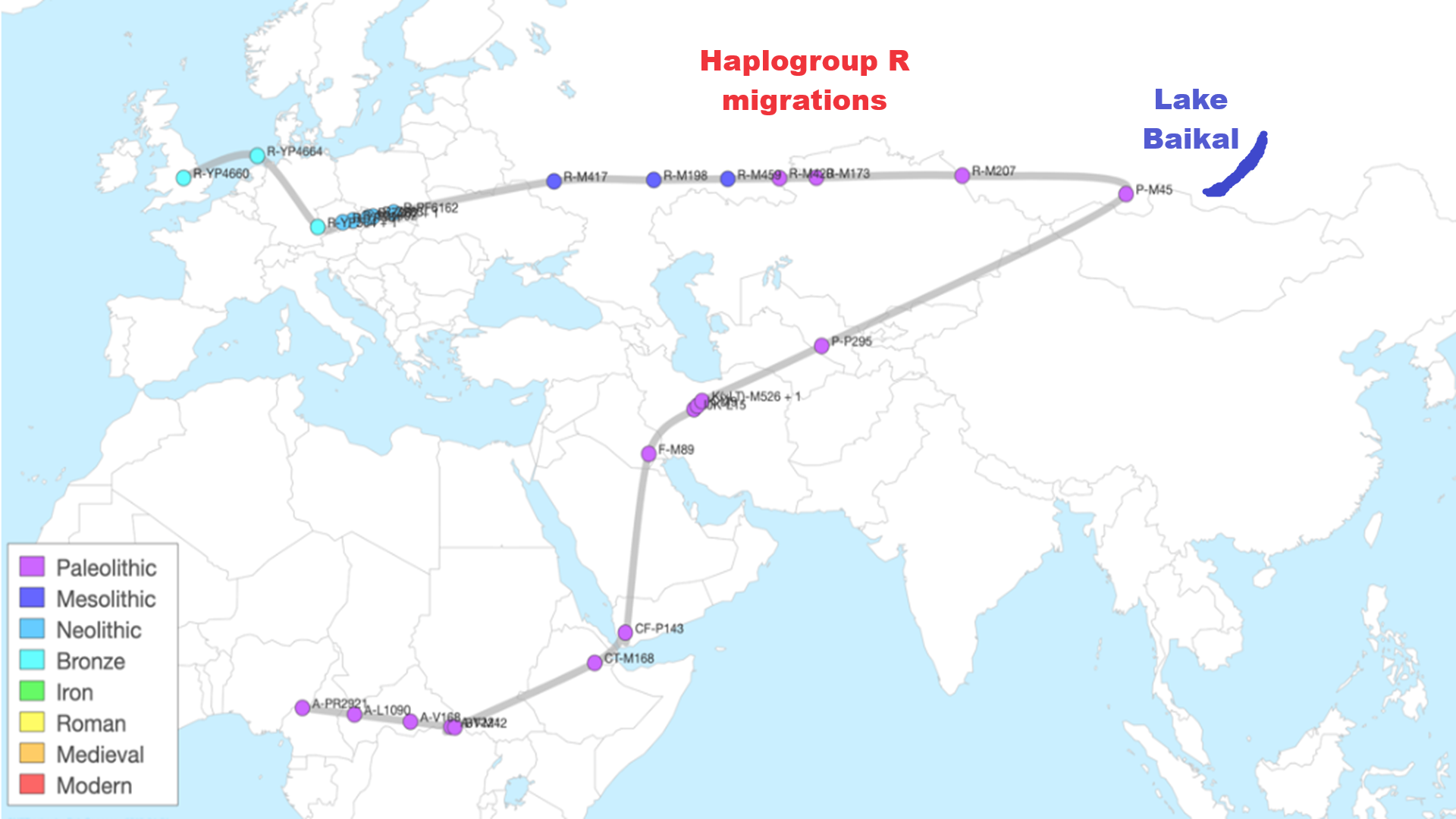
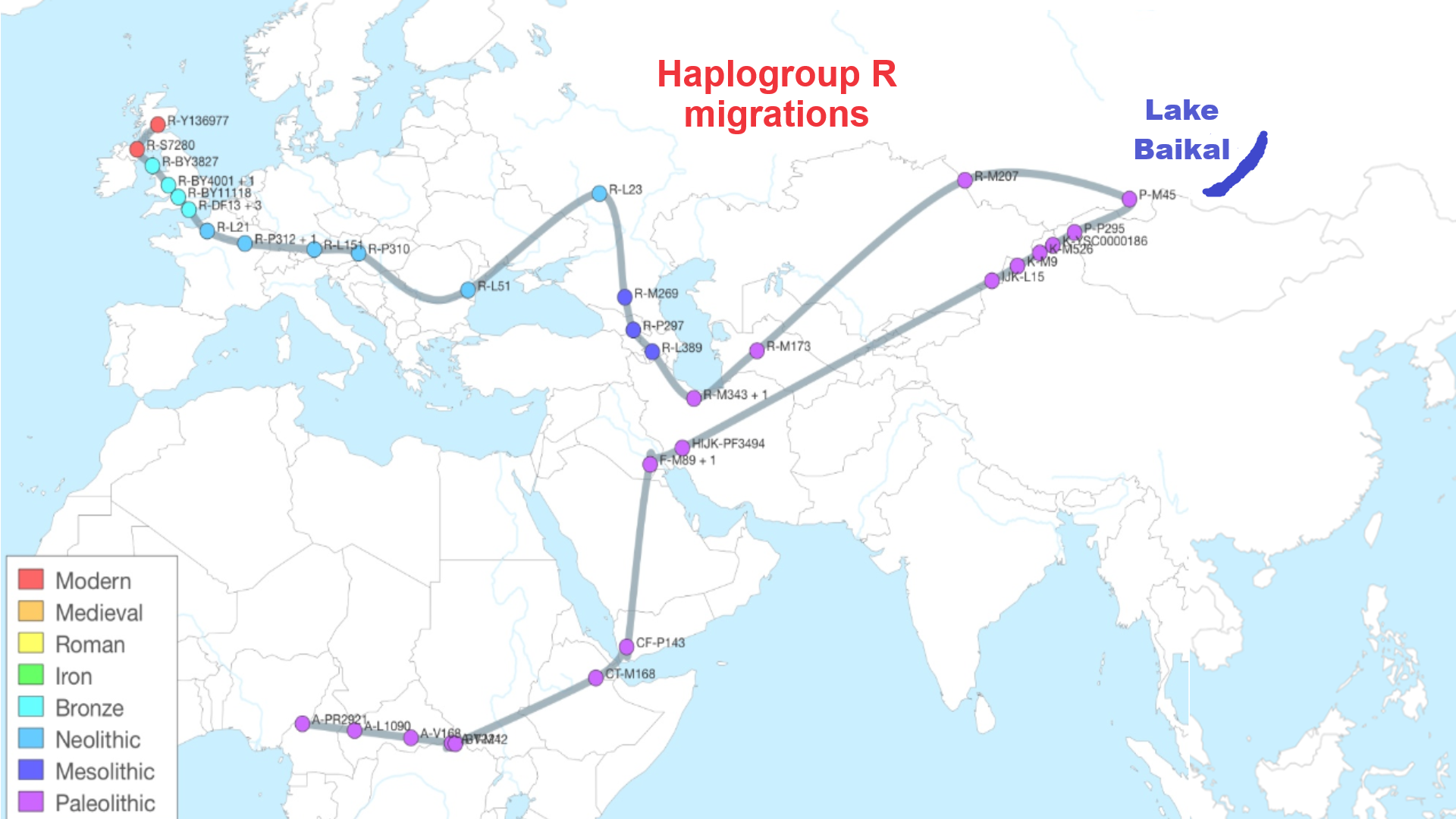
Haplogroup R1a Y-DNA
“Haplogroup R* originated in North Asia just before the Last Glacial Maximum (26,500-19,000 years before present). This haplogroup has been identified in the 24,000 year-old remains of the so-called “Mal’ta boy” from the Altai region, in south-central Siberia (Raghavan et al. 2013). This individual belonged to a tribe of mammoth hunters that may have roamed across Siberia and parts of Europe during the Paleolithic. Autosomally this Paleolithic population appears to have passed on its genes mostly to the modern populations of Europea and South Asia, the two regions where haplogroup R also happens to be the most common nowadays (R1b in Western Europe, R1a in Eastern Europe, Central and South Asia, and R2 in South Asia).” ref
“The series of mutations that made haplogroup R1* evolve into R1a probably took place during or soon after the Last Glacial Maxium. Little is know for certain about R1a’s place of origin. Some think it might have originated in the Balkans or around Pakistan and Northwest India, due to the greater genetic diversity found in these regions. The diversity can be explained by other factors though. The Balkans have been subject to 5000 years of migrations from the Eurasian Steppes, each bringing new varieties of R1a. South Asia has had a much bigger population than any other parts of the world (occasionally equalled by China) for at least 10,000 years, and larger population bring about more genetic diversity. The most likely place of origin of R1a is Central Asia or southern Russia/Siberia.” ref
“From there, R1a could have migrated directly to eastern Europe (European Russia, Ukraine, Belarus), or first southward through Central Asia and Iran. In that latter scenario, R1a would have crossed the Caucasus during the Neolithic, alongside R1b, to colonize the Pontic-Caspian Steppe. In the absence of ancient Y-DNA from those regions, the best evidence supporting a Late Paleolithic migration to Iran is the presence of very old subclades of R1a (like M420) in the region, notably in the Zagros mountains. However, these samples only make up a fraction of all R1a in the region and could just as well represent the descendants of Eastern European hunter-gatherers who branched off from other R1a tribes and crossed from the North Caucasus any time between 20,000 and 8,000 years ago. The logic behind this is that most known historical migrations in Eurasia took place from north to south, as people sought warmer climes. The only exception happened during the Holocene warming up of the climate, which corresponds to the Neolithic colonization of Europe from the Near East. A third possibility is that R1a tribes split in two around Kazakhstan during the Late Paleolithic, with one group moving to eastern Europe, while the other moved south to Iran.” ref
“Some people have theorized that R1a was one of the lineages of the Neolithic farmers, and would have entered Europe through Anatolia, then spread across the Balkans toward Central Europe, then only to Eastern Europe. There are many issues with this scenario. The first is that 99% of modern R1a descends from the branch R1a-M417, which clearly expanded from the Bronze Age onwards, not from the early Neolithic. Its phylogeny also points at an Eastern European origin. Secondly, most of the R1a in Middle East are deep subclades of the R1a-Z93 branch, which originated in Russia (see below). It could not have been ancestral to Balkanic or Central European R1a. Thirdly, there is a very strong correlation between the Northeast European autosomal admixture and R1a populations, and this component is missing from the genome of all European Neolithic farmers tested to date – even from Ötzi, who was a Chalcolithic farmer. This admixture is also missing from modern Sardinians, who are mostly descended from Neolithic farmers. This is incontrovertible evidence that R1a did not come to Europe with Neolithic farmers, but only propagated from Eastern Europe to the rest of Europe from the Bronze Age onwards.” ref
“R1a is thought to have been the dominant haplogroup among the northern and eastern Proto-Indo-European tribes, who evolved into the Indo-Iranian, Thracian, Baltic, and Slavic people. The Proto-Indo-Europeans originated in the Yamna culture (3300-2500 BCE). Their dramatic expansion was possible thanks to an early adoption of bronze weapons and the domestication of the horse in the Eurasian steppes (circa 4000-3500 BCE). Individuals from the southern part of the Steppe are believed to have carried predominantly lineages belonging to haplogroup R1b (L23 and subclades), while the people of northern forest-steppe to the north would have belonged essentially to haplogroup R1a. The first expansion of the forest-steppe people occurred with the Corded Ware Culture (see Germanic branch below). The forest-steppe origin of this culture is obvious from the usage of corded pottery and the abundant use of polished battle axes, the two most prominent features of the Corded Ware culture. This is also probably the time when the satemisation process of the Indo-European languages began, considering that the Balto-Slavic and Indo-Iranian language groups belong to the same Satem isogloss and both appear to have evolved from the Catacomb and Srubna cultures.” ref
“Ancient DNA testing has confirmed the presence of haplogroup R1a-M417 in samples from the Corded Ware culture in Germany (2600 BCE), from Tocharian mummies (2000 BCE) in Northwest China, from Kurgan burials (circa 1600 BCE) from the Andronovo culture in southern Russia and southern Siberia, as well as from a variety of Iron-age sites from Russia, Siberia, Mongolia and Central Asia. Nowadays, high frequencies of R1a are found in Poland (57.5% of the population), Ukraine (40 to 65%), European Russia (45 to 65%), Belarus (51%), Slovakia (42%), Latvia (40%), Lithuania (38%), the Czech Republic (34%), Hungary (32%), Norway (27%), Austria (26%), Croatia (24%), north-east Germany (24%) Sweden (19%), and Romania (18%).” ref
Haplogroup R1b Y-DNA
“Haplogroup R* originated in North Asia just before the Last Glacial Maximum (26,500-19,000 years ago). This haplogroup has been identified in the remains of a 24,000 year-old boy from the Altai region, in south-central Siberia (Raghavan et al. 2013). This individual belonged to a tribe of mammoth hunters that may have roamed across Siberia and parts of Europe during the Paleolithic. Autosomally this Paleolithic population appears to have contributed mostly to the ancestry of modern Europeans and South Asians, the two regions where haplogroup R also happens to be the most common nowadays (R1b in Western Europe, R1a in Eastern Europe, Central and South Asia, and R2 in South Asia).” ref
“The oldest forms of R1b (M343, P25, L389) are found dispersed at very low frequencies from Western Europe to India, a vast region where could have roamed the nomadic R1b hunter-gatherers during the Ice Age. The three main branches of R1b1 (R1b1a, R1b1b, R1b1c) all seem to have stemmed from the Middle East. The southern branch, R1b1c (V88), is found mostly in the Levant and Africa. The northern branch, R1b1a (P297), seems to have originated around the Caucasus, eastern Anatolia, or northern Mesopotamia, then to have crossed over the Caucasus, from where they would have invaded Europe and Central Asia. R1b1b (M335) has only been found in Anatolia.” ref
“It has been hypothesized that R1b people (perhaps alongside neighboring J2 tribes) were the first to domesticate cattle in northern Mesopotamia some 10,500 years ago. R1b tribes descended from mammoth hunters, and when mammoths went extinct, they started hunting other large game, such as bisons and aurochs. With the increase of the human population in the Fertile Crescent from the beginning of the Neolithic (starting 12,000 years ago), selective hunting and culling of herds started replacing indiscriminate killing of wild animals. The increased involvement of humans in the life of aurochs, wild boars, and goats led to their progressive taming. Cattle herders probably maintained a nomadic or semi-nomadic existence, while other people in the Fertile Crescent (presumably represented by haplogroups E1b1b, G, and T) settled down to cultivate the land or keep smaller domesticates.” ref
“The analysis of bovine DNA has revealed that all the taurine cattle (Bos taurus) alive today descend from a population of only 80 aurochs. The earliest evidence of cattle domestication dates from circa 8,500 BCE in the Pre-Pottery Neolithic cultures in the Taurus Mountains. The two oldest archaeological sites showing signs of cattle domestication are the villages of Çayönü Tepesi in southeastern Turkey and Dja’de el-Mughara in northern Iraq, two sites only 250 km away from each others. This is presumably the area from which R1b lineages started expanding – or in other words the “original homeland” of R1b.” ref
“The early R1b cattle herders would have split in at least three groups. One branch (M335) remained in Anatolia, but judging from its extreme rarity today wasn’t very successful, perhaps due to the heavy competition with other Neolithic populations in Anatolia, or to the scarcity of pastures in this mountainous environment. A second branch migrated south to the Levant, where it became the V88 branch. Some of them searched for new lands south of Africa, first in Egypt, then colonizing most of northern Africa, from the Mediterranean coast to the Sahel. The third branch (P297), crossed the Caucasus into the vast Pontic-Caspian Steppe, which provided ideal grazing grounds for cattle. They split into two factions: R1b1a1 (M73), which went east along the Caspian Sea to Central Asia, and R1b1a2 (M269), which at first remained in the North Caucasus and the Pontic Steppe between the Dnieper and the Volga. It is not yet clear whether M73 actually migrated across the Caucasus and reached Central Asia via Kazakhstan, or if it went south through Iran and Turkmenistan. In any case, M73 would be a pre-Indo-European branch of R1b, just like V88 and M335.” ref
“R1b-M269 (the most common form in Europe) is closely associated with the diffusion of Indo-European languages, as attested by its presence in all regions of the world where Indo-European languages were spoken in ancient times, from the Atlantic coast of Europe to the Indian subcontinent, which comprised almost all Europe (except Finland, Sardinia and Bosnia-Herzegovina), Anatolia, Armenia, European Russia, southern Siberia, many pockets around Central Asia (notably in Xinjiang, Turkmenistan, Tajikistan, and Afghanistan), without forgetting Iran, Pakistan, northern India, and Nepal. The history of R1b and R1a are intricately connected to each other.” ref
“Like its northern counterpart (R1b-M269), R1b-V88 is associated with the domestication of cattle in northern Mesopotamia. Both branches of R1b probably split soon after cattle were domesticated, approximately 10,500 years ago (8,500 BCE). R1b-V88 migrated south towards the Levant and Egypt. The migration of R1b people can be followed archeologically through the presence of domesticated cattle, which appear in central Syria around 8,000-7,500 BCE (late Mureybet period), then in the Southern Levant and Egypt around 7,000-6,500 BCE (e.g. at Nabta Playa and Bir Kiseiba). Cattle herders subsequently spread across most of northern and eastern Africa. The Sahara desert would have been more humid during the Neolithic Subpluvial period (c. 7250-3250 BCE), and would have been a vast savannah full of grass, an ideal environment for cattle herding.” ref
“Evidence of cow herding during the Neolithic has shown up at Uan Muhuggiag in central Libya around 5500 BCE, at the Capeletti Cave in northern Algeria around 4500 BCE. But the most compelling evidence that R1b people related to modern Europeans once roamed the Sahara is to be found at Tassili n’Ajjer in southern Algeria, a site famous pyroglyphs (rock art) dating from the Neolithic era. Some painting dating from around 3000 BCE depict fair-skinned and blond or auburn haired women riding on cows. The oldest known R1b-V88 sample in Europe is a 6,200 year-old farmer/herder from Catalonia tested by Haak et al. (2015). Autosomally this individual was a typical Near Eastern farmer, possessing just a little bit of Mesolithic West European admixture.” ref
“After reaching the Maghreb, R1b-V88 cattle herders could have crossed the Strait of Gibraltar to Iberia, probably accompanied by G2 farmers, J1 and T1a goat herders. These North African Neolithic farmers/herders could have been the ones who established the Almagra Pottery culture in Andalusia in the 6th millennium BCE.” ref
“Nowadays, small percentages (1 to 4%) of R1b-V88 are found in the Levant, among the Lebanese, the Druze, and the Jews, and almost in every country in Africa north of the equator. Higher frequency in Egypt (5%), among Berbers from the Egypt-Libya border (23%), among the Sudanese Copts (15%), the Hausa people of Sudan (40%), the the Fulani people of the Sahel (54% in Niger and Cameroon), and Chadic tribes of northern Nigeria and northern Cameroon (especially among the Kirdi), where it is observed at a frequency ranging from 30% to 95% of men. According to Cruciani et al. (2010) R1b-V88 would have crossed the Sahara between 9,200 and 5,600 years ago, and is most probably associated with the diffusion of Chadic languages, a branch of the Afroasiatic languages. V88 would have migrated from Egypt to Sudan, then expanded along the Sahel until northern Cameroon and Nigeria. However, R1b-V88 is not only present among Chadic speakers, but also among Senegambian speakers (Fula-Hausa) and Semitic speakers (Berbers, Arabs).” ref
“R1b-V88 is found among the native populations of Rwanda, South Africa, Namibia, Angola, Congo, Gabon, Equatorial Guinea, Ivory Coast, Guinea-Bissau. The wide distribution of V88 in all parts of Africa, its incidence among herding tribes, and the coalescence age of the haplogroup all support a Neolithic dispersal. In any case, a later migration out of Egypt would be improbable since it would have brought haplogroups that came to Egypt during the Bronze Age, such as J1, J2, R1a, or R1b-L23. The maternal lineages associated with the spread of R1b-V88 in Africa are mtDNA haplogroups J1b, U5, and V, and perhaps also U3 and some H subclades (=> see Retracing the mtDNA haplogroups of the original R1b people).” ref
“Modern linguists have placed the Proto-Indo-European homeland in the Pontic-Caspian Steppe, a distinct geographic and archeological region extending from the Danube estuary to the Ural mountains to the east and North Caucasus to the south. The Neolithic, Eneolithic and early Bronze Age cultures in Pontic-Caspian steppe has been called the Kurgan culture (4200-2200 BCE) by Marija Gimbutas, due to the lasting practice of burying the deads under mounds (“kurgan”) among the succession of cultures in that region. It is now known that kurgan-type burials only date from the 4th millenium BCE and almost certainly originated south of the Caucasus. The genetic diversity of R1b being greater around eastern Anatolia, it is hard to deny that R1b evolved there before entering the steppe world.” ref
“Horses were first domesticated around 4600 BCE in the Caspian Steppe, perhaps somewhere around the Don or the lower Volga, and soon became a defining element of steppe culture. Nevertheless it is unlikely that R1b was already present in the eastern steppes at the time, so the domestication of the horse should be attributed to the indigenous R1a people, or tribes belonging to the older R1b-P297 branch, which settled in eastern Europe during the Late Paleolithic or Mesolithic period. Samples from Mesolithic Samara (Haak 2015) and Latvia (Jones 2017) all belonged to R1b-P297. Autosomally, these Mesolithic R1a and R1b individuals were nearly pure Mesolithic East European, sometimes with a bit of Siberian admixture, but lacked the additional Caucasian admixture found in the Chalcolithic Afanasevo, Yamna, and Corded Ware samples.” ref
“It is not yet entirely clear when R1b-M269 crossed over from the South Caucasus to the Pontic-Caspian steppe. This might have happened with the appearance of the Dnieper-Donets culture (c. 5100-4300 BCE). This was the first truly Neolithic society in the Pontic-Caspian Steppe. Domesticated animals (cattle, sheep and goats) were herded throughout the steppes and funeral rituals were elaborate. Sheep wool would play an important role in Indo-European society, notably in the Celtic and Germanic (R1b branches of the Indo-Europeans) clothing traditions up to this day. However, many elements indicate a continuity in the Dnieper-Donets culture with the previous Mesolithic hunter-gatherers, and at the same time an influence from the Balkans and Carpathians, with regular imports of pottery and copper objects.” ref
“It is therefore more likely that Dnieper-Donets marked the transition of indigenous R1a and/or I2a1b people to early agriculture, perhaps with an influx of Near Eastern farmers from ‘Old Europe’. Over 30 DNA samples from Neolithic Ukraine (5500-4800 BCE) were tested by Mathieson et al. (2017). They belonged to Y-haplogroups I, I2a2, R1a, R1b1a (L754) and one R1b1a2 (L388). None of them belonged to R1b-M269 or R1b-L23 clades, which dominated during the Yamna period. Mitochondrial lineages were also exclusively of Mesolithic European origin (U4a, U4b, U4d, U5a1, U5a2, U5b2, as well as one J2b1 and one U2e1). None of those maternal lineages include typical Indo-European haplogroups, like H2a1, H6, H8, H15, I1a1, J1b1a, W3, W4 or W5 that would later show up in the Yamna, Corded Ware and Unetice cultures. Indeed, autosomally genomes from Neolithic Ukraine were purely Mesolithic European (about 90% EHG and 10% WHG) and completely lacked the Caucasian (CHG) admxiture later found in Yamna and subsequent Indo-European cultures during the Bronze Age.” ref
“The first clearly Proto-Indo-European cultures were the Khvalynsk (5200-4500 BCE) and Sredny Stog (4600-3900 BCE) cultures in the Pontic-Caspian Steppe. This is when small kurgan burials begin to appear, with the distinctive posturing of the dead on the back with knees raised and oriented toward the northeast, which would be found in later steppe cultures as well. There is evidence of population blending from the variety of skull shapes. Towards the end of the 5th millennium, an elite starts to develop with cattle, horses and copper used as status symbols. It is at the turn of the Khvalynsk and Sredny Stog periods that R1b-M269’s main subclade, L23, is thought to have appeared, around 4,500 BCE. 99% of Indo-European R1b descends from this L23 clade. The other branch descended from M269 is PF7562, which is found mostly in the Balkans, Turkey and Armenia today, and may represent an early Steppe migration to the Balkans dating from the Sredny Stog period.” ref
“Another migration across the Caucasus happened shortly before 3700 BCE, when the Maykop culture, the world’s first Bronze Age society, suddenly materialised in the north-west Caucasus, apparently out of nowhere. The origins of Maykop are still uncertain, but archeologists have linked it to contemporary Chalcolithic cultures in Assyria and western Iran. Archeology also shows a clear diffusion of bronze working and kurgan-type burials from the Maykop culture to the Pontic Steppe, where the Yamna culture developed soon afterwards (from 3500 BCE). Kurgan (a.k.a. tumulus) burials would become a dominant feature of ancient Indo-European societies and were widely used by the Celts, Romans, Germanic tribes, and Scythians, among others.” ref
“The Yamna period (3500-2500 BCE) is the most important one in the creation of Indo-European culture and society. Middle Eastern R1b-M269 people had been living and blending to some extent with the local R1a foragers and herders for over a millennium, perhaps even two or three. The close cultural contact and interactions between R1a and R1b people all over the Pontic-Caspian Steppe resulted in the creation of a common vernacular, a new lingua franca, which linguists have called Proto-Indo-European (PIE). It is pointless to try to assign another region of origin to the PIE language. Linguistic similarities exist between PIE and Caucasian and Hurrian languages in the Middle East on the one hand, and Uralic languages in the Volga-Ural region on the other hand, which makes the Pontic Steppe the perfect intermediary region.” ref
“During the Yamna period cattle and sheep herders adopted wagons to transport their food and tents, which allowed them to move deeper into the steppe, giving rise to a new mobile lifestyle that would eventually lead to the great Indo-European migrations. This type of mass migration in which whole tribes moved with the help of wagons was still common in Gaul at the time of Julius Caesar, and among Germanic peoples in the late Antiquity.” ref
“The Yamna horizon was not a single, unified culture. In the south, along the northern shores of the Black Sea coast until the the north-west Caucasus, was a region of open steppe, expanding eastward until the Caspian Sea, Siberia and Mongolia (the Eurasian Steppe). The western section, between the Don and Dniester Rivers (and later the Danube), was the one most densely settled by R1b people, with only a minority of R1a people (5-10%). The eastern section, in the Volga basin until the Ural mountains, was inhabited by R1a people with a substantial minority of R1b people (whose descendants can be found among the Bashkirs, Turkmans, Uyghurs and Hazaras, among others).” ref
“The northern part of the Yamna horizon was forest-steppe occupied by R1a people, also joined by a small minority of R1b (judging from Corded Ware samples and from modern Russians and Belarussians, whose frequency of R1b is from seven to nine times lower than R1a). The western branch would migrate to the Balkans and Greece, then to Central and Western Europe, and back to their ancestral Anatolia in successive waves (Hittites, Phrygians, Armenians, etc.). The eastern branch would migrate to Central Asia, Xinjiang, Siberia, and South Asia (Iran, Pakistan, India). The northern branch would evolve into the Corded Ware culture and disperse around the Baltic, Poland, Germany, and Scandinavia.” ref
The Maykop culture, the R1b link to the Steppe?
“The Maykop culture (3700-2500 BCE) in the north-west Caucasus was culturally speaking a sort of southern extension of the Yamna horizon. Although not generally considered part of the Pontic-Caspian steppe culture due to its geography, the North Caucasus had close links with the steppes, as attested by numerous ceramics, gold, copper and bronze weapons and jewelry in the contemporaneous cultures of Mikhaylovka, Sredny Stog and Kemi Oba. The link between the northern Black Sea coast and the North Caucasus is older than the Maykop period. Its predecessor, the Svobodnoe culture (4400-3700 BCE), already had links to the Suvorovo-Novodanilovka and early Sredny Stog cultures. The even older Nalchik settlement (5000-4500 BCE) in the North Caucasus displayed a similar culture as Khvalynsk in the Caspian Steppe and Volga region. This may be the period when R1b started interracting and blending with the R1a population of the steppes.” ref
“The Yamna and Maykop people both used kurgan burials, placing their deads in a supine position with raised knees and oriented in a north-east/south-west axis. Graves were sprinkled with red ochre on the floor, and sacrificed domestic animal buried alongside humans. They also had in common horses, wagons, a heavily cattle-based economy with a minority of sheep kept for their wool, use of copper/bronze battle-axes (both hammer-axes and sleeved axes) and tanged daggers. In fact, the oldest wagons and bronze artefacts are found in the North Caucasus, and appear to have spread from there to the steppes.” ref
“Maykop was an advanced Bronze Age culture, actually one of the very first to develop metalworking, and therefore metal weapons. The world’s oldest sword was found at a late Maykop grave in Klady kurgan 31. Its style is reminiscent of the long Celtic swords, though less elaborated. Horse bones and depictions of horses already appear in early Maykop graves, suggesting that the Maykop culture might have been founded by steppe people or by people who had close link with them. However, the presence of cultural elements radically different from the steppe culture in some sites could mean that Maykop had a hybrid population. Without DNA testing it is impossible to say if these two populations were an Anatolian R1b group and a G2a Caucasian group, or whether R1a people had settled there too. The two or three ethnicities might even have cohabited side by side in different settlements. The one typical Caucasian Y-DNA lineage that does follow the pattern of Indo-European migrations is G2a-L13, which is found throughout Europe, Central Asia and South Asia. In the Balkans, the Danube basin and Central Europe its frequency is somewhat proportional to the percentage of R1b.” ref
“Maykop people are the ones credited for the introduction of primitive wheeled vehicles (wagons) from Mesopotamia to the Steppe. This would revolutionise the way of life in the steppe, and would later lead to the development of (horse-drawn) war chariots around 2000 BCE. Cavalry and chariots played an vital role in the subsequent Indo-European migrations, allowing them to move quickly and defeat easily anybody they encountered. Combined with advanced bronze weapons and their sea-based culture, the western branch (R1b) of the Indo-Europeans from the Black Sea shores are excellent candidates for being the mysterious Sea Peoples, who raided the eastern shores of the Mediterranean during the second millennium BCE.” ref
“The rise of the IE-speaking Hittites in Central Anatolia happened a few centuries after the disappearance of the Maykop and Yamna cultures. Considering that most Indo-European forms of R1b found in Anatolia today belong to the R1b-Z2103 subclade, it makes little doubt that the Hittites came to Anatolia via the Balkans, after Yamna/Maykop people invaded Southeast Europe. The Maykop and Yamna cultures were succeeded by the Srubna culture (1600-1200 BCE), possibly representing an advance of R1a-Z282 people from the northern steppes towards the Black Sea shores, filling the vacuum left by the R1b tribes who migrated to Southeast Europe and Anatolia.” ref
“When R1b crossed the Caucasus in the Late Neolithic, it split into two main groups. The western one (L51) would settle the eastern and northern of the Black Sea. The eastern one (Z2103) migrated to the Don-Volga region, where horses were domesticated circa 4600 BCE. R1b probably mixed with indigenous R1a people and founded the Repin culture (3700-3300 BCE) a bit before the Yamna culture came into existence in the western Pontic Steppe. R1b would then have migrated with horses along the Great Eurasian Steppe until the Altai mountains in East-Central Asia, where they established the Afanasevo culture (c. 3600-2400 BCE). Afanasevo people might be the precursors of the Tocharian branch of Indo-European languages. In 2014, Clément Hollard of Strasbourg University tested three Y-DNA samples from the Afanasevo culture and all three turned out to belong to haplogroup R1b, including two to R1b-M269.” ref
“The R1b people who stayed in the Volga-Ural region were probably the initiators of the Poltavka culture (2700-2100 BCE), then became integrated into the R1a-dominant Sintashta-Petrovka culture (2100-1750 BCE) linked to the Indo-Aryan conquest of Central and South Asia (=> see R1a for more details). Nowadays in Russia R1b is found at higher frequencies among ethnic minorities of the Volga-Ural region (Udmurts, Komi, Mordvins, Tatars) than among Slavic Russians. R1b is also present in many Central Asian populations, the highest percentages being observed among the Uyghurs (20%) of Xinjiang in north-west China, the Yaghnobi people of Tajikistan (32%), and the Bashkirs (47%, or 62.5% in the Abzelilovsky district) of Bashkortostan in Russia (border of Kazakhstan). R1b-M73, found primarily in North Asia (Altai, Mongolia), Central Asia and the North Caucasus is thought to have spread during the Neolithic from the Middle East to Central and North Asia, and therefore can be considered to be pre-Indo-European.” ref
“The first forays of Steppe people into the Balkans happened between 4200 BCE and 3900 BCE, when cattle herders equipped with horse-drawn wagons crossed the Dniester and Danube and apparently destroyed the towns of the Gumelnița, Varna and Karanovo VI cultures in Eastern Romania and Bulgaria. A climatic change resulting in colder winters during this exact period probably pushed steppe herders to seek milder pastures for their stock, while failed crops would have led to famine and internal disturbance within the Danubian and Balkanic communities. The ensuing Cernavodă culture (Copper Age, 4000-3200 BCE), Coțofeni/Usatovo culture (Copper to Bronze Age, 3500-2500 BCE), Ezero culture (Bronze Age, 3300-2700 BCE), in modern Romania, seems to have had a mixed population of steppe immigrants and people from the old tell settlements. These Steppe immigrants were likely a mixture of both R1a and R1b lineages, with a probably higher percentage of R1a than later Yamna-era invasions.” ref
“The Steppe invaders would have forced many Danubian farmers to migrate to the Cucuteni-Trypillian towns in the eastern Carpathians, causing a population boom and a north-eastward expansion until the Dnieper valley, bringing Y-haplogroups G2a, I2a1 (probably the dominant lineage of the Cucuteni-Trypillian culture), E1b1b, J2a and T1a in what is now central Ukraine. This precocious Indo-European advance westward was fairly limited, due to the absence of Bronze weapons and organised army at the time, and was indeed only possible thanks to climatic catastrophes which reduced the defences of the towns of Old Europe. The Carphatian, Danubian, and Balkanic cultures were too densely populated and technologically advanced to allow for a massive migration.” ref
“In comparison, the forest-steppe R1a people successfully penetrated into the heart of Europe with little hindrance, due to the absence of developed agrarian societies around Poland and the Baltic. The Corded Ware culture (3200-1800 BCE) was a natural northern and western expansion of the Yamna culture, reaching as far west as Germany and as far north as Sweden and Norway. DNA analysis from the Corded Ware confirmed the presence of R1a and R1b in Poland c. 2700 BCE and R1a in central Germany around 2600 BCE. The Corded Ware tribes expanded from the northern fringe of the Yamna culture, where R1a lineages were prevalent over R1b ones.” ref
“The expansion of R1b people into Old Europe was slower, but proved inevitable. In 2800 BCE, by the time the Corded Ware had already reached Scandinavia, the Bronze Age R1b cultures had barely moved into the Pannonian Steppe. They established major settlements in the Great Hungarian Plain, the most similar habitat to their ancestral Pontic Steppes. Around 2500 BCE, the western branch of Indo-European R1b were poised for their next major expansion into modern Germany and Western Europe. By that time, the R1b immigrants had blended to a great extent with the indigenous Mesolithic and Neolithic populations of the Danubian basin, where they had now lived for 1,700 years.” ref
“The strongly partriarchal Indo-European elite remained almost exclusively R1b on the paternal side, but absorbed a high proportion of non-Indo-European maternal lineages. Hybridised, the new Proto-Indo-European R1b people would have lost most of their remaining Proto-Europoid or Mongolid features inherited from their Caspian origins (which were still clearly visible in numerous individuals from the Yamna period). Their light hair, eye and skin pigmentation, once interbred with the darker inhabitants of Old Europe, became more like that of modern Southern Europeans. The R1a people of the Corded Ware culture would come across far less populous societies in Northern Europe, mostly descended from the lighter Mesolithic population, and therefore retained more of their original pigmentation (although facial traits evolved considerably in Scandinavia, where the I1 inhabitants were strongly dolicocephalic and long-faced, as opposed to the brachycephalic and broad-faced Steppe people).” ref
“The R1b conquest of Europe happened in two phases. For nearly two millennia, starting from circa 4200 BCE, the Steppe people limited their conquest to the rich Chalcolithic civilizations of the Carpathians and the Balkans. These societies possessed the world’s largest towns, notably the tell settlements of the Cucuteni-Tripolye culture. Nothing incited the R1b conquerors to move further into Western Europe at such an early stage, because most of the land north and west of the Alps was still sparsely populated woodland. The Neolithic did not reach the British Isles and Scandinavia before circa 4000 BCE. Even northern France and most of the Alpine region had been farming or herding for less than a millennium and were still quite primitive compared to Southeast Europe and the Middle East.” ref
“North-west Europe remained a tribal society of hunter-gatherers practicing only limited agriculture for centuries after the conquest of the Balkans by the Indo-Europeans. Why would our R1b “conquistadors” leave the comfort of the wealthy and populous Danubian civilizations for the harsh living conditions that lie beyond? Bronze Age people coveted tin, copper, and gold, of which the Balkans had plenty, but that no one had yet discovered in Western Europe. R1b-L51 is thought to have arrived in Central Europe (Hungary, Austria, Bohemia) around 2500 BCE, approximately two millennia after the shift to the Neolithic lifestyle in these regions. Agrarian towns had started to develop. Gold and copper had begun to be mined. The prospects of a conquest were now far more appealing.” ref
“The archeological and genetic evidence (distribution of R1b subclades) point at several consecutive waves towards eastern and central Germany between 2800 BCE and 2300 BCE. The Unetice culture was probably the first culture in which R1b-L11 lineages played a major role. It is interesting to note that the Unetice period happens to correspond to the end of the Maykop (2500 BCE) and Kemi Oba (2200 BCE) cultures on the northern shores of the Black Sea and their replacement by cultures descended from the northern steppes. It can, therefore, be envisaged that the (mostly) R1b population from the northern half of the Black Sea migrated westward due to pressure from other Indo-European people (R1a) from the north, for example, that of the burgeoning Proto-Indo-Iranian branch, linked to the contemporary Poltavka and Abashevo cultures.” ref
“It is doubtful that the Bell Beaker culture (2900-1800 BCE) in Western Europe was already Indo-European because its attributes are in perfect continuity with the native Megalithic cultures. The Beaker phenomenon started during the Late Neolithic and Early Chalcolithic in Portugal and propagated to the north-east towards Germany. During the same period, Bronze Age Steppe cultures spread from Germany in the opposite direction towards Iberia, France, and Britain, progressively bringing R1b lineages into the Bell Beaker territory. It is more likely that the beakers and horses found across Western Europe during that period were the results of trade with neighboring Indo-European cultures, including the first wave of R1b into Central Europe. It is equally possible that the Beaker people were R1b merchants or explorers who traveled across Western Europe and brought back tales of riches poorly defended by Stone Age people waiting to be conquered. This would have prompted a full-scale Indo-European (R1b) invasion from about 2500 BCE in Germany, reaching the Atlantic (north of the Pyrenees at least) around 2200 BCE.” ref
“Ancient DNA tests conducted by Lee et al. (2012), Haak et al. (2015), and Allentoft et al. (2015) have all confirmed the presence of R1b-L51 (and deeper subclades such as P312 and U152) in Germany from the Bell Beaker period onwards, but none in earlier cultures. German Bell Beaker R1b samples only had about 50% of Yamna autosomal DNA and often possessed Neolithic non-Steppe mtDNA, which confirms that R1b invaders took local wives as they advanced westward. Another study by Olalde et al. (2017) confirmed that Iberian Bell Beakers were genetically distinct from the previously tested German samples. None of the Spanish or Portuguese individuals associated with Bell Beaker pottery possessed any Steppe admixture, and none belonged to the Indo-European haplogroup R1b-L23 or its subclades.” ref
“Instead, they belonged to typical Megalithic lineages like G2a, I2a1, I2a2, and the Neolithic R1b-V88. The paper also confirmed a high frequency of R1b-L51 lineages in central Europe during the Beall Beaker period. In Britain, Megalithic individuals belonged exclusively to Y-haplogroup I2 (mostly I2a2 and I2a1b-L161), but were entirely replaced by R1b-L51 (mosly L21 clade) in the Early Bronze Age. This means that the Bell Beaker culture was not associated with one particular ethnic group. Beaker pottery originated in Megalithic Iberia, but then spread to France and central Europe and was used by invading R1b-L51 Steppe people, who brought it with them to the British Isles, while wiping out most of the indigenous Megalithic population. There was therefore no ‘Bell Beaker people’, but just various populations trading and using Beaker pots during that period.” ref
“DNA samples from the Unetice culture (2300-1600 BCE) in Germany, which emerged less than two centuries after the apperance of the first R1b-L51 individuals in the late Bell Beaker Germany, had a slightly higher percentage of Yamna ancestry (60~65%) and of Yamna-related mtDNA lineages, which indicates a migration of both Steppe men and women. That would explain why archeological artefacts from the Unetice culture are clearly Yamna-related (i.e. Indo-European), as they abruptly introduced new technologies and a radically different lifestyle, while the Bell Beaker culture was in direct continuity with previous Neolithic or Chalcolithic cultures. R1b men may simply have conquered the Bell Beaker people and overthrown the local rulers without obliterating the old culture due to their limited numbers. Taking the analogy of the Germanic migrations in the Late Antiquity, the R1b invasion of the Bell Beaker period was more alike to that of the Goths, Burgunds and Vandals, who all migrated in small numbers, created new kingdoms within the Roman empire, but adopted Latin language and Roman culture. In contrast, the Corded Ware and Unetice culture involved large-scale migrations of Steppe people, who imposed their Indo-European language and culture and conquered people, just like the Anglo-Saxons or the Bavarians did in the 5th century.” ref
“R1b is the most common haplogroup in Western Europe, reaching over 80% of the population in Ireland, the Scottish Highlands, western Wales, the Atlantic fringe of France, the Basque country and Catalonia. It is also common in Anatolia and around the Caucasus, in parts of Russia and in Central and South Asia. Besides the Atlantic and North Sea coast of Europe, hotspots include the Po valley in north-central Italy (over 70%), Armenia (35%), the Bashkirs of the Urals region of Russia (50%), Turkmenistan (over 35%), the Hazara people of Afghanistan (35%), the Uyghurs of North-West China (20%) and the Newars of Nepal (11%). R1b-V88, a subclade specific to sub-Saharan Africa, is found in 60 to 95% of men in northern Cameroon.” ref

“Abstract: (Background) Recent genome studies of modern and ancient samples have proposed that Native Americans derive from a subset of the Eurasian gene pool carried to America by an ancestral Beringian population, from which two well-differentiated components originated and subsequently mixed in different proportion during their spread in the Americas. To assess the timing, places of origin, and extent of admixture between these components, we performed an analysis of the Y-chromosome haplogroup Q, which is the only Pan-American haplogroup and accounts for virtually all Native American Y chromosomes in Mesoamerica and South America.” ref
“There is a general agreement that anatomically, modern humans entered the American continent from Beringia between 20,000 and 15,000 years ago, and two possible routes, one coastal and one inland, have been postulated. The first route, accessible since 20,000 years ago, would have probably facilitated a rapid southward expansion along Pacific coastal regions of the double continent, while the second one, through the so-called ice-free corridor between the Cordilleran and Laurentide ice sheets, might have been accessible from 15,600–14,800 years ago and, according to some models, would have contributed solely or mainly to the peopling of North America. The most favored scenario by studies of modern and ancient nuclear data is that both Athabascans and Amerindians derive from the same founding Beringian population, which entered America prior to 13,000 years ago, and that the split between northern and southern Native Americans occurred south of the North American ice sheets. This was followed by two additional minor gene introgressions restricted to the Arctic region: the Saqqaq/Dorset Paleo-Eskimo ~ 4,500 years ago and the Thule-related Neo-Eskimo ~ 2,000 years ago.” ref
“Until recently, most of the genetic information concerning the first peopling of the Americas was largely derived from the maternally transmitted mitochondrial DNA (mtDNA), with only a few mtDNA haplogroups (Hgs) (A2, B2, C1, C4c, D1, D4h3a and X2a), nested within Eurasian clades, characterizing almost all present Native Americans. According to mtDNA studies of the last decade, these haplogroups entered the Americas around 16,000 years ago, after a rather long period of standstill and differentiation in Beringia, possibly following two entry routes, the first along the Pacific coast marked by D4h3a and the second through the ice-free corridor marked by X2a and C4c. At the moment, the major difference between the conclusions of mtDNA and autosomal DNA studies appears to concern the location of the split between the ancestors of northern and southern Native Americans. Indeed, a split of the first settlers in eastern Beringia (Alaska) rather than south of the Cordilleran and Laurentide ice sheets would imply a dual rather than a single entry into the American continent. If so, the two entries could have occurred either at the same time or at different times, following the same or different routes.” ref
“Unfortunately, the identification of Native American founding lineages of the male-specific region of the Y-chromosome (MSY) has been complicated by the post-Columbian uneven male/female native population decline and by the high historical rate of male-mediated admixture into Native American communities. Nevertheless, two founding lineages of Asian origin, Hg C and Hg Q, were described long ago. Hg C is virtually limited to North America while Hg Q-M242 is present as Q-L54 all over the double continent with two main Native American founding sub-lineages: Q-M3 and Q-L54*(xM3, L330). Little information is available about the distribution of these two sub-lineages, except that they arrived concomitantly in Mesoamerica, where Mexico acted as a recipient for the first migration wave, followed by a rapid southward spread into the southern continent. In the last years, thanks to the advances in DNA sequencing technologies, which allow large-scale analyses of nearly complete Y-chromosome sequences, and the increasing participation of citizens to genealogical projects (International Society of Genetic Genealogy), new L54 sub-lineages have been identified. Yet, both the current level of resolution of haplogroup Q and its phylogeography remain inadequate to explore the history and demography of Native American populations from a Y-chromosome perspective. To provide new clues on the genetic history of the Americas, here, we present a comprehensive re-assessment of the Pan-American Y-chromosome haplogroup Q-L54, including a detailed reconstruction of its phylogeography and a description of its relationships with the Eurasian branches of haplogroup Q.” ref
“(Results) The researchers’ analyses of 1.5 Mb of 152 Y chromosomes, 34 re-sequenced in this work, support a “coastal and inland routes scenario” for the first entrance of modern humans in North America. We show a major phase of male population growth in the Americas after 15,000 years ago, followed by a period of constant population size from 8,000 to 3,000 years ago, after which a secondary sign of growth was registered. The estimated dates of the first expansion in Mesoamerica and the Isthmo-Colombian Area, mainly revealed by haplogroup Q-Z780, suggest an entrance in South America prior to 15,000 years ago. During the global constant population size phase, local South American hints of growth were registered by different Q-M848 sub-clades. These expansion events, which started during the Holocene with the improvement of climatic conditions, can be ascribed to multiple cultural changes rather than a steady population growth and a single cohesive culture diffusion as it occurred in Europe.” ref
The modern Eurasian branches of haplogroup Q and their link with proto-Native Americans
“Q-L275 is the branch originated by the first bifurcation (before 26,000 years ago; between 27,800 and 32,500 years ago, according to Poznik et al.) of haplogroup Q. It comprises Q-Y1150 and Q-M378. The first is mainly observed in Southwest Asia with some appearances in Northwest Eurasia, while the second, recently dissected, is spread across West, Central, and parts of South Asia and harbors mainly Middle Eastern Y chromosomes, with one branch typical of Ashkenazi Jews, as well as European samples Based on this distribution, the two M378 Y chromosomes observed in the Isthmo-Colombian area should be interpreted as the result of a post-Columbian arrival from Eurasia, as previously hypothesized.” ref
“Q-F1096 splits into Q-F746, which in turn includes Q-B143 and Q-M120, and into Q-M25. The distribution of Q-B143 both in Northeast Siberia, in the North American Arctic, and in Greenland (the F746 Y chromosomes observed in the Athabaskans and in different Greenland districts are likely Q-B143) is in agreement with a Paleo-Eskimo dispersal of this lineage. Indeed, the Saqqaq Y chromosome, which belongs to this haplogroup, was dated ~ 4,000 years ago, in the period of the first colonization of the North American Arctic accomplished by Paleo-Eskimos. Q-M120, widespread in Southeast Asia, is observed in one South American subject while a pre-M120 chromosome was described in Alaska. According to the phylogeography and STR haplotype variation of Q-M120, the South American subject might be ascribed to a recent event of gene flow. This is not the case for the Alaskan Y chromosome, which stems from a precursor of M120 (hence named Q-pre-M120) dated 14,200 years ago.” ref
“Q-M25 is observed from Eastern Europe until Central Asia, with its highest frequency in the Iranian Plateau, where it is virtually only represented by its clade Q-L712. This lineage has not been observed in present-day North Native Americans, but it has been recently reported in ancient Aleutian Islanders, ancient northern Athabaskans, and in a 4250-year-old individual of the Chukotkan Ust’-Belaya culture. Q-Y2659 was not observed in America. It includes two branches, the first, Q-Z5902, mainly observed in South Asia while the second, Q-L940, in Western Eurasia. The latter includes a Northwestern European sub-lineage, Q-FGC7000, observed also in a Sardinian subject. Although this could be interpreted as the result of a recent gene flow event, it could also represent a relic of the ancient migrations that brought the first settlers on the island as for Y-chromosome haplogroup G-L91 and some mtDNA haplogroups.” ref
Q-L53: the phylogenetic crossroad of Asian-, European- and American-specific branches
“Q-L53(xL54) Y chromosomes have been described in Central Asia. Recently, Q-L53(xL54) Y chromosomes have been reported in five Eastern European subjects as belonging to the new clade Q-YP4004. These findings suggest that also the Central Asian Q-L53(xL54) Y chromosomes described above belong to the Q-YP4004 branch. Interestingly, one ancient specimen from the Lovelock Cave in Nevada dated 1.8 ky falls in this clade, representing the only evidence of this lineage in America. Therefore, L53 likely originated in Central Asia and, before spreading, differentiated into Q-YP4004 and Q-L54. Q-L54 includes Q-M1107, which encompasses the European Q-L804 and the Native American clades Q-Z780 and Q-M3 and the Eurasian branch Q-L330.” ref
“The Q-L330 branch is mainly diffused in Central East Asia with few representatives in Western Eurasia. The age of its MRCA has been estimated at 8,300 years ago, much younger than the bifurcation that separates this lineage from Q-M1107 (15,600 years ago). However, the estimate is based essentially on East Asian subjects belonging to only one of the two L330 branches; therefore, the value might be biased, and the actual Q-L330 MRCA could predate the estimated age. The lower frequencies of Q-L330 compared to its sister clade Q-M1107 suggest that Q-L330 underwent a strong bottleneck somewhere in Central Asia before spreading in Eurasia. Q-L804 is represented in our phylogeny by one English Y chromosome previously identified as sharing a deep node with Q-M3. This finding is in full agreement with the Q Nordic project of FTDNA that has detected this rare and apparently European-specific lineage in English, Norwegian, and French participants. These results support an Asian origin of M930, the upstream marker of L804 and M3, a North Eurasian route of dispersal and a recent dissemination in some North European populations.” ref
The Native American-specific branches Q-Z780 and Q-M3 and their sub-clades
“Q-M3 and Q-Z780 are the two main Y-chromosome founding lineages of Native Americans. Both have been observed in ancient American DNAs: the Anzick-1 Y chromosome, which is dated at 12,600 years ago and belongs to Q-FGC47532, a sub-branch of Q-Z780, and the Kennewick Y chromosome, dated at 9.0 ky, which falls into Q-M848. Although Q-Z780 coalesced at 14,300 years ago and Q-M848 at 12,5006 years ago, their simultaneous arrival in Central America suggests their presence in the first Native American founding population groups. On the other hand, the lower age of Q-M848 (see also its 95% highest posterior density interval—Fig. 1, inset) could be biased by the age of the great expansion that this branch underwent. Inside Q-M3, the two branches Q-Y4276 and Q-M848 are distinguishable.” ref
“Despite its poor representation in the tree (Fig. 1), Q-Y4276 displays the widest geographic distribution, being observed from Siberia to South America. It is the main clade found in the USA (in Virginia, Carolina, and Georgia but also in the South West), where it is present as Q-Y4276*, Q-Y4300, and Q-Y4303* and seems to be associated with subjects speaking the Algonquian language. Algonquian is one of the most populous and widespread North American Native language groups. Historically, it was prominent along the Atlantic Coast and into the interior along the St. Lawrence River and around the Great Lakes and the Rocky Mountains. In North America, the distribution of the Y-chromosome lineage Q-Y4276 parallels that of mtDNA haplogroups X2a and the rare C4c, which have been postulated to have entered from Beringia into North America through the ice-free corridor between the Laurentide and Cordilleran ice sheets. Thus, it is possible that the same groups carrying the mtDNA haplogroups X2a and C4c might have brought Q-Y4276 Y chromosomes in North America. Moreover, the “Northern Native American” or “Ancestral B” (ANC-B) component identified in several ancient Native American genomic studies displays a similar pattern.” ref
“Interestingly, the observation of Q-Y4303* in a single Brazilian sample is reminiscent of an analogous finding, i.e. the rare mtDNA haplogroup C4c in Colombia, and supports the scenario that genomic ANC-B might have contributed to the Central and South American gene pool, either through an ancient migration of this lineage or through a recent contact with the Northern sub-continent. The well-differentiated position of the Brazilian sample in the network of the STR haplotypes associated with this haplogroup seems to support the first scenario. If this interpretation is correct, the finding of this lineage in Brazil, but not in the numerous samples from the western regions, would suggest that it entered South America through the Atlantic coastal route instead of the Pacific coastal route. The MRCA of this clade has been dated 9,300 years ago, thus extensively post-dating the peopling of the Americas; however, its STR variation evaluated on a wider dataset would place its age estimate in the time frame of the first entry into the double continent.” ref
“Q-M848 is the most represented branch of haplogroup Q in the Americas both in modern and ancient times. Q-M925 is the most diffused of its sub-haplogroups, with samples from the USA to South America. It includes four branches (Q-Z4012, Q-Y26547, Q-Y12421, and Q-CTS748) with specific geographic distributions and some still not sub-classified Y chromosomes (M925*). Q-Y26547 is found in two Brazilian samples; Q-Y12421 is observed both in Mexico and the Southwest USA and characterizes the majority of Panamanian M3 Y chromosomes; Q-CTS748 encompasses almost all the Mexican M3 Y chromosomes of our dataset, with half of these further characterized by the CTS1002 marker. In addition, it is also sporadically observed in the Southwest USA. The age estimate of Q-M925 is 9,800 years ago. Among the three branches tested in this study, the Mexican Q-CTS748 turned out to be the most ancient (8,500 years ago), followed by its sub-clade Q-CTS1002 (6,800 years ago). The remaining two branches are much more recent (Q-Y12421: 5,300 years ago; Q-Y26547: 1,200 years ago), although their age estimates could be biased by the very small number of samples included in the tree. Network analyses of the STR haplotypes, associated not only with Q-CTS748 but also with Q-Y12421, reveal an internal high complexity of these clades, suggesting the presence of unidentified sub-clades as well as older ages.” ref
“Q-Z5906 and Q-Z5908 display similar distribution patterns from Mexico to Argentina with a frequency peak in Peru where both show the greatest diversification, each one including a local specific sub-clade: Q-M557 and Q-SA01, respectively. Q-Z5906 is almost completely represented by CTS4000, present at high frequency also in Bolivia. As shown in the network of the STR haplotypes, a clear expansion of all Z5906 sub-lineages is detected in Peru and Bolivia. Conversely, Q-Z5908 displays an earlier differentiation without any sign of expansion of its sub-lineages despite being well represented in that area. The differences observed for these two clades could be due to dissimilar subsistence behaviors and demographic dynamics over time of their carriers.” ref
“As for Q-Z780, the present level of resolution distinguishes three main groups of Y chromosomes: Q-Z781, Q-SA02, and Q-Z780*(xZ781, SA02). The first is the most represented and structured as well the oldest (12,500 years ago). Its dating indicates that it is nearly coeval with lineage Q-FGC47532, characterizing the Anzick-1 Y chromosome (14C dated at 12,600 years ago). However, the microsatellite variation associated with Q-Z781 suggests an older age. Q-Z781 includes three sub-lineages, Q-YP910, Q-Z782 and Q-YP919. While Q-YP910, represented in the tree by only one subject, cannot be dated, Q-Z782 and Q-YP919 turned out to be 3,100 years ago and 9,600 years ago, respectively.” ref
“Q-YP919 includes two Mesoamerican expansions, marked by the BZ1716 and M4743 mutations, well defined in terms of STR variation and dated to about 5 kya. Another Mesoamerican contemporaneous expansion event is also registered by Q-YP910. Q-SA02, which is represented by few samples and dates back to 9,300 years ago, seems to be restricted to the Isthmo-Colombian Area. Chromosomes Z780*(xZ781, SA02) are observed both in Mexico and in the Andean region and are characterized by a wide variation and a complexity still to be resolved, as shown in the network of their STR haplotypes, where at least two highly variable sub-lineages are visible, suggesting an ancient origin of their MRCA.” ref
Bayesian analyses: different regional population growths after the initial expansion of Q-M1107 into the Americas
“Through a Bayesian method, the posterior distribution of the effective population size through time was estimated for the entire sample of Native Americans and, separately, for the samples belonging to the most significant sub-haplogroups described above. The analysis of the entire Q-M1107 shows a major phase of population growth after 15,000 years ago followed by a period of constant population size from 8 until 3 kya when another slight sign of general population growth is apparent. Taking into account that only few samples were from North American Natives, the first part of the curve could be mainly ascribable to two important growth events. The first revealed by haplogroup Q-Z780 started around 15,000 years ago in Mesoamerica and in the Isthmo-Colombian Area, in agreement with an entrance in South America prior to 15,000 years ago.” ref
“The second one, registered by haplogroup Q-Z5908, occurred during the Holocene in the western part of South America (Peru) and was probably associated with the improvement of the climatic condition. This is the period when the domestication of cassava, pumpkin and sweet potato slowly started in the region. Afterwards, American population size remained constant until 3,000 years ago when the second period of growth started. This scenario is also supported by the hints of growth of Q-M925, mainly in Mesoamerica, and of Q-Z5906, mainly in Peru. A similar trend emerges also from archaeological data in South America: a first signal of growth linked to a resource-limited (megafauna extinction) growth over time was followed in North West South America by about 9,000 years ago of slow domestication until 3,000 years ago when cultural and technological changes occurred causing a shift to a predominantly sedentary and agricultural subsistence with the consumption of maize and sweet potato. What appears from these reports is that changes in South America were isolated and different for each population, due to divergent environments and geographic barriers, hence not able to support a single cohesive culture diffusion as in Europe.” ref
The peopling of America: considerations from the dissection of Y-chromosome haplogroup Q
“The Asian origin of Native Americans is well established, and several migration models and entry scenarios have been proposed (mostly by analysing uniparental markers) to account for the variation observed in modern Native Americans. In the last years, genome studies on modern and ancient samples have confirmed the Asian origin of Native Americans indicating that (i) present-day Natives descend from at least three distinct ancient waves of migrations, the first along the double continent and the other two in northern North America involving Paleo- and Neo-Eskimo populations around 5 kya and 1 kya, respectively; (ii) the main contribution derived from groups of people that separated from the ancestors of present-day East Asians more than 20 kya and that settled in Beringia for several thousand years, before moving into North and South America; and (iii) two main components, one in North Native Americans and one shared by Central and South American peoples, were distinguishable.” ref
“The northern branch would be ancestral to populations including the Algonquian, Na-Dene, Salishan, and Tsimshian speakers of Canada and likely the ancient Kennewick, while the Southern branch would include the ancestors of all Native Americans from Mexico and Central and South America as well as Anzick-1. The recent sequencing of one 11,500-year-old genome from Siberia (USR1) allowed us to identify a distinct ancient Beringian population closely related to Native Americans but basal to all previously sequenced contemporary and ancient Native Americans. Subsequently, the information derived from the genome sequencing of a large number of ancient samples from two areas of North America occupied by modern humans since 13 kya, the Channel Islands of California and Southwestern Ontario, confirmed the presence of two basal ancestries (ANC-A and ANC-B).” ref
“These two components turned out to be equally distant from the Siberian USR1 sample but, in contrast to previous proposals, to be unevenly represented in Central and South America. To explain these observations, the authors proposed a split of the ancient Siberian population followed by some thousand years of differentiation of the two branches in North America and subsequent multiple events of admixture. However, the time and the place of this split (within North America, Northeast Asia, or Eastern Beringia) and the routes followed by the carriers of the two components are still under evaluation/discussion. Our study, focused on Q, the only Pan-American Y-chromosome haplogroup, confirms the Asian origin of Native Americans and provides information about the main Asian-American migrations as well as some unsuccessful migration attempts (in terms of Y-chromosomes) and some back migrations (Fig. 3). ” ref
“Q-M1107, which encompasses the majority of Native American Y chromosomes, provides information about the first peopling of the Americas. One of its branches, Q-Z780 (previously known as Q-L54*(xM3, M330)) is observed only in America whereas the other, Q-M930, encompasses both the Pan-American Q-M3, which is also found only in the Americas and the Northwest European Q-L804. Thus, it is likely that Q-Z780 and Q-M930 were both present in the ancestral Asian/Beringian source population that gave rise to Native Americans. Q-Z780, whose age estimate seems to overlap (14,300 years ago) the melting of ice sheets (14,500–15,500 years ago), most likely was carried by the first settlers of the double continent and moved rapidly southward following the Pacific coastal route. It characterizes Anzick-1 Y chromosome (12,600 years ago) in North America and four ancient specimens (8,300–3,300 years ago) in South America.” ref
“Q-M930 differentiated into Q-L804 and Q-M3 during the Beringian standstill. From Beringia, carriers of the first branch moved westwards, reaching North Europe, while Q-M3 entered the American continent, where it further differentiated into Q-M848 and Q-Y4276. Q-M848, whose variation is only slightly lower (12,500 years ago) than that of Q-Z780, likely moved also southward along the Pacific coast, probably together with the “Southern Native American” or “Ancestral A” (ANC-A) component. In Central America, both Q-Z780 and Q-M848 show clades older than 10 ky, confirming the rapid and nearly simultaneous arrival in the region. In South America, only Q-M848 is well represented, displaying different potentially “area-specific” clades with coalescent times around 8,000 years ago. Q-M848 characterizes almost the totality of the ancient samples from North America, the Californian Islands, and from Patagonia.” ref
“As for M3, the second Native American-specific branch, it is likely that its Q-Y4276 sub-branch arose in Beringia, evolving early into Q-Y4303 in northern North America as suggested by its estimated age (9,300 years ago). From there, the population(s) carrying these markers migrated southward, spreading Q-Y4303 in the southern part of California and in Mexico and the sub-branch Q-Y4300 to the eastern part of northern North America where it characterizes Algonquian groups. The few Q-Y4300 subjects observed in Southwest USA/Mexico might represent the legacy of Southern Athabaskans. An early differentiation in northern North America of Q-Y4303 would also explain the distribution of its sub-branch Q-B34 in the northern area of North America as well as its presence in two ancient samples from Alaska and Quebec. On the other hand, the presence of Q-B34 (5,400 years ago) also in the Koryak of Siberia can be easily attributed to a back migration, as postulated for mtDNA haplogroup A2a.” ref
“Q-F1096, which is diffused in Asia where it comprises Q-M25 (dated 12,400 years ago) and Q-F746 (dated 14,900 years ago), provides information about ancient movements towards Beringia and the Eskimo diffusions into the Arctic regions of North America. Indeed, Q-M25, which is frequent in modern Western Eurasians, is described as Q-L712 and Q-L713 in ancient samples from the Beringian area, indicating that, during the warmer mid-Holocene period, populations carrying different haplogroup Q lineages reached the former Beringian area but gave a limited contribution to the modern Y chromosome gene pool. Differently, Q-F746, which is common in Southeast Asia as Q-M120 (4,600 years ago), encompasses the pre-M120 lineage (dated 14,700 years ago) observed in an Alaskan subject (Tsimshian), the Q-B143 lineage (8,400 years ago), which characterizes the Saqqaq Paleo-Eskimo (4,000 years ago), and the new branch Q-PV706 (2,800 years ago) observed in a few Koryaks of Northeastern Siberia. Thus, the Alaskan pre-M120 might represent a relic of the East Asian contribution to the ancient Siberian population involved in the first peopling of the Americas that, differently from Q-Z780 and Q-M848 lineages, did not have success.” ref
“Q-B143 would trace the Paleo-Eskimo migration at around 4 kya; in this scenario, the Q-F746 Y chromosomes observed in the North America Arctic] and not yet assessed for B143 could include both Paleo- and Neo-Eskimo contributions to the Arctic people; in turn, the lineage Q-PV706 observed in the Koryaks might represent either an East Asian evolution of Q-F746 or a back migration from North America as for Q-B34. During the long standstill in Beringia of the ancestors of Native Americans, the Beringian gene pool was characterized not only by the two M1107 branches, Q-M930 and Q-Z780, but probably also by Q-F746 as a precursor of Q-pre-M120 and Q-B143. Prior to their entry into the Americas with the first settlers, both Q-Z780 and Q-M3 underwent further differentiation and genetic drift. Q-F746 instead does not appear to have participated to the first peopling of America: the pre-M120, which still persists in the Tsimshian population of Alaska, was apparently unsuccessful; Q-B143 must have survived in Siberia in ancestral Eskimo populations until its diffusion in the North American Arctic after 5,000 years ago.” ref
“Thus, with regard to the first peopling, the split of Q-M3 into Q-M848 and Q-Y4276 could correspond to the separation of the two main population groups. In this scenario, Q-M848 and Q-Z780 would have been carried along the Pacific coast by the population group that gave rise to the ANC-A component, whereas Q-Y4276 could have followed the internal route as Q-B34 and Q-Y4300 contributing, together with the mtDNA haplogroups X2a and C4c, to the component (ANC-B) that mostly appears to characterize northern Native Americans. In such a scenario, also taking into account the back migration of Q-B34, the split of the populations ancestral to ANC-A and ANC-B would be best placed in eastern Beringia prior to their entry into America. On the other hand, new data indicate that ice-free corridor was viable much earlier than previously thought (15,600–14,800 years ago), thus reviving the possibility of distinctive migration paths of the ancestral Native American components. The observation that the Kennewick genome, which carries mtDNA haplogroup X2a and belongs to the ANC-B component, is characterized by the Y-chromosome haplogroup Q-M848 also suggests that the following (recently proposed) admixture events must have started very early in North America.” ref
In conclusion, we established and dated a detailed haplogroup Q phylogeny that provides new insights into the geographic distribution of its Eurasian and American branches in modern and ancient samples.
“For the first time, we found two distinct Y chromosome lineages mirroring the two main “ancestral” components (ANC-A, ANC-B) previously characterized by recent genomic studies. The differentiation of these lineages likely occurred in eastern Beringia before their entry into America following two routes: the coastal route (ANC-A, Q-Z780/Q-M848) and the internal route (ANC-B, Q-Y4276). Once entered America, these two ancestral components were probably admixed very early in North America as suggested by the ancient Kennewick nuclear genome belonging to ANC-A (Q-M848) yet carrying an ANC-B mtDNA haplogroup (X2a). Moreover, we traced two major expansions of the ANC-A lineages in Meso- and South America, one around 15,000 years ago, early after the first peopling, and another at 3,000 years ago, following climatic improvements and local cultural transitions. Further support to our conclusions and new insights might come from the analysis of Native modern and ancient genomes spanning the entire temporal frame of first America’s peopling, including currently underrepresented regions of the continent.” ref




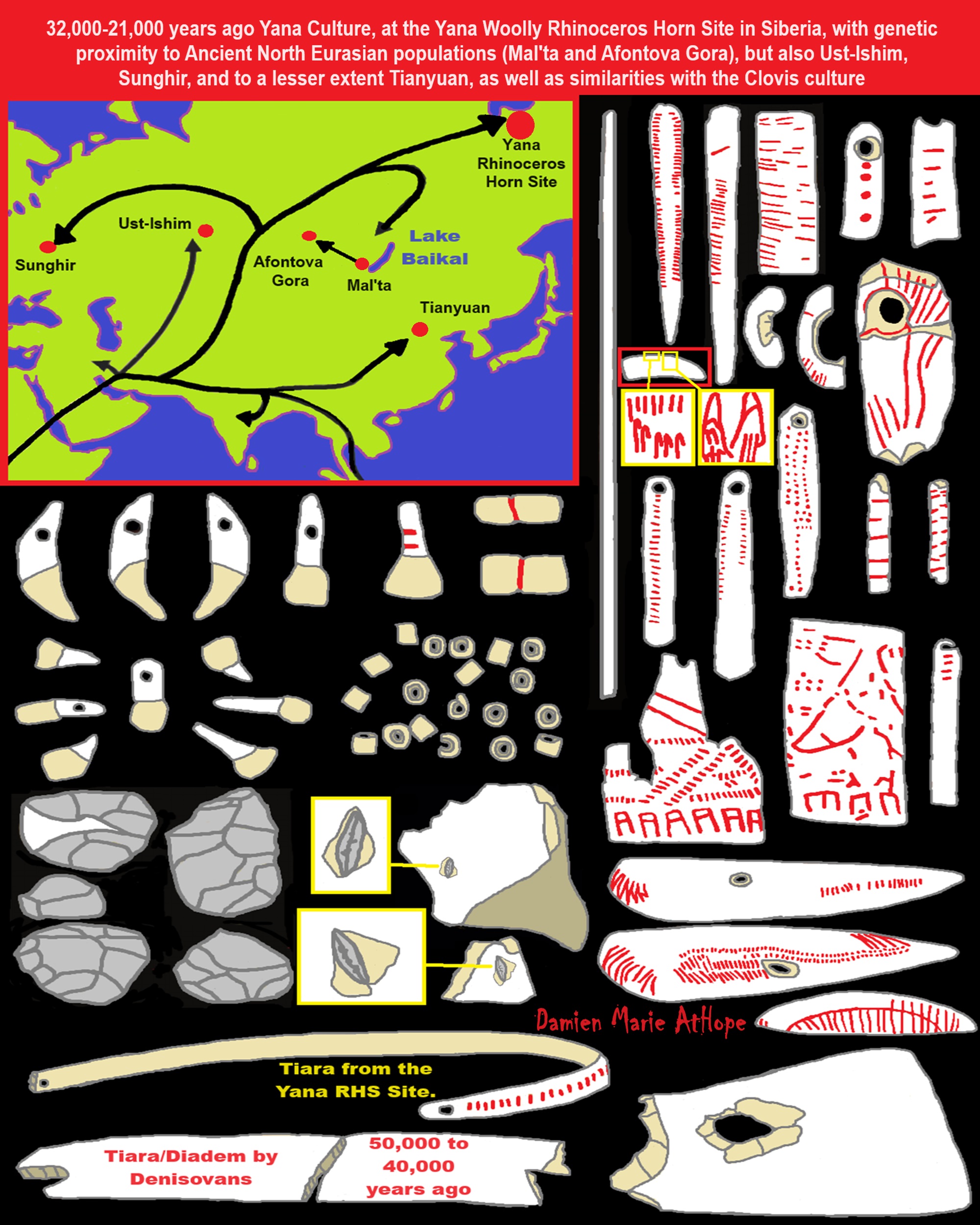
32,000-21,000 years ago, Yana Culture, at the Yana Woolly Rhinoceros Horn Site in Siberia, with genetic proximity to Ancient North Eurasian populations (Mal’ta, Afontova Gora), but also Ust-Ishim, Sunghir, and to a lesser extent Tianyuan, as well as similarities with the Clovis culture


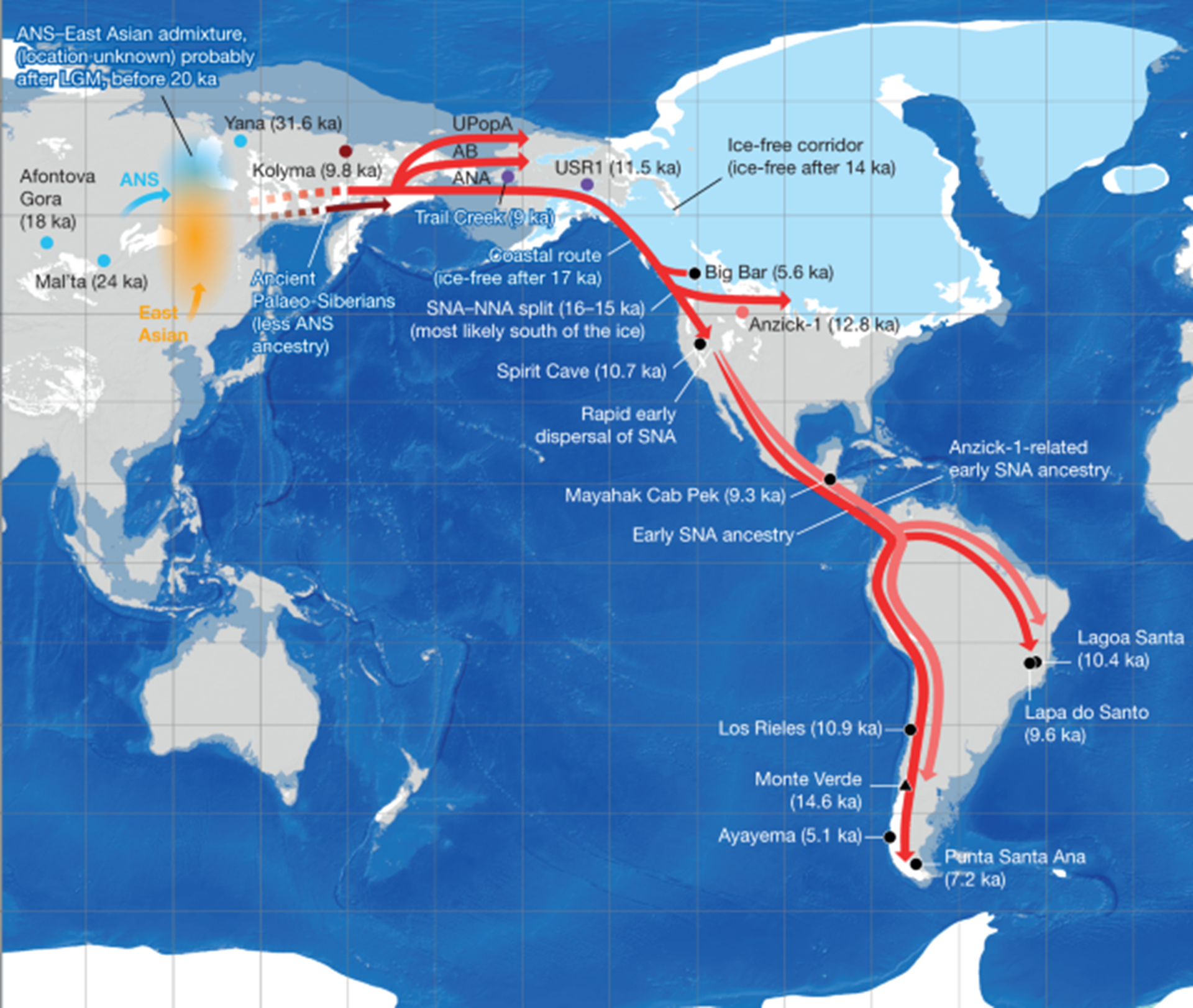

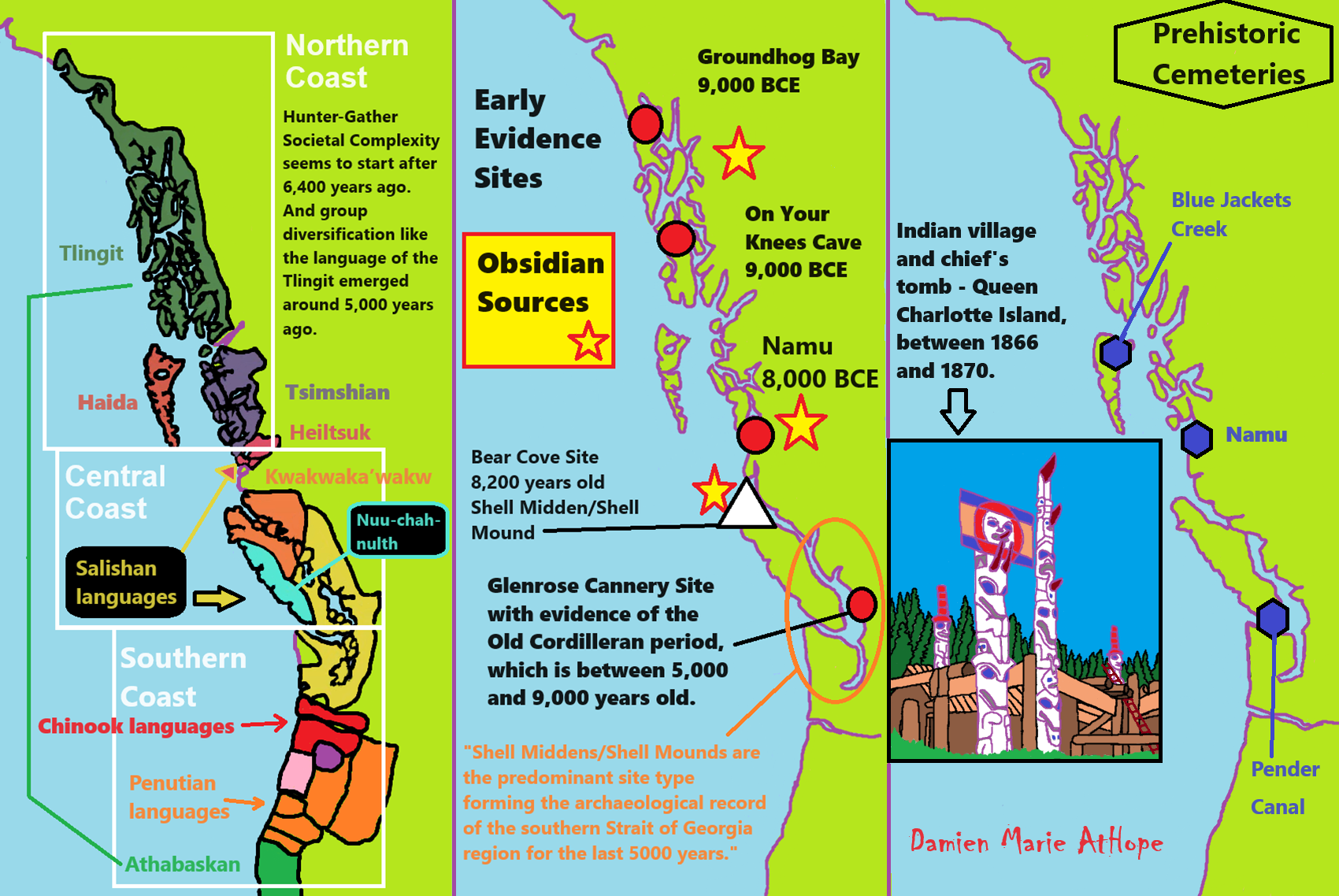

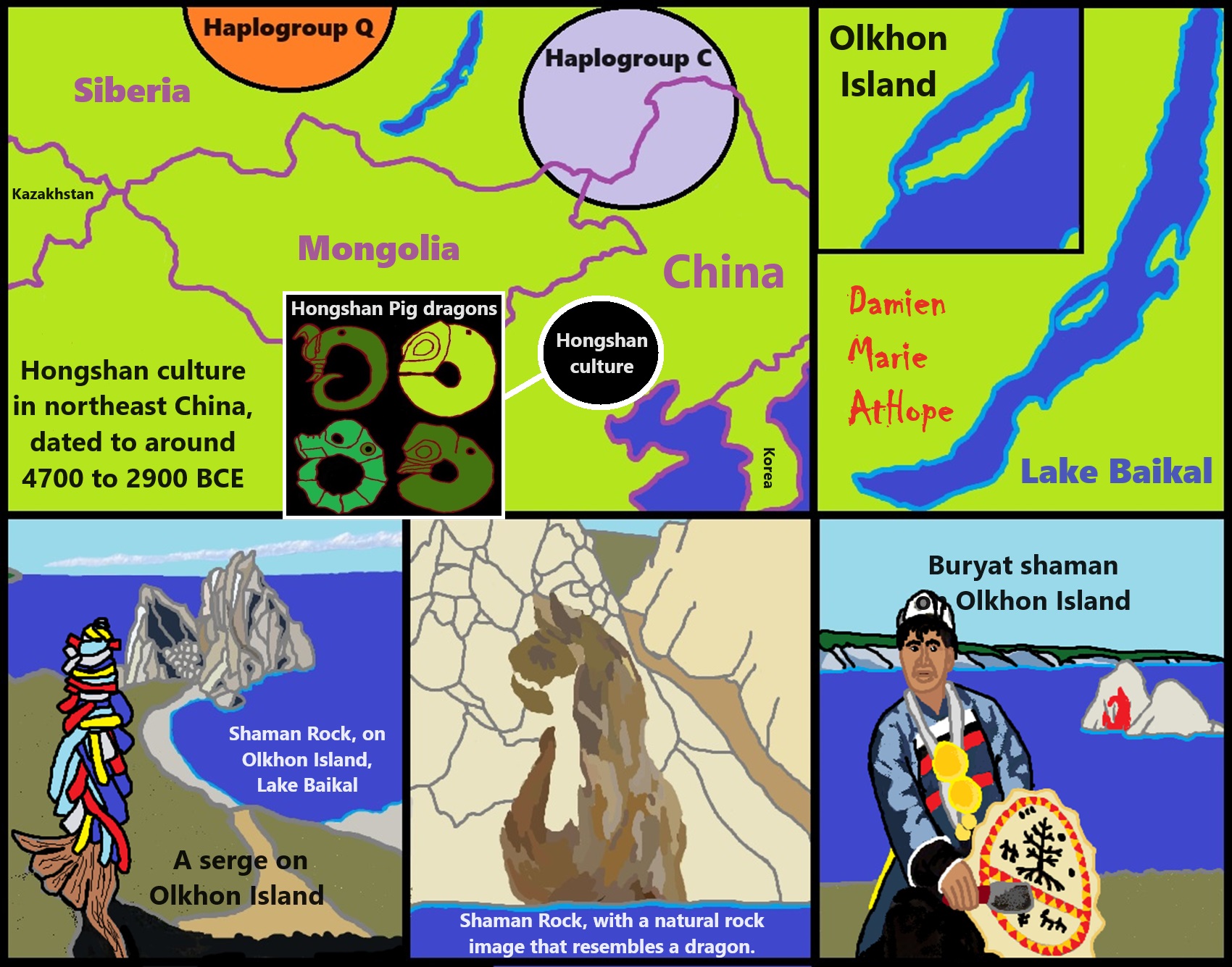
People may have first seen the Shaman Rock with the natural brown rock formation resembling a dragon between 30,000 to 25,000 years ago.
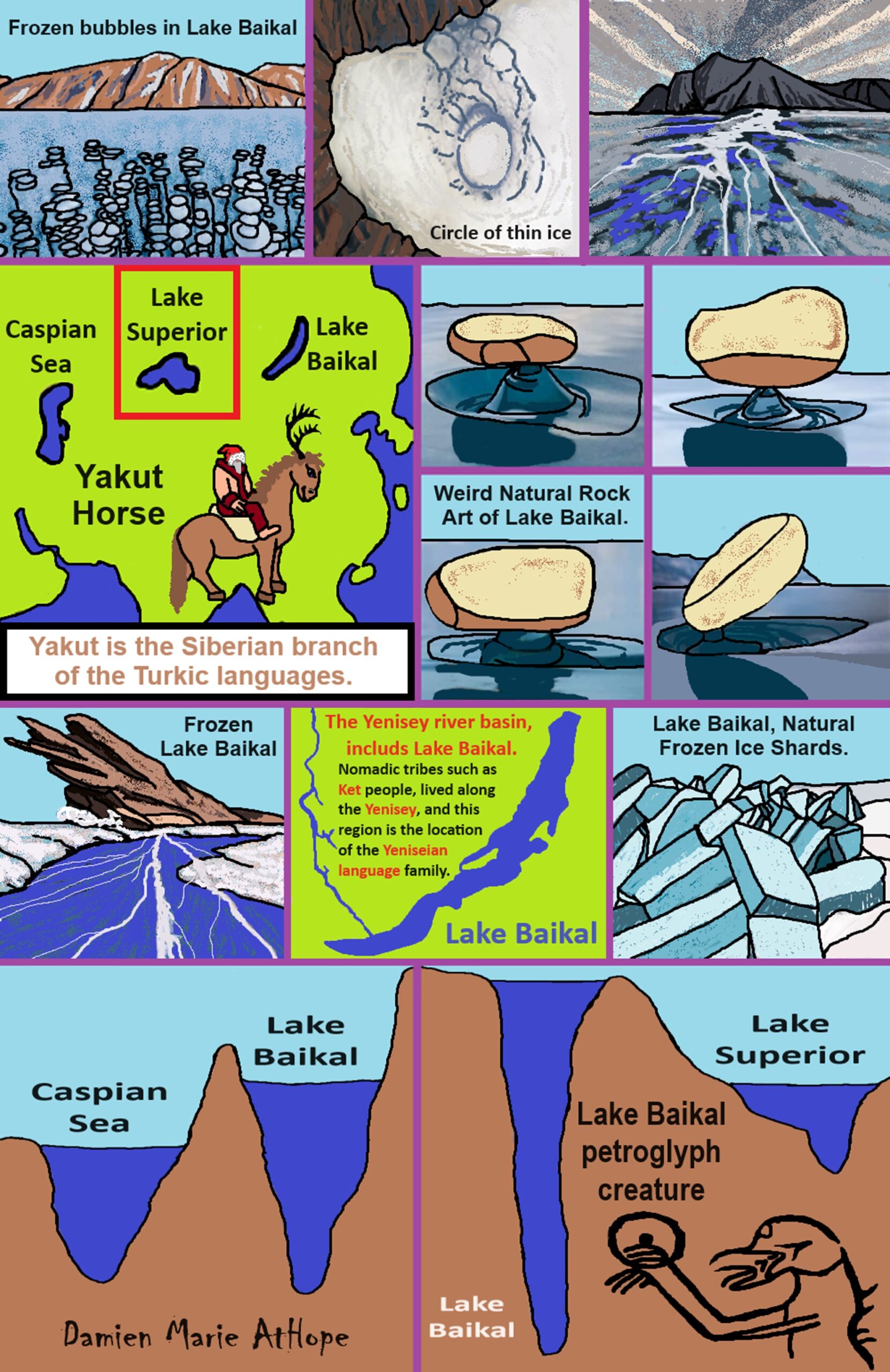
People reached Lake Baikal Siberia around 25,000 years ago. They (to Damien) were likely Animistic Shamanists who were also heavily totemistic as well. Being animistic thinkers they likely viewed amazing things in nature as a part of or related to something supernatural/spiritual (not just natural as explained by science): spirit-filled, a sprit-being relates to or with it, it is a sprit-being, it is a supernatural/spiritual creature, or it is a great spirit/tutelary deity/goddess-god. From there comes mythology and faith in things not seen but are believed to somehow relate or interact with this “real world” we know exists.
Both areas of Lake Baikal, one on the west side with Ancient North Eurasian culture and one on the east side with Ancient Northern East Asian culture (later to become: Ancient Northeast Asian culture) areas are the connected areas that (to Damien) are the origin ancestry religion area for many mythologies and religious ideas of the world by means of a few main migrations and many smaller ones leading to a distribution of religious ideas that even though are vast in distance are commonly related to and centering on Lake Baikal and its surrounding areas like the Amur region and Altai Mountains region.
“Lakes are often mysterious bodies of water, especially if they are very deep or surrounded by mountains. No wonder legends and mysteries thrive about them, including monsters that supposedly lurk in their bottomless depths.” ref

ref, ref, ref, ref, ref, ref, ref, ref, ref, ref, ref
“The earth-diver is a common character in various traditional creation myths. In these stories, a supreme being usually sends an animal (most often a type of bird, but also crustaceans, insects, and fish in some narratives) into the primal waters to find bits of sand or mud with which to build habitable land.” ref
Axis Mundi Mythology– cosmic axis, world axis, world pillar, center of the world, mound/mountain of creation, or “World/Cosmic tree,” or “Eagle and Serpent tree.” ref, ref
“The World Turtle, also called the Cosmic Turtle or the World-bearing Turtle, is a mytheme of a giant turtle (or tortoise) supporting or containing the world. It occurs in Hindu mythology, Chinese mythology, and the mythologies of some of the indigenous peoples of the Americas.” ref
“Chucalissa, Mississippian culture Mounds in Memphis, art shows all the elements involved in the Path of Souls death journey, a widely held belief system among the mound builders of America.” ref
“Interpretation of southeastern Native cosmology, showing the tripartite division of the world. The axis mundi is depicted as a tree or post connecting the fire symbol of this world, the sun symbol of the upper world, and the ‘swastika’ symbol of the lower world.” ref
“It should be remembered that the Mississippian culture that built Cahokia may have considered a cedar tree or a striped cedar pole to be a symbol of the Axis Mundi (also called the cosmic axis, world axis, world pillar, the center of the world, or world tree – has been greatly extended to refer to any mythological concept representing “the connection between Heaven and Earth” or the “higher and lower realms), the pillar connecting the above, middle, & below worlds, & around which the cosmos turns An American Yggdrasil (Norse tree of life). Some work has gone into reconstructing the woodhenge, and it is one of the sites around Cahokia that you can visit today. (The Solar Calendar of Woodhenge in Cahokia | Native America: Cities of the Sky).” – Vulpine Outlaw @Rad_Sherwoodism
“Items adduced as examples of the axis mundi by comparative mythologists include plants (notably a tree but also other types of plants such as a vine or stalk), a mountain, a column of smoke or fire, or a product of human manufacture (such as a staff, a tower, a ladder, a staircase, a maypole, a cross, a steeple, a rope, a totem pole, a pillar, a spire). Its proximity to heaven may carry implications that are chiefly religious (pagoda, temple mount, minaret, church) or secular (obelisk, lighthouse, rocket, skyscraper). The image appears in religious and secular contexts. The axis mundi symbol may be found in cultures utilizing shamanic practices or animist belief systems, in major world religions, and in technologically advanced “urban centers.” ref
Do we know what the symbols represent?
“Yes. It’s a bit more than I’d want to post on TwiX right now. It’s showing the 3-part universe, an upper, lower, and middle world, & the Milky Way is shown as well as Orion the Hand Constellation, Scorpius the ruler of the underworld, and Cygnus, the Judge. Also the main powers of the upper & lower worlds.” – Gregory L Little, Ed.D. @DrGregLittle2
Gregory L Little, Ed.D. BA/MS Psychology, Ed.D. Counseling/Ed. Psych Author since ’84 (70+ books/workbooks). Mound Builder Society: Be Kind; Respect Everything; Honor the Ancient Ones.
EVIDENCE FOR STEPPED PYRAMIDS OF SHELL IN THE WOODLAND PERIOD OF EASTERN NORTH AMERICA
FOLKLORE PARALLELS BETWEEN SIBERIA AND SOUTH ASIA AND THE MYTHOLOGY OF THE EURASIAN STEPPES*
“According to the myth about the origin of man recorded among the people of Eastern Europe and Siberia, the creator set a dog to guard the half-made human figures, but the antagonist bribed the guard and spoiled the creation, making humans vulnerable to disease. The creator told the dog to become the servant of man. Texts recorded in India (mostly among the Munda-speaking groups), the Dards of the Hindu Kush and the Abkhasians, though partly similar to the Northern Eurasian ones, do not share some important details: the antagonist is a horse, it tried to destroy man but a dog drove it away. In the Mongolian (more precisely, the Oirat) version, a cow acts instead of a horse, but in other respects, this variant is similar to the Abkhasian ones. Negative associations related to the horse are rather widespread
in Europe and Central Asia. Stories about the creation of man recorded in northern and southern Eurasia stemmed from the anthropogenic myth that was known to the Indo-Europeans of the Bronze Age. South Asia and the European–Siberian zone also share other tales, in particular the Earth-diver myth. Their analysis opens possibilities for reconstructing the early mythology of the inhabitants of the Eurasian steppe.” ref
Comparative Mythology
“Since the term ‘Ancient North Eurasian’ refers to a genetic bridge of connected mating networks, scholars of comparative mythology have argued that they probably shared myths and beliefs that could be reconstructed via the comparison of stories attested within cultures that were not in contact for millennia and stretched from the Pontic–Caspian steppe to the American continent. The mytheme of the dog guarding the Otherworld possibly stems from an older Ancient North Eurasian belief, as suggested by similar motifs found in Indo-European, Native American and Siberian mythology. In Siouan, Algonquian, Iroquoian, and in Central and South American beliefs, a fierce guard dog was located in the Milky Way, perceived as the path of souls in the afterlife, and getting past it was a test.” ref
“The Siberian Chukchi and Tungus believed in a guardian-of-the-afterlife dog and a spirit dog that would absorb the dead man’s soul and act as a guide in the afterlife. In Indo-European myths, the figure of the dog is embodied by Cerberus, Sarvarā, and Garmr. In Zoroastrianism, two four-eyed dogs guard the bridge to the afterlife called Chinvat Bridge. Anthony and Brown note that it might be one of the oldest mythemes recoverable through comparative mythology.” ref
“A second canid-related series of beliefs, myths and rituals connected dogs with healing rather than death. For instance, Ancient Near Eastern and Turkic–Kipchaq myths are prone to associate dogs with healing and generally categorised dogs as impure. A similar myth-pattern is assumed for the Eneolithic site of Botai in Kazakhstan, dated to 3500 BC, which might represent the dog as absorber of illness and guardian of the household against disease and evil. In Mesopotamia, the goddess Nintinugga, associated with healing, was accompanied or symbolized by dogs. Similar absorbent-puppy healing and sacrifice rituals were practiced in Greece and Italy, among the Hittites, again possibly influenced by Near Eastern traditions.” ref
Earth-diver myth
(creation myth or cosmogonic myth, which is a type of cosmogony,
a symbolic narrative of how the world began and how people first came to inhabit it.)
“The earth-diver is a common character in various traditional creation myths. In these stories, a supreme being usually sends an animal (most often a type of bird, but also crustaceans, insects, and fish in some narratives) into the primal waters to find bits of sand or mud with which to build habitable land. Some scholars interpret these myths psychologically while others interpret them cosmogonically. In both cases, emphasis is placed on beginnings emanating from the depths.” ref
“According to Gudmund Hatt and Tristram P. Coffin, Earth-diver myths are common in Native American folklore, among the following populations: Shoshone, Meskwaki, Blackfoot, Chipewyan, Newettee, Yokuts of California, Mandan, Hidatsa, Cheyenne, Arapaho, Ojibwe, Yuchi, and Cherokee. American anthropologist Gladys Reichard located the distribution of the motif across “all parts of North America”, save for “the extreme north, northeast, and southwest.” ref
“In a 1977 study, anthropologist Victor Barnouw surmised that the earth-diver motif appeared in “hunting-gathering societies“, mainly among northerly groups such as the Hare, Dogrib, Kaska, Beaver, Carrier, Chipewyan, Sarsi, Cree, and Montagnais. Similar tales are also found among the Chukchi and Yukaghir, the Tatars, and many Finno-Ugric traditions, as well as among the Buryat and the Samoyed. In addition, the earth-diver motif also exists in narratives from Eastern Europe, namely Romani, Romanian, Slavic (namely, Bulgarian, Polish, Ukrainian, and Belarusian), and Lithuanian mythological traditions.” ref
“The pattern of distribution of these stories suggest they have a common origin in the eastern Asiatic coastal region, spreading as peoples migrated west into Siberia and east to the North American continent. However, there are examples of this mytheme found well outside of this boreal distribution pattern, for example the West African Yoruba creation myth of Ọbatala and Oduduwa. Characteristic of many Native American myths, earth-diver creation stories begin as beings and potential forms linger asleep or suspended in the primordial realm. The earth-diver is among the first of them to awaken and lay the necessary groundwork by building suitable lands where the coming creation will be able to live. In many cases, these stories will describe a series of failed attempts to make land before the solution is found.” ref
“Among the indigenous peoples of the Americas, the earth-diver cosmogony is attested in Iroquois mythology: a female sky deity falls from the heavens, and certain animals, the beaver, the otter, the duck, and the muskrat dive in the waters to fetch mud to construct an island. In a similar story from the Seneca, people lived in a sky realm. One day, the chief’s daughter was afflicted with a mysterious illness, and the only cure recommended for her (revealed in a dream) was to lie beside a tree and to have it be dug up. The people do so, but a man complains that the tree was their livelihood, and kicks the girl through the hole. She ends up falling from the sky to a world of only water, but is rescued by waterfowl.” ref
“A turtle offers to bear her on its shell, but asked where would be a definitive dwelling place for her. They decide to create land, and the toad dives into the depths of the primal sea to get pieces of soil. The toad puts it on the turtle’s back, which grows larger with every deposit of soil. In another version from the Wyandot, the Wyandot lived in heaven. The daughter of the Big Chief (or Mighty Ruler) was sick, so the medicine man recommends that they dig up the wild apple tree that stands next to the Lodge of the Mighty Ruler, because the remedy is to be found on its roots.” ref
“However, as the tree has been dug out, the ground begins to sink away, and the treetops catch and carry down the sick daughter with it. As the girl falls from the skies, two swans rescue her on their backs. The birds decide to summon all the Swimmers and the Water Tribes. Many volunteer to dive into the Great Water to fetch bits of earth from the bottom of the sea, but only the toad (female, in the story) is the one successful.” ref
GENES AND MYTHS: ANCIENT MAL’TA DNA AND THE EARTH-DIVER MYTHOLOGICAL MOTIF
“Earth-Diver is one of the most widely-distributed and well-studied cosmological myths. Found in mostly Uralic-speaking Eastern Europe, in Siberia, in Munda-speaking Northeast India and North America, its action is set in post-diluvial times when a demiurge sends various creatures to bring a piece of mud from the bottom of the ocean. The first creature fails, but the second one succeeds. Importantly, it’s the least likely creature that succeeds, while the more obvious favorite fails. A loon is a much better diver than a duck but it’s the duck that succeeds. In the end, the demiurge blows the earth out of the tiny piece of mud and restores life on it. Depending on the region, the diving creatures are different – in Eurasia it’s waterfowl birds – loon and duck, in North America it’s amphibians such as turtle or frog, animals such as otter or beaver or waterbirds, in Northeast India and the American Southwest – it’s arthropods.” ref
“The Initial Stages of Evolution of Uralic-Speakers: Evidence from a Mythological Reconstruction (Proto-Uralic Cosmogonic Myth) have suggested that the Earth-Diver motif is the folkloric manifestation of a more comprehensive system of beliefs related to the experiences of a shamanic flight in Northern Eurasian and Amerindian cultures. Siberian shamans liken themselves to waterfowl birds flying between worlds in search of the soul of their patient and they manipulate waterfowl figurines during their shamanic seances. Remarkably, very similar figurines are found at the 24,000-year-old Mal’ta archaeological site in South Siberia (see one on the left made out of a mammoth tusk), and Napol’skikh, in his 1991 book as well as in a recent talk (see video in Russian, roughly from 11:40 on) proposed that the Mal’ta people possessed the “cult of a waterfowl” and told the Earth-Diver myth. This means that the Earth-Diver motif may go back to pre-LGM times.” ref
“Mal’ta has recently made headlines thanks to the sequencing of the genome of a 4-year-old boy found at this site. The DNA sample fell in-between West Eurasians and Amerindians, without any special connection to East Asians, and showed typical West Eurasian mtDNA and Y-DNA haplogroups, namely U and R, respectively. They are sister lineages of widely distributed in the Americas hg B (mtDNA) and hg Q (Y-DNA). It appears that, in pre-LGM times, Amerindians and West Eurasians formed a genetic continuum and that modern East Asians did not yet emerge as a distinct population. This finding may put the distribution of the Earth-Diver myth into a new perspective. Per Davidski’s request, adduce the map of the distribution of the Earth-Diver motif in Eurasia and North America (see the shaded areas on the left).” ref
“One should not expect a perfect fit between the distribution of myths and genes but the Earth-Diver distribution is rather clearly demarcated on a worldwide scale and does show continuity between West Eurasia and North America. The motif is notably absent from Western Europe – precisely the area that was covered with the glacier from 25,000 to 14,000 years ago – and from Beringia (Paleoasiatic peoples such as Chukchees and Koryaks as well as Eskimos don’t tell earth-diver stories), which may have been blocked by ice as well. Its presence in the Balkans is a due to relatively recent events such as Turkic and Avar migrations across the southern European steppe.” ref
“According to Napol’skikh’s motif phylogeny (on the left), the Earth-Diver myth has gone through 3 evolutionary stages – MNP-0, MNP-1 and MNP-2. At MNP-0, any creature (and any number of creatures) could become the demiurge’s helper as long as the least likely creature succeeded. At MNP-1, the plot crystallized around a pair of waterfowls in Siberia and Western North America and a pair of animals in Eastern North America. At MNP-3, one of the creatures dropped off and the demiurge used the help of only one helper. The “cladistics” of the myth is, therefore, rather simple: the dynamic and variable ancestral forms crystallize into progressively fewer characters.” ref
“As the detailed maps of motif and submotif distribution show, North America and Northern Eurasia share MNP-2 but then the rest of the variation is continent-specific. Eurasia has a number of clearly derived variants that are missing from the Americas, while America has a number variants not seen in Eurasia. Napol’skikh observes that stage MNP-0 is better represented in North America – the region that tends to have more archaic versions of the motif and more basal motif diversity (not just waterfowls, but animals, too; not just two creatures but many, etc.). Remarkably, the use of arthropods by the demiurge is a trait shared by Munda-speaking Northeast Indians (see the Berezkin map of Eurasia above) and the Muskogean-speaking Amerindians from the Southeast, both areas being the southernmost extremes of the Earth-Diver distribution. As the Mal’ta boy is re-writing the prehistory of Eurasia, opportunities are growing for cross-disciplinary integration that would tie together genes and culture into a coherent story.” ref
Folklore Parallels Between Siberia And South Asia And The Mythology Of The Eurasian Steppes
“According to the myth about the origin of man recorded among the people of Eastern Europe and Siberia, the creator set a dog to guard the half-made human figures, but the antagonist bribed the guard and spoiled the creation, making humans vulnerable to disease. The creator told the dog to become the servant of man. Texts recorded in India (mostly among the Munda-speaking groups), the Dards of the Hindu Kush and the Abkhasians, though partly similar to the Northern Eurasian ones, do not share some important details: the antagonist is a horse, it tried to destroy man but a dog drove it away. In the Mongolian (more precisely, the Oirat) version, a cow acts instead of a horse, but in other respects this variant is similar to the Abkhasian ones. Negative associations related to the horse are rather widespread in Europe and Central Asia. Stories about the creation of man recorded in northern and southern Eurasia stemmed from the anthropogenic myth that was known to the Indo-Europeans of the Bronze Age. South Asia and the European–Siberian zone also share other tales, in particular the Earth-diver myth. Their analysis opens possibilities for reconstructing the early mythology of the inhabitants of the Eurasian steppe.” ref
Diver-Myths
“Scientific evidence has shown that at one point parts of the earth that are now dry were covered by water. Many myths allude to this fact by imagining a world once covered by water. Many myths, called diver-myths (Long 188), consisted of a being diving into the water that covers the earth to retrieve some earth. The earth brought to the surface became the land we know today. Other stories had the mud brought to the surface in a different way, but many had the common element of some earth being brought to the surface of the water and growing until it became the Earth.” ref
“According to the Iroquois Native Americans water animals inhabited the Earth before there was land. When a Sky Woman fell from her home above they caught her and dove into the seas to bring up mud. This mud they spread onto the back of Big Turtle. There it began to grow until it became North America.” ref
“The Japanese creation myth painted a picture of a muddy ocean which covered the world at the beginning of time. A god and goddess, Izanagi and Izanami, became curious about what was beneath the ocean. Izanagi took his staff and threw it into the ocean. As he lifted it back up some lumps of earth fell off into the water. These became the islands of Japan. No being dove beneath the waters to find mud, but the element of earth being covered by water and a being bringing the earth up is there.” ref
“The creation myth of Christians and Jews does not tell of God diving into the water to bring up mud, but Genesis 1:2 says Òthe Spirit of God was hovering over the waters.Ó Therefore according to the Torah and Bible the Earth was once covered entirely by water.” ref
Power of Myths
“The most obvious function of myths is the explanation of facts, whether natural or cultural. One North American Indian (Abenaki) myth, for example, explains the origin of corn (maize): a lonely man meets a beautiful woman with long, fair hair; she promises to remain with him if he follows her instructions; she tells him in detail how to make a fire and, after he has done so, she orders him to drag her over the burned ground; as a result of these actions, he will see her silken hair (viz., the cornstalk) reappear, and thereafter he will have corn seeds for his use. Henceforth, whenever Abenaki Indians see corn (the woman’s hair), they know that she remembers them.” ref
“Obviously, a myth such as this one functions as an explanation, but the narrative form distinguishes it from a straightforward answer to an intellectual question about causes. The function of explanation and the narrative form go together, since the imaginative power of the myth lends credibility to the explanation and crystallizes it into a memorable and enduring form. Hence myths play an important part in many traditional systems of education. Many myths explain ritual and cultic customs. According to myths from the island of Ceram (in Indonesia), in the beginning life was not complete, or not yet “human”: vegetation and animals did not exist, and there was neither death nor sexuality. In a mysterious manner Hainuwele, a girl with extraordinary gift-bestowing powers, appeared.” ref
“The people killed her at the end of their great annual celebration, and her dismembered body was planted in the earth. Among the species that sprang up after this act of planting were tubers—the staple diet of the people telling the myth. With a certain circularity frequent in mythology, the myth validates the very cultic celebration mentioned in the myth. The cult can be understood as a commemoration of those first events. Hence, the myth can be said to validate life itself together with the cultic celebration. Comparable myths are told in a number of societies where the main means of food production is the cultivation of root crops; the myths reflect the fact that tubers must be cut up and buried in the earth for propagation to take place.” ref
“Ritual sacrifices are typical of traditional peasant cultures. In most cases such customs are related to mythical events. Among important themes are the necessity of death (e.g., the grain “dies” and is buried, only to yield a subsequent harvest), a society’s cyclic renewal of itself (e.g., New Year’s celebrations), and the significance of women and sexuality. New Year’s celebrations, often accompanied by a temporary abandonment of all rules, may be related to or justified by mythical themes concerning a return to chaos and a return of the dead.” ref
“In every mythological tradition one myth or cluster of myths tends to be central. The subject of the central mythology is often cosmogony (origin of the cosmos). In many of those ceremonies that each society has developed as a symbol of what is necessary to its well-being, references are made to the beginning of the world. Examples include the enthronements of kings, which in some traditions (as in Fiji or ancient India) are associated with a creation or re-creation of the world. Analogously, in ancient Mesopotamia the creation epic Enuma elish, which was read each New Year at Babylon, celebrated the progress of the cosmos from initial anarchy to government by the kingship of Marduk; hence the authority of earthly rulers, and of earthly monarchy in general, was implicitly supported and justified.” ref
“Ruling families in ancient civilizations frequently justified their position by invoking myths—for example, that they had divine origins. Examples are known from imperial China, pharaonic Egypt, the Hittite empire, Polynesia, the Inca empire, and India. Elites have also based their claims to privilege on myths. The French historian of ancient religion Georges Dumézil was the pioneer in suggesting that the priestly, warrior, and producing classes in ancient Indo-European societies regarded themselves as having been ordained to particular tasks by virtue of their mythological origins. And in every known cultural tradition there exists some mythological foundation that is referred to when defending marriage and funerary customs.” ref
“Creation myths play a significant role in healing the sick; they are recited (e.g., among the Navajo people of North America) when an individual’s world—that is to say, the person’s life—is in jeopardy. Thus, healing through recitation of a cosmogony is one example of the use of myth as a magical incantation. Another example is the case of Icelandic poets, who, in the singing of the episode in Old Norse mythology in which the god Odin wins for gods and humans the “mead of song” (a drink containing the power of poetic inspiration), can be said to be celebrating the origins of their own art and, hence, renewing it.” ref
“Modern science did not evolve in its entirety as a rebellion against myth, nor at its birth did it suddenly throw off the shackles of myth. In ancient Greece the naturalists of Ionia (western Asia Minor), long regarded as the originators of science, developed views of the universe that were in fact very close to the creation myths of their time. Those who laid the foundations of modern science, such as Nicholas of Cusa, Johannes Kepler, Isaac Newton, and Gottfried Leibniz, were absorbed by metaphysical problems of which the traditional, indeed mythological, character is evident. Among these problems were the nature of infinity and the question of the omnipotence of God. The influence of mythological views is seen in the English physician William Harvey’s association of the circulation of the blood with the planetary movements and Charles Darwin’s explanation of woman’s menstrual cycles by the tides of the ocean.” ref
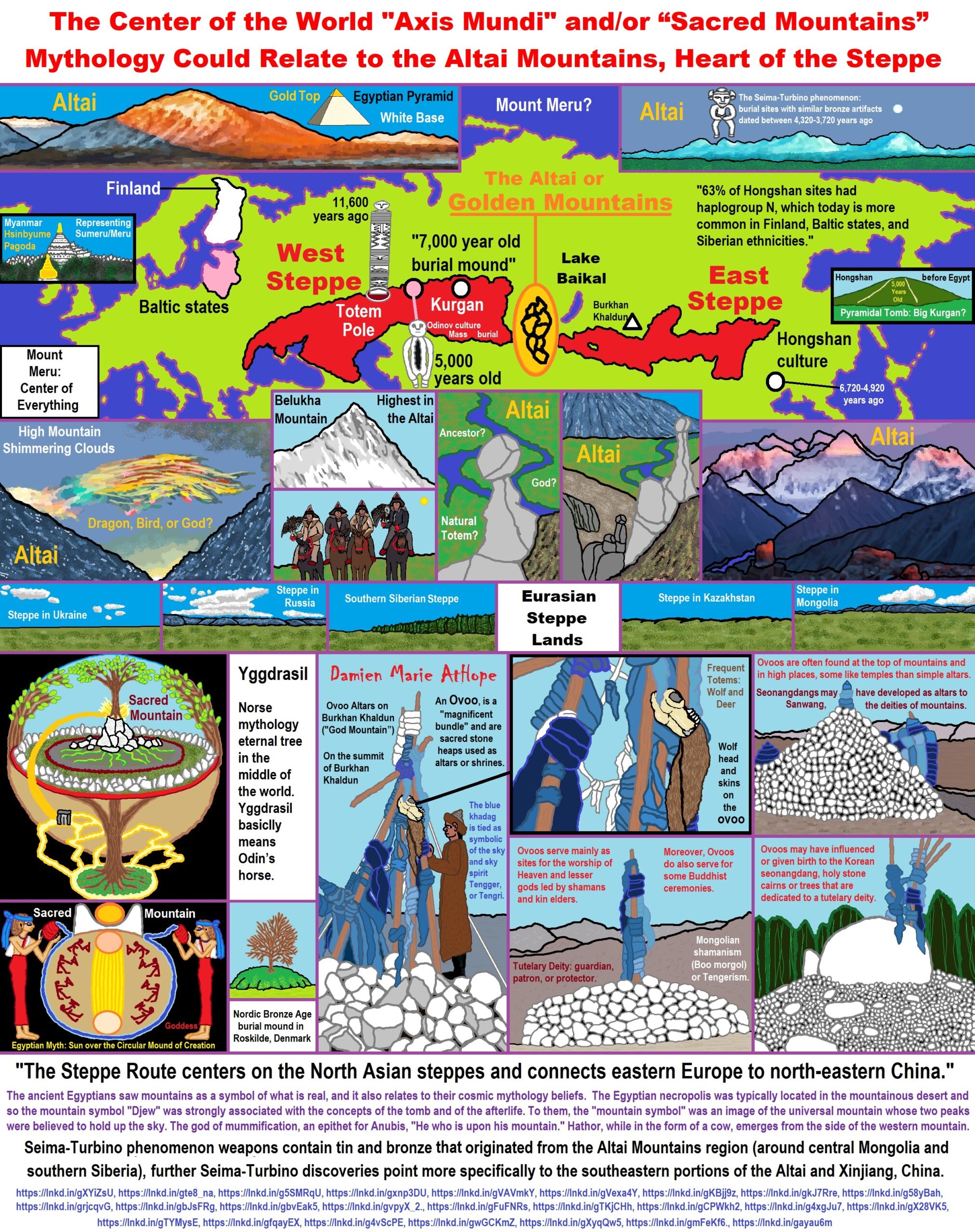

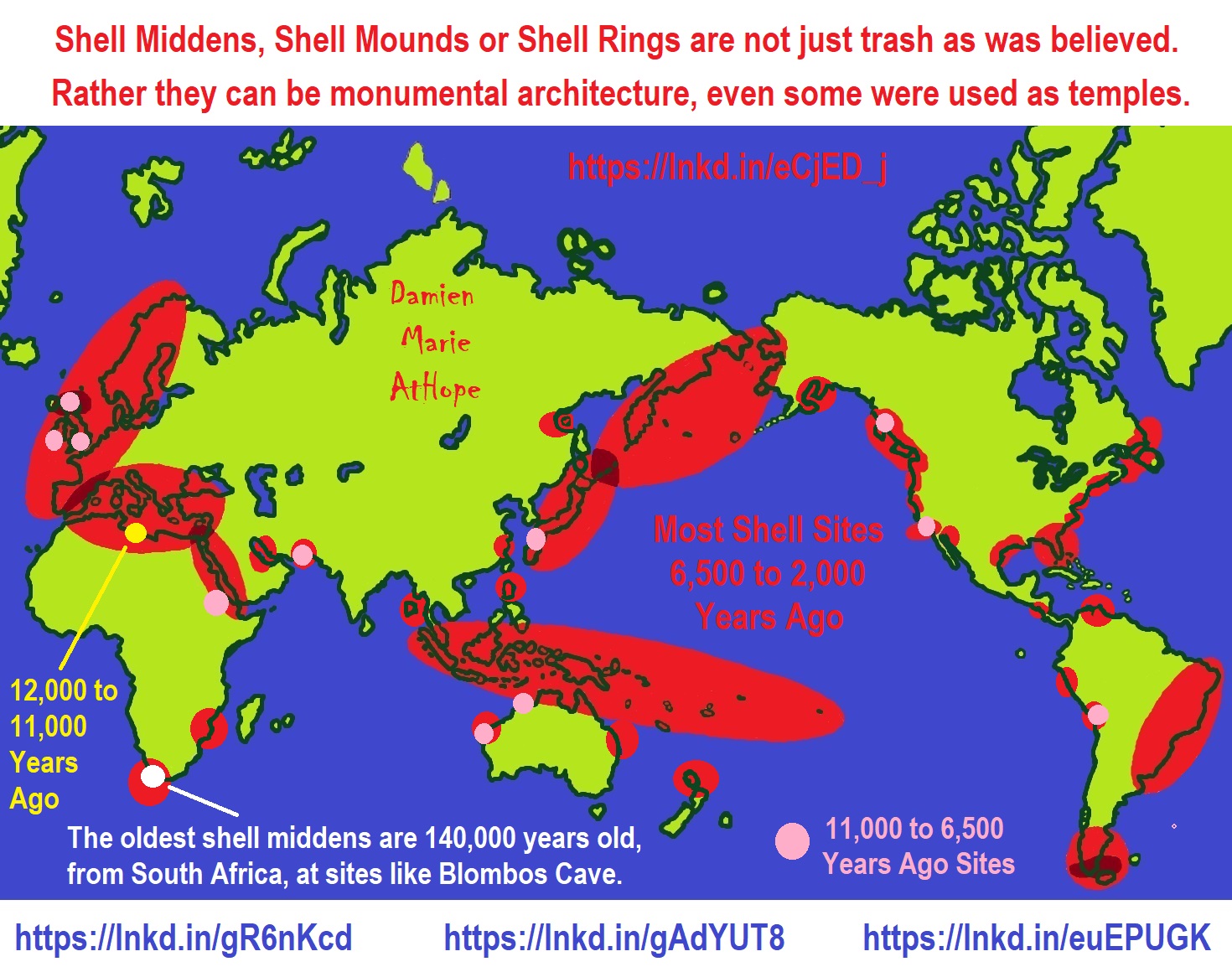
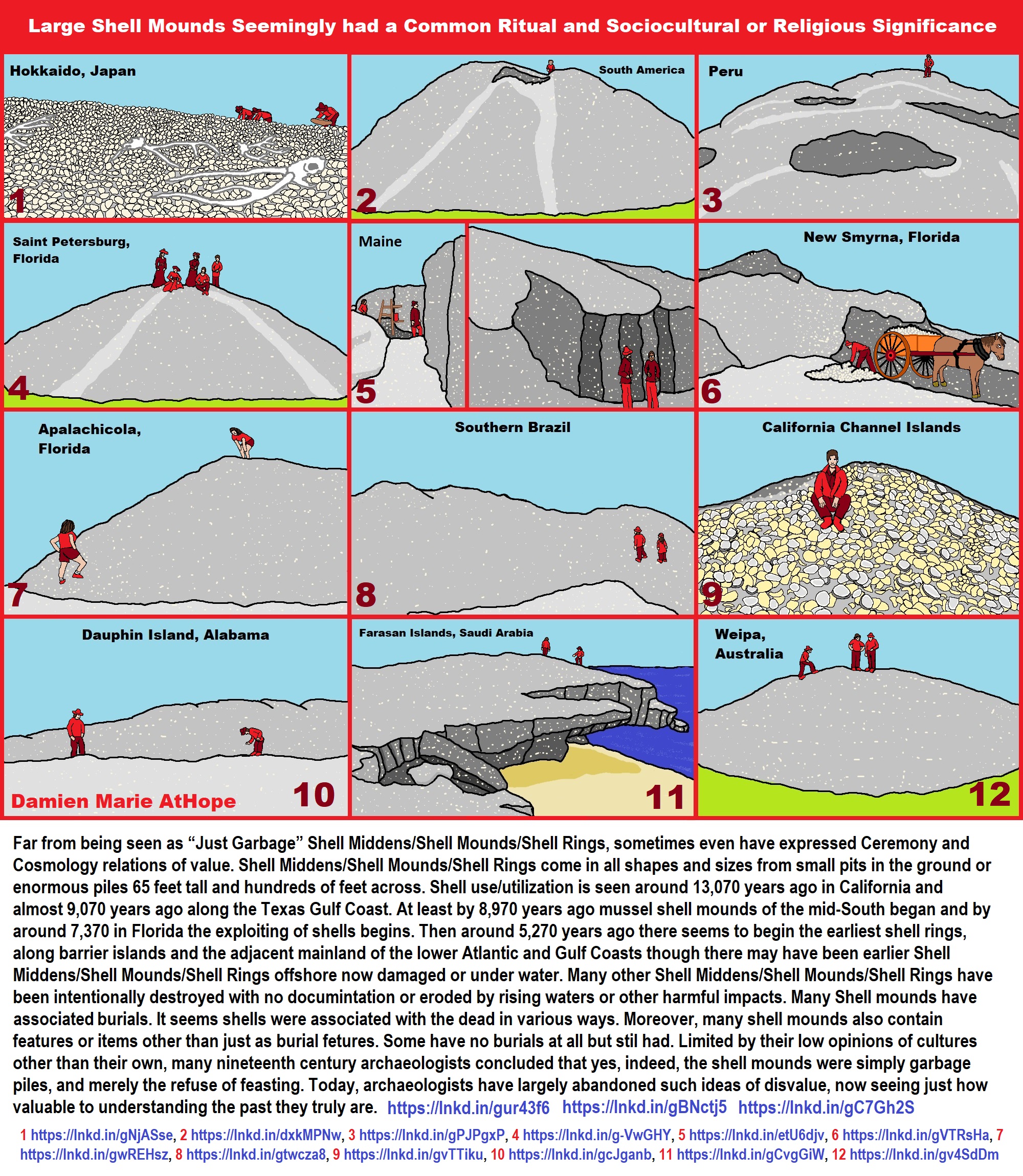

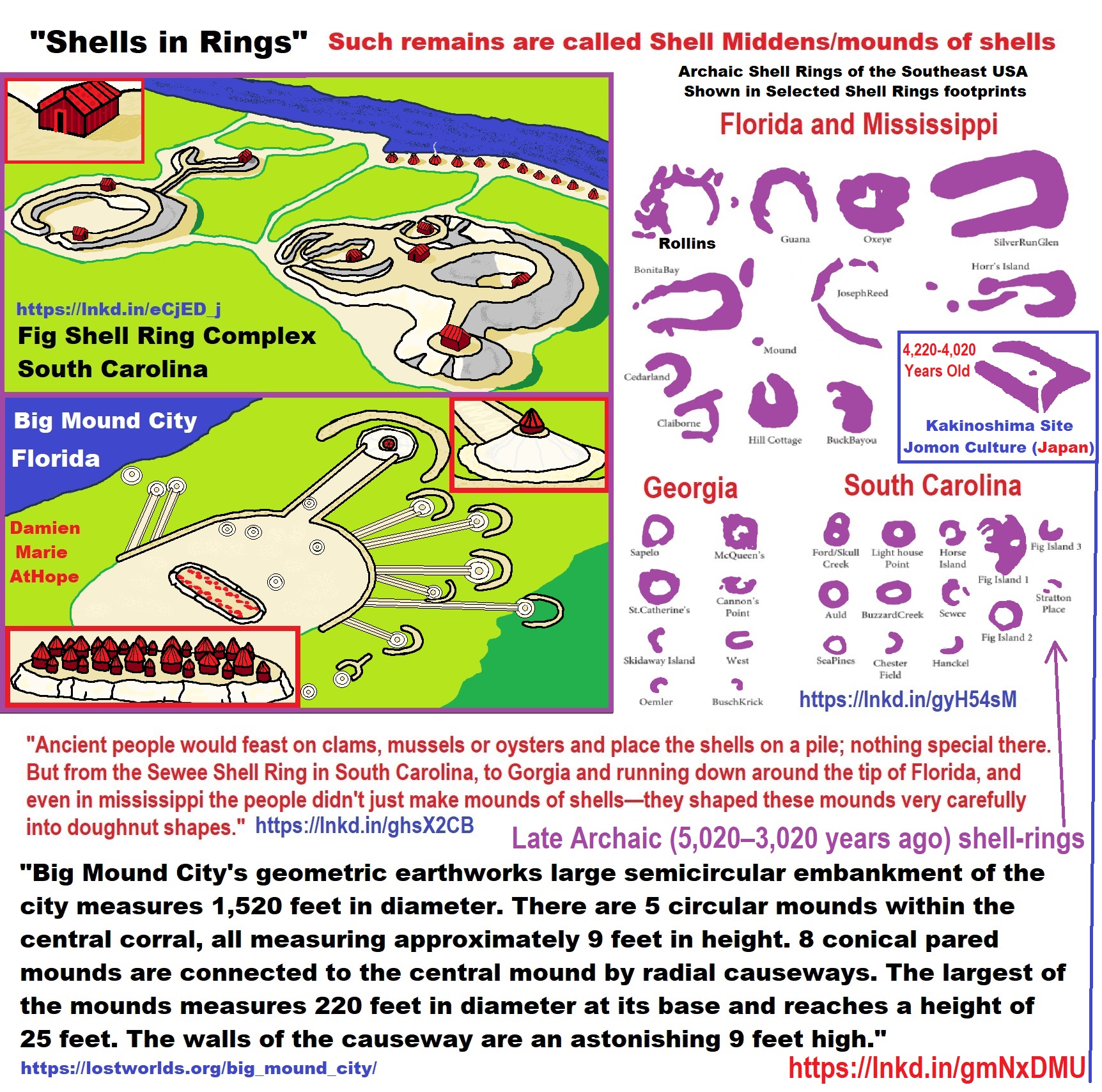



- Medicine Wheel
- Serpent Mound
- Mesa Verde
- Chaco Canyon
- Casas Grandes/Paquime
- Ciudad Perdida “lost city”; Teyuna
- Ingapirca “Inca”
- Chavín de Huántar “pre-Inca”
- Sacred City of Caral-Supe *Caral culture developed between 3000 – 1800 BCE*
- Machu Picchu
- Nazca Lines
- Sacsayhuamán
- Tiwanaku/Tiahuanaco
- Atacama Giant/Lines
- Pucará de Tilcara “pre-Inca”
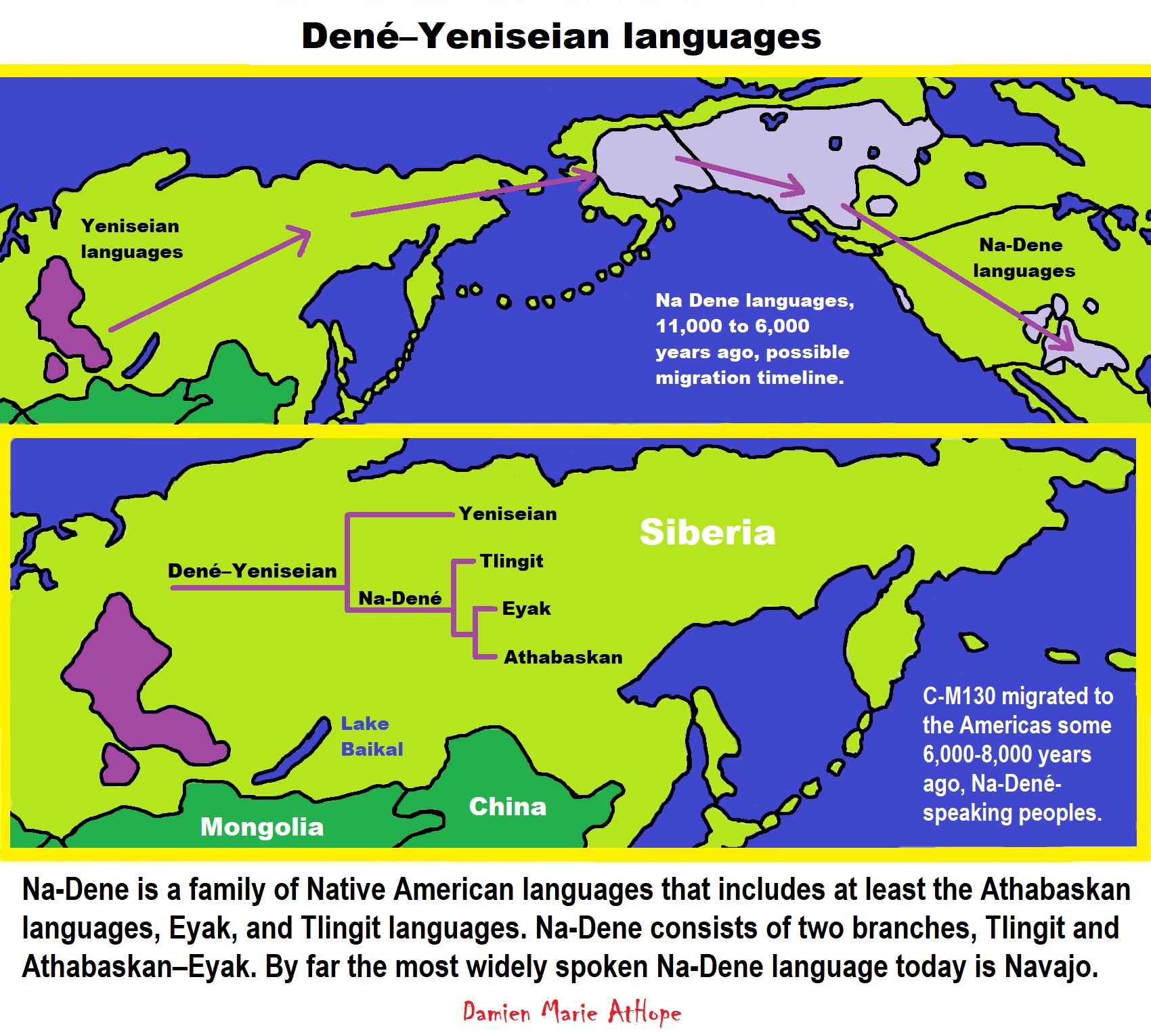
My art and when as well as who may have brought in the new elitism and compulsory authority to the Americas.
“For the Tlingit (branch of the Na-Dené language family), hereditary slavery was practiced extensively until it was outlawed by the United States. Wealth and economic power are important indicators of rank. Scientists suggest that the main ancestor of the Ainu and of the Tlingit can be traced back to Paleolithic groups in Southern Siberia.” ref
Gene flow across linguistic boundaries in Native North American populations
“Geneticists and anthropologists often expect that human language groups and gene pools will share a common structure. It is noted that both language and genes are passed from parents to children, mating tends to be endogamous with respect to linguistic groups, and splits in linguistic communities usually occur with splits in breeding populations. Cavalli-Sforza et al. have reported that genetic trees of major geographic populations correlate well with language families. They argue that a process consisting of population fissions, expansion into new territories, and isolation between ancestral and descendant groups will produced a tree-like structure common to both genes and languages. Linguists agree that population fissions and range expansions play an important role in the generation of linguistic diversity.” ref
“The potential correspondence between gene pools and language groups in Native North American populations is particularly interesting for several reasons. Early investigations of the correspondence between genetic groups and linguistic groups in Native North Americans produced equivocal results. On the one hand, average genetic distances between populations in different language families were greater than average genetic distances between populations within language families. On the other hand, genetic distances were not significantly correlated with glottochronological distances. In the three language families, the average nucleotide diversity within populations is low in Eskimo-Aleut populations and high in Amerind populations. However, nucleotide diversity varies considerably among the populations classified as Na-Dene-speaking. The Alaskan Athabascan and Haida populations, who reside in the North, have low nucleotide diversities, in the range of nucleotide diversities in the Eskimo-Aleut-speaking populations. The Navajo and Apache, who reside in the Southwest, have high nucleotide diversities, in the range of nucleotide diversities in populations classified as Amerind speaking.” ref
“Several patterns that depart from the tree structure are apparent upon close examination. For example, the GLC expected distances consistently overestimate the realized genetic distances for several populations, including the Navajo, Aleut, and Siberian Yupik populations. This relationship means that these populations are genetically similar to populations with distantly related languages. Similarly, the GLC tree consistently underestimates the genetic distance between three Eskimo populations (Central Yupik, Canadian Inuit, and Inupaiq) and all other populations. First, none of Greenberg’s major language groups (Eskimo-Aleut, Na-Dene, or Amerind) forms a unique cluster. The most exclusive cluster that contains all Eskimo-Aleut populations (defined by branch a) also includes all four Na-Dene-speaking populations and the Amerind-speaking Cheyenne, Bella Coola, and Nuu Chah Nulth populations.” ref
“The most exclusive cluster with all Na-Dene-speaking populations (defined by branch b) also includes six Eskimo-Aleut-speaking populations (Siberian Yupik, Greenland Inuit, Central Yupik, Canadian Inuit, and Inupiaq) and the Amerind-speaking Bella Coola. The most exclusive cluster with all Amerind-speaking populations (defined by branch c) includes the Eskimo-Aleut-speaking Aleuts and the Na-Dene-speaking Navajo. Second, there is a strong North-South geographic pattern to the clustering pattern. An Arctic-Pacific Northwest cluster that includes all Aleut-Eskimo populations, all Na-Dene populations, and the Amerind Nuu Chah Nulth and Bella Coola populations originates on one side of branch a, whereas a more Southern group includes the Pima, Cherokee, Sioux, and Chippewa Amerind-speaking population forms to the other side of branch a. The Southwestern Athabascan-speaking populations, Navajo and Apache, defy the geographic groupings, but this result is consistent with the archaeological record.” ref
“Anthropologists agree that circa anno Domini 1400 the ancestors of Navajos and Apaches migrated from the Mackenzie Basin of Canada to the Southwest region, where they came into contact with Amerind-speaking populations who had been living there for thousands of years. The occurrence of haplogroup A differs markedly between the far Northern and the Southwestern samples. With only few exceptions, mtDNA lineages observed in the northern Na-Dene classified populations (Haida and Alaskan Athabascans) belong to haplogroup A. Haplogroup A is also common in Eskimos and Aleuts. Outside of the far North, the only samples in which haplogroup A appears commonly are the Southwestern Athabascan-speaking populations (Navajo and Apache). mtDNA sequences belonging to haplogroups B and C are frequent primarily in the Amerind-classified populations, including the Bella Coola, and Nuu Chah Nulth populations on the Northwest Coast. The Navajo and Apache are the only Na-Dene-classified populations with substantial frequencies of B- and C-group haplotypes, although haplogroup C is observed in the Haida and Alaskan Athabascan samples.” ref
I think god beliefs (great spirit/shy father god) came into the Americas from North Asia from 7,000 to 5,000 years ago. I think it likely relates to the Na-Dene languages migrations as all of the Na-Dene languages have “great spirit” beliefs and some have shy father god/creator beliefs as well.
I think Na-Dene speakers brought into the Americas a kind/several kinds of Shamanism-Paganism with Totemism and Animism. Especially a daytime blue sky-god/sun-god but also an earth/moon goddess and bird mythology beliefs. Similar to the Hemudu culture (5500 – 3300 BCE or around 7,500 to 5,300 years ago) from China.
“Hemudu’s inhabitants worshiped a sun spirit as well as a fertility spirit. They also enacted shamanistic rituals to the sun and believed in bird totems. A belief in an afterlife and ghosts is thought to have been widespread as well. People were buried with their heads facing east or northeast and most had no burial objects. Infants were buried in urn-casket style burials, while children and adults received earth level burials. They did not have a definite communal burial ground, for the most part, but a clan communal burial ground has been found from the later period. Two groups in separate parts of this burial ground are thought to be two intermarrying clans. There were noticeably more burial goods in this communal burial ground.” ref
“The Great Spirit is the concept of a life force, a supreme being or god, present in many, but not all, indigenous cultures in Canada and the United States. Interpretations of the Great Spirit also vary between cultures. It is known as Wakan Tanka in Lakota, Gitche Manitou in Algonquian, and by other, specific names in a number of First Nations and Native American cultures. According to Lakota activist Russell Means, a more semantically accurate translation of Wakan Tanka is the Great Mystery.” ref
“The Great Spirit has at times been conceptualized as an “anthropomorphic celestial deity,” a god of creation, history, and eternity, who also takes a personal interest in world affairs and might regularly intervene in the lives of human beings. Numerous individuals are held to have been “speakers” for the Great Spirit; persons believed to serve as an earthly mediator responsible for facilitating communication between humans and the supernatural more generally. Such a speaker is generally considered to have an obligation to preserve the spiritual traditions of their respective lineage. The Great Spirit is looked to by spiritual leaders for guidance by individuals as well as communities at large.” ref
“While belief in an entity or entities known as the Great Spirit exists across numerous indigenous American peoples, individual tribes often demonstrate varying degrees of cultural divergence. As such, a variety of stories, parables, fables, and messages exhibiting different, sometimes contradictory themes and plot elements have been attributed to the same figure by otherwise disparate cultures. Wakan Tanka (Wakȟáŋ Tȟáŋka) can be interpreted as the power or the sacredness that resides in everything, resembling some animistic and pantheistic beliefs. This term describes every creature and object as wakan (“holy”) or having aspects that are wakan; tanka corresponds to “great” or “large.” ref
“The Lakota used Wakan Tanka to refer to an organization or group of sacred entities whose ways were considered mysterious and beyond human understanding. It was the elaboration on these beliefs that prompted scholarly debate suggesting that the term “Great Mystery” could be a more accurate translation of such a concept than “Great Spirit”. Activist Russell Means also promoted the translation “Great Mystery” and the view that Lakota spirituality is not originally monotheistic.” ref
“Chief Luther Standing Bear (1868–1939) of the Lakota Nation put it thus:
- From Wakan Tanka, the Great Spirit, there came a great unifying life force that flowed in and through all things – the flowers of the plains, blowing winds, rocks, trees, birds, animals – and was the same force that had been breathed into the first man. Thus all things were kindred, and were brought together by the same Great Mystery.” ref
“Manitou, akin to the Haudenosaunee concept of orenda, is perceived as the spiritual and fundamental life force by Algonquian peoples. It is believed by practitioners to be omnipresent; manifesting in all things, including organisms, the environment, and events both human-induced and otherwise. Manifestations of Manitou are also believed to be dualistic, and such contrasting instances are known as aashaa monetoo (“good spirit”) and otshee monetoo (“bad spirit”) respectively. According to legend, when the world was created, the Great Spirit, Aasha Monetoo, gave the land to the indigenous peoples, the Shawnee in particular.” ref
“The Anishinaabe culture, descended from the Algonquian-speaking Abenaki and Cree, inherited the Great Spirit tradition of their predecessors. Gitche Manitou (also transliterated as Gichi-manidoo) is an Anishinaabe language word typically interpreted as Great Spirit, the Creator of all things and the Giver of Life, and is sometimes translated as the “Great Mystery”. Historically, Anishinaabe people believed in a variety of spirits, whose images were placed near doorways for protection. According to Anishinaabe tradition, Michilimackinac, later named by European settlers as Mackinac Island, in Michigan, was the home of Gitche Manitou, and some Anishinaabeg tribes would make pilgrimages there for rituals devoted to the spirit.” ref
“Other Anishinaabe names for such a figure, incorporated through the process of syncretism, are Gizhe-manidoo (“venerable Manidoo“), Wenizhishid-manidoo (“Fair Manidoo“) and Gichi-ojichaag (“Great Spirit”). While Gichi-manidoo and Gichi-ojichaag both mean “Great Spirit”, Gichi-manidoo carried the idea of the greater spiritual connectivity while Gichi-ojichaag carried the idea of individual soul’s connection to the Gichi-manidoo. Consequently, Christian missionaries often used the term Gichi-ojichaag to refer to the Christian idea of a Holy Spirit. The contemporary belief in the great spirit is generally associated with the Native American Church. The doctrine regarding the great spirit within this modern tradition is quite varied and generally takes on Christian ideas of a monotheistic God alongside animistic conceptions. The number of adherents to these contemporary beliefs in the great spirit are unknown, but it is likely they number over a quarter million people.” ref
“Early European explorers describe individual Native American tribes and even small bands as each having their own religious practices. Theology may be monotheistic, polytheistic, henotheistic, animistic, shamanistic, pantheistic or any combination thereof, among others. Traditional beliefs are usually passed down in the forms of oral histories, stories, allegories, and principles.” ref
“The sun dance is a religious ceremony practiced by a number of Native American and First Nations peoples, primarily those of the Plains Nations. Each tribe that has some type of sun dance ceremony that has their own distinct practices and ceremonial protocols. In many cases, the ceremony is held in private and is not open to the public. Most details of the ceremony are kept from public knowledge out of great respect for, and the desire for protection of, the traditional ways. Many of the ceremonies have features in common, such as specific dances and songs passed down through many generations, the use of traditional drums, the sacred pipe, praying, fasting and, in some cases, the piercing of the skin. In Canada, the Plains Cree call this ceremony the Thirst Dance; the Saulteaux (Plains Ojibwe) call it the Rain Dance; and the Blackfoot (Siksika, Kainai, and Piikani) call it the Medicine Dance. It is also practiced by the Canadian Dakota and Nakoda, and the Dene.” ref

ref, ref, ref, ref, ref, ref, ref, ref, ref, ref, ref, ref, ref, ref, ref, ref, ref, ref, ref, ref, ref, ref, ref, ref, ref, ref, ref, ref, ref, ref, ref, ref, ref, ref, ref, ref, ref, ref, ref, ref, ref, ref, ref, ref, ref, ref, ref, ref, ref, ref, ref, ref, ref, ref, ref, ref, ref, ref, ref, ref, ref, ref, ref, ref, ref, ref, ref, ref, ref, ref, ref, ref, ref, ref, ref, ref, ref, ref, ref, ref, ref, ref, ref, ref, ref, ref, ref, ref, ref, ref


Crystal River Mounds site photo by Damien Marie AtHope
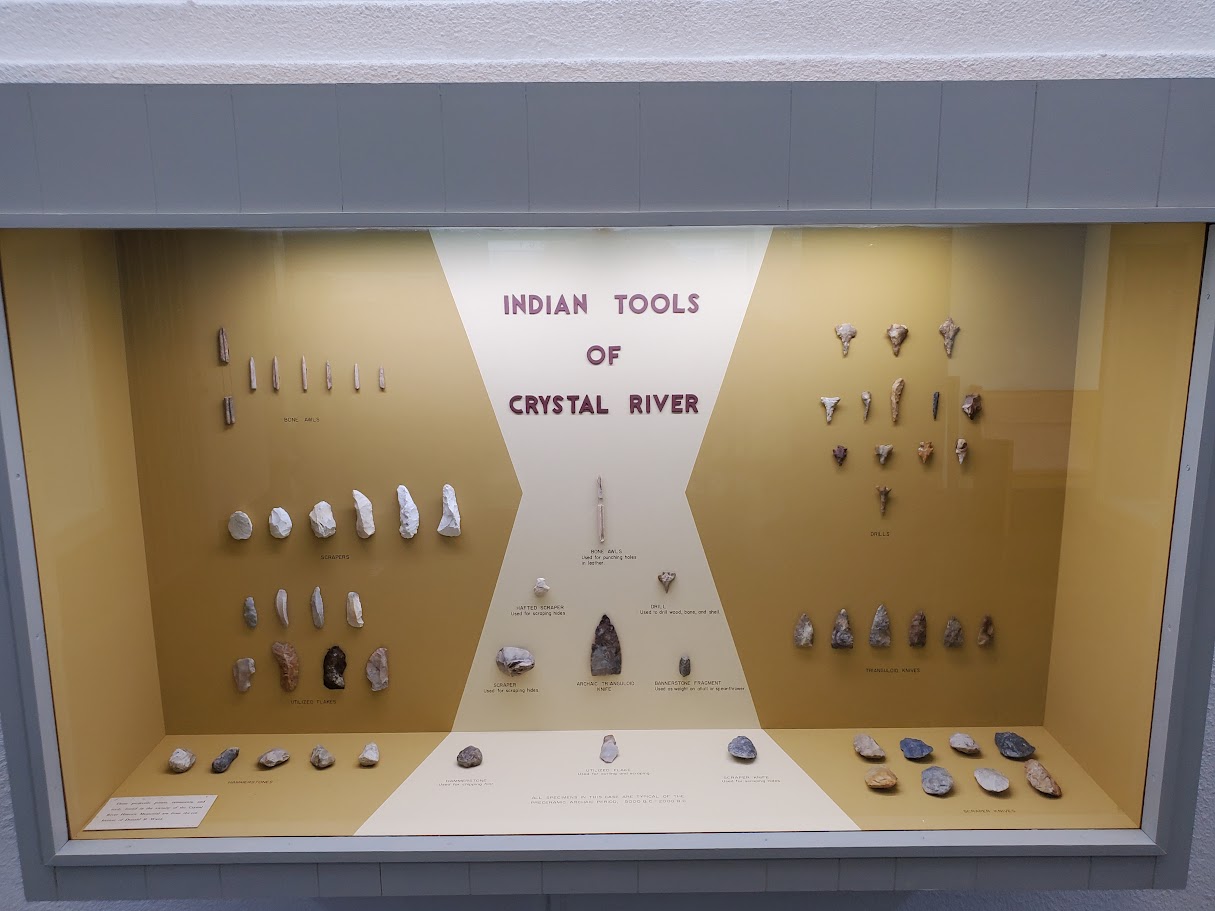
Crystal River Mounds site photo by Damien Marie AtHope

Crystal River Mounds site photo by Damien Marie AtHope

Crystal River Mounds site photo by Damien Marie AtHope
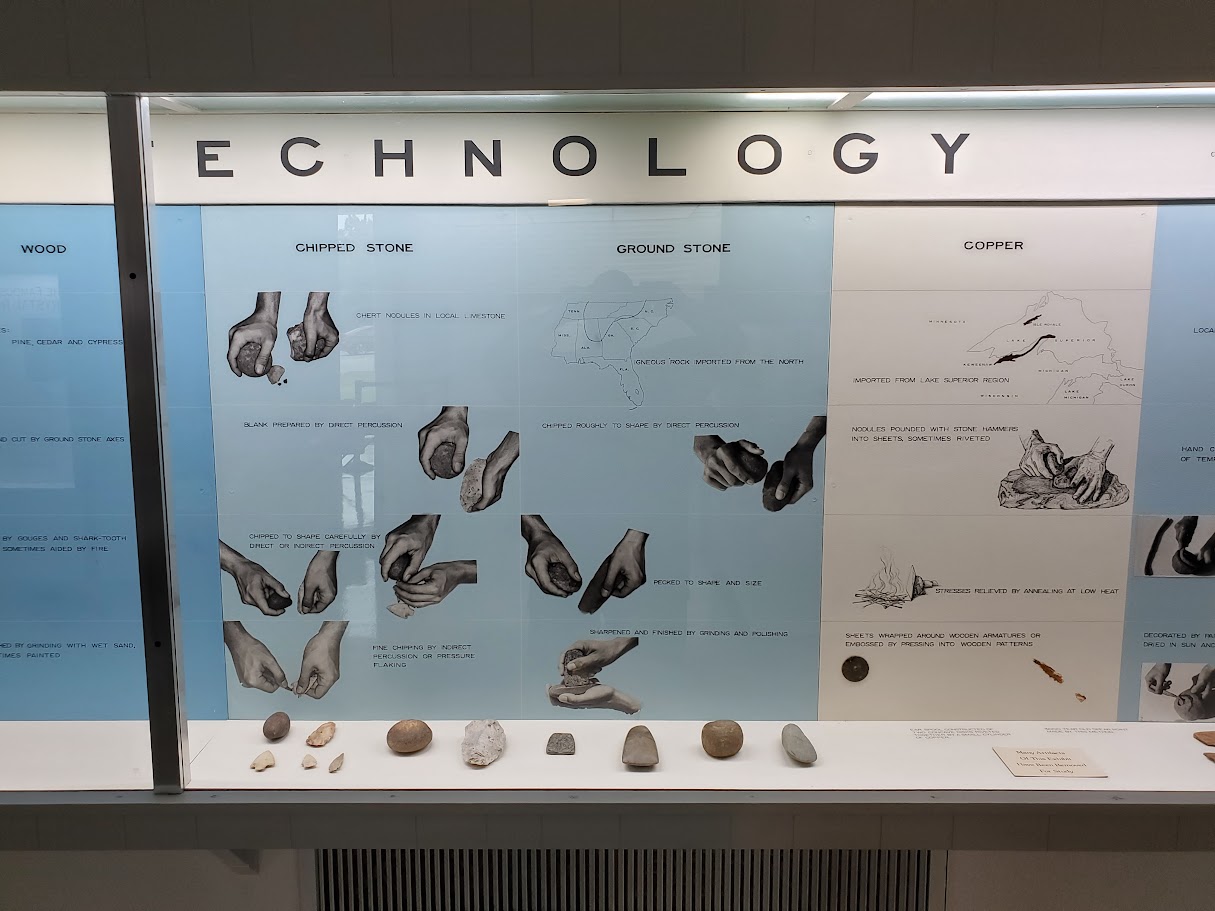
Crystal River Mounds site photo by Damien Marie AtHope

Crystal River Mounds site photo by Damien Marie AtHope

Crystal River Mounds site photo by Damien Marie AtHope
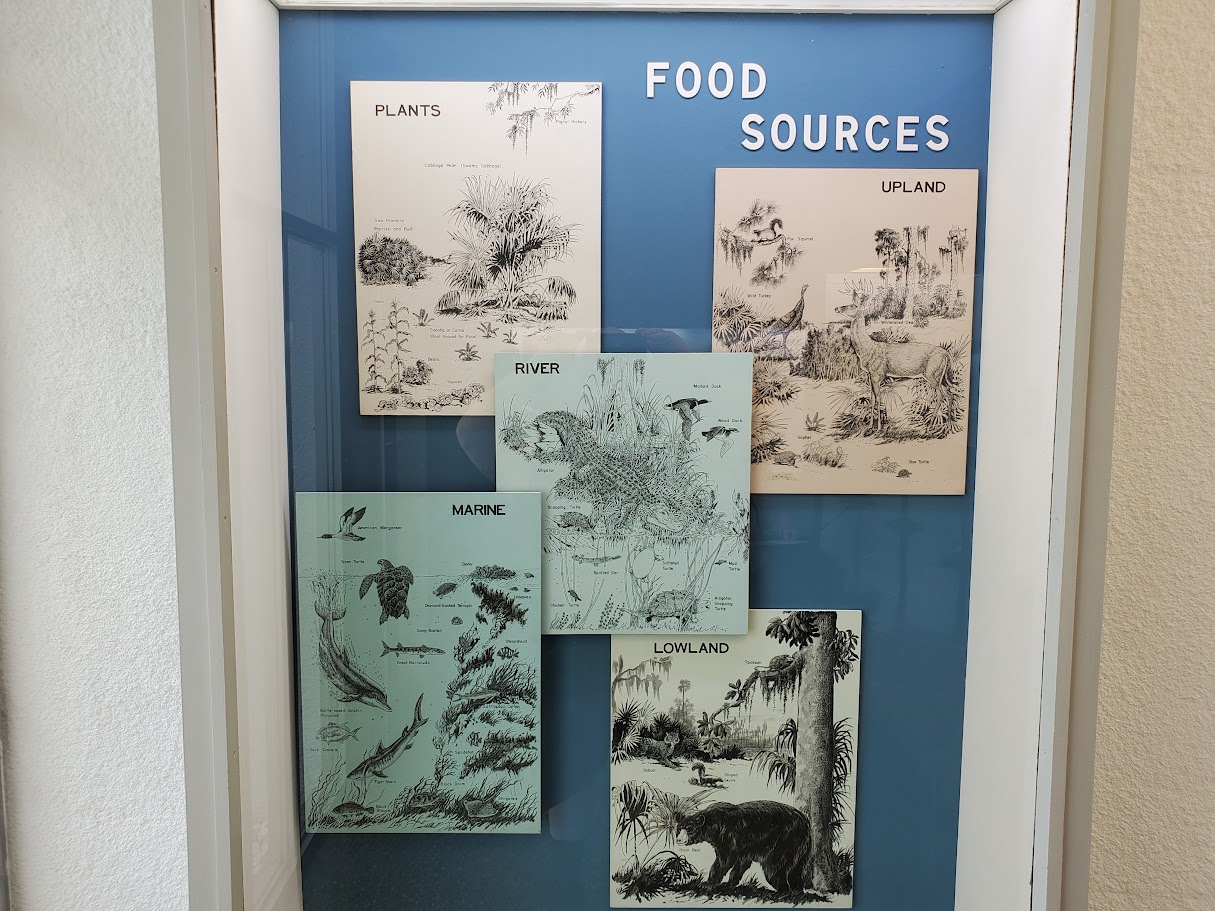
Crystal River Mounds site photo by Damien Marie AtHope
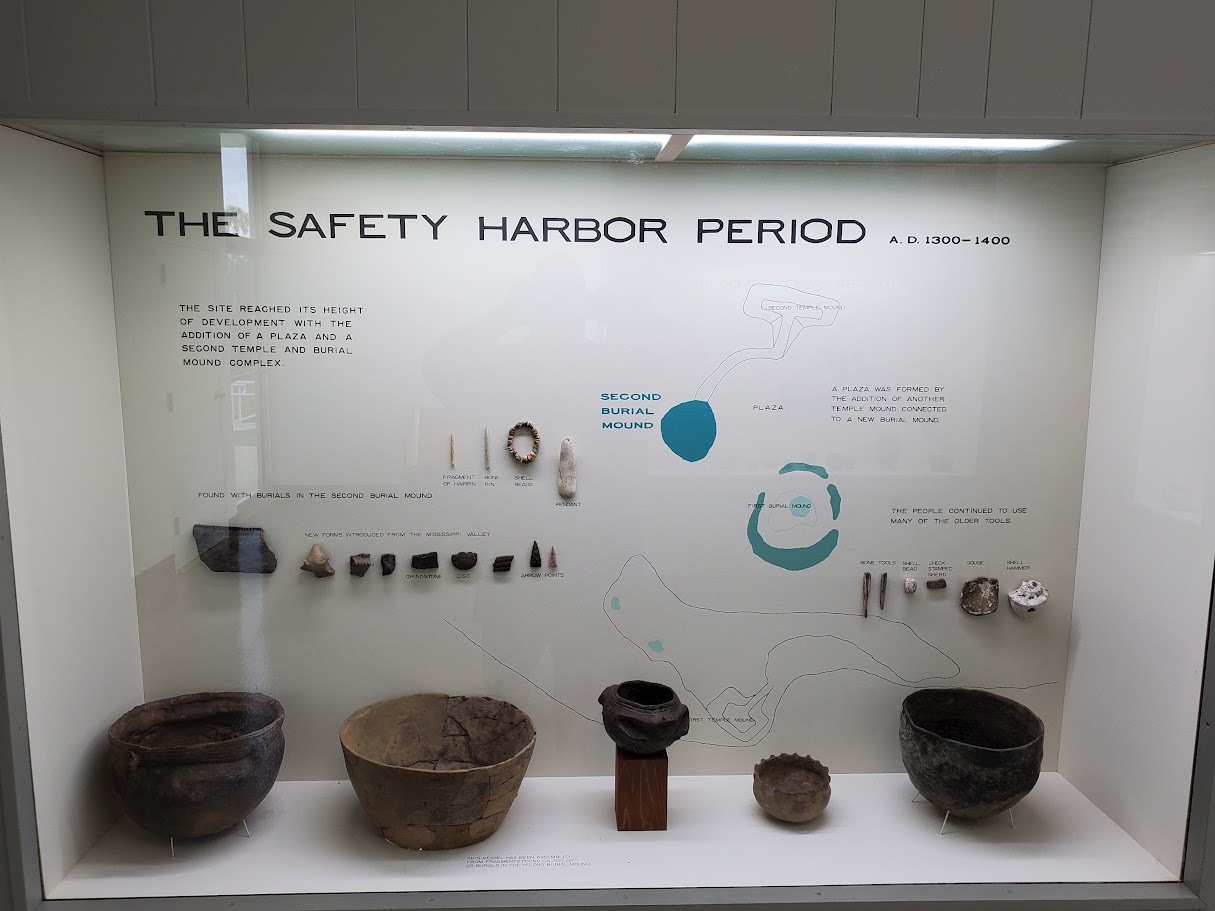
Crystal River Mounds site photo by Damien Marie AtHope
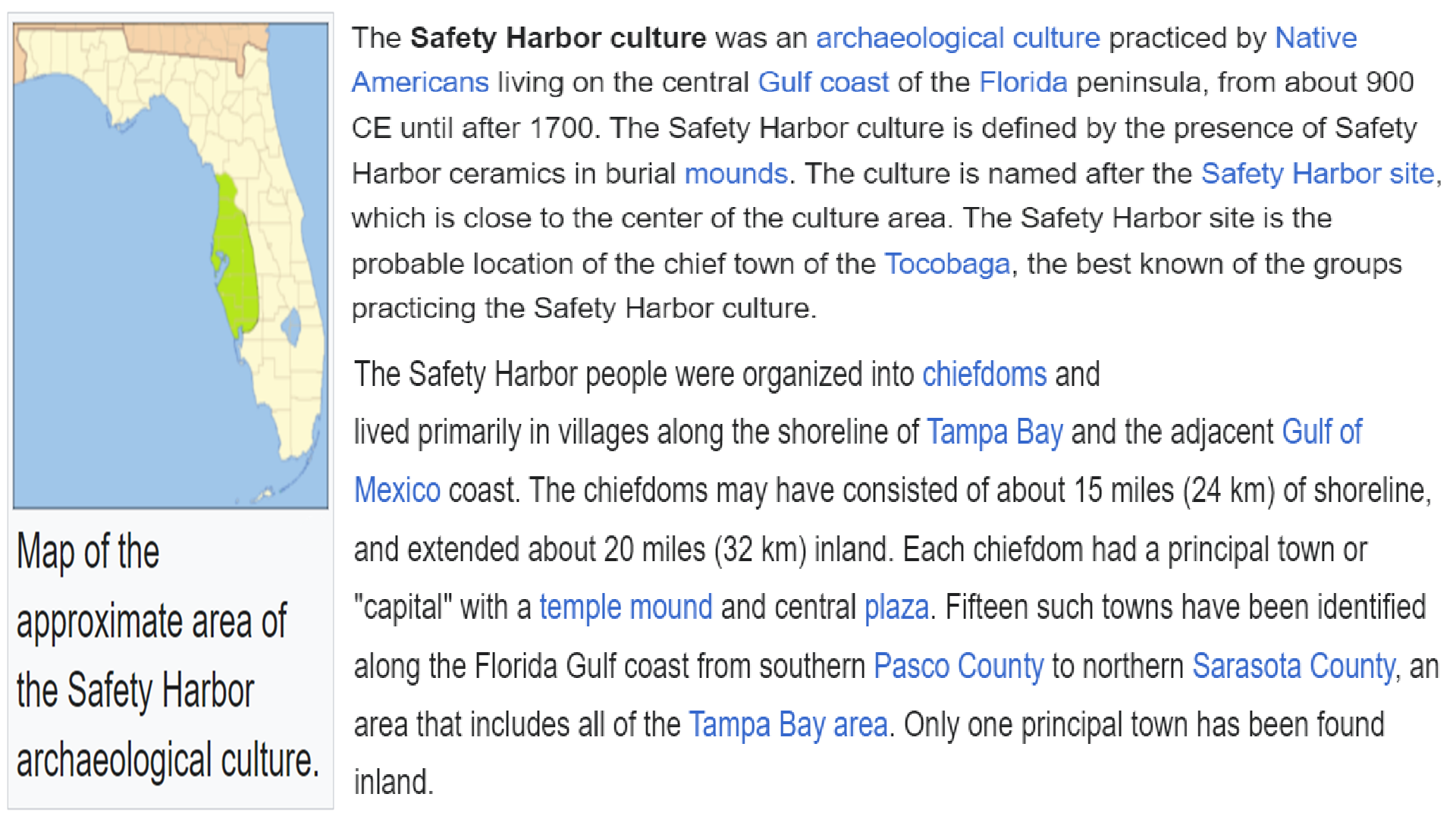
Safety Harbor culture
“The Safety Harbor culture was an archaeological culture practiced by Native Americans living on the central Gulf coast of the Florida peninsula, from about 900 CE until after 1700. The Safety Harbor culture is defined by the presence of Safety Harbor ceramics in burial mounds. The culture is named after the Safety Harbor site, which is close to the center of the culture area. The Safety Harbor site is the probable location of the chief town of the Tocobaga, the best-known of the groups practicing the Safety Harbor culture. The Safety Harbor people were organized into chiefdoms and lived primarily in villages along the shoreline of Tampa Bay and the adjacent Gulf of Mexico coast. The chiefdoms may have consisted of about 15 miles (24 km) of shoreline, and extended about 20 miles (32 km) inland. Each chiefdom had a principal town or “capital” with a temple mound and central plaza. Fifteen such towns have been identified along the Florida Gulf Coast from southern Pasco County to northern Sarasota County, an area that includes all of the Tampa Bay area. Only one principal town has been found inland.” ref
“Descriptions of the villages by Spanish visitors mostly agree with archaeological reconstructions. Capitals had a central rectangular plaza. A truncated pyramidal mound up to 20 feet (6.1 m) high and up to 130 feet (40 m) long on each side at the base stood on one side of the plaza. One or more buildings stood on top of the mound, and a ramp ran from the top of the mound to the plaza. A burial mound would be located off to the side. A shell mound, or midden, ran along the shore, and other middens were sometimes located on other sides of the plaza. The plaza itself was kept clear of debris. The more important residents of the town had their houses around the plaza, while the lower class lived in huts further from the plaza. The Spanish reported that the chief and his family lived on the main mound, and that a “temple” (probably a charnel house) stood on the opposite side of the plaza. Archaeological excavations suggest that the charnel houses were on the mounds. Village sites without mounds, and isolated burial mounds, are also known.” ref
“The Safety Harbor culture area extended along the central Gulf coast of Florida. Bullen described it as running from Tarpon Springs to Sarasota, with some evidence that it reached the Aucilla River to the north and Charlotte Harbor to the south. Mitchem limited the northern extent of the culture area to the Withlacoochee River, but included the coast south into Collier County, and east into eastern Polk County. Milanich defines the culture area as the coast from the Withlacoochee River to Charlotte Harbor, placing the area from Charlotte Harbor to Collier County in the Caloosahatchee culture. The heart of the culture area was around Tampa Bay, what Mitchem and Milanich call “Circum-Tampa Bay.” This area included all of what is now Hillsborough and Pinellas counties, southern Pasco County, and northern Manatee County. To the north. the area between the Withlacoochee River and the Gulf coast, including Citrus County, Hernando County, and northern Pasco County, formed the “Northern Safety Harbor” area.” ref
“South of Tampa Bay, southern Manatee County, Sarasota County, and northern Charlotte County comprised the “Manasota Safety Harbor” (Mitchem) or “South-Central Safety Harbor” (Milanich) area (Manasota is also the name given to the Weedon Island-related culture, which preceded the Safety Harbor culture in most of its area). Mitchem later agreed that “South-Central Safety Harbor” was preferable to avoid confusion. DeSoto County, Hardee County, and most of Polk County were part of the “Inland Safety Harbor” area. Mitchem called his regional variant south of Charlotte Harbor (southern Charlotte County, Lee County, and western Collier County) “South Florida.” ref
“Safety Harbor ceramics are found in burial mounds in the Caloosahatchee culture area (Mitchem’s South Florida Safety Harbor). Milanich ascribes the presence of such objects to trade, but states that future work may clarify the relationship of the Safety Harbor and Caloosahatchee cultures. Luer and Almy note that temple mounds south of Charlotte Harbor differ significantly from Safety Harbor temple mounds in form. Luer has also argued that other materials found in burial mounds south of Charlotte Harbor belong to a south Florida, or “Glades Cult”, artifact complex. Luer also argues that the presence of Mississippian culture and St. Johns culture artifacts in burial mounds shows that such articles, along with Safety Harbor objects, were traded into the area.” ref
“The Safety Harbor culture developed in place from the preceding Manasota culture, a Weeden Island-related culture of the central Florida Gulf coast. Safety Harbor was influenced by the Mississippian culture, with some ceramics resembling the Mississippian-related Fort Walton culture and incorporating symbols of the Southeastern Ceremonial Complex; however, the people of the Safety Harbor culture had not adopted an agricultural economy, and, consequently, the culture did not become Mississippian. Safety Harbor mounds were typically built on late Weeden Island period mounds. Changes in decorated ceramics and the presence of European artifacts support a division of the Safety Harbor culture into four phases. Pre-contact phases were the Englewood, 900-1100, and the Pinellas, 1100-1500. Phases during the Spanish colonial period included Tatham, 1500-1567, and Bayview, 1567-1725.” ref
“The Safety Harbor culture is defined by the presence of burial mounds with ceramics decorated with a distinctive set of designs and symbols. Ceramics found elsewhere at Safety Harbor sites (in middens and village living areas) are almost always undecorated. Major Safety Harbor sites had platform, or temple, mounds. The term “temple mound” is based on the description by members of the de Soto expedition of a temple on a constructed earthwork mound in a Safety Harbor village. Bullen and Milanich state that the temples were likely charnel houses, where bodies were prepared and stored for later burial. Several of the temple mounds have been destroyed since the 19th century, but at least fifteen have been documented as having once existed around Tampa Bay and on the Gulf coast near Tampa Bay. These temple mounds were rectangular and had flat tops, usually with a ramp leading up to the top on one side.” ref
“Three platform mounds east and south of Charlotte Harbor, the Acline Mound (Aqui Esta site, near Punta Gorda), Howard Shell Mound (Bokeelia Island, at the north end of Pine Island), and Brown’s Mound (Pineland site, near Pineland on Pine Island), differ from Safety Harbor temple mounds in having a U-shaped platform, and no ramps. This difference in form may indicate the mounds belong to the Caloosahatchee culture instead of the Safety Harbor culture. Luer and Almy also note that the large Bostic Temple Mound in Hardee County, which is associated with a village area and burial mounds, was contemporary with Safety Harbor temple mounds. They suggest that this site was the center for a distinct cultural and political system oriented to the Peace River valley. There are two “truncated rectangular” mounds at the Crystal River site that have mentioned as possible Safety Harbor temple mounds, but the other mounds there pre-date Safety Harbor, and there is little evidence of Safety Harbor use of the site. A large flat-topped shell mound, the Withlacoochee River Platform Mound, is next to the Withlacoochee River in Citrus County, but it has not been investigated. Whether it has any connection to the Safety Harbor culture is unknown.” ref
“Luer and Almy used the reported height, shape, and dimensions of thirteen of the temple mounds to calculate their volume. They used this data to classify the mounds: Class A, consisting of the Anclote and Snead Island temple mounds, had high volumes (7000 to 7700 m³), low heights (4 m or less), and large summit platforms (greater than 1000 m² in area). Class B, including the Safety Harbor and Bayshore Homes temple mounds, had high volumes of 6500 to 6900 m³, were tall (greater than 5 m), and had a summit platform 440 to 760 m² in area. The nine remaining temple mounds varied in height and shape, but were much lower in volume, 3500 m³ or less. Luer and Almy note that the four mounds in Classes A and B are spaced along the coast line about 25 to 30 km apart, while the smaller Class C mounds are often much closer to each other and to the major mounds. Luer and Almy suggest that the temple mounds represent a hierarchy, with the four largest mounds serving as regional centers, and the smaller mounds located at subsidiary villages and serving different purposes.” ref
“On the other hand, Milanich suggests that the centers of political units may have moved from time to time, and that only some of the temple mounds were in use at any given time. Burial mounds containing Safety Harbor ceramics are common in the Circum-Tampa Bay area, and are found scattered through the outlying areas. Burial mounds in the Northern Safety Harbor region include a mound at Weeki Wachee Springs, and the Ruth Smith and Tatham mounds in the Cove of the Withlacoochee. Burial mounds south of the Tampa Bay area include the Sarasota and Myakka Valley Ranches mounds. The Phillip Mound, close to the Kissimmee River in the Inland Safety Harbor area, contained a large number of Safety Harbor ceramics.” ref
“The Tocobaga kept the bodies of recently dead people in their temples or charnel houses until the bones had been cleaned. The Spanish visitors described the bodies as being wrapped in painted deer hides and stored in wooden boxes sitting on the ground. One of the Spanish captives of the Tocobaga reported that he had been assigned to guard a temple at night to keep wolves from carrying off the bodies. Garcilaso de la Vega reported that lions (cougars) would carry away bodies. After the bones had been cleaned, they would be buried. A Spanish account of a chief’s funeral states that his body was “broken up” and placed in large jars, and the flesh was removed from the bones over two days. The skeleton was then reassembled and left in the temple for four days while the people fasted. At the end of the four days, all the people of the town would take the bones and place them in a burial mound. In some cases bodies were cremated and then buried in the mound on which the charnel house sat.” ref
“As was the case in much of Florida, a vast majority of the Tampa Bay area’s temple mounds, burial mounds, and middens were destroyed during development as the local population grew rapidly in the early to mid-20th century. Developers sought to level land near the water, and road construction crews found that bulldozed shell mounds made for excellent road fill. State and federal laws now afford protection to sites that contain human remains or are located on public land, but preservation of other archeological sites on private land is optional and encouraged by offering tax deductions and other incentives. The Spanish reported four social classes among the Safety Harbor people: chiefs, headmen, warriors and ordinary people, and slaves. Europeans and members of other tribes who had been captured were slaves. A chief who visited de Soto in his camp was carried there on the back of another man. Chiefs were often married to the sisters of other chiefs.” ref
“The Safety Harbor people ate fish, shellfish, deer, turtles, and dogs, as well as watercress, pumpkins, “cabbage” from palmettos or cabbage palms, and beans. Maize may have been a minor part of the diet, but the southern limit of maize agriculture prior to the arrival of the Europeans was to the north of Tampa Bay. They used bows and arrows, equipped with stone arrowheads or stingray stingers. Houses were built with wooden posts and covered with palm leaves. “Temples” (or charnel houses) and other buildings were decorated with wood carvings. Pottery used in daily life was largely undecorated, but ceremonial vessels (found in burials) were distinctively decorated (the defining characteristic of the Safety Harbor culture).” ref
“The name “Tocobaga” is often used to refer to all of the indigenous peoples of the Tampa Bay area during the first Spanish colonial period (1513-1763). In a strict sense, Tocobaga was the name of a chiefdom, its main town, and its chief, all of which were probably centered at the Safety Harbor site at the north end of Old Tampa Bay. Other Safety Harbor chiefdoms named in Spanish accounts include Mocoso, on the east side of Tampa Bay, Pohoy (Capaloey), possibly on the north side of Hillsborough Bay, and Uzita, on the south side of Tampa Bay. The chief of Mocoso also named Neguarete and Orriygua as neighboring chiefs, but it is not known if they were in the Safety Harbor culture area. It is not known what these chiefdoms shared aside from the Safety Harbor culture. Hernando de Escalante Fontaneda, a captive of south Florida Indians for many years in the early 16th century, described Tocobaga as “King head chief of that district”, but also described Tocobaga and Mocoso as independent “Kingdoms.” ref
“The accounts of the de Soto expedition (which do not mention Tocobaga) state that Mocoso and Uzita were subject to a chief called Urriparacoxi or Paracoxi, who lived 30 leagues east or northeast of Tampa Bay. The people of Mocoso and of Uzita were noted as having spoken different languages. Hann argues that the language of the Mocoso people was Timucuan. There is no mention of Mocoso or Uzita in Spanish records after the passage of the de Soto expedition. The chiefdom of Tocobaga was apparently the major power in the Tampa Bay area during the later half of the 16th century, especially at the time of Pedro Menéndez de Avilés‘s visit in 1567. Tocobaga’s power apparently waned in the 17th century, with first the Pohoy, and then the Calusa, becoming the dominant power in the Tampa Bay area. By around 1700, however, the Safety Harbor culture had virtually disappeared due to disease and incursions by other Native Americans from the north.” ref

Crystal River Mounds site photo by Damien Marie AtHope

Weeden Island culture
“The Weeden Island cultures are a group of related archaeological cultures that existed during the Late Woodland period (500 – 1000 CE) of the North American Southeast. The name for this group of cultures was derived from the Weedon Island site (despite the dissimilar spellings) in Old Tampa Bay in Pinellas County. Weeden Island cultures are defined by ceramics, which fall into two categories, sometimes called secular and sacred. Sacred ceramics are found primarily in mounds, while secular ceramics are found primarily in middens and house sites. The two types of ceramics have separate histories, and the secular ceramics show considerable variation between regions. Milanich, et al. compare the Weeden Island sacred complex to the Hopewell and Mississippian complexes, i.e., a ceremonial complex practiced by several cultures.” ref
“Scholars believe that the secular components of Weeden Island cultures emerged from the Swift Creek culture during the Middle Woodland Period (ca. 200 – 500 CE) in the lower Chattahoochee–Apalachicola river drainage, where Alabama, Florida, and Georgia meet. To the east of this Weeden Island heartland, Weeden Island secular components developed out of the Deptford culture, from which the Swift Creek culture had also developed. The sacred or ceremonial component of Weeden Island developed out of the Hopewell tradition-based Yent and Green Point traditions. It persisted in some areas until the end of the Woodland period ca. 1200. Weeden Island sites have been found from Mobile Bay to the Okefenokee Swamp, and from south of Tampa Bay to the fall line on the Chattahoochee River at Columbus, Georgia.” ref
“Although the multiple geographic variants of Weeden Island groups used slightly different subsistence strategies dictated by the local environment (including small-scale agriculture in some areas), a trend toward the semi-sedentary hunter-gatherer exploitation of hardwood hammock areas and coastal/riverine marine resources accurately characterizes Weeden Island subsistence activities in general. The site on Weedon Island, where Weeden Island, sacred ceramics were first described, was excavated by Smithsonian Institution archaeologist J. Walter Fewkes in 1923 and 1924. Archaeologists now recognize that the Weedon Island site is well outside the heartland of the Weeden Island culture. The Weedon Island site was part of the Weeden Island-related late Manasota culture. The Manasota culture developed around 500 BCE, 700 years before the development of the Weeden Island sacred complex. The secular component of the Manasota culture had no connection with the secular components of heartland Weeden Island cultures.” ref
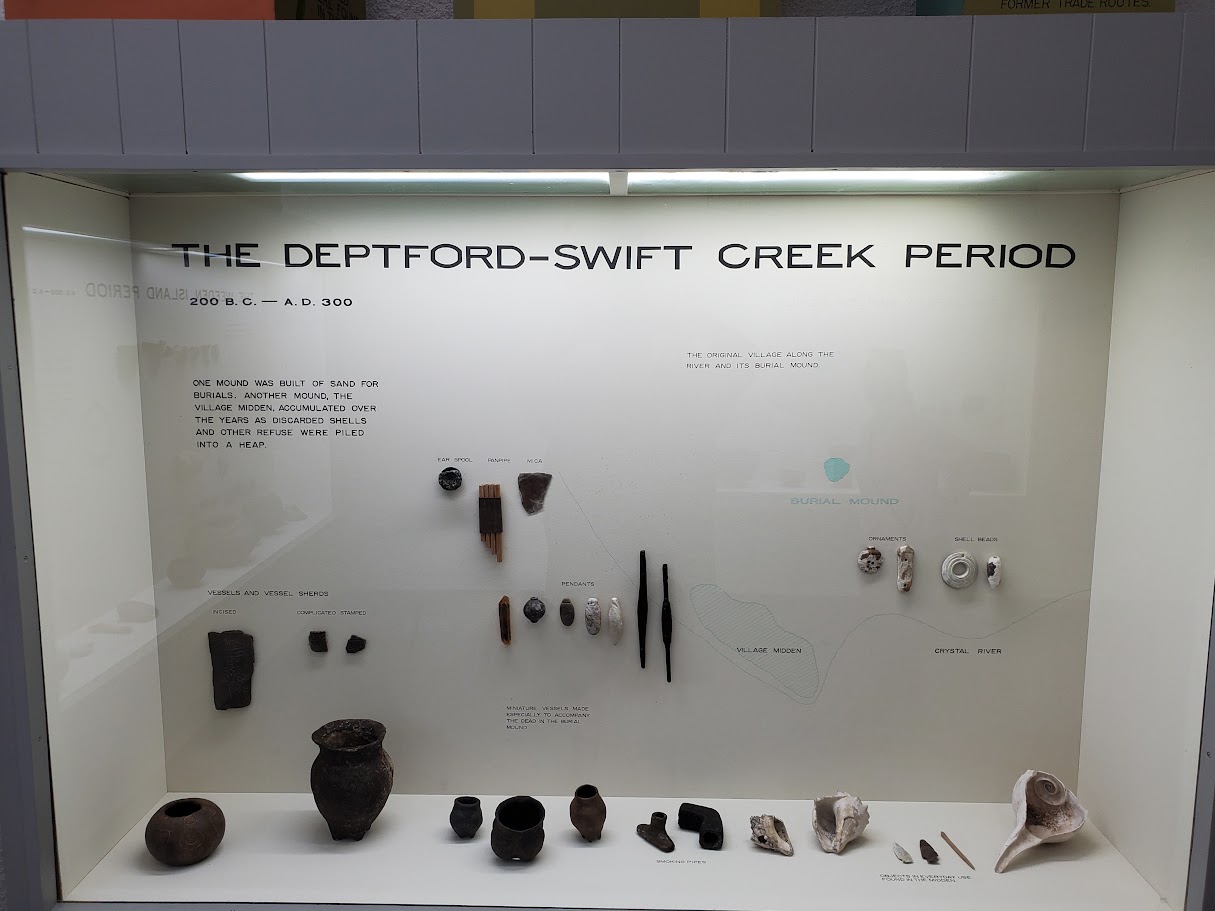
Crystal River Mounds site photo by Damien Marie AtHope

Crystal River Mounds site photo by Damien Marie AtHope

Crystal River Mounds site photo by Damien Marie AtHope
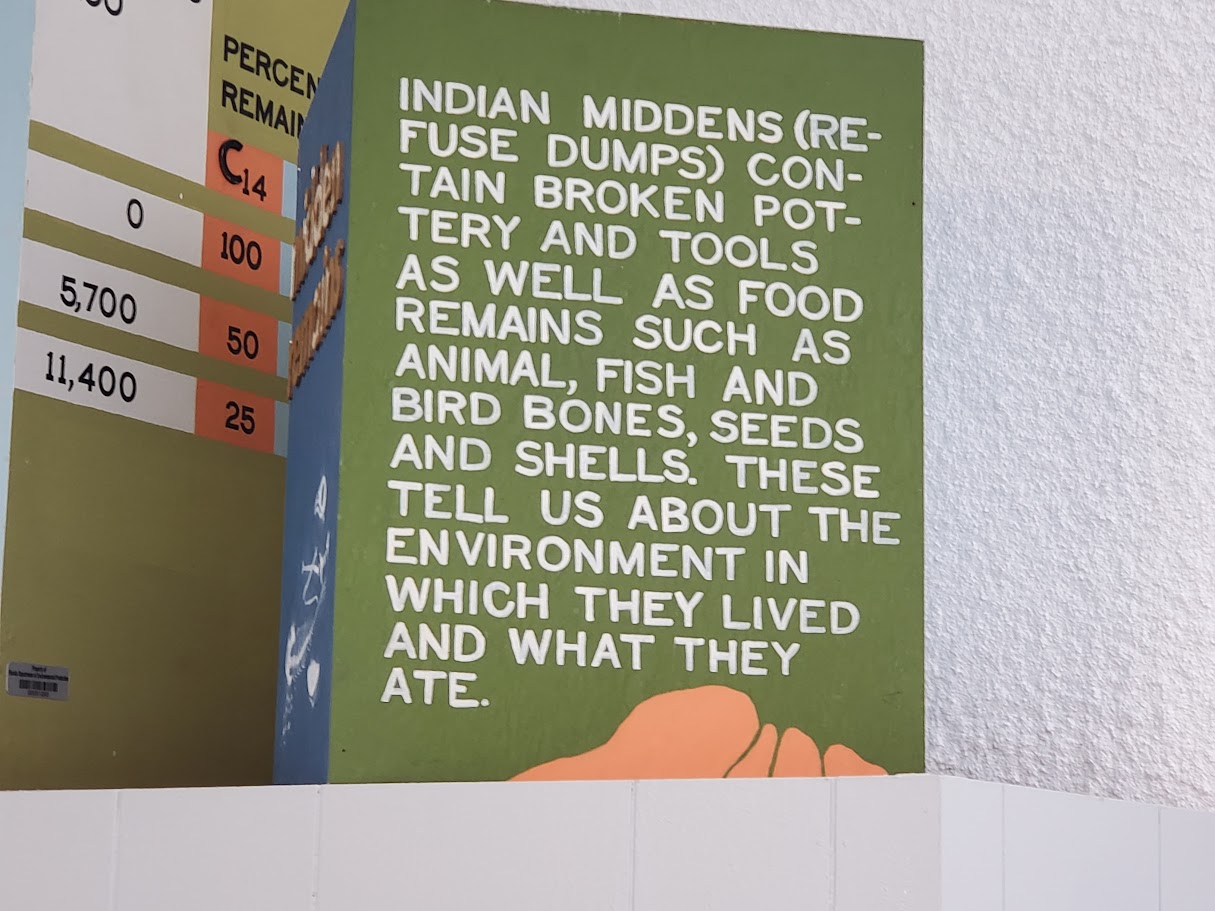
Crystal River Mounds site photo by Damien Marie AtHope

Crystal River Mounds site photo by Damien Marie AtHope

Crystal River Mounds site photo by Damien Marie AtHope
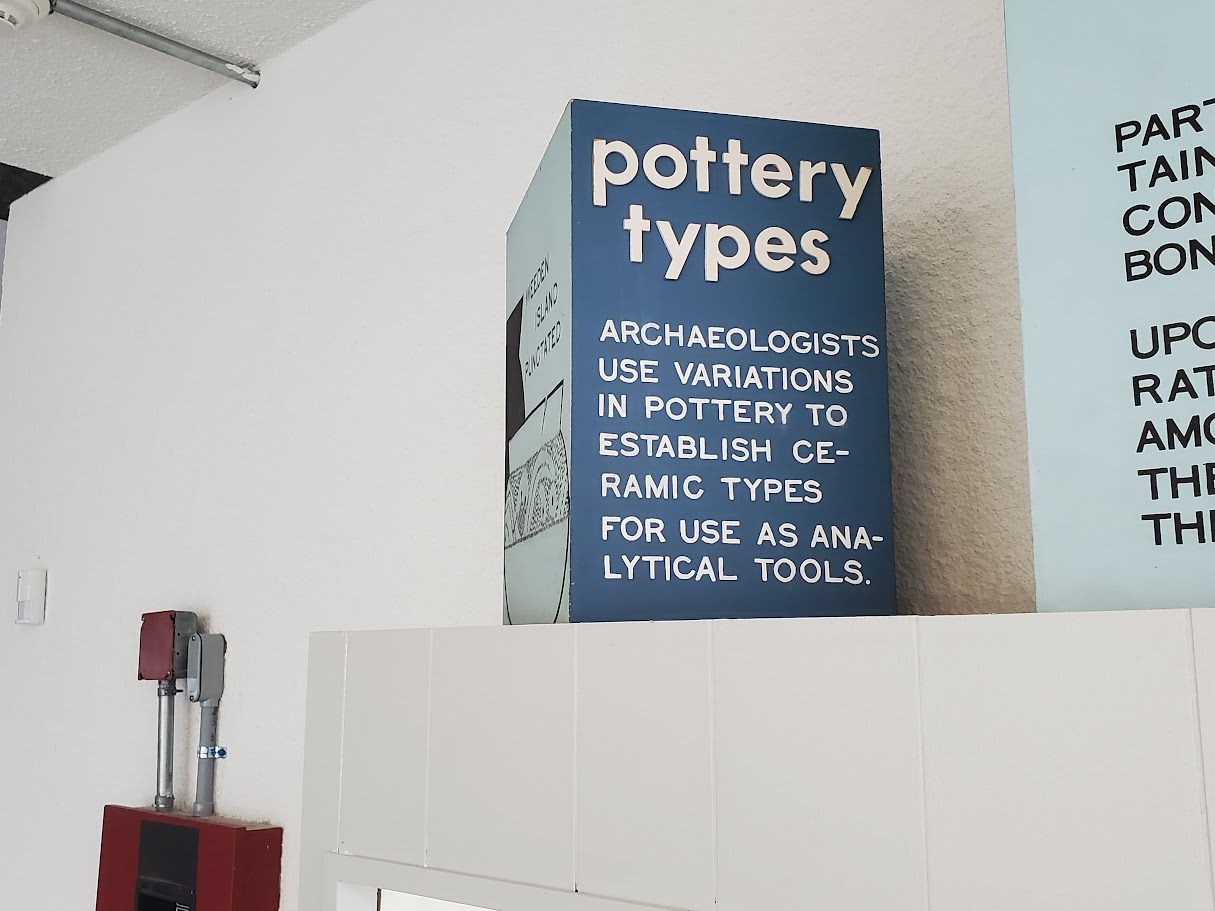
Crystal River Mounds site photo by Damien Marie AtHope

Crystal River Mounds site photo by Damien Marie AtHope

Crystal River Mounds site photo by Damien Marie AtHope
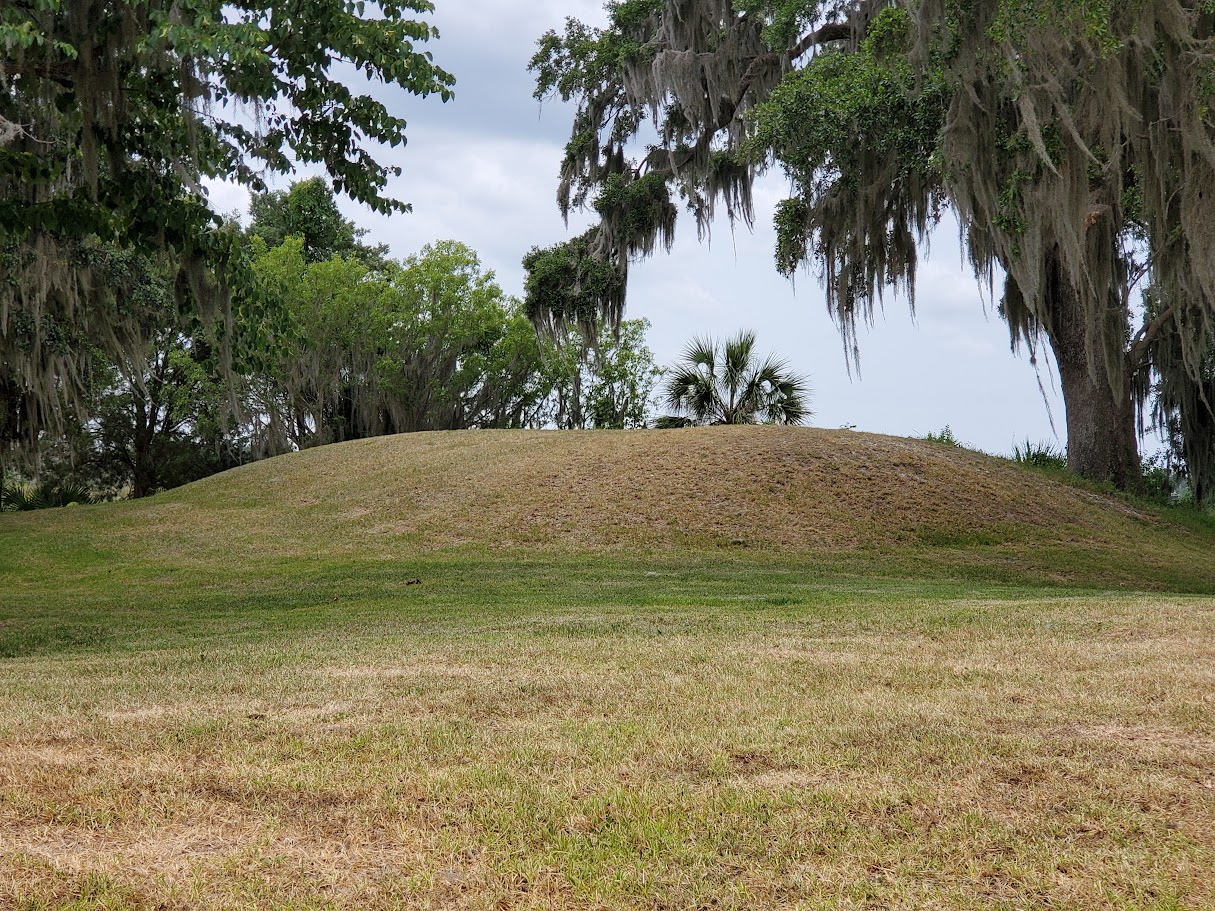
Crystal River Mounds site photo by Damien Marie AtHope
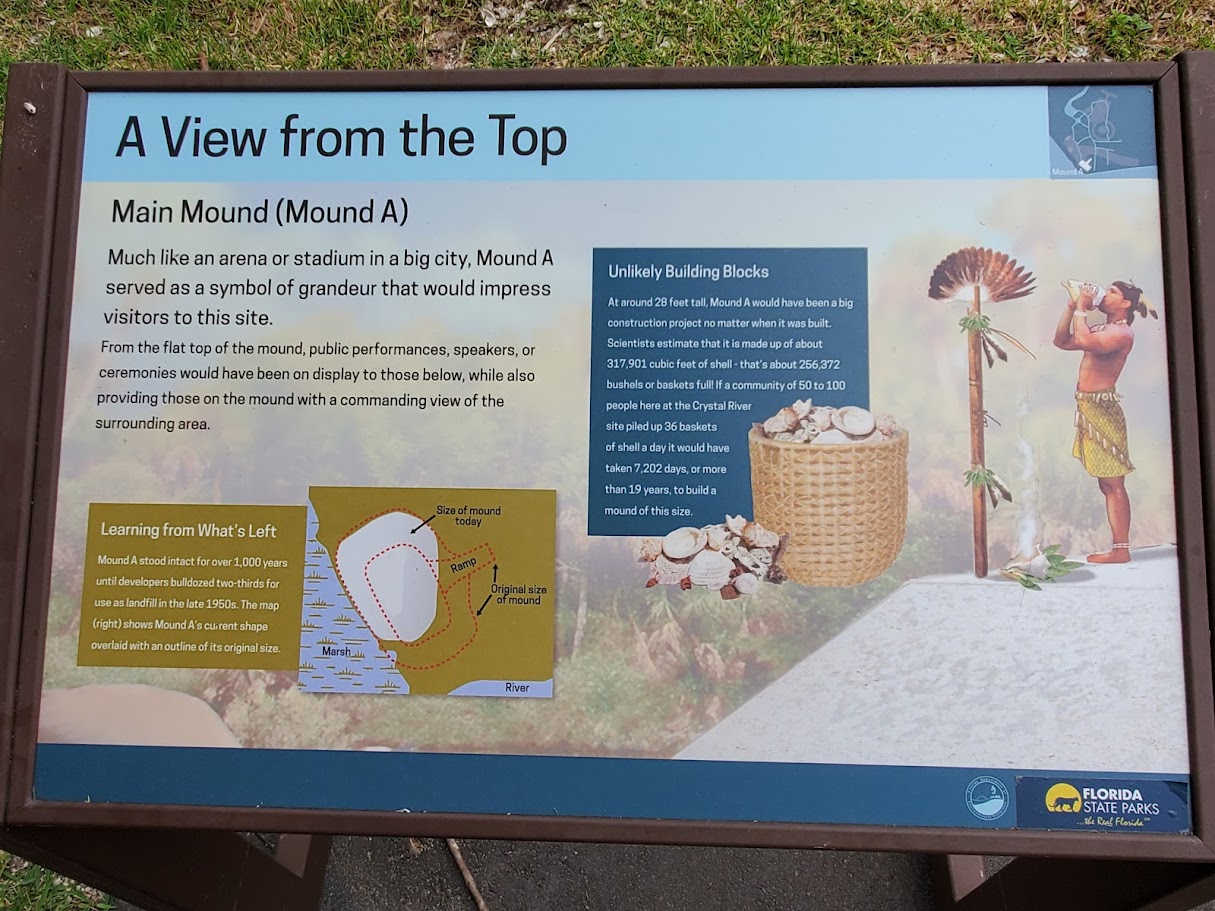
Crystal River Mounds site photo by Damien Marie AtHope
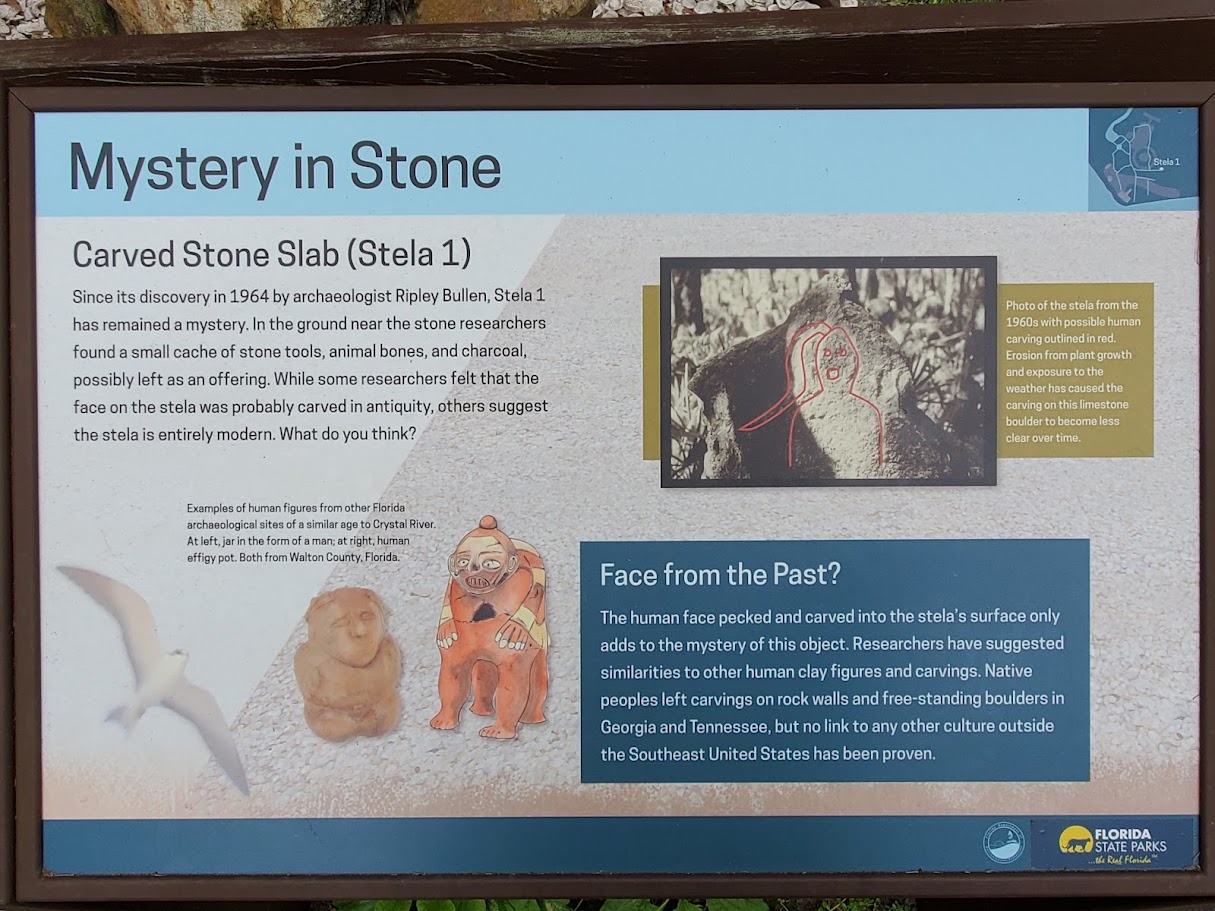
Crystal River Mounds site photo by Damien Marie AtHope
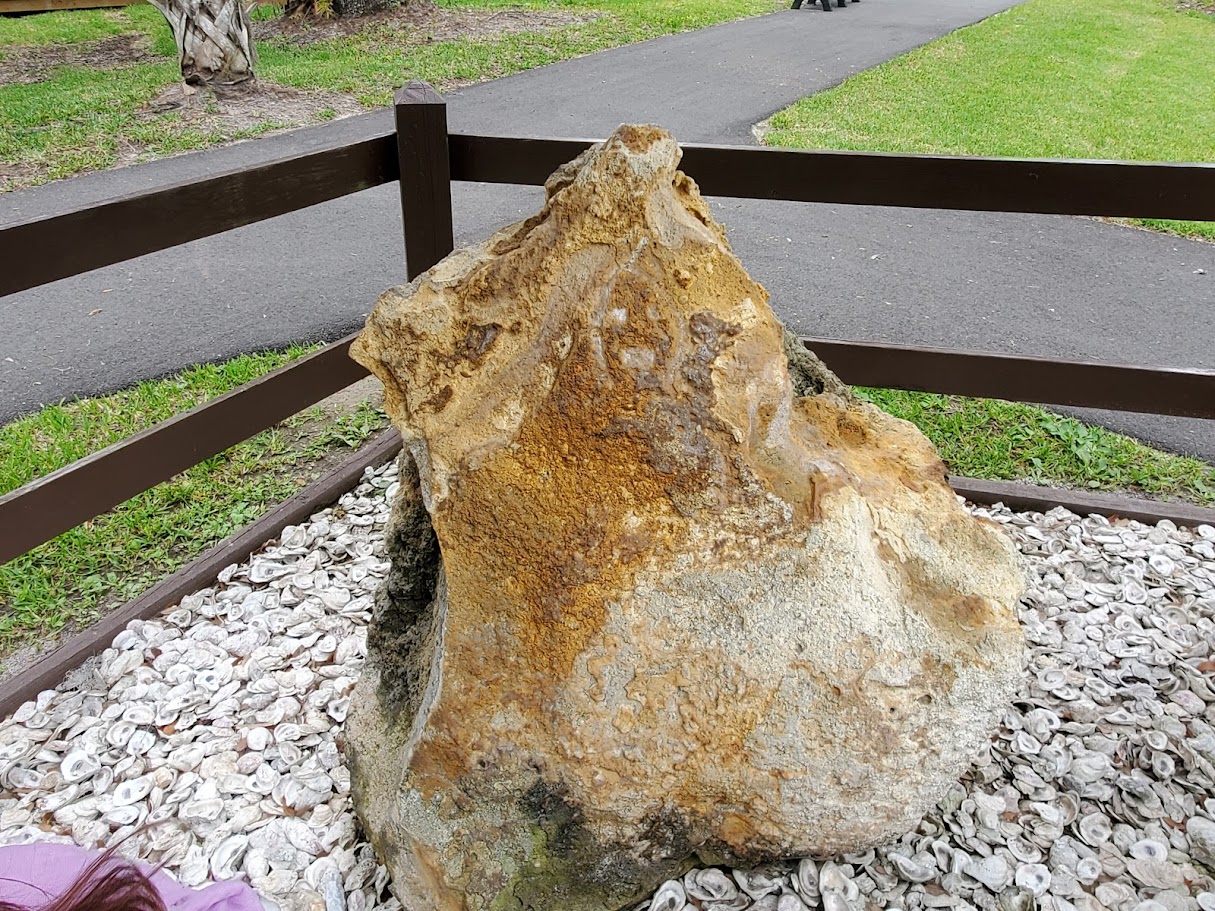
Crystal River Mounds site photo by Damien Marie AtHope
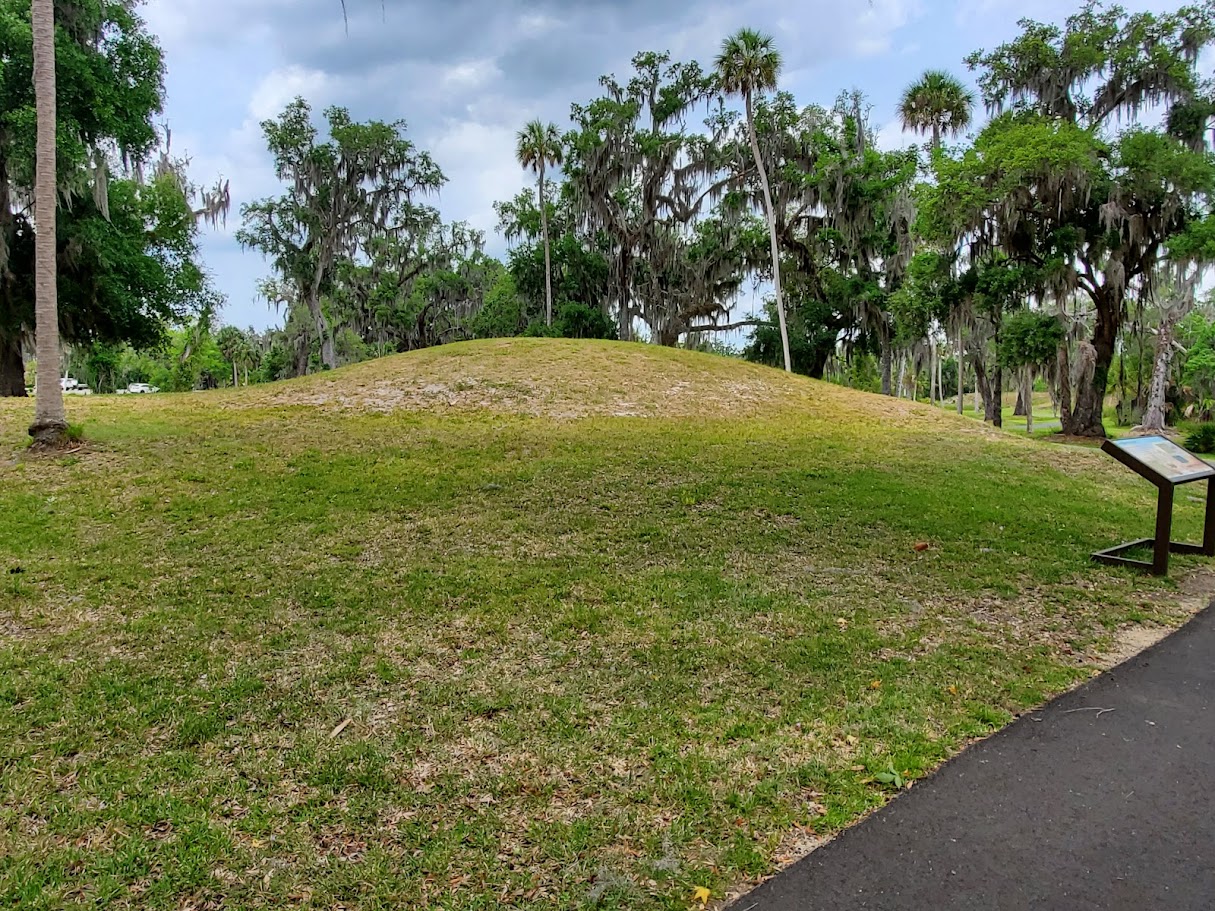
Crystal River Mounds site photo by Damien Marie AtHope
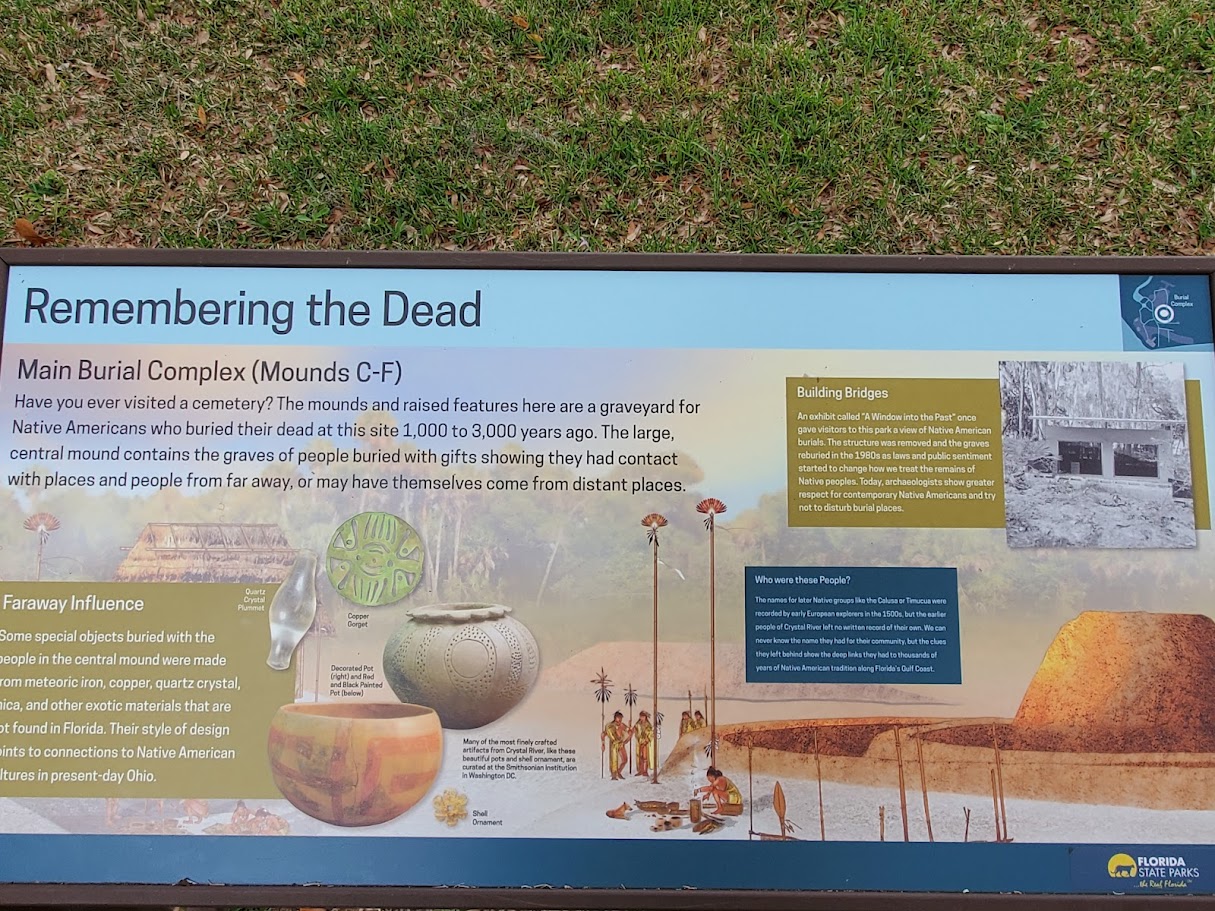
Crystal River Mounds site photo by Damien Marie AtHope
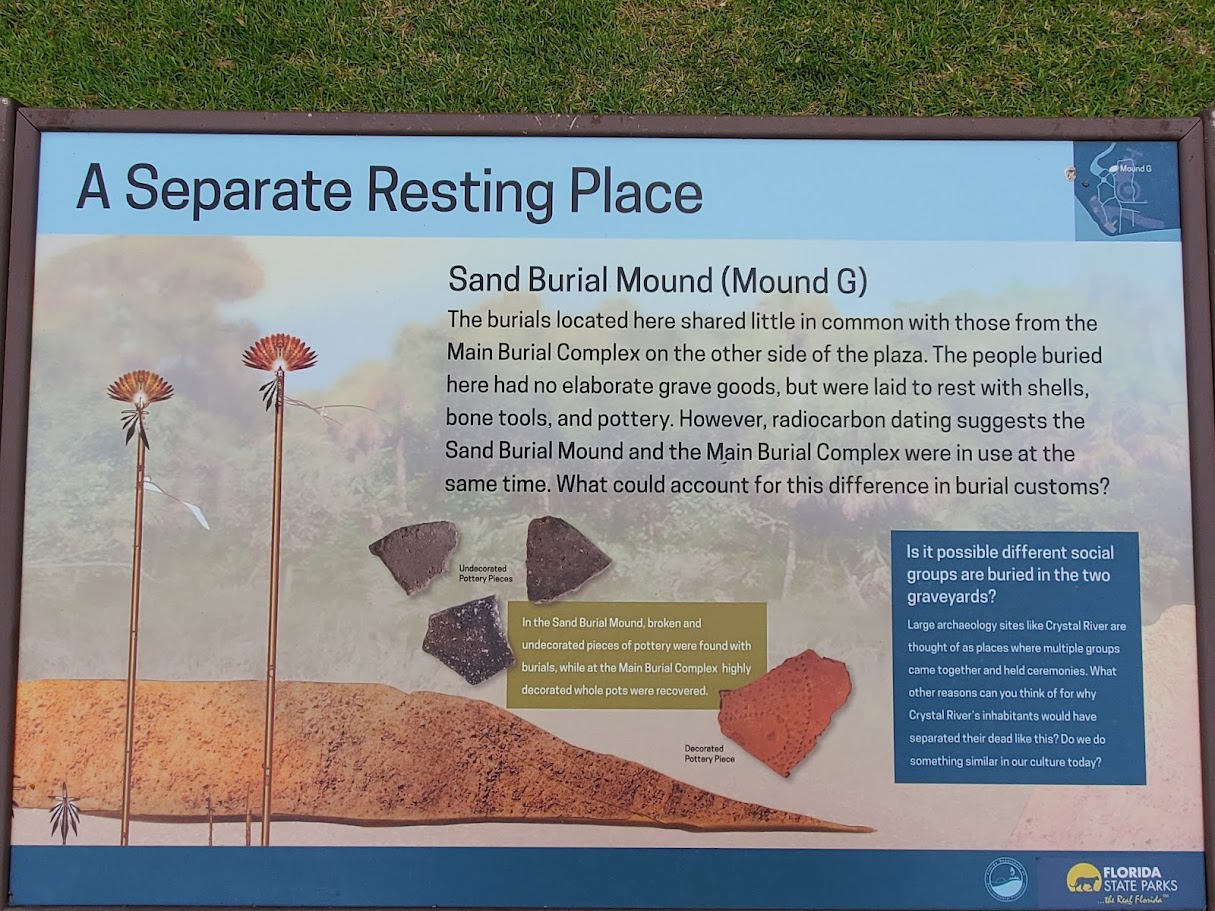
Crystal River Mounds site photo by Damien Marie AtHope

Crystal River Mounds site photo by Damien Marie AtHope

Crystal River Mounds site photo by Damien Marie AtHope
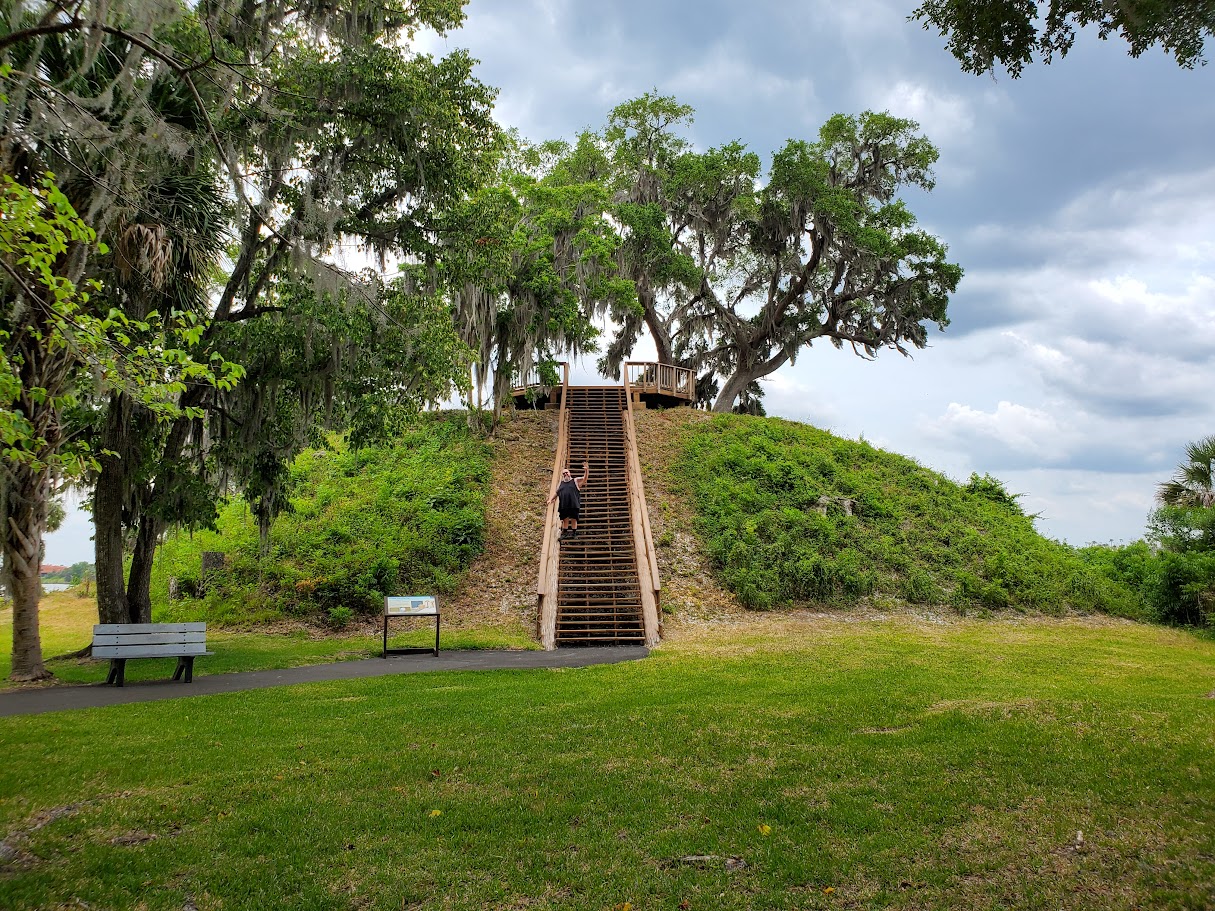
Crystal River Mounds site photo by Shayna Marie AtHope
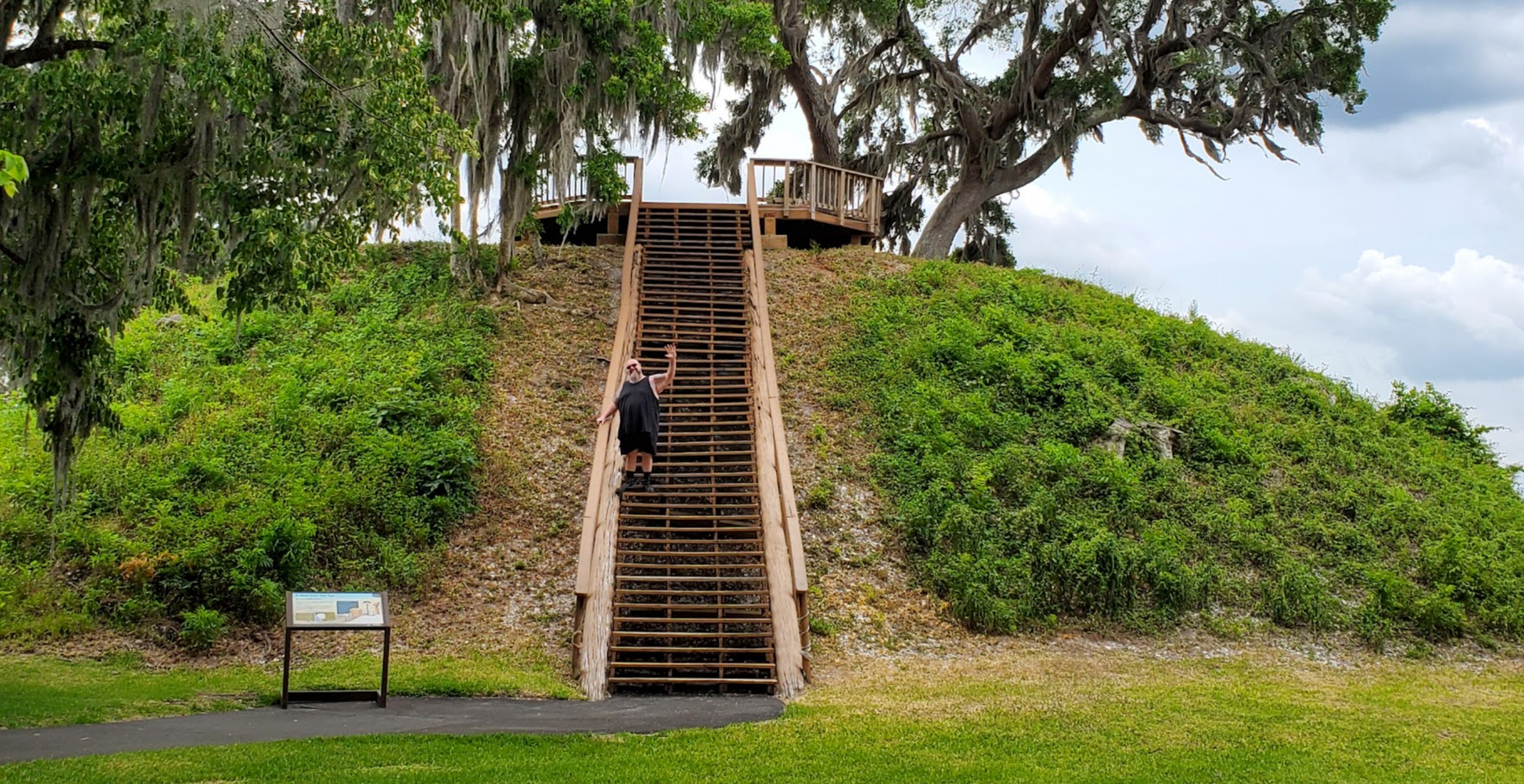
Crystal River Mounds site photo by Shyna Marie AtHope
I (Damien) am 6ft tall, so that you understand the perspective.
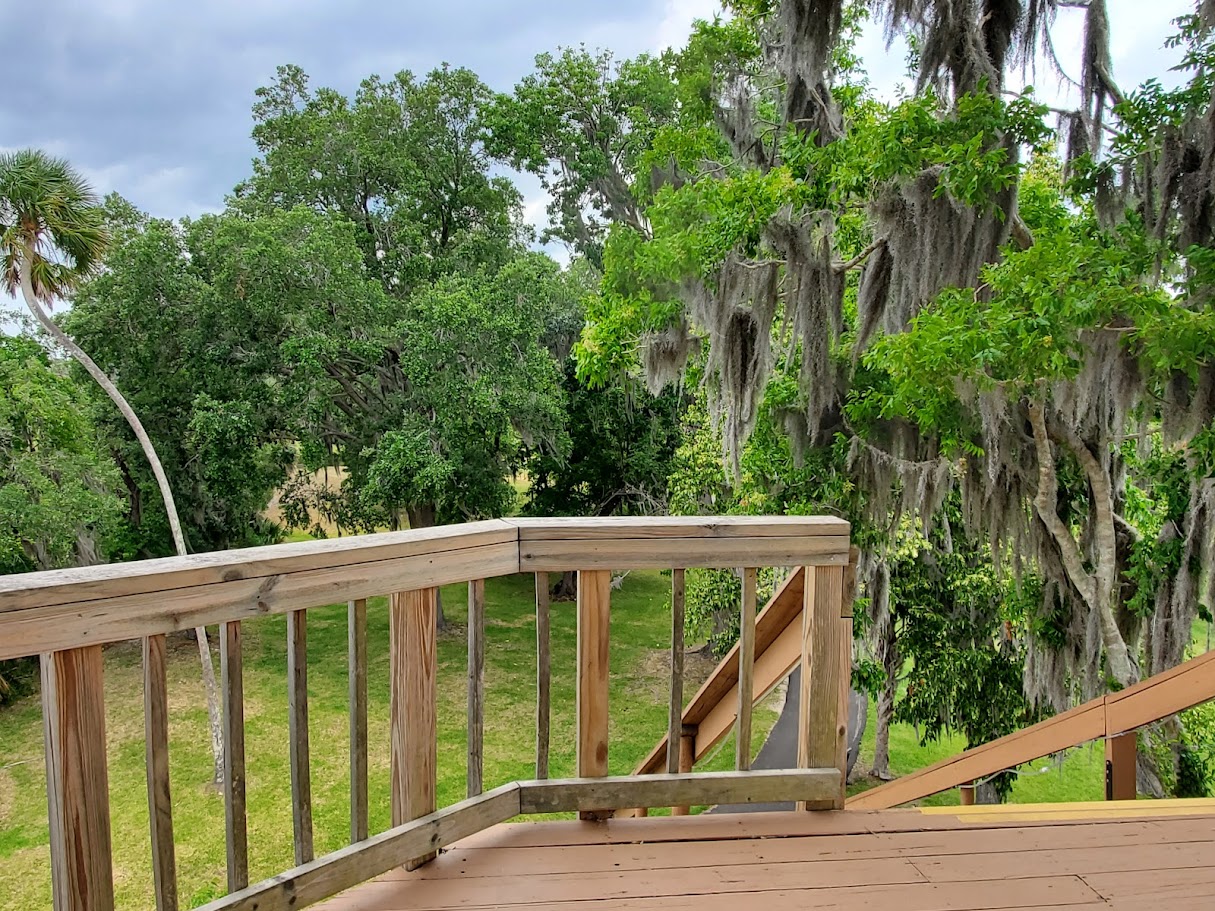
Crystal River Mounds site photo by Damien Marie AtHope
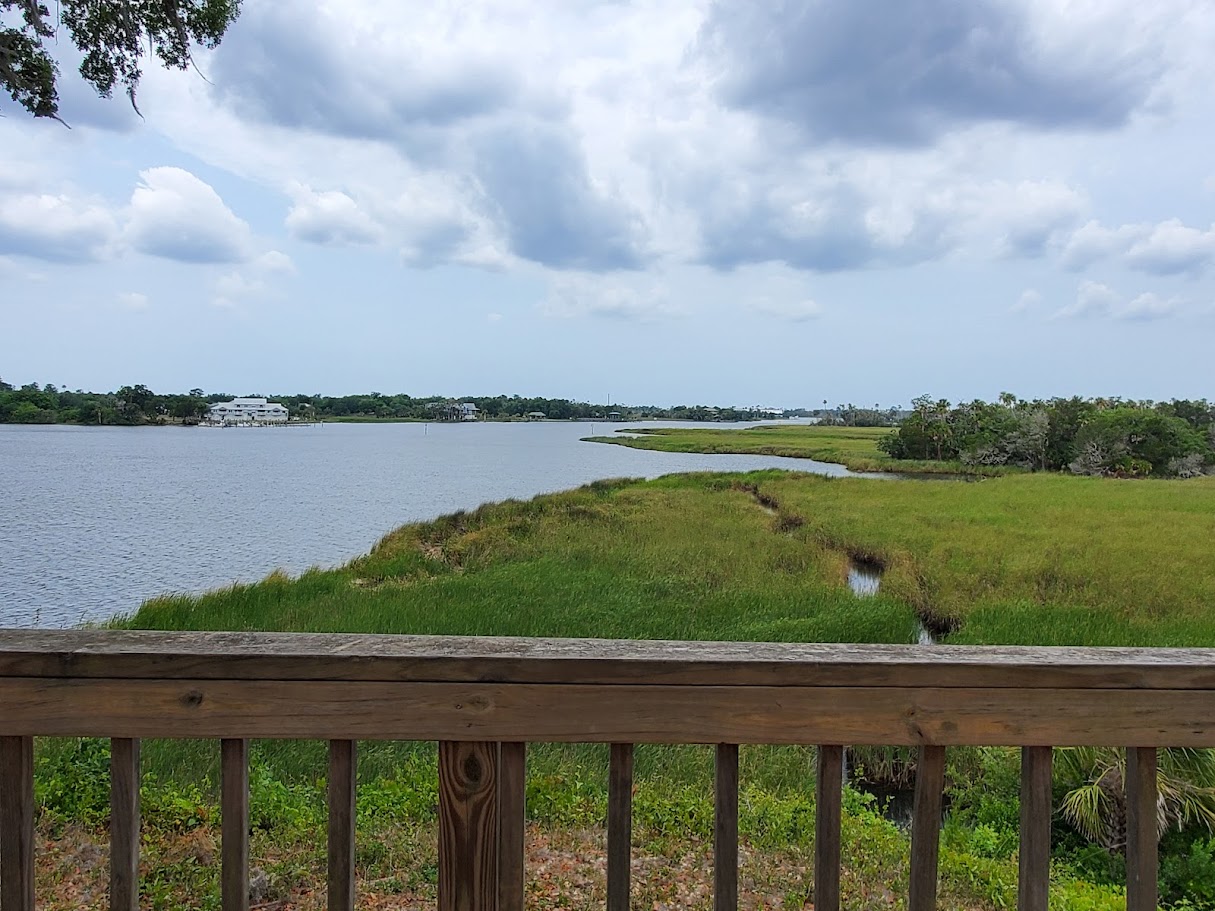
Crystal River Mounds site photo by Damien Marie AtHope
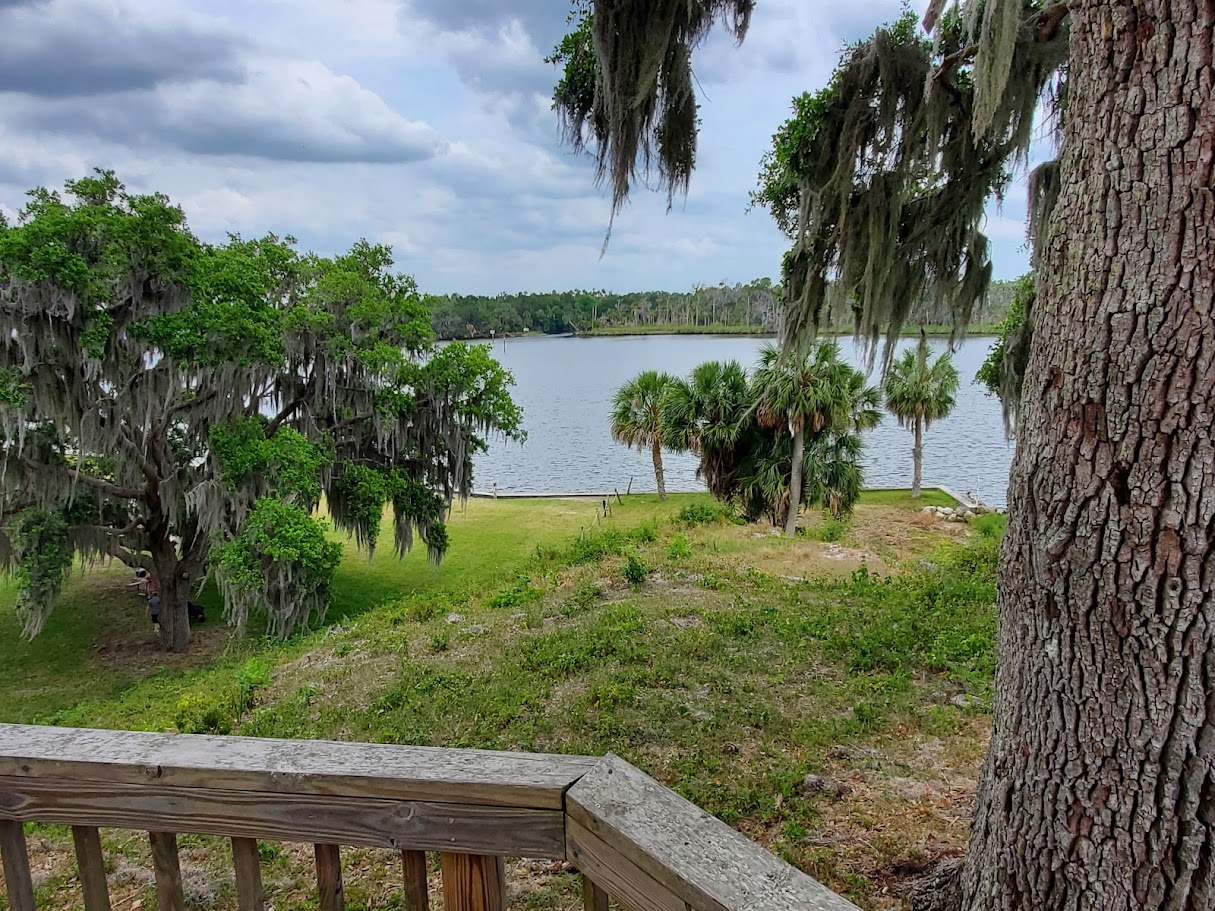
Crystal River Mounds site photo by Damien Marie AtHope

Crystal River Mounds site photo by Damien Marie AtHope
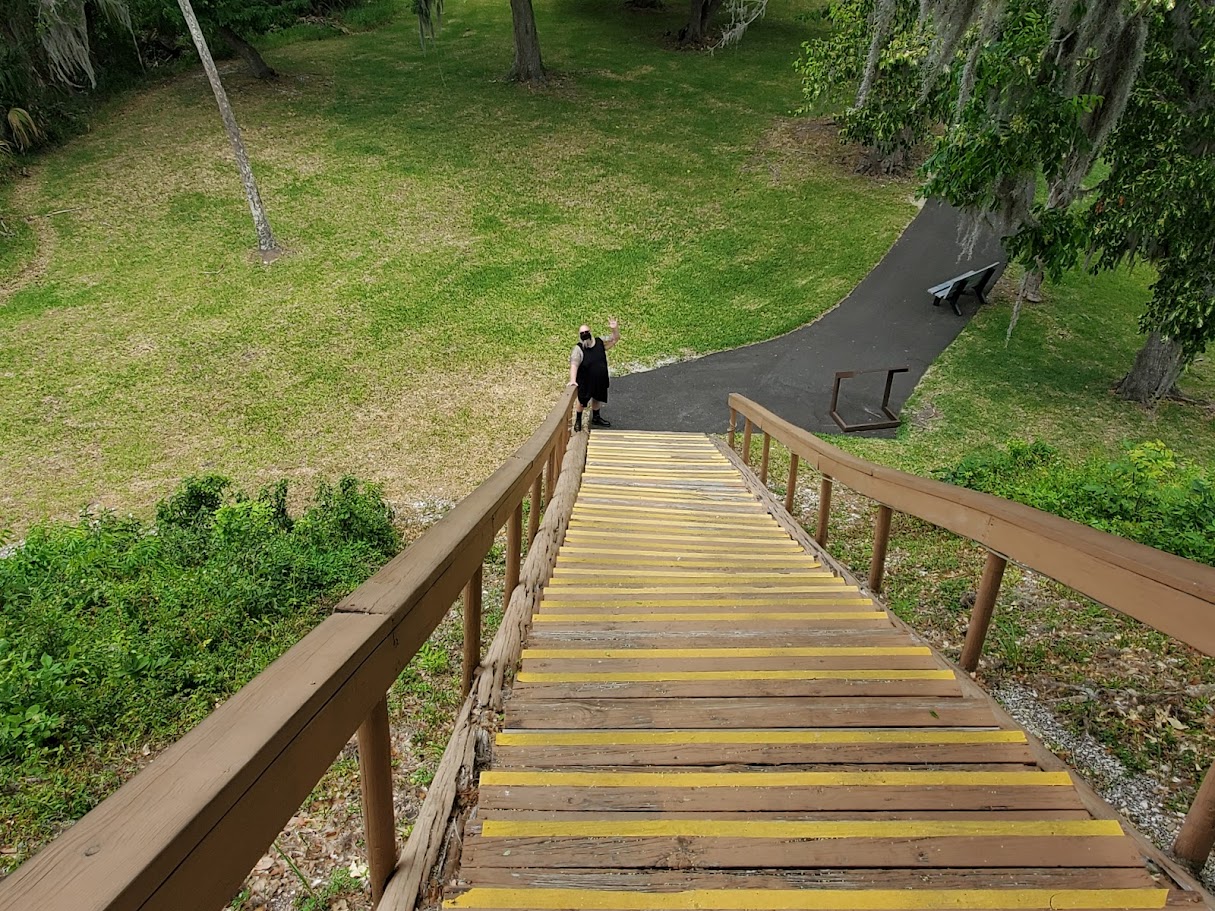
Crystal River Mounds site photo by Shayna Marie AtHope

Fort Walton Mound site photo by Damien Marie AtHope
Fort Walton Mound
“The Fort Walton Mound (8OK6) is an archaeological site located in present-day Fort Walton Beach, Florida, United States. The large platform mound was built about 850 CE by the Pensacola culture, a local form of the Mississippian culture. Because of its significance, the mound was designated a National Historic Landmark in 1964. Still reduced by time, the massive mound is still 12 feet (3.7 m) high and 223 feet (68 m) wide at the base. It was an expression of a complex culture, built by a hierarchical society whose leaders planned and organized the labor of many workers for such construction. The mound served combined ceremonial, political, and religious purposes. At the center of the village and its supporting agricultural lands, the mound served as the platform for the temple and residence of the chief. Successive leaders were buried in the mound, and additional layers were added over time. This is one of three surviving mound complexes in the panhandle, the others being Letchworth Mounds and Lake Jackson Mounds state parks.” ref
“The Fort Walton Mound was probably built around 800 CE, although Charles H. Fairbanks who excavated the mound in 1960 believed it was built between 1500 and 1650 based on pottery sherds he uncovered and analyzed. The mound served as the ceremonial and political center of their chiefdom and probably the residence of the chief. It was also the burial ground of the elites in the society. Archaeological evidence suggests that several buildings once stood on top of the mound, perhaps at different times throughout its use. These buildings were probably done in the typical wattle and daub construction common among Southeastern Native American groups. By sometime in the late 1600s the mound was abandoned by its original builders and lay dormant in use until the area was reinhabited by white settlers in the mid 19th century.” ref
“The Confederate soldiers established “Camp Walton” at the base of Fort Walton Mound in 1861 during the Civil War to guard Santa Rosa Sound and Choctawhatchee Bay. As with many of Florida’s mound structures, the Fort Walton Mound was first excavated by antiquarians and amateur archaeologists. The Walton Guard soldiers are the first recorded group to have excavated the mound. John Love McKinnon, an officer with the Walton Guards at the time, wrote a description of their excavation in his book “History of Walton County.” McKinnon noted that several human remains the soldiers unearthed were from large individuals and probably belonged to warriors, as indicated by damage they observed on the skulls, thighs, and arms bones consistent with hacking and blunt force trauma. He speculated that the area they dug into was once a charnel house. A couple decades after the Civil War, in 1883 S.T. Walker wrote a report about excavating the mound for the Smithsonian Institution. Walker surveyed several mounds in the Florida Panhandle and noted that many curiosity seekers had dug into the mound over the years. Walker noted that Dr. S.S. Forbes from Milton, Florida, had excavated the mound previously and discovered bones and several clay effigies which he later donated to the Smithsonian.” ref
“Clarence Bloomfield Moore also excavated the mound in 1901 and brought many before unseen ceramic vessels and burial items to light. In 1940, the highly respected archaeologists Gordon Willey and Richard Woodbury reexamined the Fort Walton Mound and other sites Moore had visited. Their work here was mentioned in Willey’s highly acclaimed work “Archaeology of the Florida Gulf Coast,” which he completed when he worked for the Bureau of American Ethnology Smithsonian Institution. By 1960, Dr. Charles Fairbanks, an archaeologist and professor at Florida State University, was contacted by the city, and he excavated the mound to determine the original size, shape, and construction method of the mound. Throughout the 1960s and 1970s, the Fort Walton Mound was excavated by members of the museum staff under the guidance of William and Yulee Lazarus.” ref
“In 1971-1973, with the help of Depauw University’s Robert J. Fornaro, the mound was excavated to locate post holes and recover ceramic material that might fit vessels found earlier. The last excavation of the Fort Walton Mound occurred in 1976 by then FSU graduate student Nina Thanz (Borremans). Thanz was tasked with making sure the reconstruction of a temple building being planned for the top of the mound would not disturb any human remains or artifacts during construction. She found several post holes from different structures built on top of the mound and evidence for a charnel house. Her findings of post holes became one source of the dimensions to the building structure that stands on the mound today. According to the first curator of the Indian Temple Mound Museum Yulee Lazarus the reconstruction of the temple building that currently stands on top of the mound was never intended on being a “replica,” but rather to “bolster the imagination and interpretation of the Indians’ use of the temple mound.” ref
“The mounds were built by the people of the Pensacola culture, a regional variation of the Mississippian culture. The Fort Walton culture was named for the site by archaeologist Gordon Willey, but later work in the area has led archaeologists to believe the Fort Walton site was actually built and used by people of the contemporaneous Pensacola culture. The peoples of the Fort Walton culture used mostly sand, grit, grog, or combinations of these materials as tempering agents in their pottery, whereas the Pensacola culture peoples used the more typical Mississippian culture shell tempering for their pottery. The site was abandoned by 1500 CE but the exact reason for the abandonment is unknown. It has been speculated that this was due to the arrival of European settlers, but this statement is unproven because the sites were already found abandoned by Spanish explorers years before.” ref
“The people are recognized as being one of the most successful pre-Columbian cultures in regards to agriculture. A number of crops were successful including corn, beans, and squash. The mound itself appears in a common architectural fashion for the period with features such as a pyramidal base with a truncated top. The flat top was used for ceremonies, temples, and residences for high-ranking officials. The city-owned and operated Indian Temple Mound Museum features pre-Columbian artifacts found on site and from other locations, as well as a variety of exhibits on later Native American and Floridian history including artifacts from the European Explorers, local pirates and early settlers. The address is 139 Miracle Strip Pkwy SE, near the intersection of State Road 85 and U.S. Route 98, in the Florida Panhandle. The museum was first opened in 1962 and the current location was opened in 1972.” ref
“The Camp Walton Schoolhouse Museum was the original one-room schoolhouse built in 1911. It opened for use for the community children from 1912 to 1936. Opened in 1976, the museum features early-20th-century desks and education items. The Garnier Post Office Museum is an original small rural post office that displays the postal history of Camp Walton and Fort Walton with emphasis from 1900 to the 1950s. The site also served as a voting location. The museum opened in 1988. Opened in 2010, the Civil War Exhibits Building features displays about Florida’s history during the American Civil War.” ref

Pensacola culture
“The Pensacola culture was a regional variation of the Mississippian culture along the Gulf Coast of the United States that lasted from 1100 to 1700 CE. The archaeological culture covers an area stretching from a transitional Pensacola/Fort Walton culture zone at Choctawhatchee Bay in Florida to the eastern side of the Mississippi River Delta near Biloxi, Mississippi, with the majority of its sites located along Mobile Bay in the Mobile-Tensaw River Delta. Sites for the culture stretched inland, north into the southern Tombigee and Alabama River valleys, as far as the vicinity of Selma, Alabama.” ref
“Both the Pensacola culture and the nearby Fort Walton culture were a mixture of the Late Woodland period Weeden Island culture that preceded them in the area and an influx of Mississippian culture peoples from further north. Originally Pensacola and Fort Walton had been classified together under the Pensacola name by archaeologists, named for a group of sites located around Pensacola Bay and Choctawhatchee Bay, the approximate geographic center of their combined areas. However further study of their differing ceramic technologies over the years has led archaeologists to reclassify them as two separate cultures. Further archaeological research has also determined that the Bottle Creek site (the largest Pensacola culture site, which is located north of Mobile Bay) was the actual center for the culture and that there are more Pensacola sites in that area and around Perdido Bay than in the Pensacola area.” ref
“The peoples of the Early Pensacola culture were closely tied to the people of the Moundville polity located upstream from them and were possibly the result of colonization from the Moundville area. They used the more typical Mississippian culture shell tempering for their pottery. Whereas the Fort Walton peoples, whose largest site was Lake Jackson Mounds in Tallahassee, were more closely tied to and influenced by the Etowah polity of northern Georgia and like them used mostly sand, grit, grog, or combinations of these materials as tempering agents in their pottery. The early ceramics of Pensacola culture also show that they had significant contact with Plaquemine Mississippian culture peoples from the Lower Mississippi Valley. Archaeological research at the Bottle Creek site has shown that the people of the Pensacola culture may have moved into this geographical area from the north and west, but by the fourteenth century they had developed their own distinctive ceramics style and their own unique settlement pattern.” ref
“Unlike their Fort Walton neighbors to the east, Pensacola peoples relied more on the use of coastal resources than on maize agriculture. The settlement pattern of the Pensacola culture area suggests that the area was a series of minor chiefdoms with their own local centers such as Fort Walton Mound with one large paramount chiefdom located at the Bottle Creek site. The site is the largest on the Gulf Coast and with 18 mounds is comparable in scale to Moundville and the Plaquemine Mississippian Holly Bluff site in western Mississippi. By 1250 CE, Pensacola peoples had begun trading with Coastal Coles Creek culture peoples in southeastern Louisiana. Their style of pottery was found to be influential on peoples in this area, with many examples as well as local derivatives found at the Sims site in Saint Charles Parish, Louisiana.” ref
“Archaeological excavations at the Bottle Creek site have shown that it had continued to be inhabited during the time of European contact from the sixteenth to the early eighteenth century, although it is still uncertain which historic groups these people may be. The Pensacola culture peoples first contact with Europeans may have been with the Narváez expedition in 1528. Cabeza de Vaca reported that the Native Americans they encountered in the vicinity of what is now Pensacola Bay were of “large stature and well formed,” and lived in permanent houses. The chief wore a robe of what de Vaca called “civet-marten”, “the best [skins], I think, that can be found.” After initially appearing to be friendly, they attacked the Spaniards without warning during the night.” ref
“In 1539, Diego Maldonado, exploring the northern coast of the Gulf of Mexico under orders from Hernando de Soto, found Pensacola Bay (which the Spanish called the Bay of Achuse, Achusi, Ochuse or Ochus). Maldonado found a village on the bay, where he seized one or two of the inhabitants, along with a “good blanket of sables.” De Soto ordered Maldonado to meet him at the Bay of Achuse the next summer with supplies for his expedition. Maldonado returned three years in succession, but de Soto never appeared. It is possible that the Pensacola culture peoples were connected to or were the central Alabama Mabilians disastrously encountered by de Soto in 1540. The next mention of the Mabilians is in 1674 by Bishop Gabriel Diaz Vara Calderon, who places them on an island in west Florida, possibly the swampy high ground of Mound Island where the Bottle Creek site is located or Dauphin Island. Later historic Mabilian villages are closer geographically to Bottle Creek, and the nearby city of Mobile, Alabama was named for them.” ref
“In 1559, Tristán de Luna y Arellano led a Spanish expedition to establish the colony of Ochuse on Pensacola Bay, then known as the Bay of Ichuse (also spelled Ychuse), but the endeavor ended up being short-lived. The Spanish had planned to rely on the local peoples for food supplies, but they found the area almost deserted and only a few people living in fishing camps around the bay. By the early eighteenth century the Pensacola people, a Muskogean speaking group associated with the Fort Walton culture Apalachee Province, were living in the western part of what is now the Florida Panhandle and are the source of the name for Pensacola Bay, the city of Pensacola and later the Pensacola culture. They inhabited the area until the mid-eighteenth century, but by 1764 they had been assimilated into various Choctaw or Creek bands that had moved into the area or westward with the Biloxi to merge with the Tunica as part of the Tunica-Biloxi.” ref

Fort Walton Mound site photo by Shayna Marie AtHope
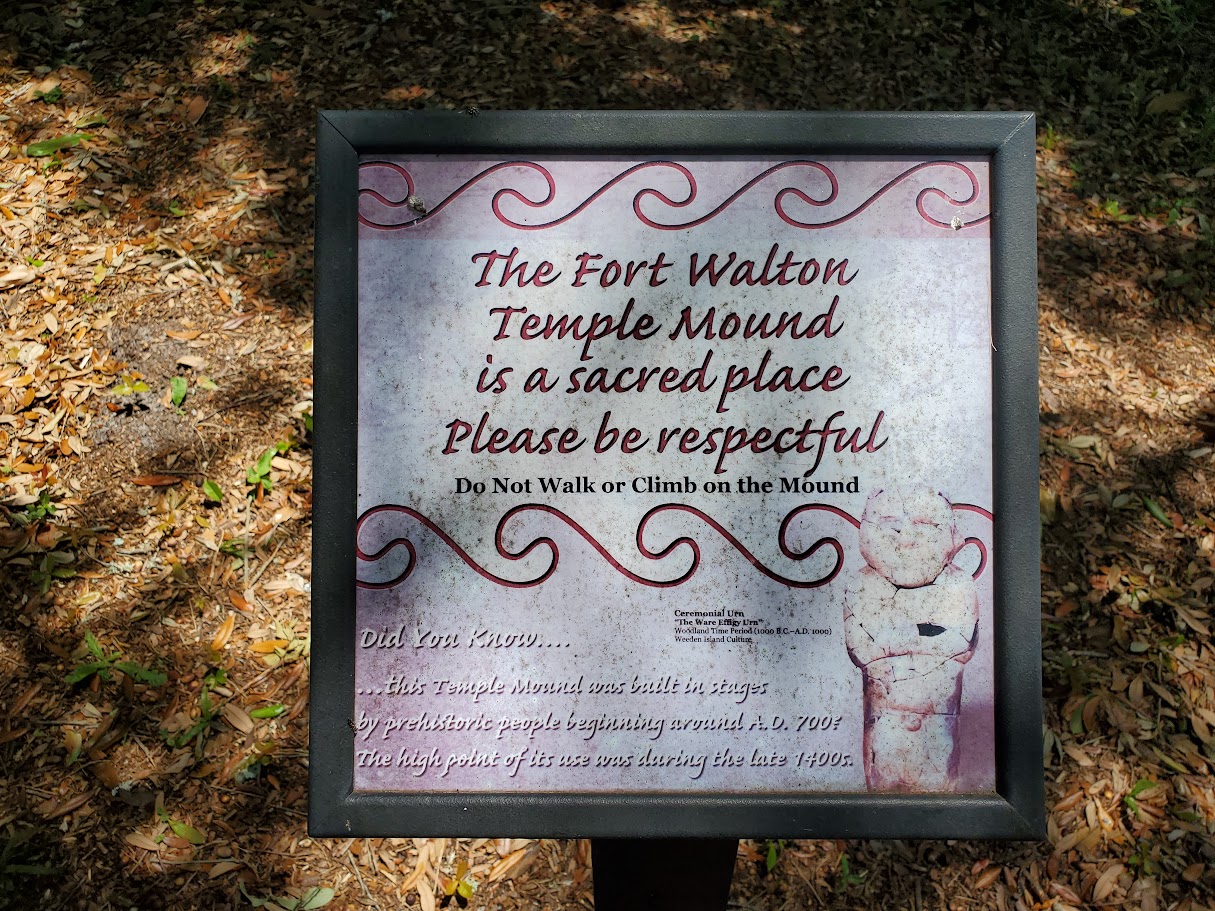
Fort Walton Mound site photo by Damien Marie AtHope
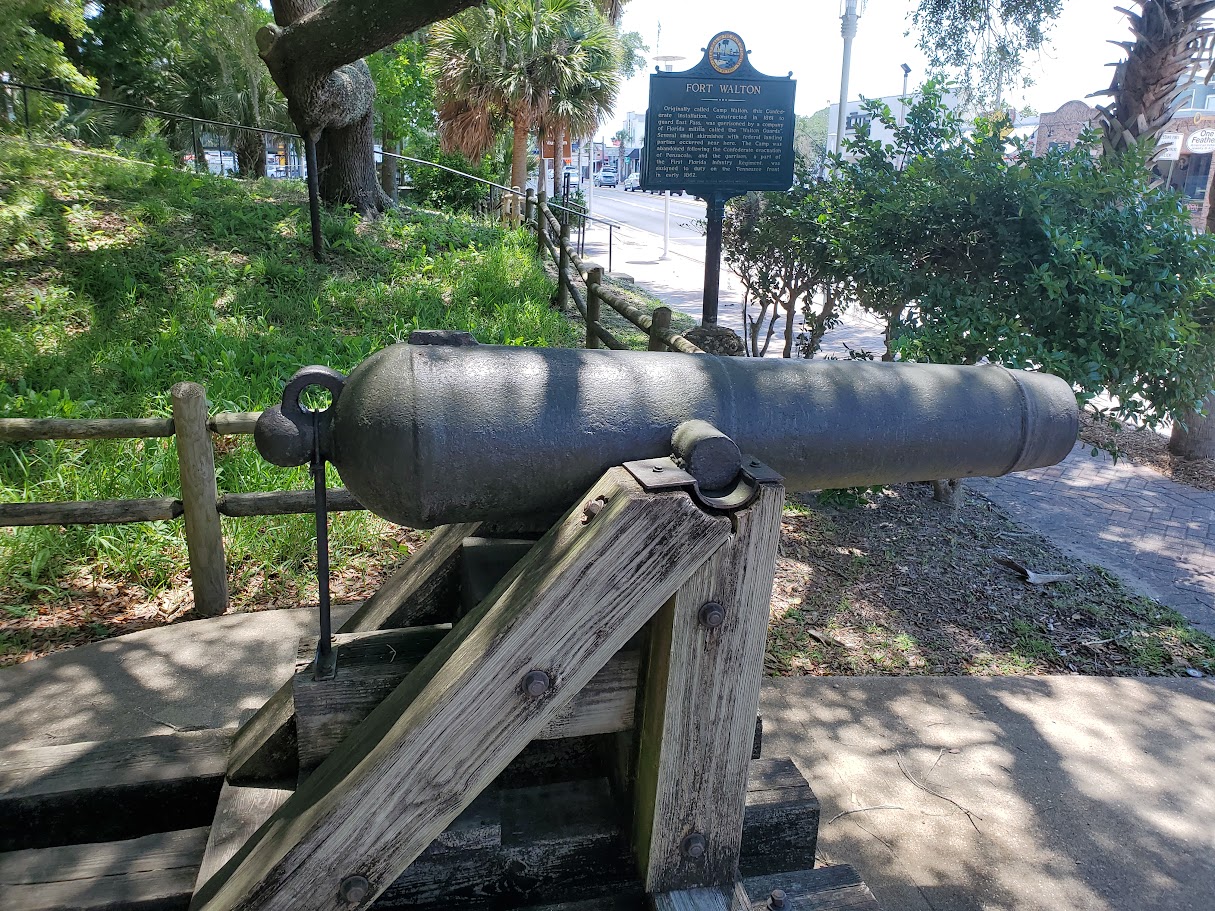
Fort Walton Mound site photo by Damien Marie AtHope

Fort Walton Mound site photo by Damien Marie AtHope

Fort Walton Mound site photo by Damien Marie AtHope

Fort Walton Mound site photo by Damien Marie AtHope

Fort Walton Mound site photo by Shayna Marie AtHope

Fort Walton Mound site photo by Damien Marie AtHope
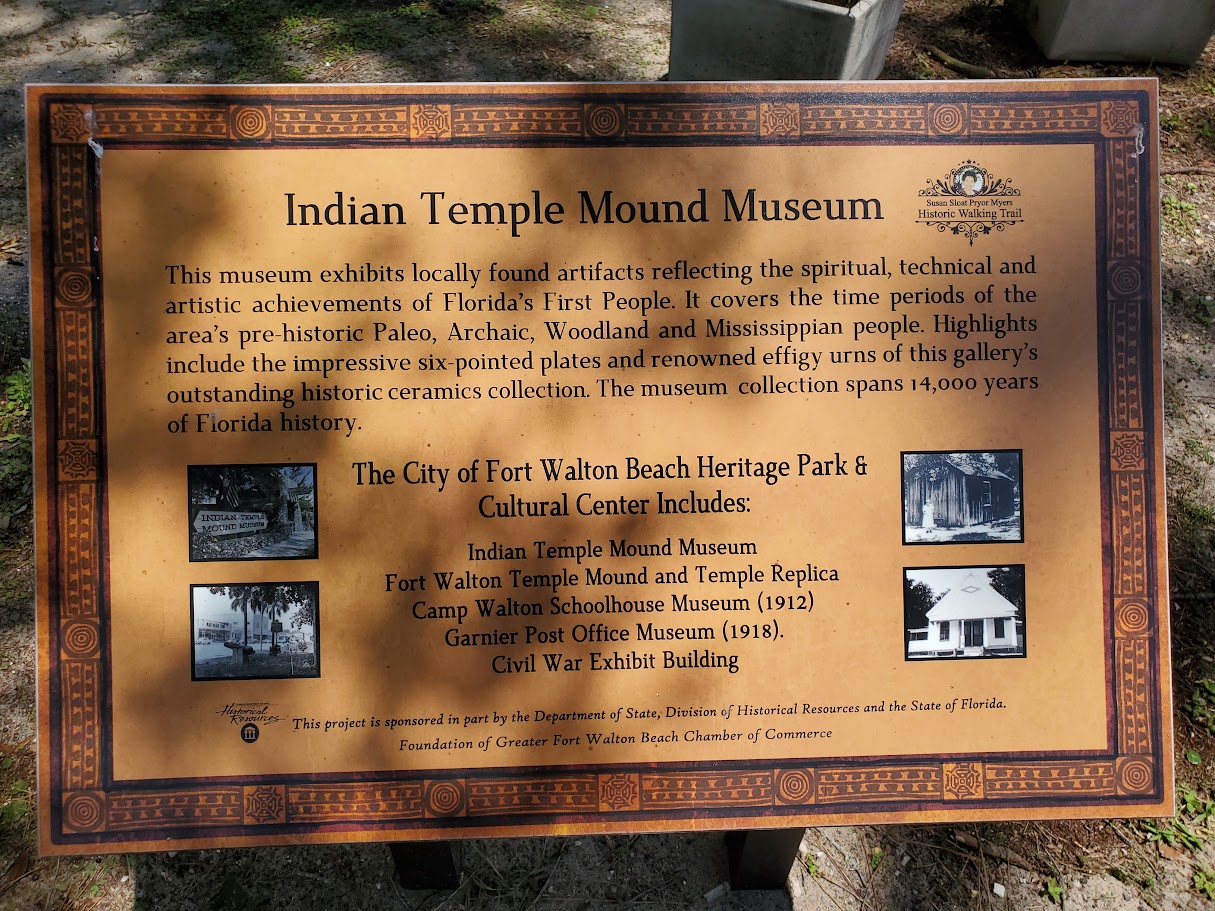
Fort Walton Mound site photo by Damien Marie AtHope
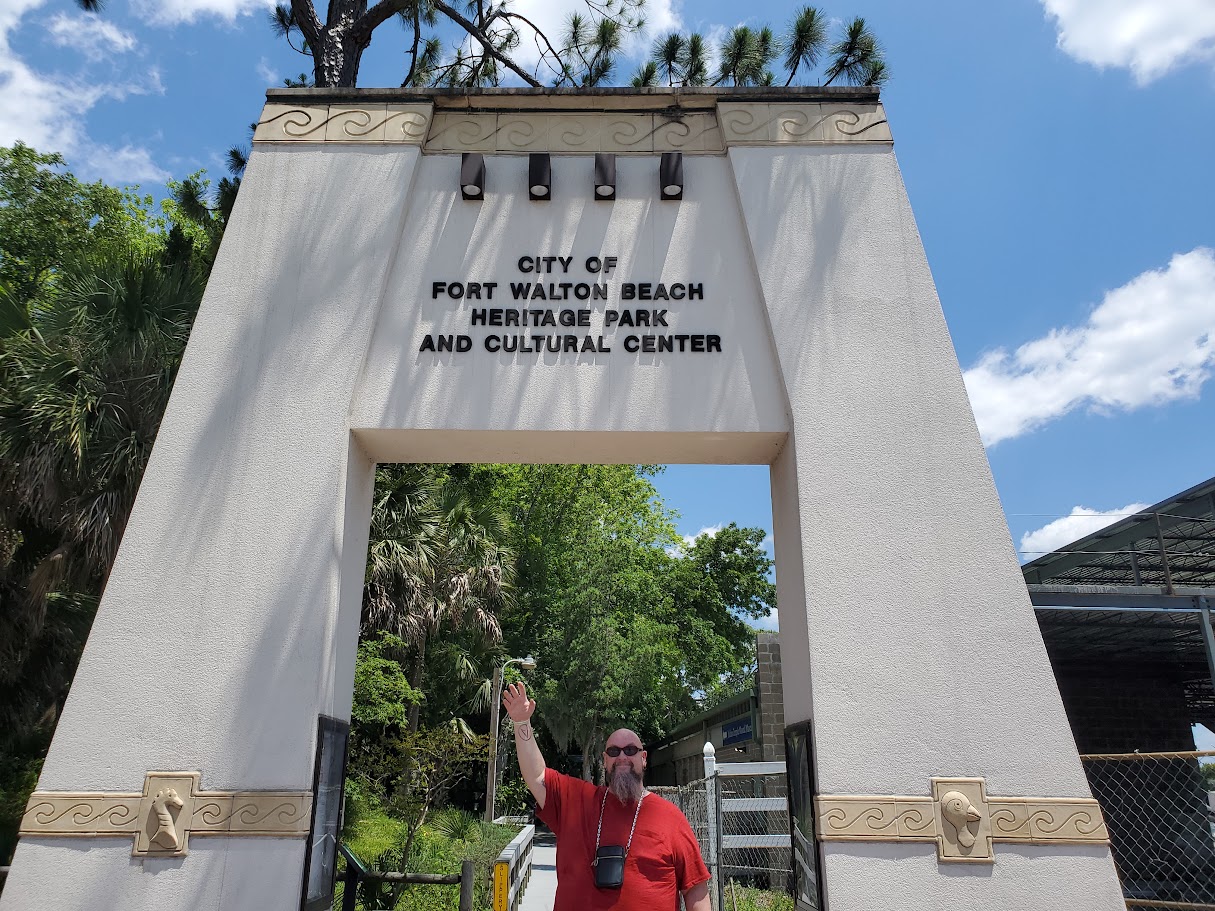
Fort Walton Mound site photo by Shayna Marie AtHope
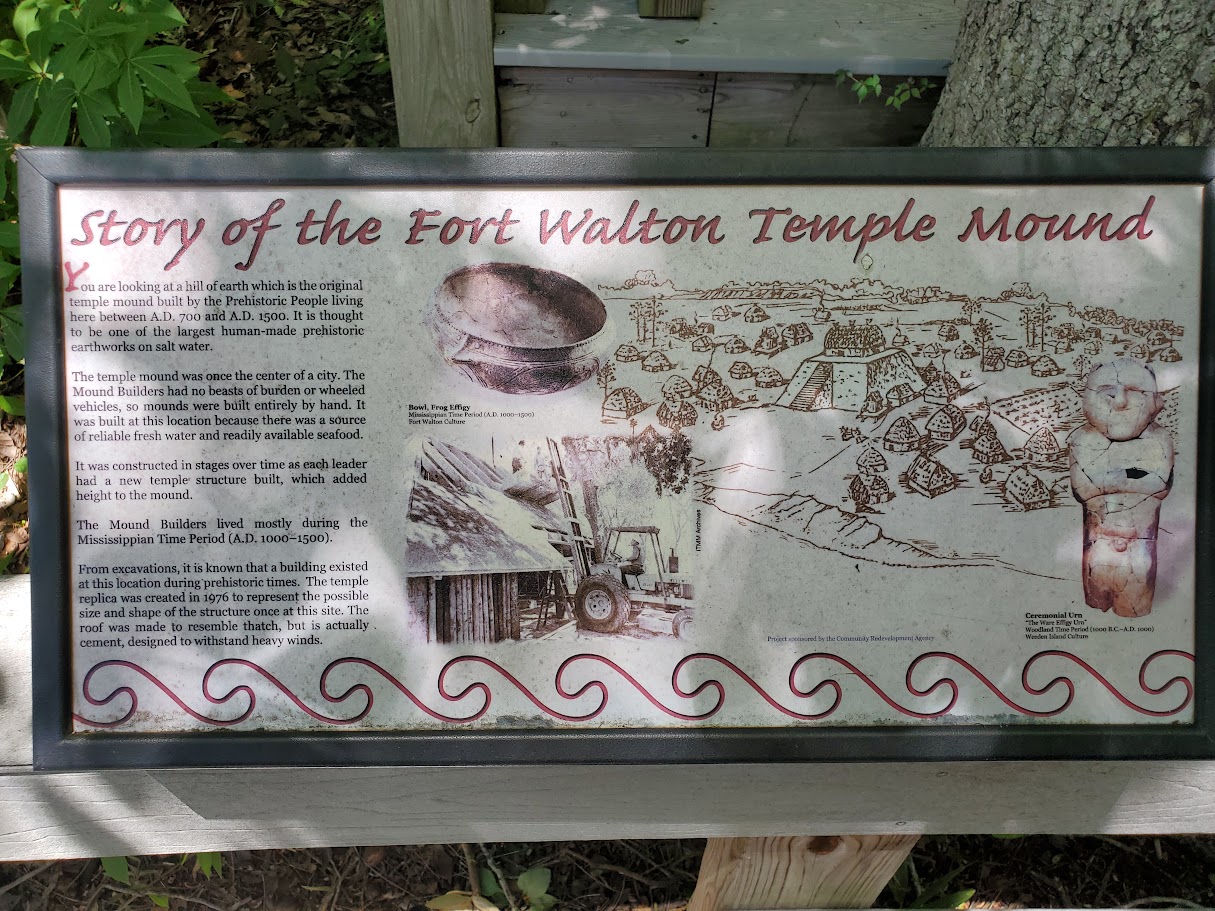
Fort Walton Mound site photo by Damien Marie AtHope
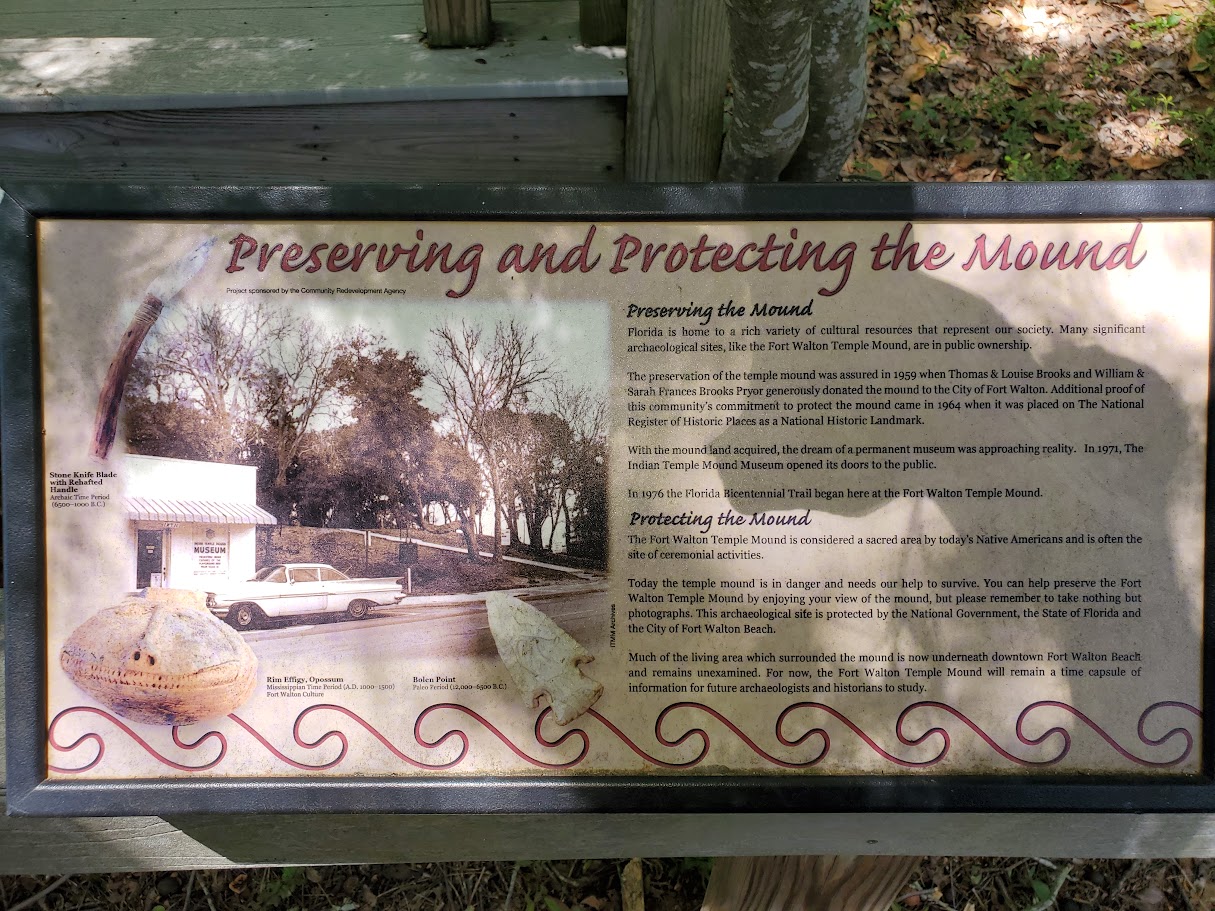
Fort Walton Mound site photo by Damien Marie AtHope
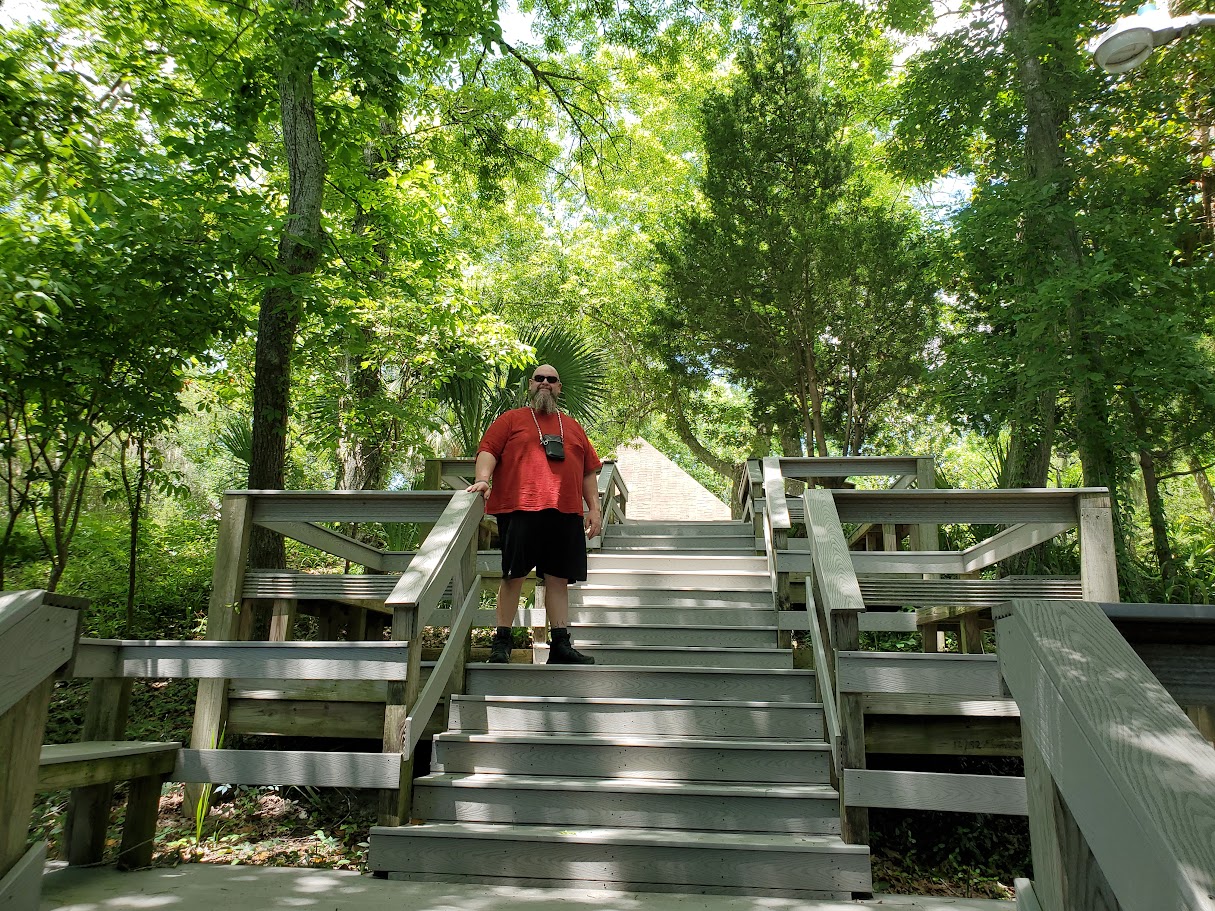
Fort Walton Mound site photo by Shayna Marie AtHope
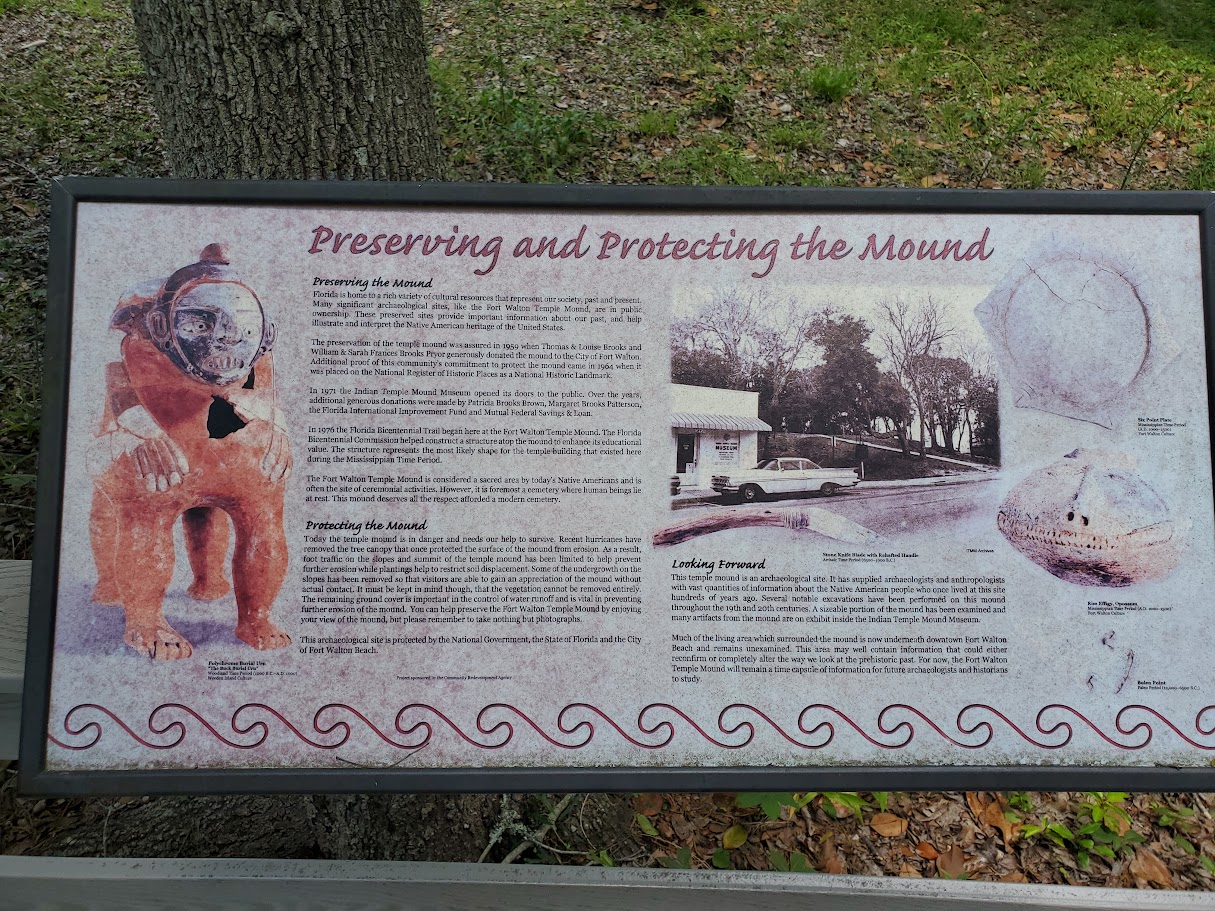
Fort Walton Mound site photo by Damien Marie AtHope

Fort Walton Mound site photo by Damien Marie AtHope
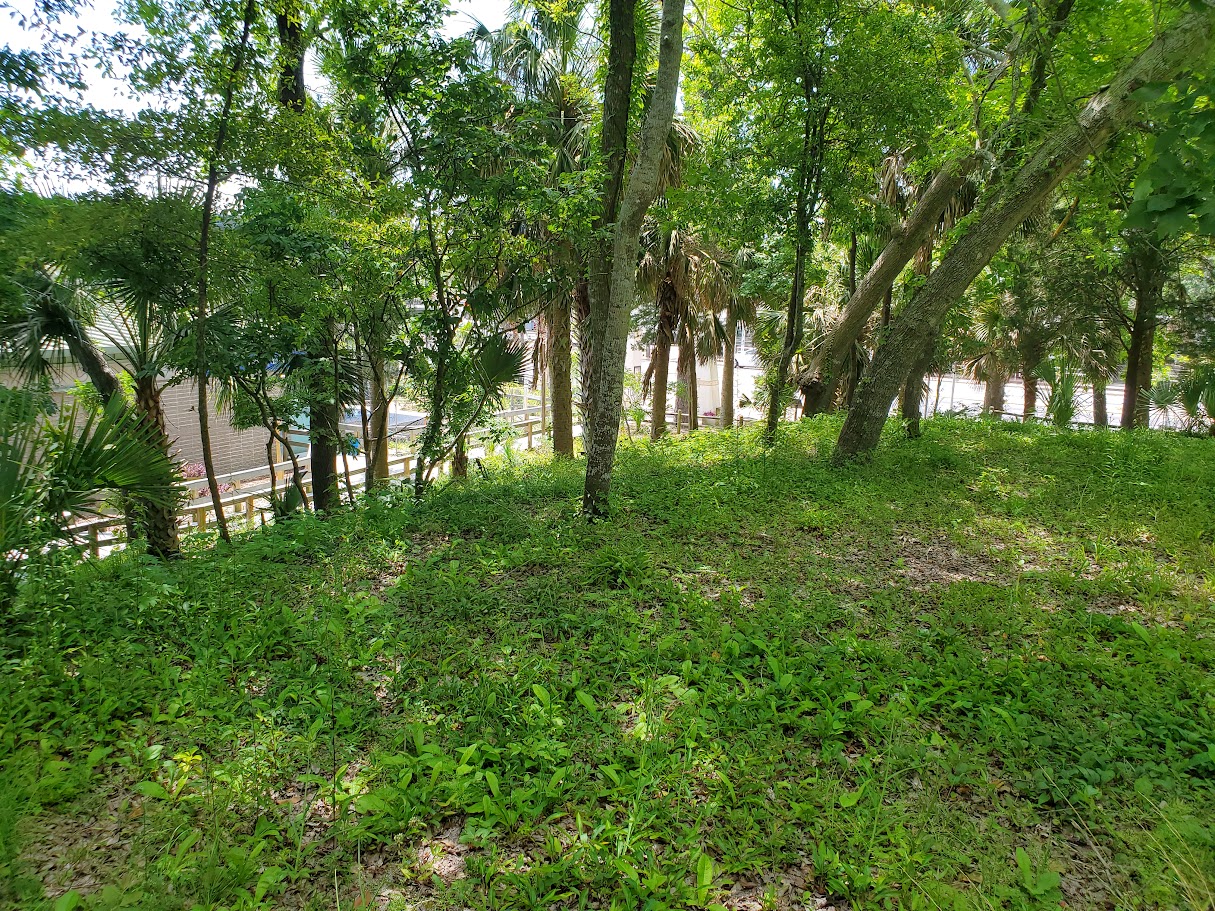
Fort Walton Mound site photo by Damien Marie AtHope
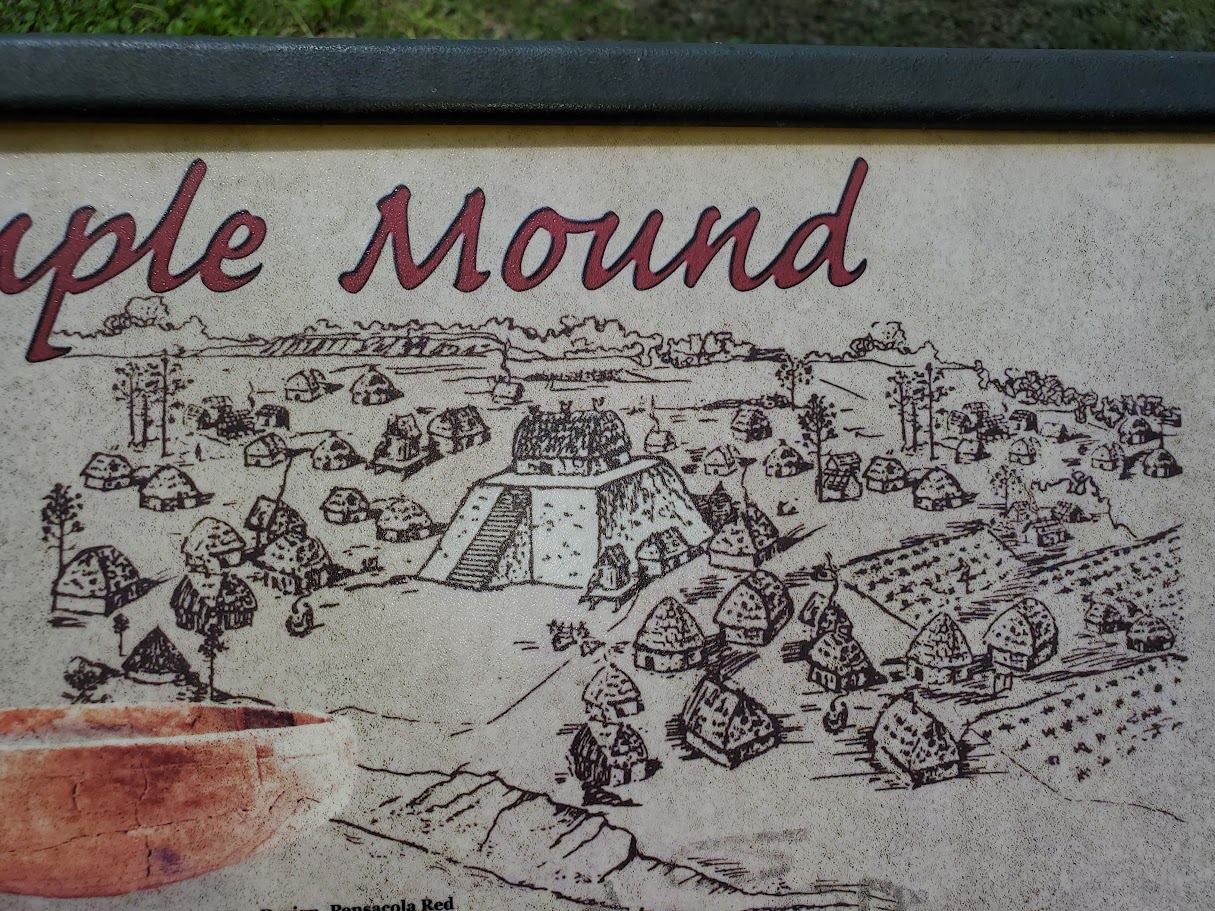
Fort Walton Mound site photo by Damien Marie AtHope

Fort Walton Mound site photo by Damien Marie AtHope
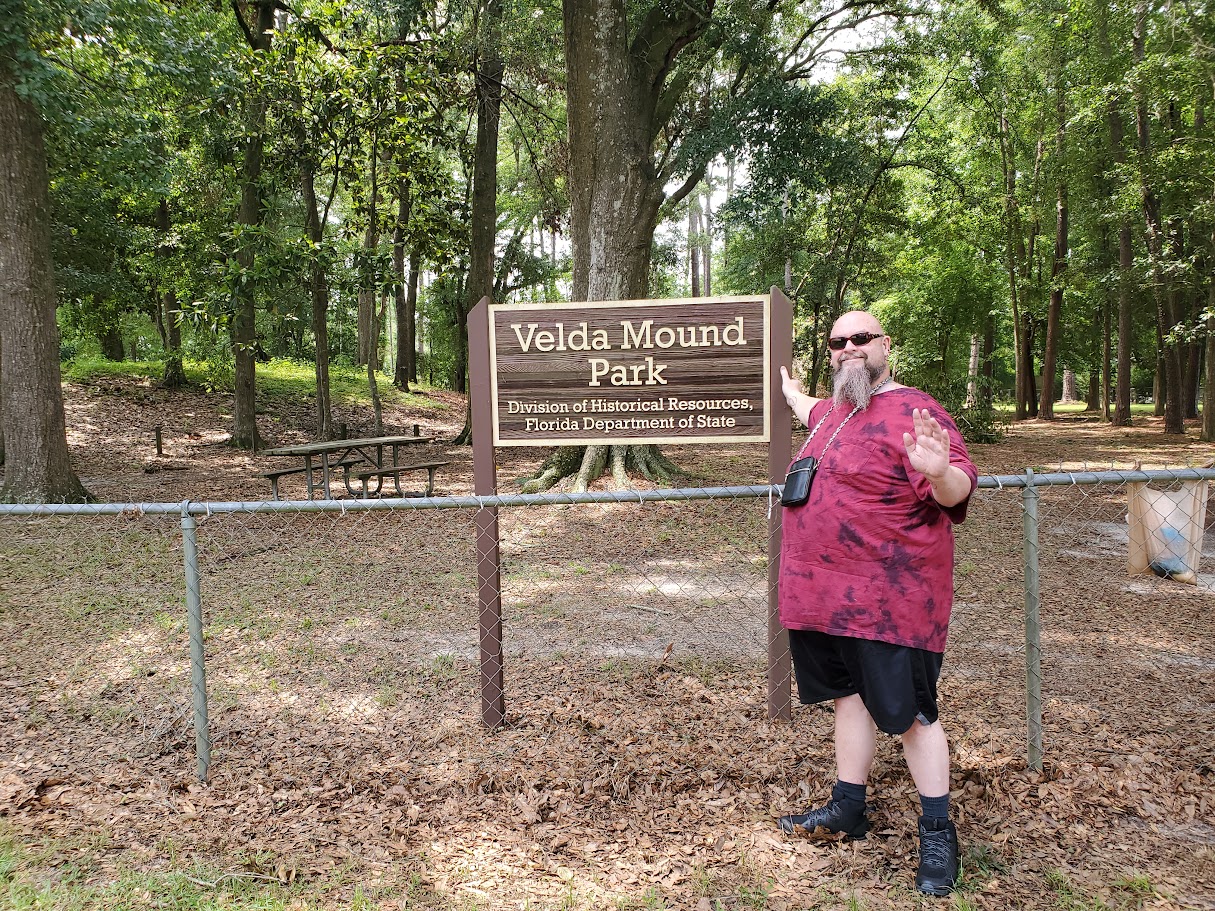
Velda Mound site photo by Shayna Marie AtHope
Velda Mound
“Velda Mound (8LE44) is a Native American archaeological site located in northern Tallahassee, Leon County, Florida, United States. The site was first occupied by peoples of the Fort Walton Culture (a regional variation of the Mississippian culture) in the late prehistoric period and during the protohistoric period was part of the extensive Apalachee Province of the panhandle. The site is now owned by the State of Florida and managed as a park.” ref
“Velda Mound was built in approximately 1450 by Fort Walton peoples and occupied by their descendants the Apalachee until about 1625. The Spanish explorers called this area Apalachee Province in recognition of the tribe’s power, a territory which also included the Lake Jackson Mounds and the major center of Anhaica. The platform mound is believed to have served as a residence for a village leader, with a village surrounding the mound. The village inhabitants cultivated vegetables in small family plots and farmed large communal farming fields in the area around the village. They cultivated numerous varieties of maize, beans, and squash.” ref
“Velda Mound was abandoned by indigenous peoples by the beginning of the Spanish Mission Period (ca. 1565). This was most likely the result of their depleting nearby natural resources, such as trees for building homes and for firewood. The soil may have become depleted as well. The people would move to new lands which were more fertile, and allow older areas to recover. No evidence exists showing the occupation of the mound by the later Spanish or British colonists.” ref
“In March 1922, a Florida State College for Women instructor, Emma Boyd, was killed when a portion of the mound collapsed while she and her friends were excavating it. During the 1950s, the area around the mound was part of the pastures used by the large Velda Dairy operation. During this era, looters continued digging into the mound to search for artifacts, which damaged the mound and altered its structure. The dairy property was later sold for redevelopment as the Arbor Hill residential subdivision. The mound has since been repaired and is now owned by the State of Florida.” ref
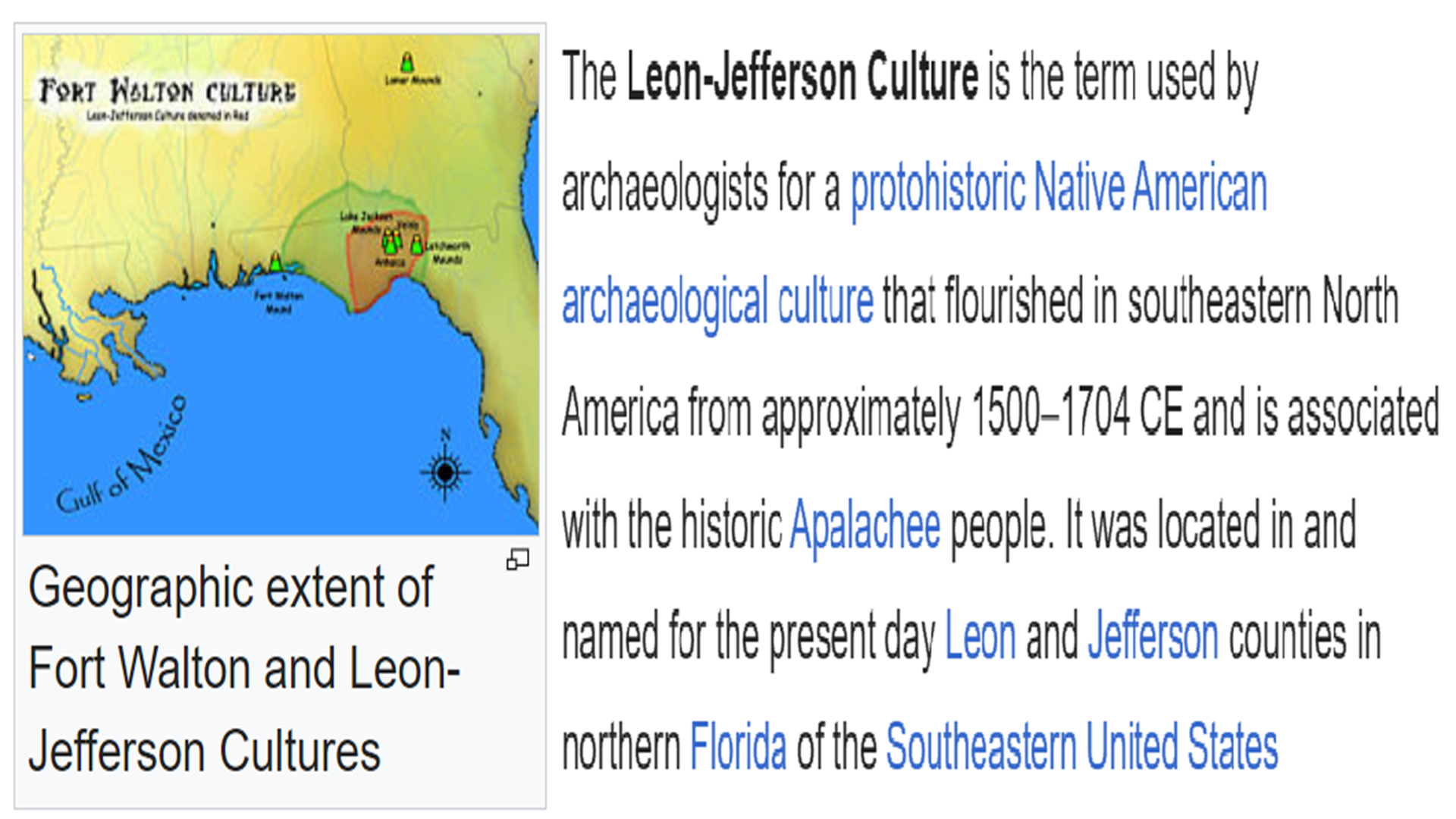
Leon-Jefferson culture
“The Leon-Jefferson Culture is the term used by archaeologists for a protohistoric Native American archaeological culture that flourished in southeastern North America from approximately 1500–1704 CE and is associated with the historic Apalachee people. It was located in and named for the present day Leon and Jefferson counties in northern Florida of the Southeastern United States. The cultural transformation from Late Fort Walton to Early Leon-Jefferson may have been brought about through contact with Lamar phase peoples from central Georgia. During this time period ceramic traditions change and styles of decoration and manufacture from central Georgia became incorporated into the local traditions associated with the Fort Walton culture.” ref
“This period also represents the transformation of the Apalachee peoples of the Fort Walton tradition and the collapse of the chiefdom as aboriginal populations declined following contact with European explorers and colonizers. Early in the period larger settlements appear, possibly because of the influx of Lamar peoples, although they are still located in typical Fort Walton locations such as near ridge and hilltops and around water sources such as ponds and lakes. Later in the period populations begin to drop, most likely in response to the introduction of diseases introduced by Europeans such as the Hernando de Soto entrada which passed through the area in 1539. By the time of the Spanish Mission Period the villages are smaller and located around mission churches.” ref
“Early in the Leon-Jefferson period ceramics are well-made vessels, using grit tempering rather than the more common Mississippian culture trait of using ground mussel shells. About 1450 CE distinctive central Georgian stamped and incised pottery begins to appear in the Apalachee area, probably representing trade or alliances with the powerful centers of central Georgia, centered on the Lamar Mounds and Village Site (now part of the Ocmulgee National Monument). By around 1600 local potters are making Lamar Phase styled vessels but continuing to use their own clay and/or grog as a tempering agent. The most common shapes for ceramic vessels at this time were bowls with outward flaring rims, very similar to Lamar style wares. As this period progresses the quality and craftmanship of ceramics deteriorates.” ref
“Like other Mississippian peoples, Leon-Jefferson peoples had hierarchical settlement patterns, built ceremonial platform mounds and practiced intensive maize agriculture. Anhaica, near Tallahassee’s city center, served as the capital of Apalachee Province and the Lake Jackson site 3 miles to the north was a Fort Walton period site and a major site associated with the Southeastern Ceremonial Complex. The northwest Florida region also encompasses the Letchworth Mounds of Jefferson County as well as Tallahassee’s Lake Jackson mound. It is generally defined as encompassing the Florida Panhandle east from the Ochlockonee River to the Aucilla River. Frequently, there are cultural differences between the inland groups who relied on the inland resources of what are now Leon and Jefferson counties and those who used coastal resources.” ref
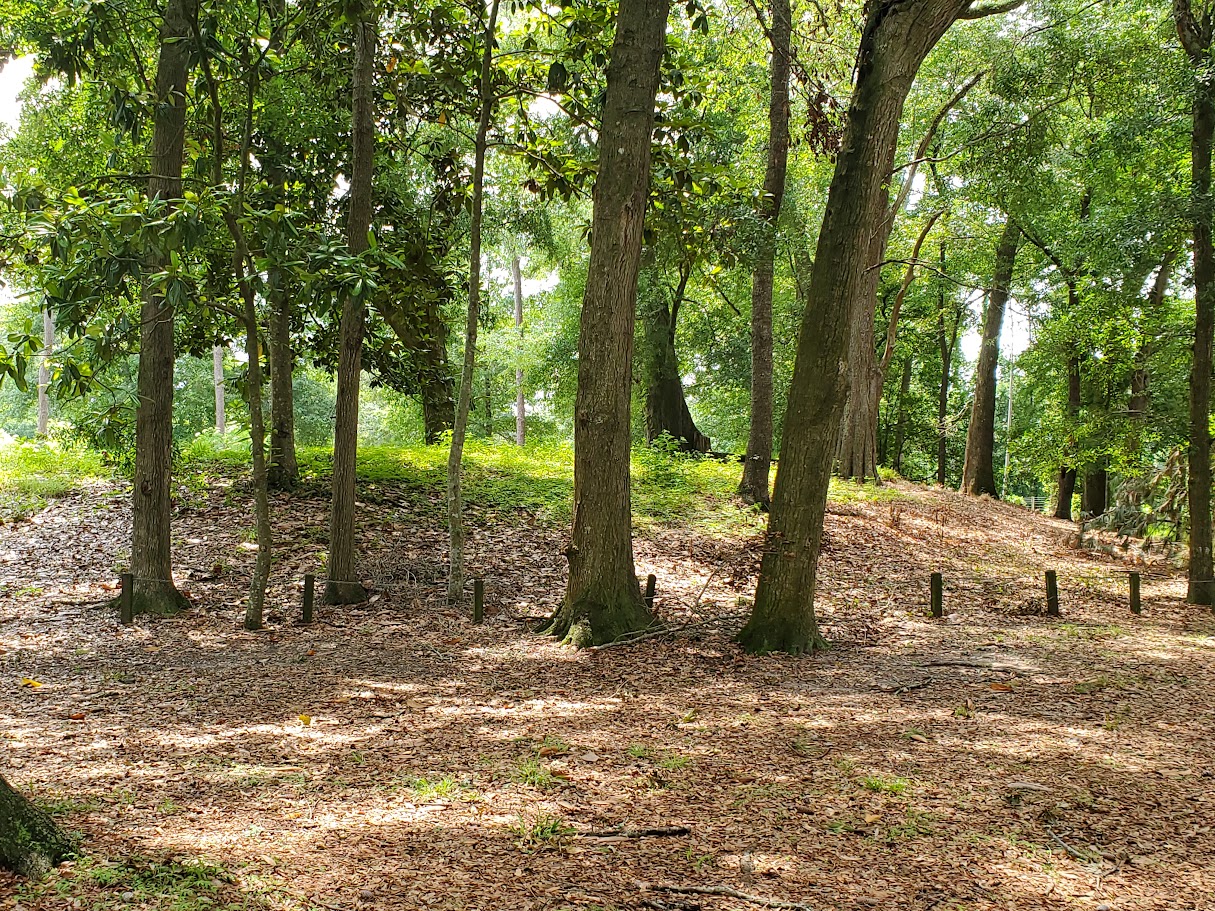
Velda Mound site photo by Damien Marie AtHope

Velda Mound site photo by Damien Marie AtHope

Velda Mound site photo by Damien Marie AtHope

Velda Mound site photo by Damien Marie AtHope
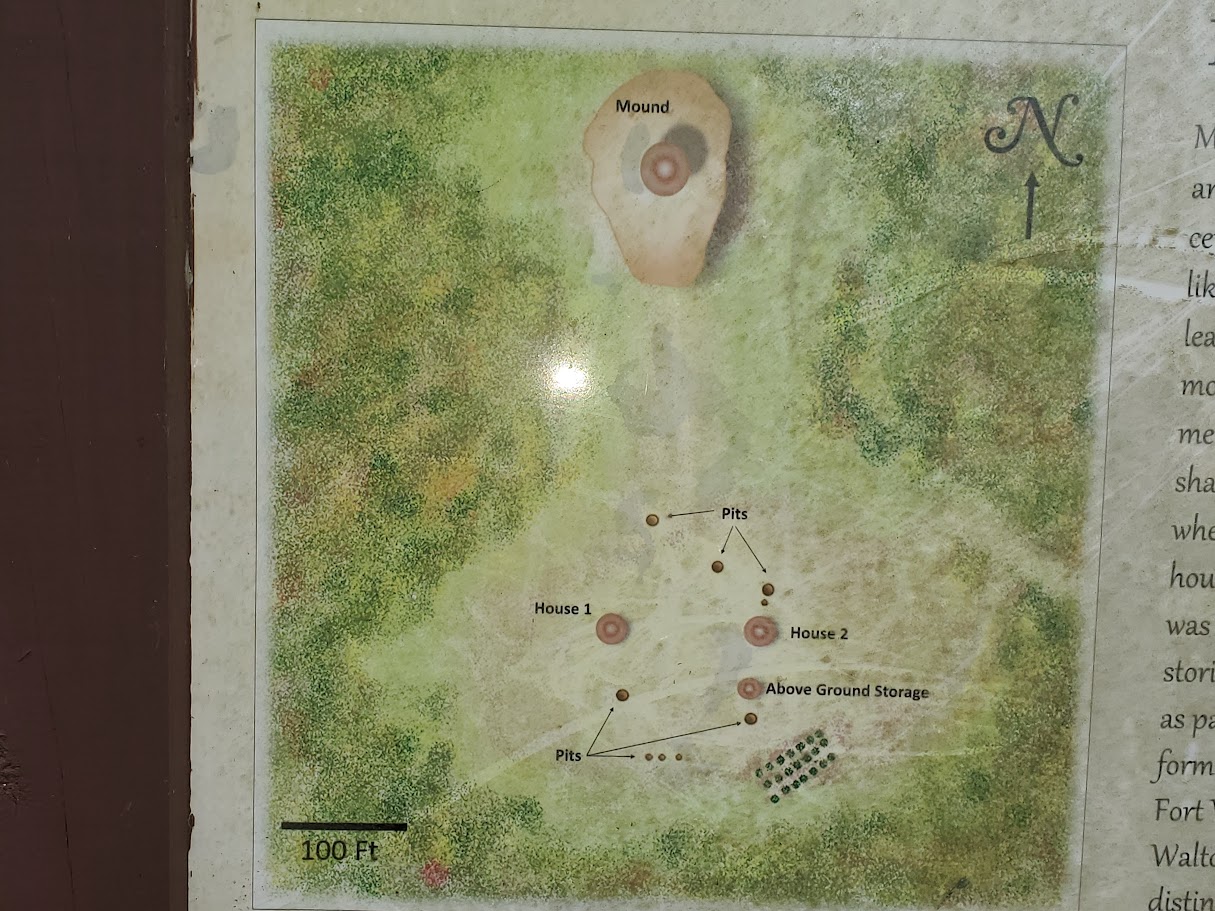
Velda Mound site photo by Damien Marie AtHope
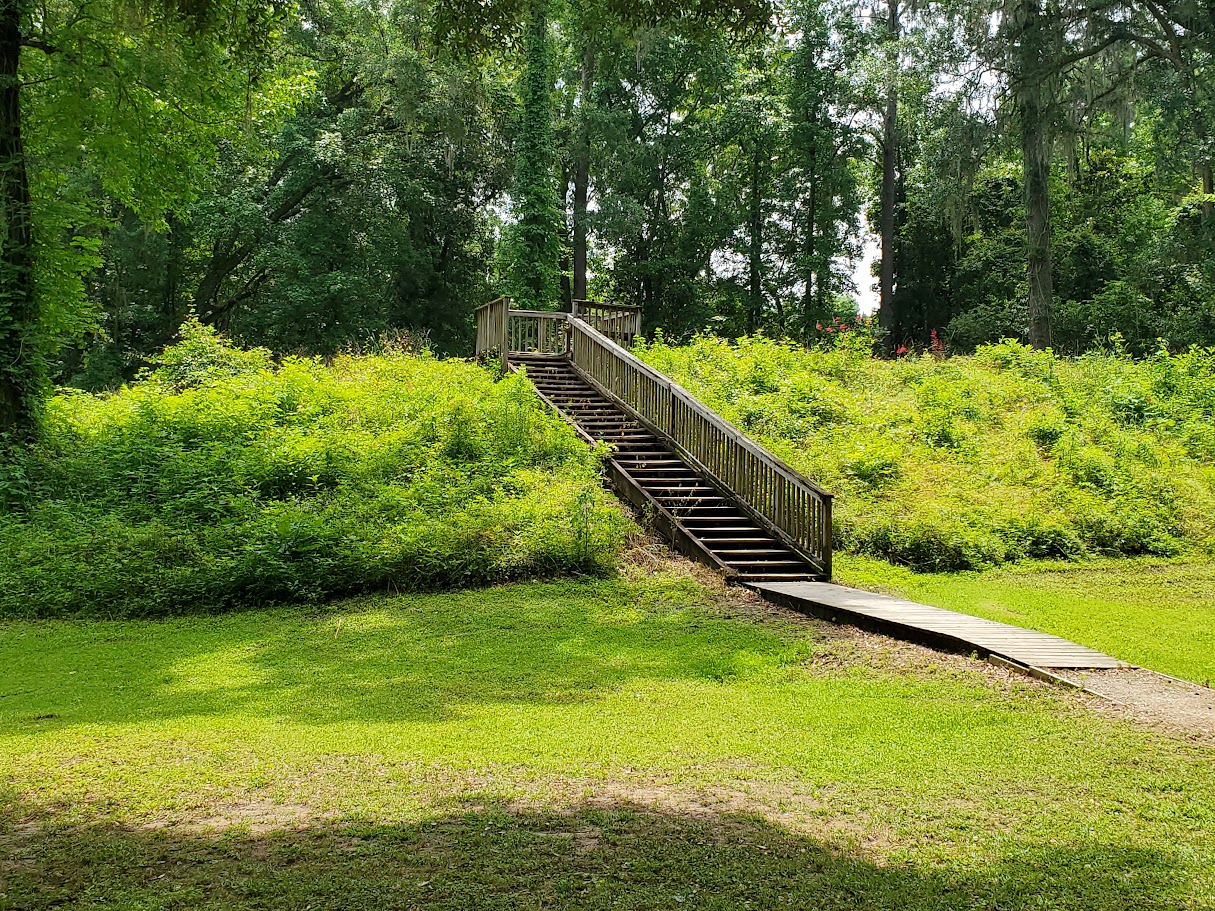
Velda Mound site photo by Damien Marie AtHope
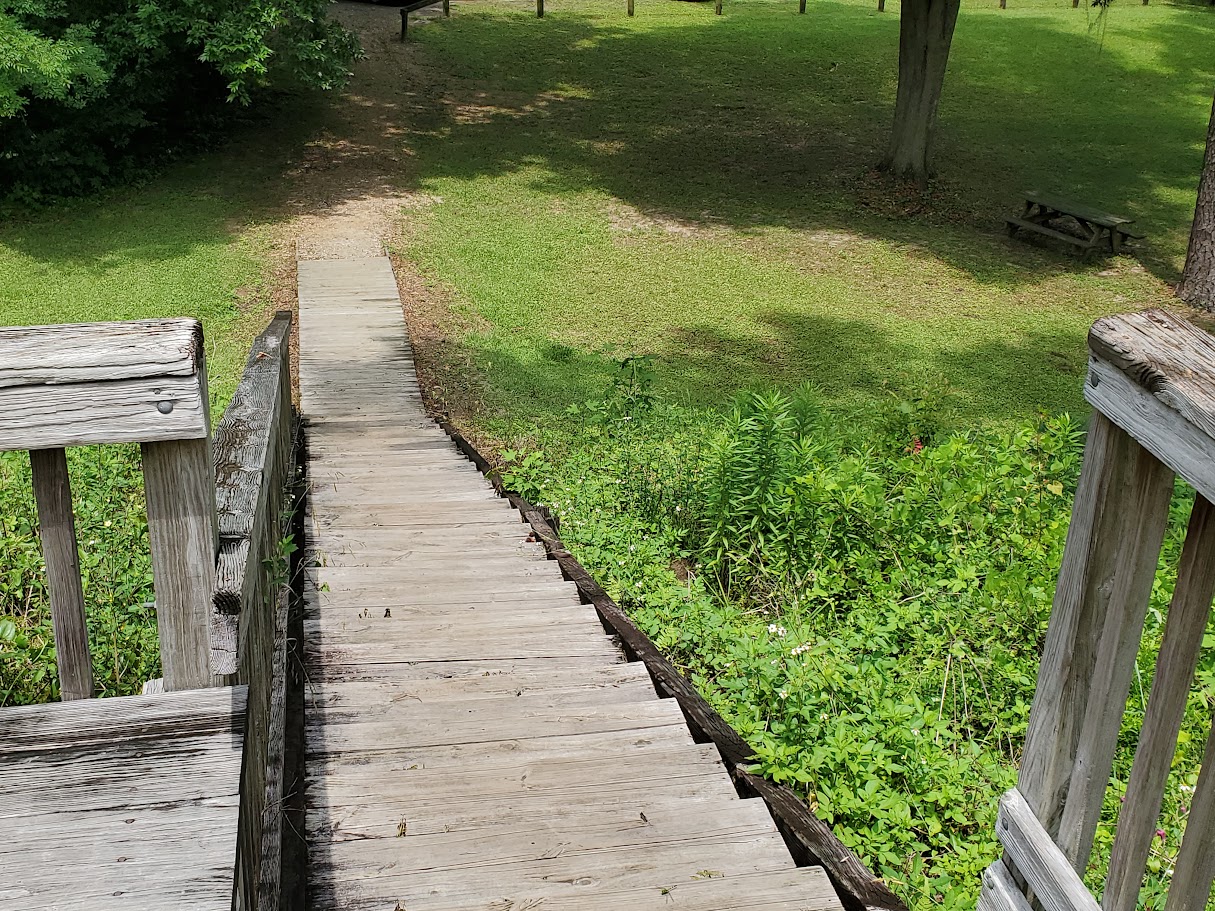
Velda Mound site photo by Damien Marie AtHope

Velda Mound site photo by Damien Marie AtHope

Velda Mound site photo by Damien Marie AtHope
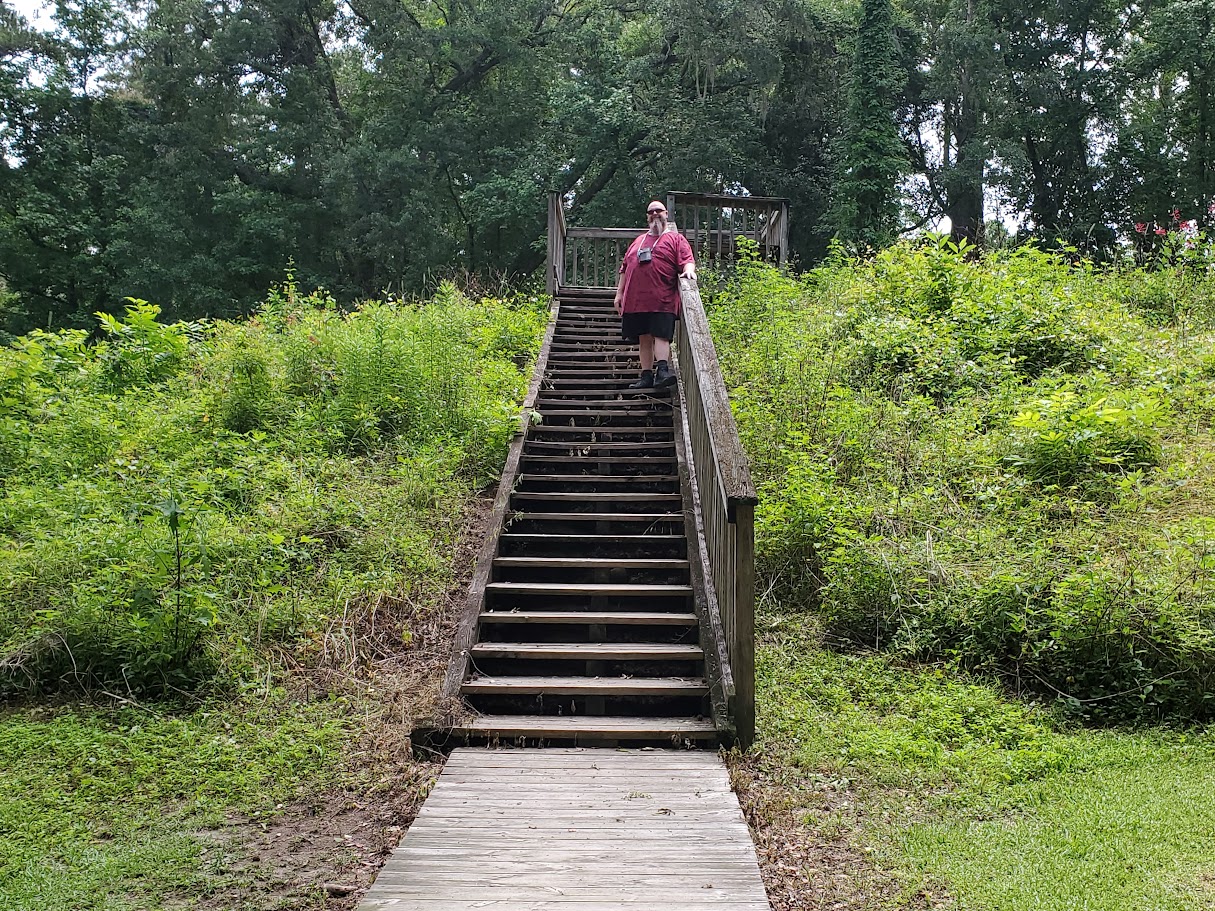
Velda Mound site photo by Shayna Marie AtHope
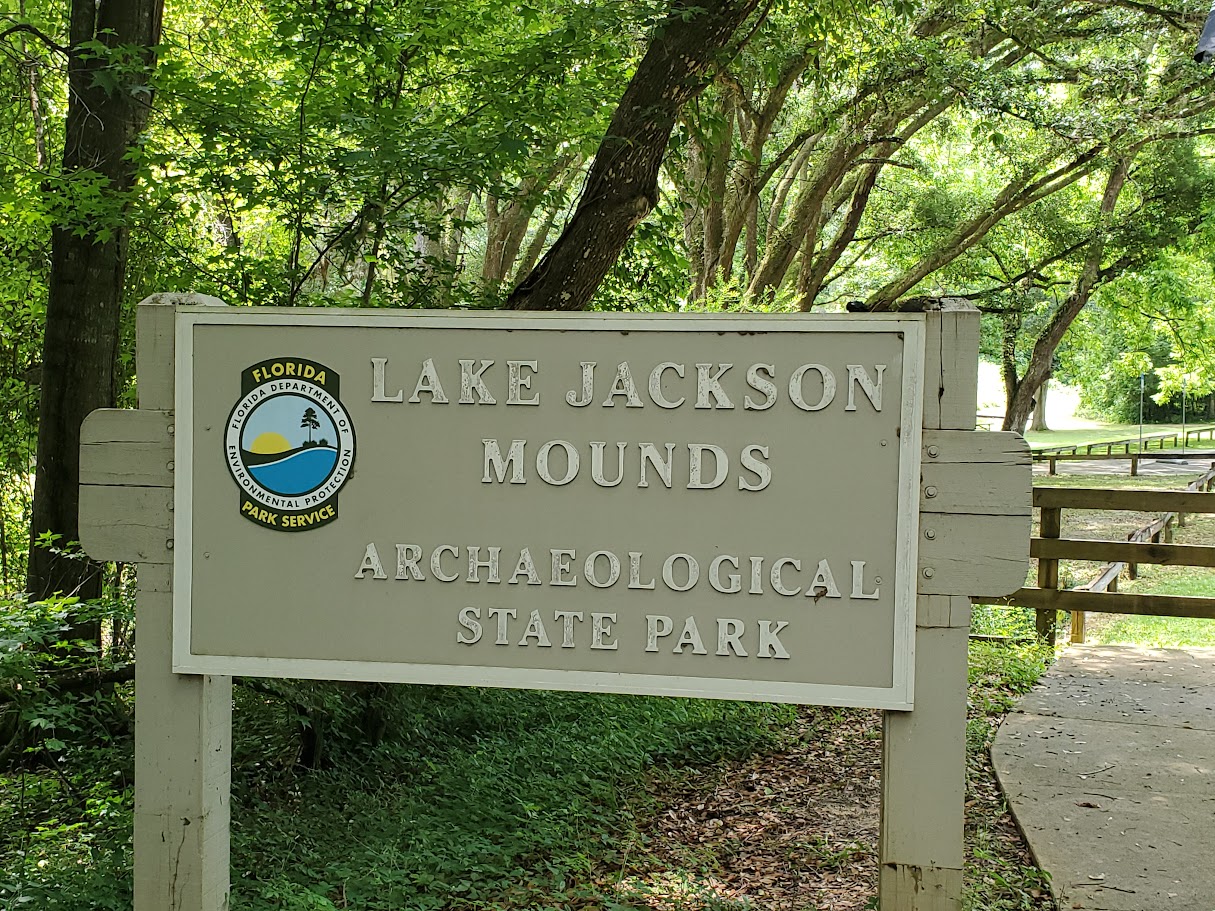
Lake Jackson Mounds site photo by Damien Marie AtHope

Lake Jackson Mounds
“Lake Jackson Mounds Archaeological State Park (8LE1) is one of the most important archaeological sites in Florida, the capital of chiefdom and ceremonial center of the Fort Walton Culture inhabited from 1050–1500. The complex originally included seven earthwork mounds, a public plaza, and numerous individual village residences. One of several major mound sites in the Florida Panhandle, the park is located in northern Tallahassee, on the south shore of Lake Jackson. The complex has been managed as a Florida State Park since 1966. On May 6, 1971, the site was listed on the U.S. National Register of Historic Places as reference number 71000241.” ref
“The site was built and occupied between 1000 and 1500 by people of the Fort Walton culture, the southernmost expression of the Mississippian culture. The scale of the site and the number and size of the mounds indicate that this was the site of a regional chiefdom, and was thus a political and religious center. After the abandonment of the Lake Jackson site the chiefdom seat was moved to Anhaica (rediscovered in 1987 by B. Calvin Jones and located within DeSoto Site Historic State Park), where in 1539 it was visited by the Hernando de Soto entrada, who knew the residents as the historic Muskogean-speaking Apalachee people. Other related Fort Walton sites are located at Velda Mound (also a park), Cayson Mound and Village Site, and Yon Mound and Village Site.” ref
“When the site was abandoned it was a large complex (19.0 hectares or 47 acres) that included seven platform mounds, six arranged near a plaza and a seventh (Mound 1) located 250 metres (820 ft) to the north. The mounds were the result of skilled planning, knowledge of soils and organization of numerous laborers over the period of many years. The ceremonial plaza was a large flat area, constructed and leveled for this purpose, where ritual games and gatherings took place. The area around the mounds and plaza had several areas of heavy village habitation with individual residences, where artisans and workers lived.” ref
“There were also communal agricultural fields in the surrounding countryside, where the people cultivated maize in the rich local soil, the major reason such a dense population and large site were possible. Only a few of the mounds in the park have been systematically excavated by archaeologists. The site itself is oriented on an east–west axis, oriented perpendicular to the north–south axis of the Meginnis Arm, a nearby extension of Lake Jackson. All of the mounds are laid out to reflect this alignment, although it is unclear if this is symbolic or merely the result of the lake arm’s orientation.” ref
“During the Lake Jackson I phase the site consisted of small village possibly with the beginnings of Mound 2 started. During the Early Lake Jackson II phase the population and the habitation areas of the site expanded greatly. Many of the areas that would later become mounds were village areas at this time, including the locations of Mounds 3 and 4, as well as areas north of Mounds 2 and 4. Mound 5 was begun and Mound 2 was started during this time. Mounds 3, 4, and 6 were probably not yet started. No evidence exists for occupation in the vicinity of Mound 6. A small area around Mound 5 continued to be occupied during early Lake Jackson II. The areas north of Mound 4 and between Mounds 2 and 4 show evidence of dense occupation during this time.” ref
“During the Late Lake Jackson II phase, all 7 mounds had been started and most had seen numerous construction episodes. Mound 5 and Mound 6 were possibly finished, and Mounds 2, 3, and 4 were under way but had not had their final stages reached yet. The area to the south and west of Mound 4 and the area between Mounds 2 and 4 continues to be occupied. There is dense occupation north of Mound 2. In the Lake Jackson III phase, the central part of the site is occupied more intensively especially around Mound 2 and spreading north. Mounds 4, 5, and 6 are completed before the beginning of the phase, and Mounds 2 and 3 are finished during the phase. After this point at about 1500, the site is virtually abandoned. There is occasional evidence that the site is still visited in the succeeding Velda phase (1500-1633), but very few artifacts or evidence of habitation from this time period have been found.” ref
“In the center of the complex is Mound 2, the largest and the best-preserved mound at the site, it measures 36 ft high and 272 ft by 312 ft at the base (11 m × 83 m × 95 m). Like all of the mounds at the site where an original shape can be determined, it is a simple truncated-pyramidal platform mound. Very little excavation has taken place at this mound, so not much is known about the construction sequence or what structures may have been built upon it. There was limited work done on the mound in 1947 by John Griffin, in a salvage cleanup effort of a looters trench. He found a series of fill layers of black muck, various soil types, and caps of red clay, but as the cut was not through the entire mound or located near any structures he could not learn much about its construction sequence or definitive purpose. It was most likely the first mound started at the site, early in Fort Jackson’s history. If it is similar to mounds at other sites, then it was the house platform of the ruler of the site, who was also possibly a paramount chief over many other sites.” ref
“Located 50 metres (160 ft) across a plaza to the south of Mound 2 is Mound 3, the third-largest and third-tallest mound at the site. Mound 3 was used as a mortuary mound by its builders. At the end of its construction, it was 5 m in height and 44 by 48 m at the base (16 ft × 144 ft × 157 ft). Based on radiocarbon dating done during excavations, the mound is known to have been constructed between 760 years and 475 years Before Present (based on 1950 as present), or approximately between 1190 and 1475. Below ground level of Mound 3, was a village midden showing residential occupation at this spot before the construction of the mound began. The first activity other than village occupation is a leveling of the location and pit dug and filled with 35 stone projectile points and burned organic material.” ref
“This is covered over with a layer of clay and a structure erected. This building may have been used for feasting rituals. After a period of time, this structure was then burned, and the first 48 centimeters (1.57 ft) of mound layer was erected over it. The first burial is included in this layer. The mound was built up in intervals, with new levels being added in stages. The bulk of the mound fill was a mixture of scraped up midden materials. White sand from the lake shore was used as a first layer in each new episode, followed by mound fill and then a red clay from nearby hills was put on in a thin layer as a final cap. The pattern of deposits of fill demonstrated that the earth was intentionally brought to the site, in baskets as individual basket loads could be detected during excavations.” ref
“Postholes found on the mound summit indicated that buildings with encircling palisades were erected on the flat top. The last structure erected on the summit measured 7.3 by 9.3 metres (24 by 31 ft) and was aligned in a north–south axis just like the mound itself. This rectangular structure is unusual for Apalachee architecture, as most of their structures were round in shape. Archaeologists theorize this may be because of outside influences from other Mississippian centers where rectangular structures are common. The period burning, new fill layer, cap, and structure cycle was repeated twelve times in the 250-year lifespan of the mound. Based on studies at Cahokia (a very large mound center in Illinois) and other Mississippian culture sites, scholars believe that structures were destroyed and the mounds “renewed” with new higher layers of fill and new colored clay caps. The time span in between renewals at many sites suggests the average lifespan of a ruler and their death and replacement by a successor.” ref
“The mounds location on private property outside the state owned park meant it was not protected as the mounds inside the park are and it was leveled for use as fill dirt in the winter of 1975–1976. Before it was dug away B. Calvin Jones, an archaeologist with the State of Florida Bureau of Historic Sites and Properties, conducted a salvage operation. He recovered 24 burials from Mound 3, with others known to have been lost in the destruction of the mound. Seven of the twelve levels that had been the top of the mound had graves dug into them. Graves dug into the other levels may have been lost as the mound was destroyed. The burials were in deep pits, some lined with split logs, but each grave was kept track of as none were dug down into previous graves. Before burial the bodies were wrapped in cloth and an embossed copper plate placed on their chest. They were then wrapped in leather and cane matting and placed into the prepared pit graves and split logs placed over them.” ref
“This entire procedure of wrapping the body is reminiscent of “bundling“, a practice used for sacred objects which has a long history among Native North Americans. A selection of other grave goods have been found wrapped in the bundles. In the sequence from lower to higher levels (oldest to more recent), the grave goods became more elaborate. In the upper levels, the grave goods included many objects made of copper, beads made of shell and pearl, and pipes associated with ritual use of tobacco. Although most of the burials were of elite men, the graves included one woman (buried with the most elaborate falcon dancer copper plate) and a child of about eleven years of age, probably of the elite class. One of the bodies had been cremated. The bones of a dog were found on top of one of the clay levels that was an earlier top surface of the mound.” ref
“Mound 1 was partially excavated in the mid to late 1950s by Charles H. Fairbanks and Hale G. Smith for the Department of Anthropology at Florida State University. All information from the excavation except for a single photo and a partial list of artifacts found are currently missing and presumed lost. Mound 1 is the only mound not currently located within the boundaries of the park and remains privately owned. Mound 4 was built between 1250 and 1400. It was started when a layer of white sand was laid down over a previous habitation area and covered with 60 centimetres (2.0 ft) of basket-loaded mound fill and covered with a red-clay cap. It had several more similar construction phases. A series of postholes were discovered at the summit by John Griffin in 1947, but due to time constraints with the work season he could not proceed any further.” ref
“Mound 5, the smallest mound at the site, went through at least two phases of mound construction. It was built over a former village area but did not receive a coat of white sand before mound construction as did Mound 4. It seems to have been abandoned sometime during the Late Lake Jackson phase. Mound 6 was also built on top of an earlier habitation area, and was also given a layer of light-colored sand before the mound was started. Several layers were added over the years, and evidence for habitation structures was found on the successive summits. Artifacts found in the mound date to 1250 to 1400, during the Late Lake Jackson II phase. Mound 7 has never been excavated, and almost nothing is known about it. Its seriously degraded shape does not even permit its identification as a platform mound with certainty.” ref
“The layout and arrangement of the mounds in the central area of the site suggests that there may have been two large plaza areas. Mounds 2, 3, 4, and 5 form a large rectangular shape that was mostly free of debris. Mounds 2, 3, 6, and 7 also form a rectangular shape that suggests it too was a plaza. Both plazas would have had Butler’s Mill Creek (a small stream that once bisected these areas, but whose course was altered in historic times) running through it. Excavations have shown that a clean area between Mounds 2 and 4 was a plaza, but not enough work has been done at the rest of the site to confirm the larger dimension suggested by the first arrangement or the existence of a plaza at the second arrangement at all.” ref
“Artifacts found at the Lake Jackson site include plain and repoussé copper plates, copper headdress badges, engraved shell gorgets, pearl beads, copper axes, and stone and ceramic pipes. Many of these pieces had motifs representative of the Southeastern Ceremonial Complex or SECC. Similar artifacts have been found at the Spiro site in Oklahoma, the Moundville site in Alabama, and Etowah Mounds in northwestern Georgia. Stylistic analysis has shown that of the three, Lake Jackson had the closest ties with Etowah. The burials found in Mound 3 were ranked into 3 levels: the elite who were buried with the most-elaborate copper items, pearl beads and shark-teeth-adorned clothing, the middle rank who were interred with stone axes or shell/bead necklaces, and the low-ranked who did not have any high-status grave goods. The iconography of the items also slowly changes with time, growing more complex and numerous and thought by archaeologists to be evidence of influences from other elite polities and the development of a full-fledged local warrior class. At least ten of the burials unearthed at the mound were of “elite war leaders.” ref
“The most elaborate embossed copper plate found in Mound C greatly resembles the two Rogan plates found in Mound C at the Etowah Site. The three plates are in the Classic Braden style associated with Cahokia, and it is generally thought that the plates were manufactured there before ending up at sites in the Southeast. The Lake Jackson plate depicts a winged dancing figure holding a ceremonial mace in one hand and a severed head in the other. The figure wears an elaborate headdress with an ogee symbol and a bi-lobed arrow motif. Actual copper ogee plates used as headdress were found in burials at Etowah. These motifs are also found on sculptures and shell engravings from the Spiro site, such as the ogee headdress-wearing “Resting Warrior or Big Boy statue.” The ogee is usually associated with underworld figures. The figure also appears to be wearing a long-nosed god maskette (an object thought to be associated with ritual adoption and also worn as ear-rings by the Resting Warrior) and clothing which are all motifs associated with the falcon dancer/warrior/chunkey player including the columnella pendant, large shell beads, bellows apron (scalp motif), and the long-waist sash.” ref
“This plate was one of 14 recovered from the mound, along with 11 copper axes, many copper headdress ornaments, a few polished-stone celts, marine-shell drinking cups of the type historically used for the black drink ritual, and pottery vessels and a few non-local materials such as mica, graphite pigment, red ocher and stone discoidals. All of the copper pieces came to Lake Jackson by way of the Etowah site which shows that the two sites had a long-running relationship, trading their specific local prestige products to each other. The Etowahans prized the whelk shells from the Gulf Coast for the making of shell gorgets and ritual drinking cups and the Lake Jackson elites valued the prestigious Etowah plates and other copper objects. This monopoly on the shell trade by the Etowahans lasted until the fall of the chiefdom in about 1375, after which the elite status goods used in burials in Mound 3 come from other locations, mostly the northern Georgia and eastern Tennessee area.” ref

Lake Jackson Mounds site photo by Damien Marie AtHope
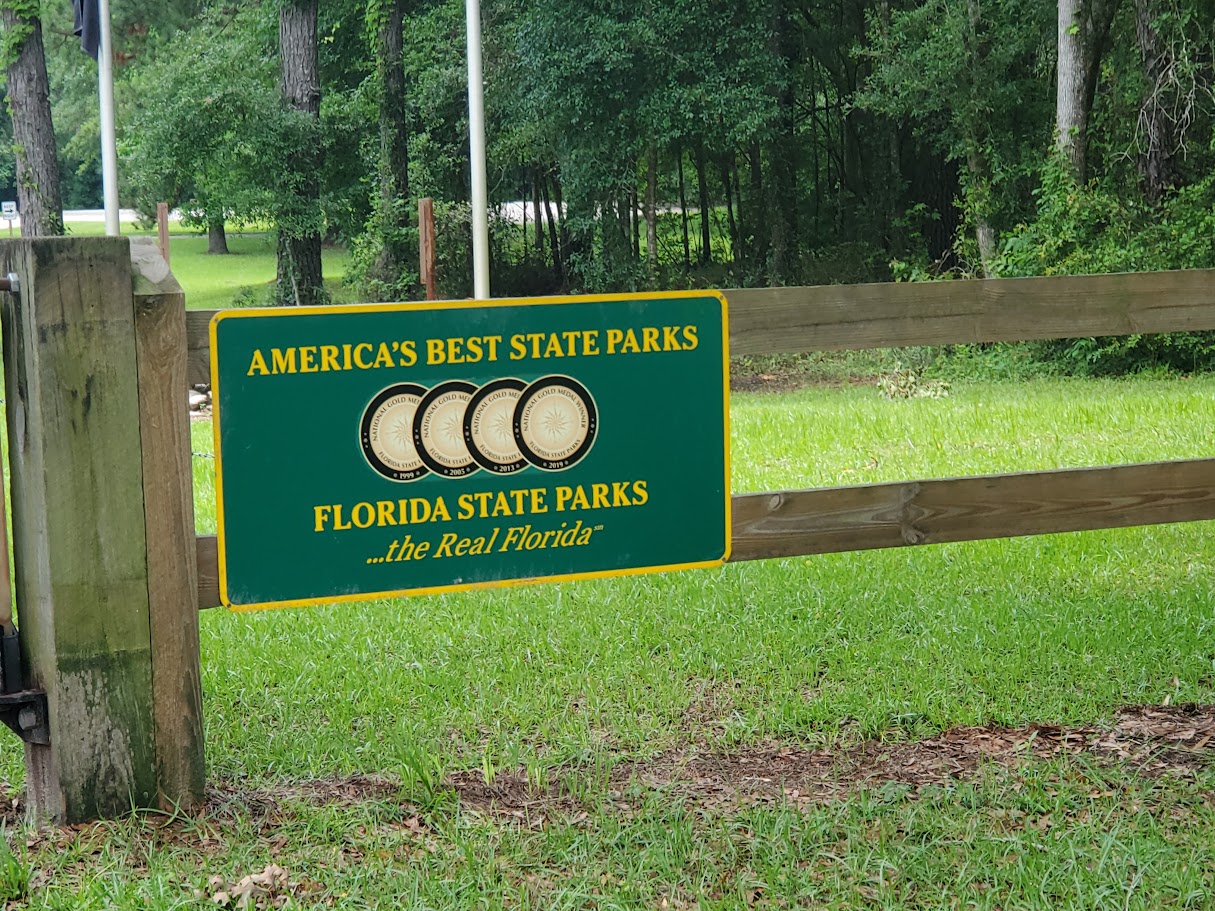
Lake Jackson Mounds site photo by Damien Marie AtHope

Letchworth-Love Mounds site photo by Damien Marie AtHope
Letchworth-Love Mounds
“Letchworth Mounds Archaeological State Park is a 188.2 acre Florida State Park that preserves the state’s tallest prehistoric, Native American ceremonial earthwork mound, which is 46 feet (14 m) high. It is estimated to have been built 1100 to 1800 years ago. This is one of three major surviving mound complexes in the Florida Panhandle. It is believed to have been built by the Weedon Island Culture (200-800 CE), Native Americans who lived in North Florida. The hierarchical society planned and constructed massive earthwork mounds as expression of its religious and political system.” ref
“The archeological park has exhibits to interpret the artifacts and evidence of nearly 10,000 years of human habitation found at this site. It is located approximately six miles west of Monticello, a half mile south of U.S. 90, in northwestern Florida. The address is 4500 Sunray Road South. Two related sites in the panhandle are from the later Fort Walton Culture (1100-1550 CE): Fort Walton Mound, a National Historic Landmark; and the Lake Jackson Mounds Archaeological State Park.” ref
“Although the mound now has trees and underbrush growing from it, when originally built, such earthwork mounds were typically clear of vegetation, with smooth prepared sides. Many workers had to bring soils by basket to build the mound. The builders used their knowledge to combine a variety of soils and shells for stability, and usually finished the top and sides with clay. The mound likely rose from flat plazas which were intentionally leveled. They would have served as gathering places for rituals, games, and major occasions.” ref
“The community of which such a tall mound was likely the center would have included nearby dwellings for workers, and communal fields and gardens. They cultivated maize to support the population density of such complex societies. The Letchworth Mounds site has one of the largest mounds from any site. The mound measures 300 feet in width and has a height between 46 and 50 feet. This is one of three sites with mounds in the Florida Panhandle. The other two both date from the later Fort Walton Culture (1100-1550 CE).” ref
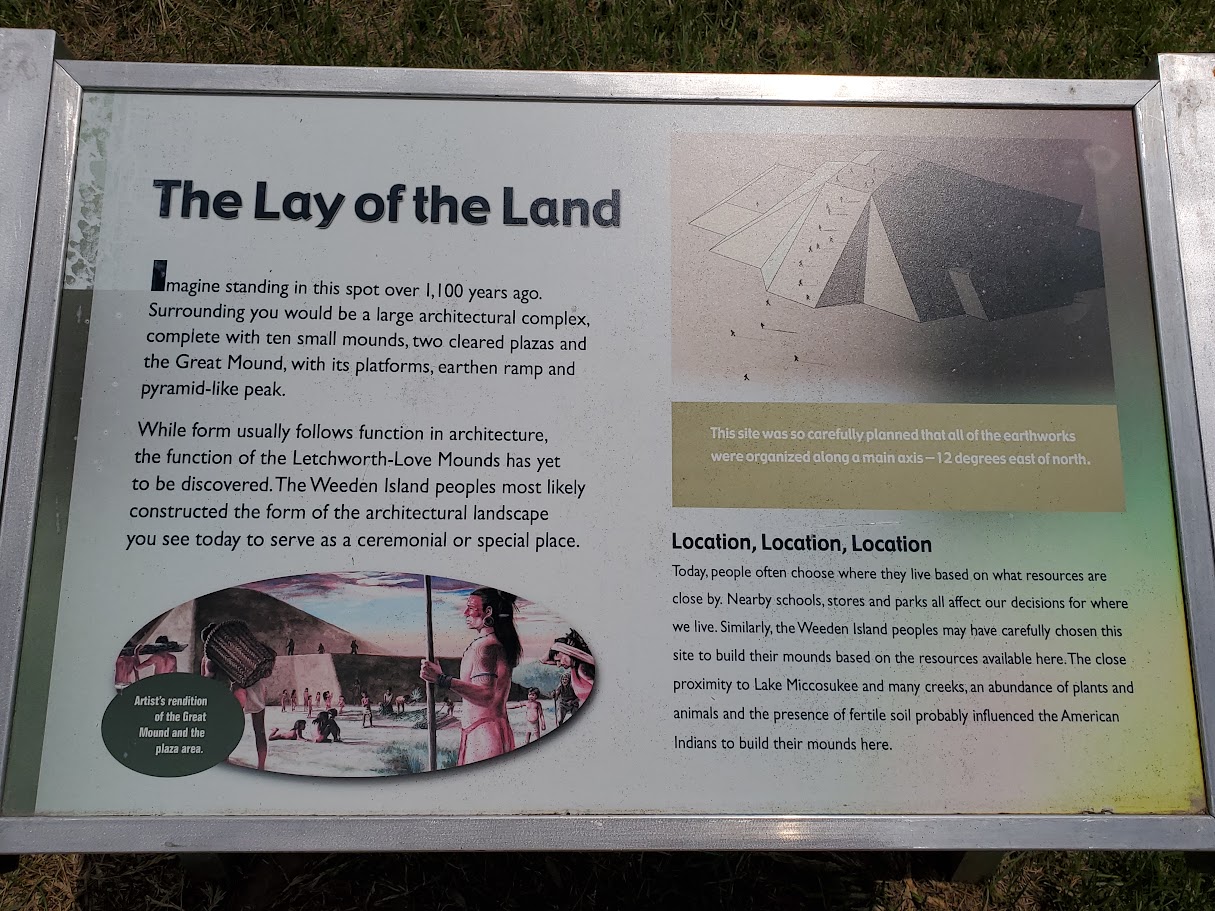
Letchworth-Love Mounds site photo by Damien Marie AtHope

Letchworth-Love Mounds site photo by Shayna Marie AtHope
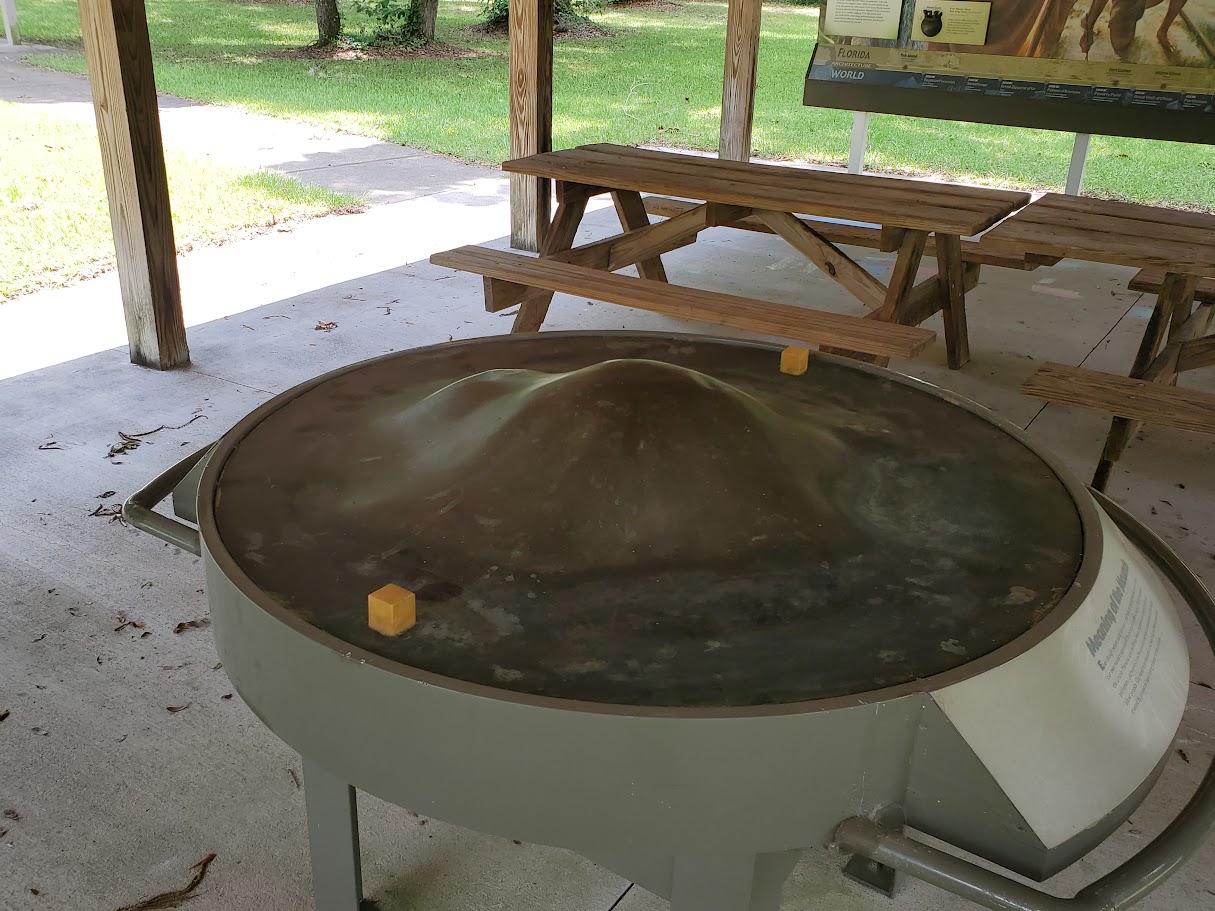
Letchworth-Love Mounds site photo by Damien Marie AtHope
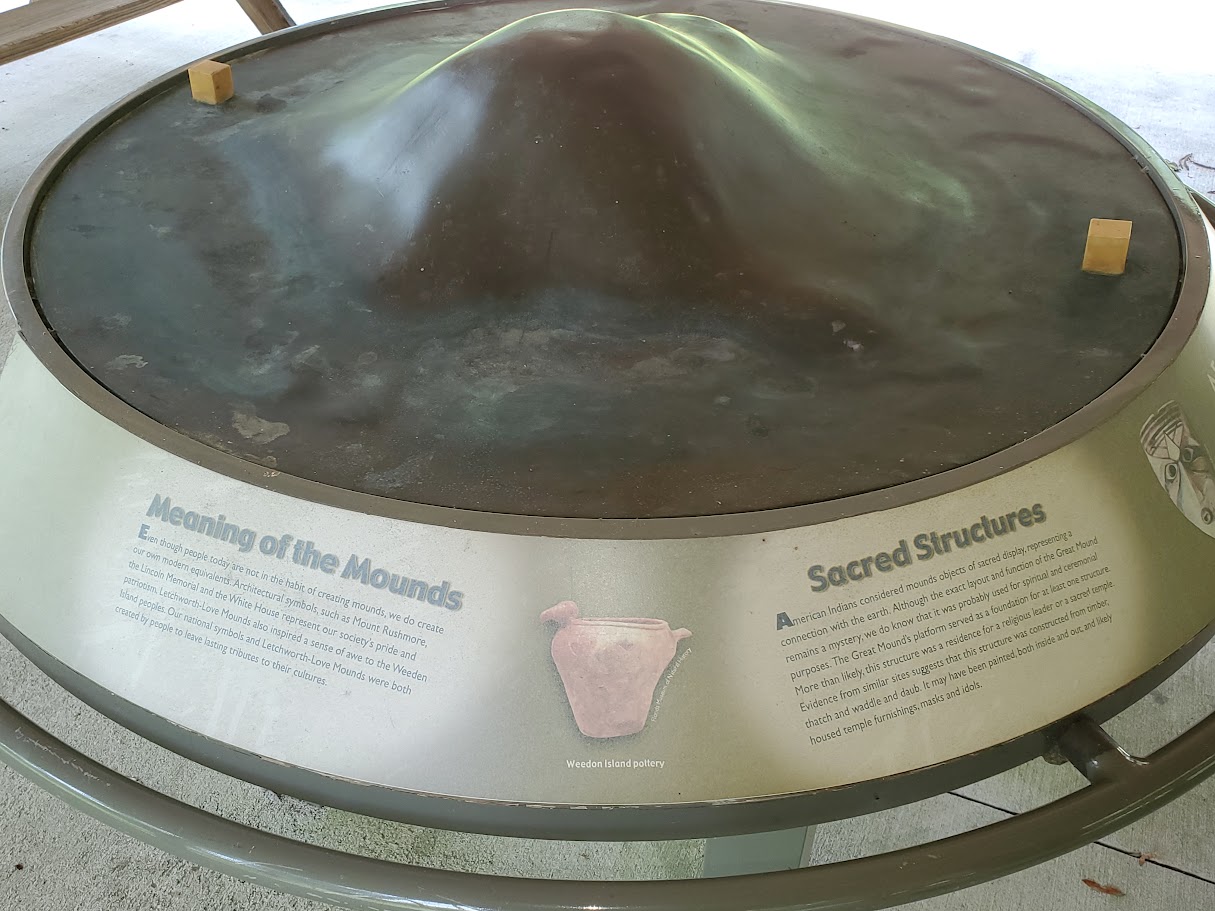
Letchworth-Love Mounds site photo by Damien Marie AtHope
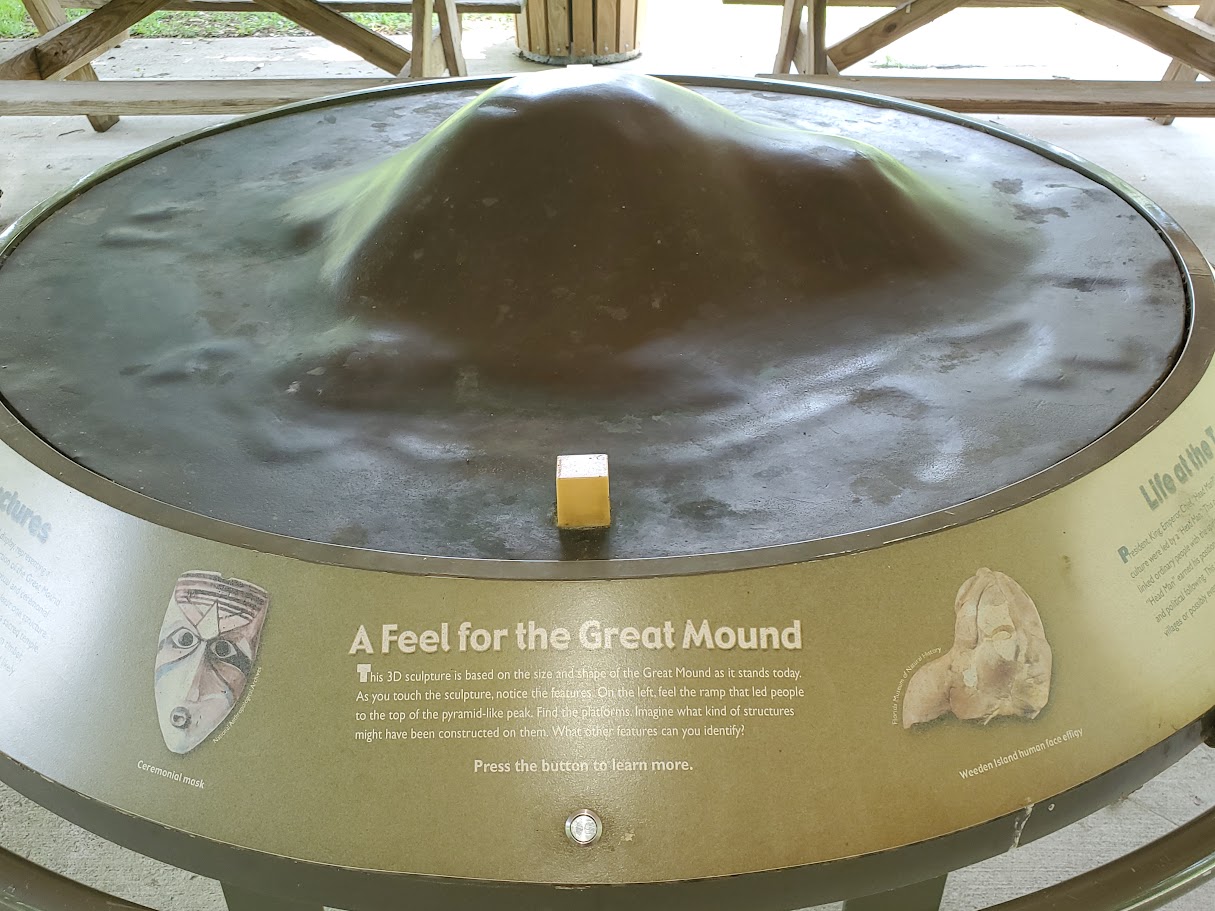
Letchworth-Love Mounds site photo by Damien Marie AtHope

Letchworth-Love Mounds site photo by Damien Marie AtHope
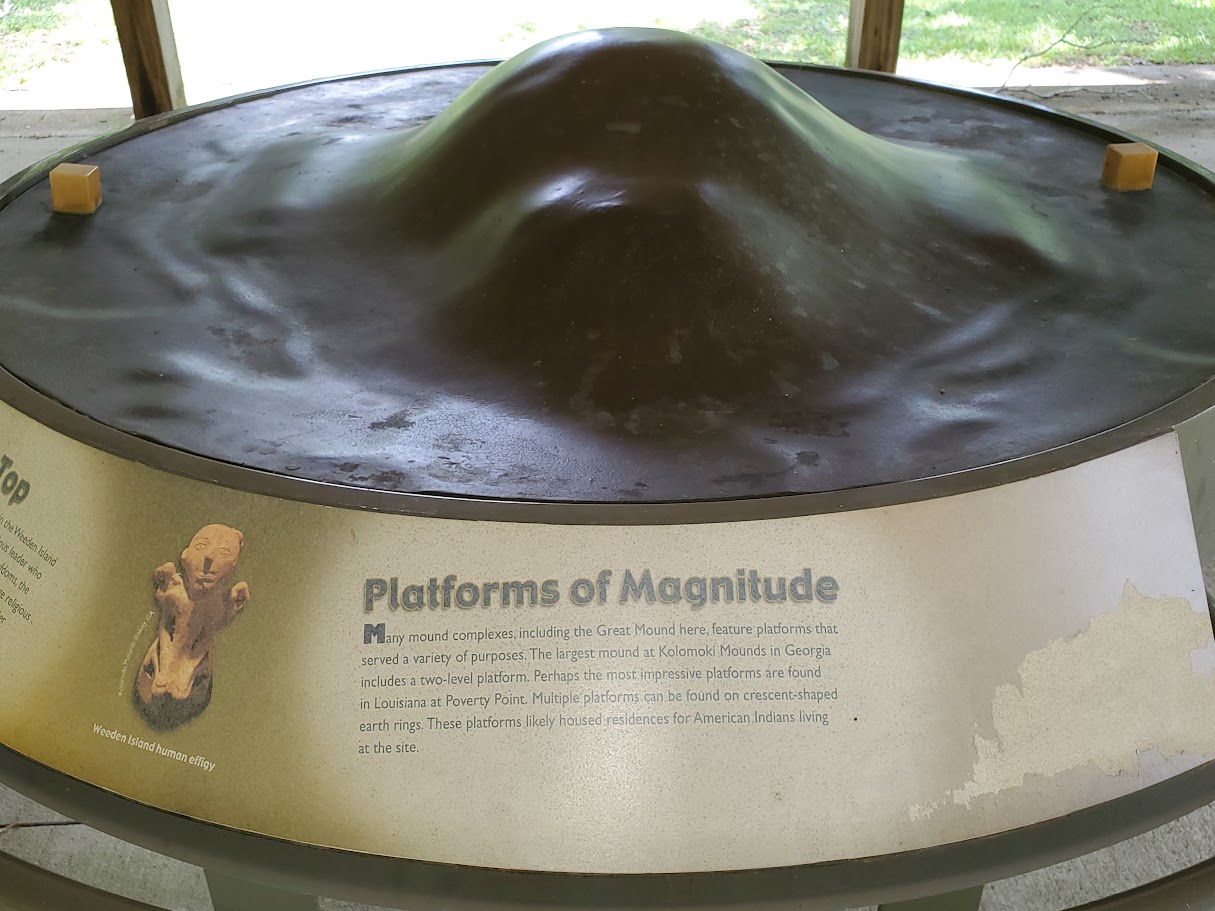
Letchworth-Love Mounds site photo by Damien Marie AtHope

Letchworth-Love Mounds site photo by Damien Marie AtHope

Letchworth-Love Mounds site photo by Damien Marie AtHope

Letchworth-Love Mounds site photo by Damien Marie AtHope
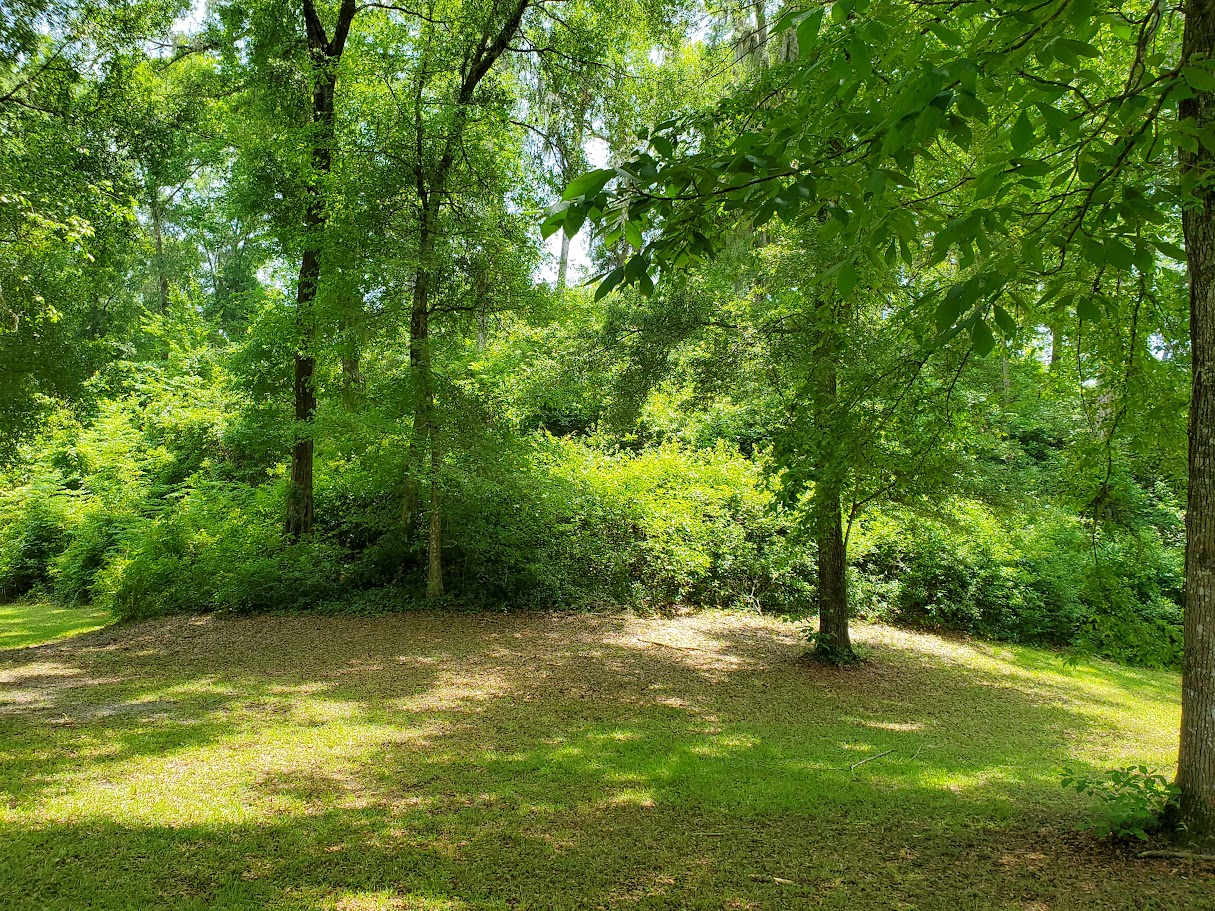
Letchworth-Love Mounds site photo by Damien Marie AtHope
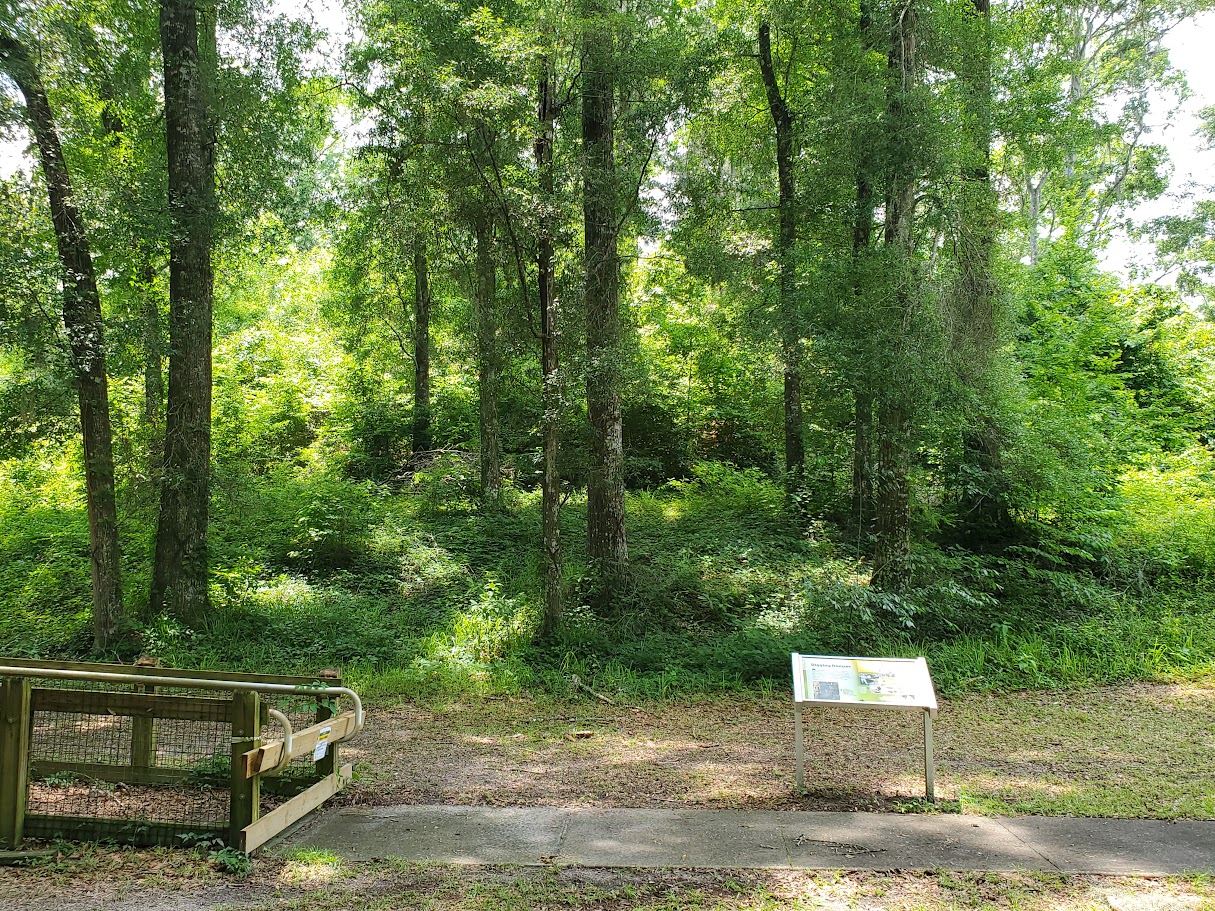
Letchworth-Love Mounds site photo by Damien Marie AtHope

Letchworth-Love Mounds site photo by Damien Marie AtHope

Letchworth-Love Mounds site photo by Damien Marie AtHope
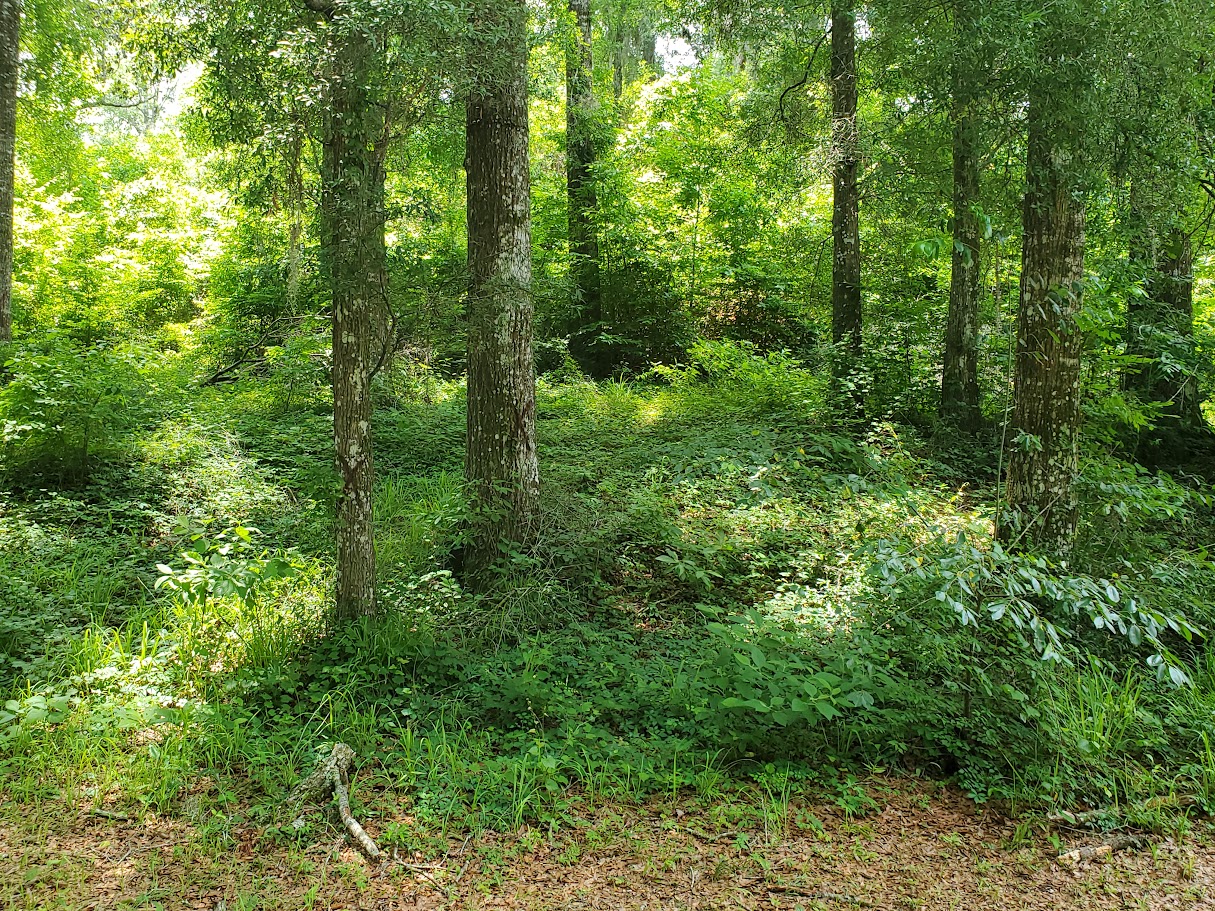
Letchworth-Love Mounds site photo by Damien Marie AtHope
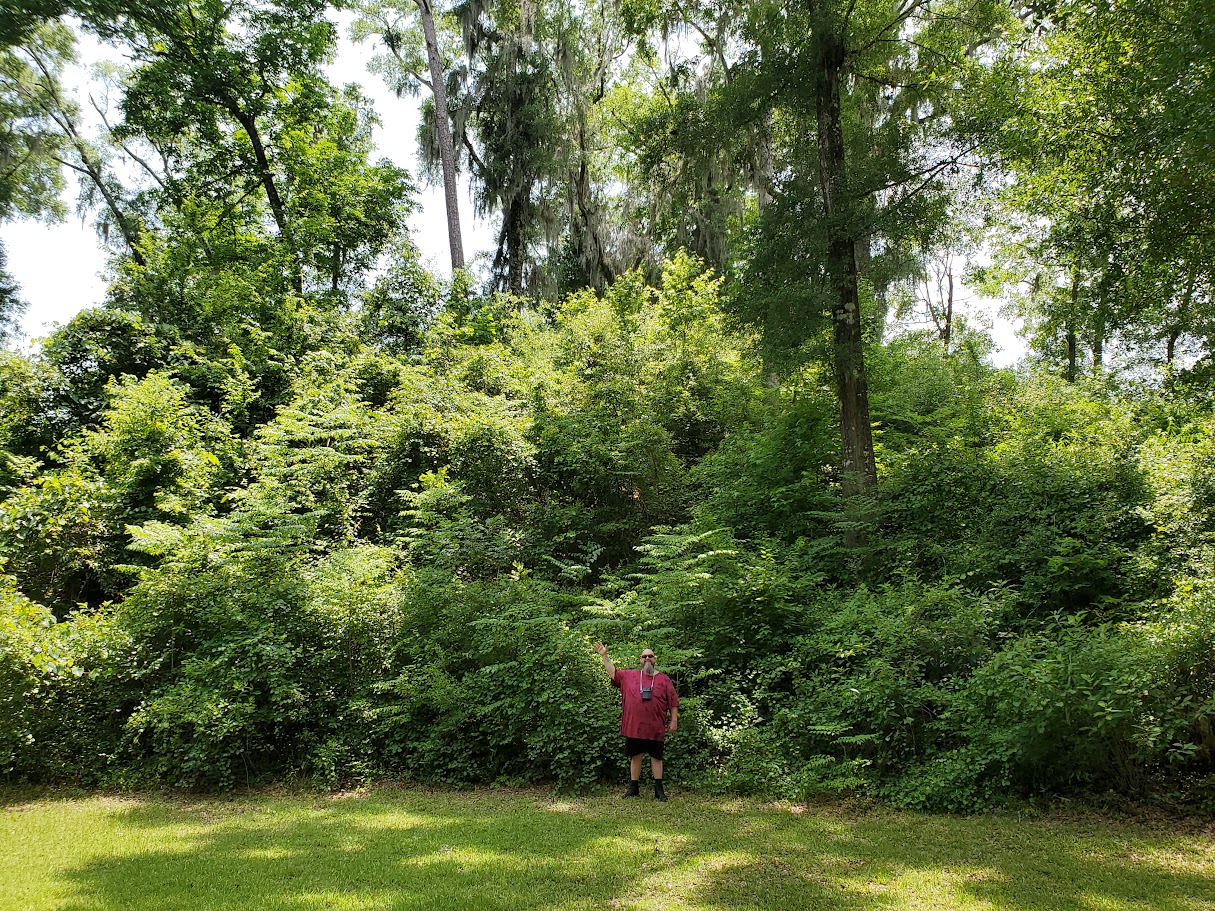
Letchworth-Love Mounds site photo by Shayna Marie AtHope
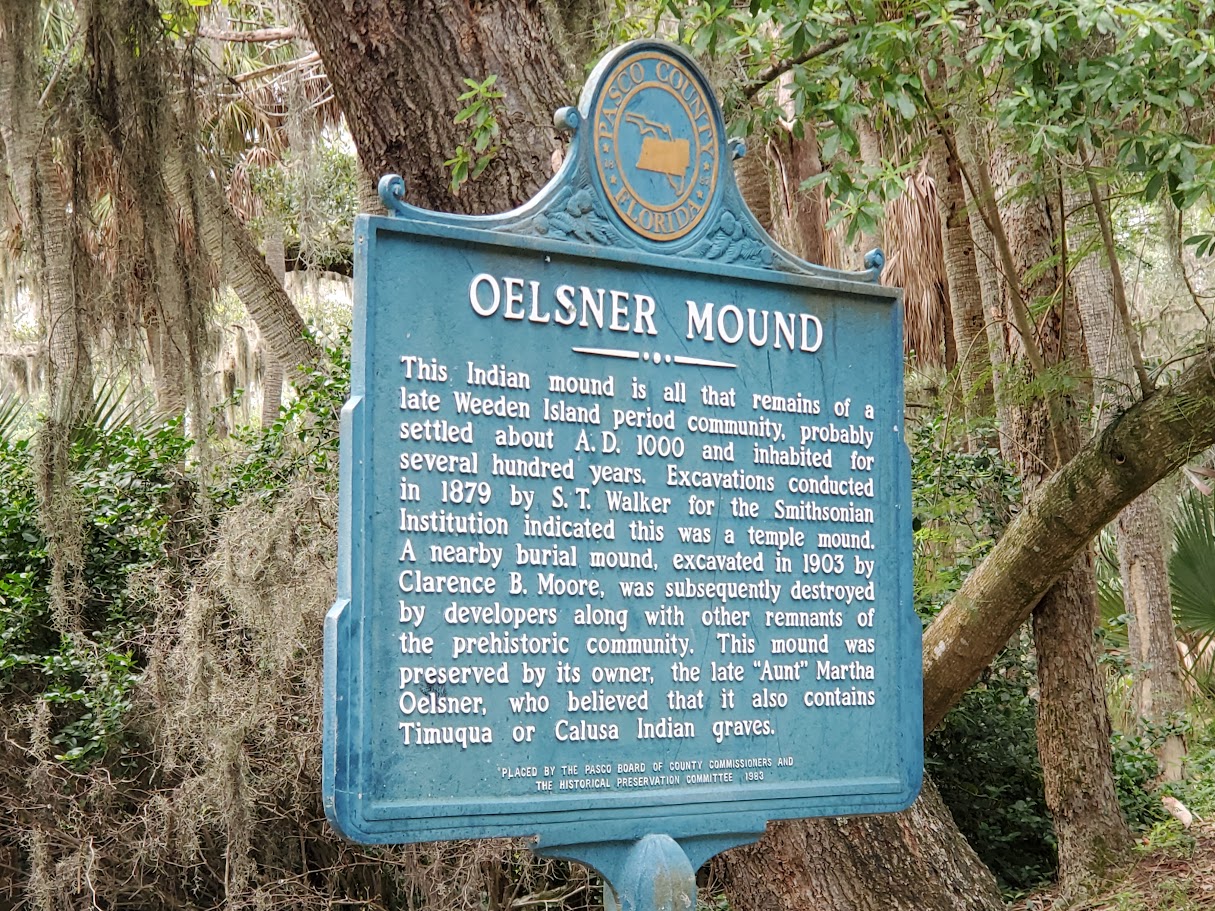
Oelsner Indian Mound site photo by Damien Marie AtHope
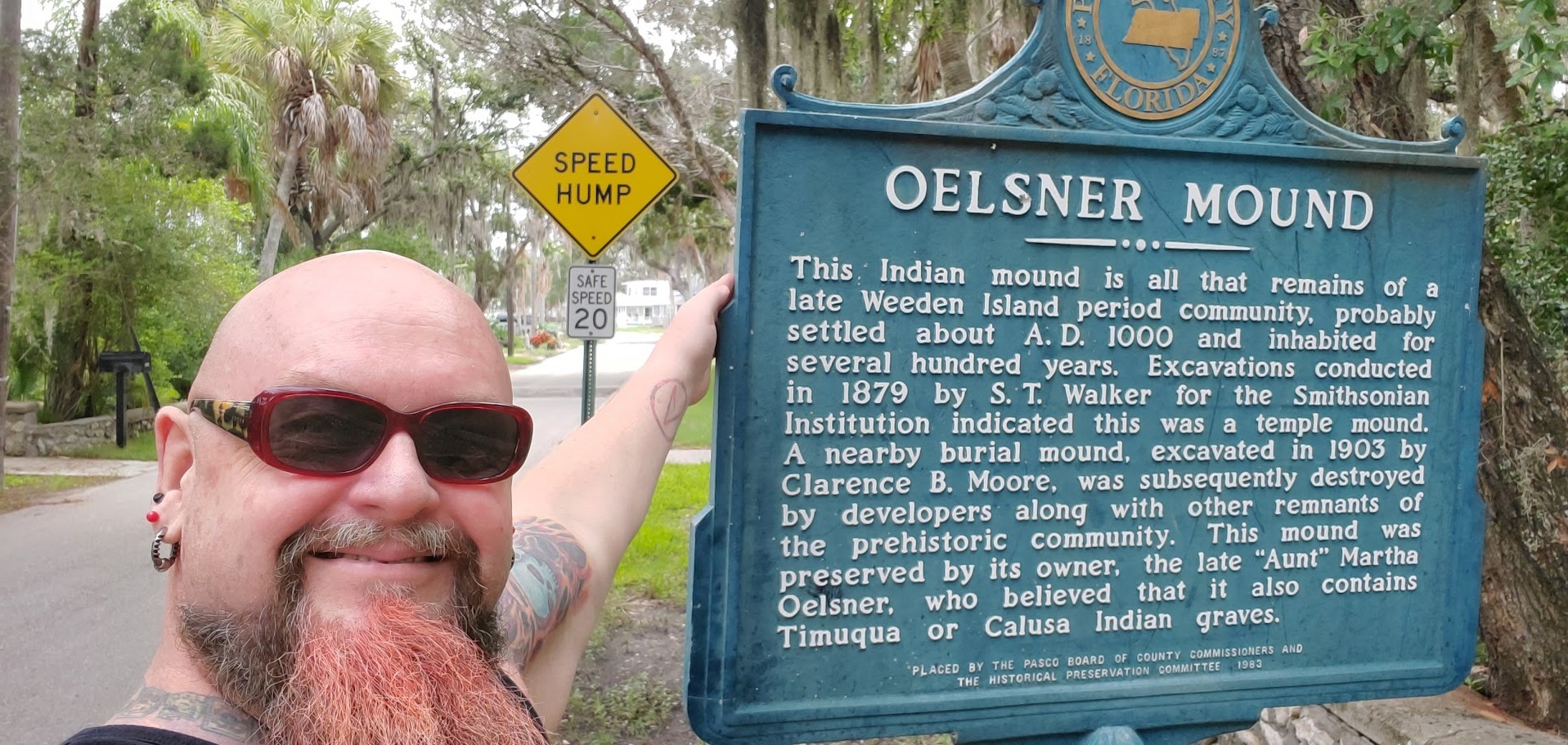
Oelsner Indian Mound site photo by Shayna Marie AtHope
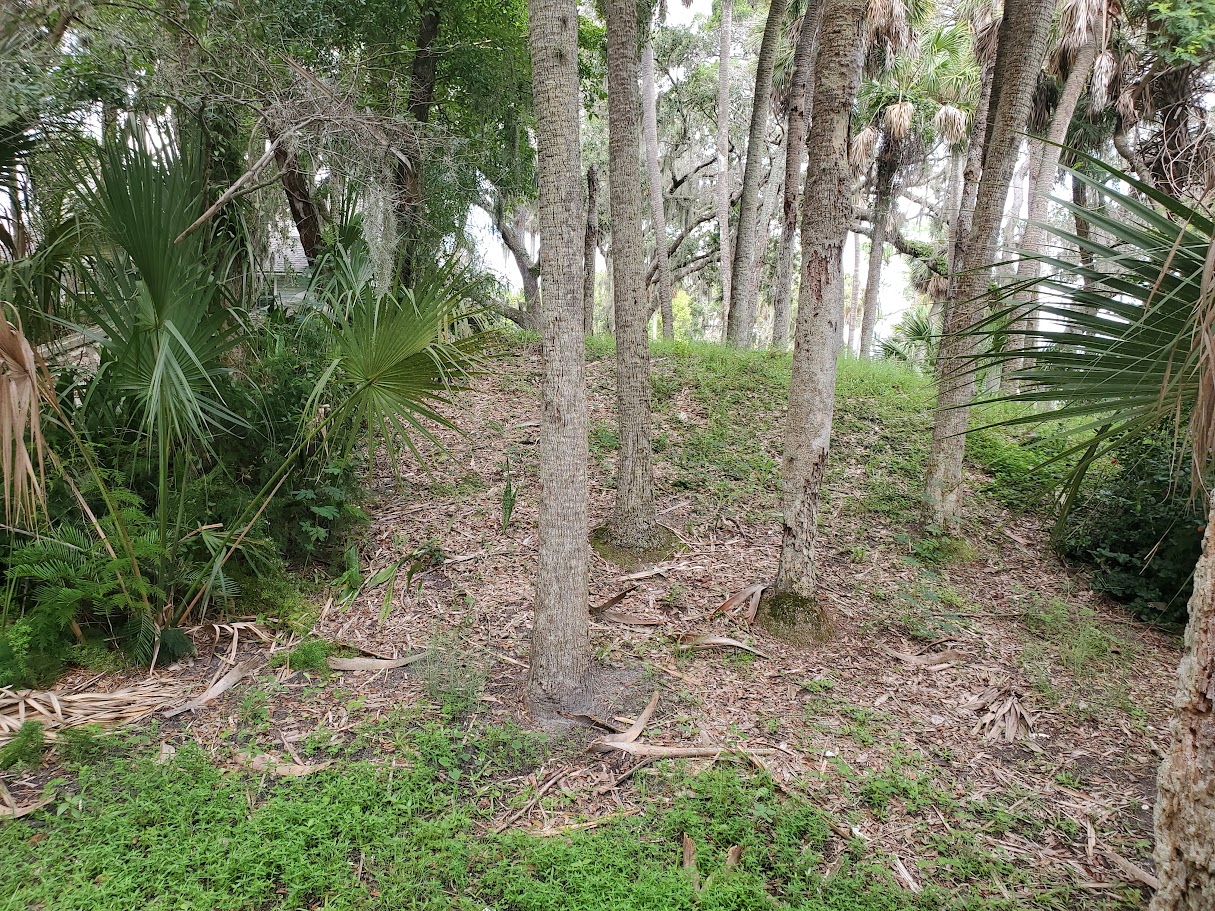
Oelsner Indian Mound site photo by Damien Marie AtHope

Oelsner Indian Mound site photo by Damien Marie AtHope

Oelsner Indian Mound site photo by Damien Marie AtHope
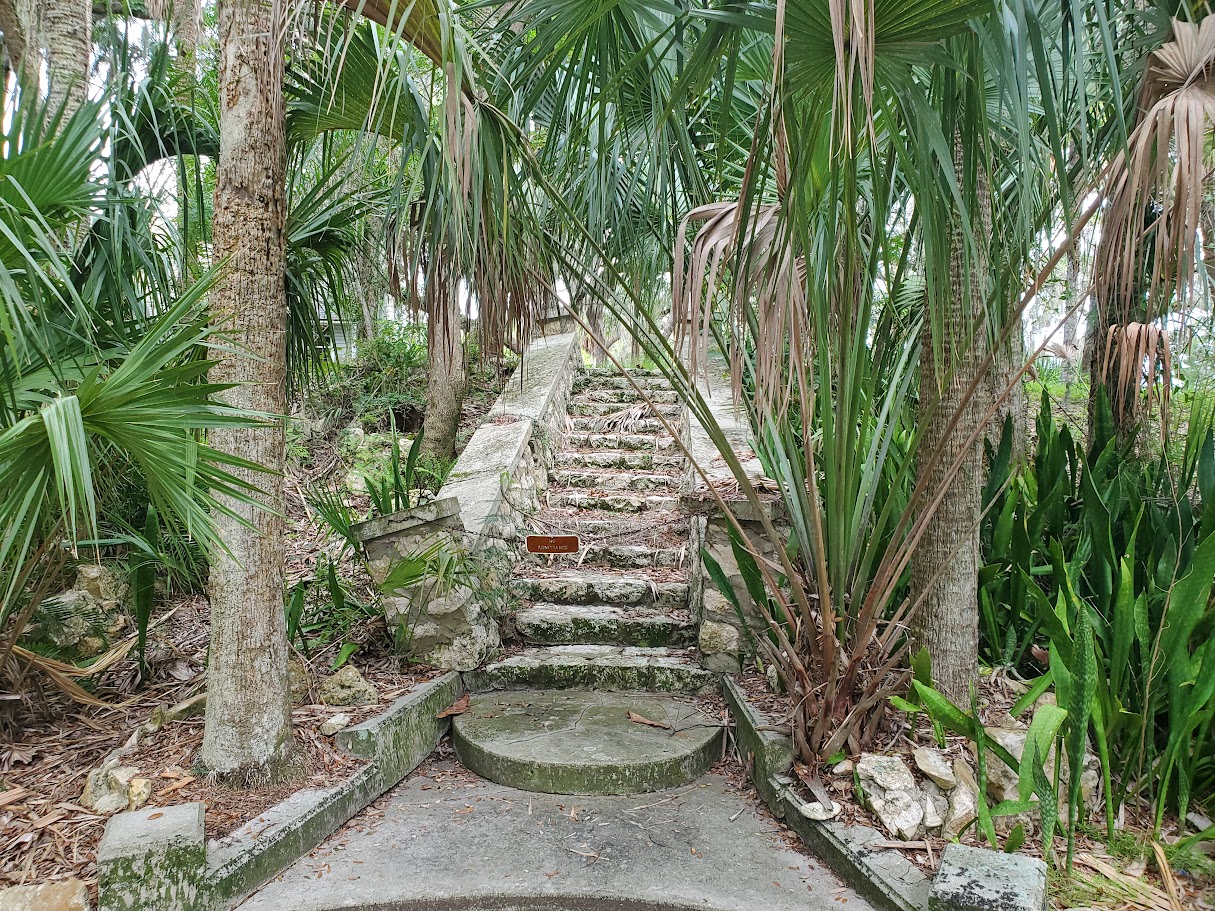
Oelsner Indian Mound site photo by Damien Marie AtHope
Oelsner Mound, near Port Richey in Pasco County, is likely one of the Known Safety Harbor sites with “temple” mounds; others include:
- Anclote Temple Mound, near the mouth of the Anclote River, now destroyed.
- Anderson/Narvaez Temple Mound, in St. Petersburg.
- Bayshore Homes Temple Mound, in St. Petersburg, now destroyed.
- Dunedin Temple Mound, in Dunedin, now destroyed.
- Fort Brooke Temple Mound, at the site of Fort Brooke in Tampa, now destroyed.
- Harbor Key Temple Mound (Bishop Harbor Temple Mound), on Bishop Harbor in Manatee County.
- Madira Bickel Temple Mound, in Manatee County, listed in the National Register of Historic Places.
- Maximo Point Temple Mound, in St. Petersburg.
- Mill Point Temple Mound on the Alafia River, now destroyed.
- Pillsbury Temple Mound, in Manatee County, mostly destroyed.
- Pinellas Point Temple Mound (or Hirrihigua Mound), in St. Petersburg.
- Safety Harbor Temple Mound, at Safety Harbor site in Safety Harbor, the type site for the Safety Harbor culture.
- Snead Island Temple Mound (Portavant Mound), in Manatee County.
- Weeden Island Temple Mound, at Weedon Island Preserve in St. Petersburg, now destroyed, the type site for the Weeden Island culture.
- Whitaker Temple Mound, on Sarasota Bay, now destroyed.” ref
“Possible Safety Harbor temple mound sites include:
- Bahia Beach Mound (8HI536), near the mouth of the Little Manatee River.
- Bull Frog Creek, south of the mouth of the Alafia River.
- Englewood, near Englewood.
- Harbor Key II, southwest of the Harbor Key Temple Mound.
- Kennedy, on Terra Ceia Island between the Harbor Key and Madira Bickel temple mounds.
- Oelsner Mound, near Port Richey in Pasco County.
- Thomas Mound (8HI1), near the mouth of the Little Manatee River, now destroyed, possibly the site of Uzita.” ref
“Oelsner Mound was made around CE 1000 and was a temple mound. Excavations conducted in 1879 by S.T. Walker for the Smithsonian Institution indicated this was a temple mound. A nearby burial mound, excavated in 1903 by Clarence B. Moore, was subsequently destroyed by developers along with other remnants of the prehistoric community. This mound was preserved by its owner, the late “Aunt” Martha Oelsner, who believed it also contained Timuqua or Calusa Indian graves.” ref, ref
“The Eschaskotes (a.k.a. “Oelsner”) Mound is one of the oldest historic sites in “Port Richey”. Reportedly, this temple mound was the highest point overlooking an entire village site comprised of many Indigenous People. As a matter of fact, the website for the “city of Port Richey” acknowledges that the area “was once an industrious Indian community and has been the home and burial ground for two separate Indian tribes.” And yes, thank goodness, there is still a strikingly large mound situated in this beautiful riverfront community. Many old trees express satisfaction with their environment by maintaining steady growth and stability in the natural brown soil landscape of the mound. Quite an impressive sight.” ref
“The grass and tree-covered rise is part of a county park surrounded by a residential community south of the Pithlachascotee River. The Oelsner Mound represents a significant town center once inhabited by some of the state’s original residents long before Spanish explorers discovered Florida. Dating back to the late 1800s, those interested in Florida’s archaeological past have examined and documented the site of the mound and the surrounding area, measuring, digging and cataloging artifacts. In more recent years, they determined the mound was a central feature in a village. Assembling a history of those studies and applying findings to a wider view of the native people of Florida, staff at the Florida Department of State applied for National Register designation earlier this year and the listing was granted Sept. 16.” ref
“The Oelsner Mound is the 11th Pasco location to make the listing, the last being the Dade City Historic Courthouse in 2006. According to its website, “The National Register of Historic Places is the official list of the nation’s historic places worthy of preservation. Authorized by the National Historic Preservation Act of 1966, the National Park Service’s National Register of Historic Places is part of a national program to coordinate and support public and private efforts to identify, evaluate, and protect America’s historic and archeological resources.” For local officials and historians, the designation brings a special honor and a reminder of a past not just forgotten but bulldozed over. Census records show Pasco County has grown from a population of 193,661 in 1980 to an estimated 553,947 last year.” ref
“Coastal sites became waterfront communities and uplands were flattened to build subdivisions and highways. Researchers who studied the history of the Oelsner Mound didn’t want to see that same fate, noting in a detailed 23-page application that there is much to still learn from the largely-undisturbed mound itself. Written by Barbara Mattick and Kelly Chase of the Florida Division of Historical Resources, the application describes the location as “Safety Harbor period, habitation site consisting of one platform mound and associated midden deposits both beneath and surrounding the mound. A burial mound was originally also associated with the site, but it has been destroyed by modern construction.” ref
“The report describes the condition of the area saying, “the mound appears today as much as it did when initially constructed, with the exception of a set of apparently modern concrete steps ascending the eastern face. The mound and the shell midden on which it rests, however, are in a good state of preservation and are moderately protected by their location in the residential neighborhood. The platform mound is further protected by the fact that it is owned by Pasco County.” The authors argued that because the Oelsner Mound was so well preserved as a portion of a larger mound complex considered the northernmost complex of its type, it could reveal significant information about the early Safety Harbor cultural period from 900 to 1500 CE.” ref
“The report states that future study might also reveal how those who lived in that area during that period interacted with other indigenous populations and, if Spanish artifacts are found, how contact with the Spanish might have impacted the population. “Sites like Oelsner mound are rare and could yield valuable data relating to a variety of research questions concerned with the Safety Harbor period,” the authors wrote. Martha Oelsner, a prominent Port Richey resident, left the land, including the mound, to the Florida Sheriff’s Youth Ranch when she died in 1981. Oelsner, who had a home on the site, believed the mound contained remains and she asked that it be preserved.” ref
“In 1989, the youth ranch sold the property to raise cash but held back the part that included the 9-foot-tall mound. The ranch agreed to donate the mound to the county after preservationists said it was culturally and historically important and Pasco County got the deed to the site in April of that year. In 1991, University of South Florida anthropology professor Ray Williams and some of his students did a study of the area, sampling lands around the mound. They were not able to examine the associated burial mound which was between 300 and 350 feet away because the owner, who lived in a house built on the site, would not give permission.” ref
“While the Oelsner Mound is not thought to have been used for burials, it was a central part of the village inhabited for generations. During the time that Williams examined the site, he explained that the mound was thought to have been built up over time by those who lived nearby between 1000 and 1400 CE. Based on the discarded shells and other refuse from the community, Williams estimated that the riverfront village probably was home to fewer than a “couple hundred” Indians. The mound served as a religious and ceremonial gathering place, likely built up over generations, with the village raising one chief’s home on the charred remains of his predecessor, Williams said at the time. “It’s the only temple mound that’s left between Crystal River and Safety Harbor, (so) it’s kind of unique for that reason,” Williams said.” ref
“The nomination of the site for the National Register of Historic Places was a bit of a surprise to local officials and historians but it was the Florida Division of Historical Resources which pushed through the application. Originally Williams himself had sought a listing but that idea never got off the ground. Then earlier this year, the idea came up again and the application was submitted focused just on the area which was part of the Pasco County park, according to Mark Ard, interim communications director for the division. “Oelsner Mound is an important cultural site to Pasco County, offering a glimpse into what life was like in our region 1,000 years ago,” said Pasco County Commission Chairman Mike Moore. “We’re grateful for its well-deserved recognition on the National Register of Historic Places, and sincerely appreciate the Florida Department of State working closely with Pasco County staff on the application.” ref
“At least 8 other markers are within 4 miles of this marker, measured as the crow flies. Pine Hill Cemetery (approx. 1.3 miles away); Our Lady Queen of Peace Catholic Church (approx. 1½ miles away); Dr. Frederick A. Grassin Bridge (approx. 1.6 miles away); Sims Park (approx. 1.6 miles away); West Pasco County War Memorial (approx. 1.6 miles away); Meighan Theatre (approx. 1.7 miles away); Green Key (approx. 2 miles away); Pasco County Centennial (approx. 3.6 miles away).” ref

Tocobaga Temple Mound site photo by Damien Marie AtHope
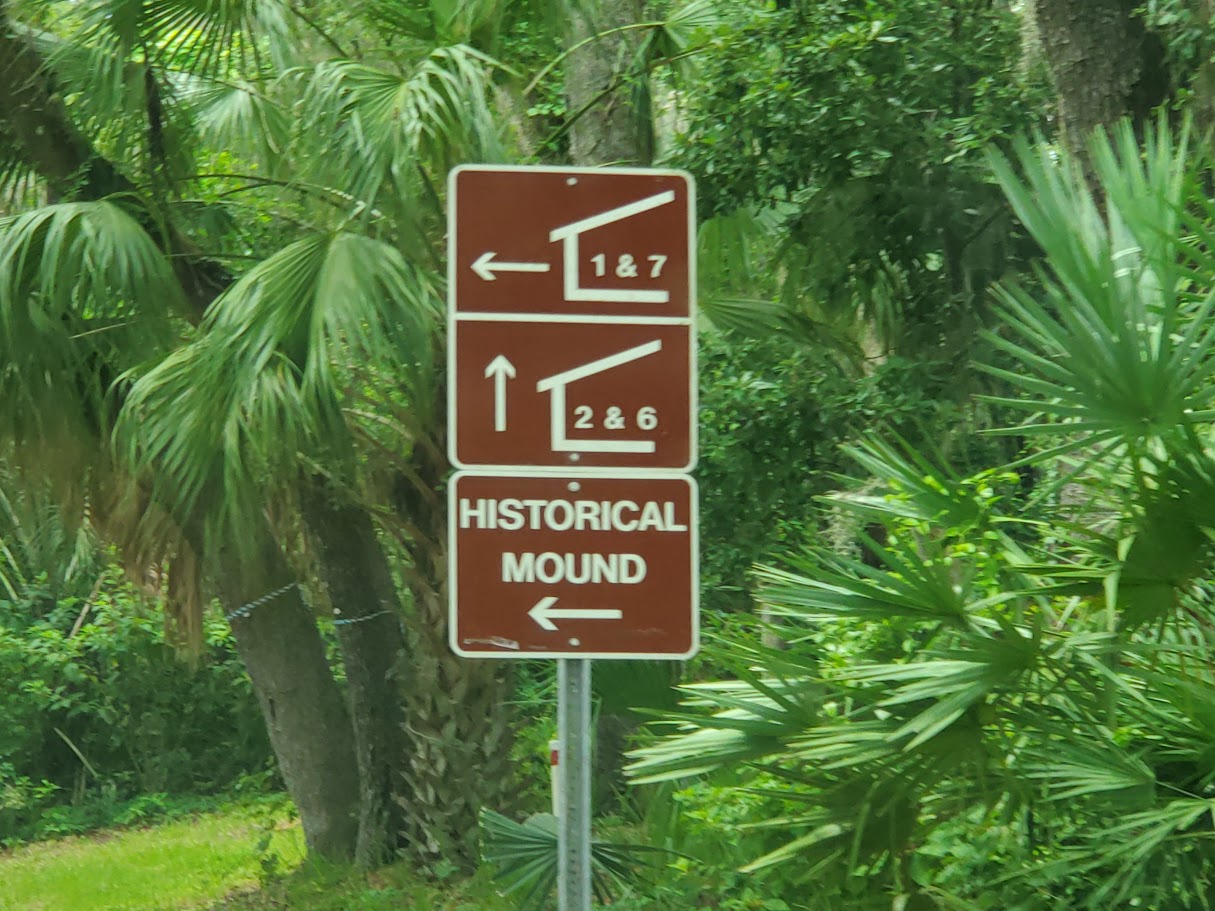
Tocobaga Temple Mound site photo by Damien Marie AtHope
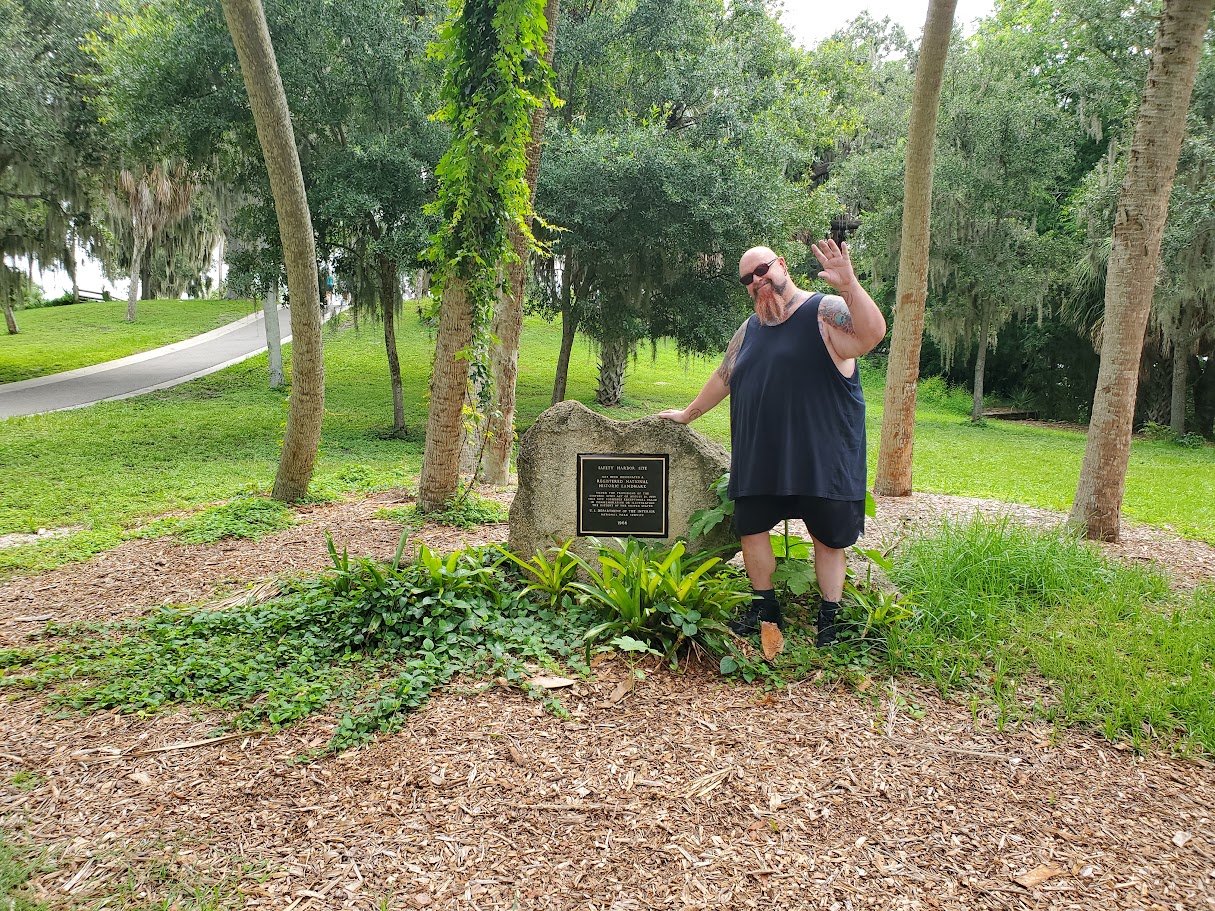
Tocobaga Temple Mound site photo by Shayna Marie AtHope
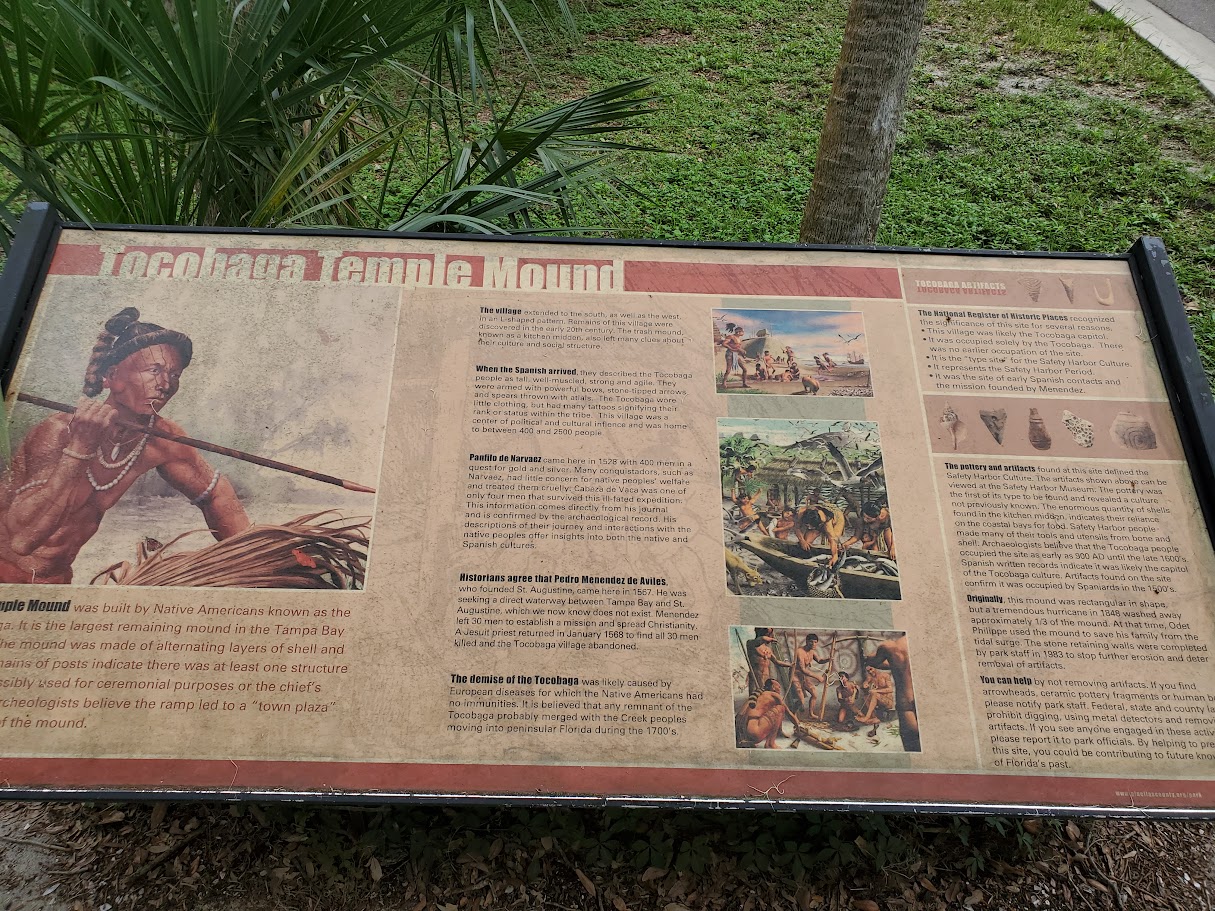
Tocobaga Temple Mound site photo by Damien Marie AtHope
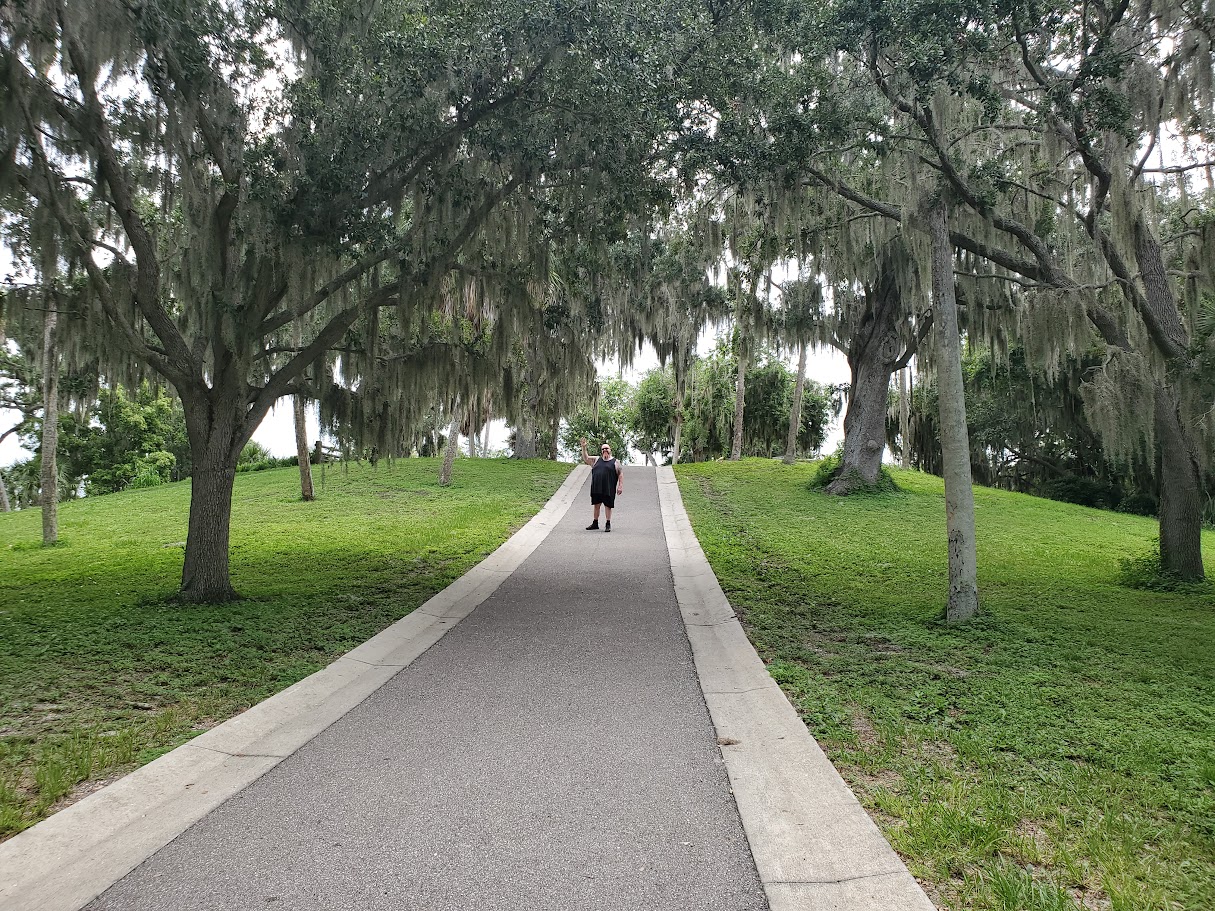
Tocobaga Temple Mound site photo by Shayna Marie AtHope

Tocobaga Temple Mound site photo by Damien Marie AtHope
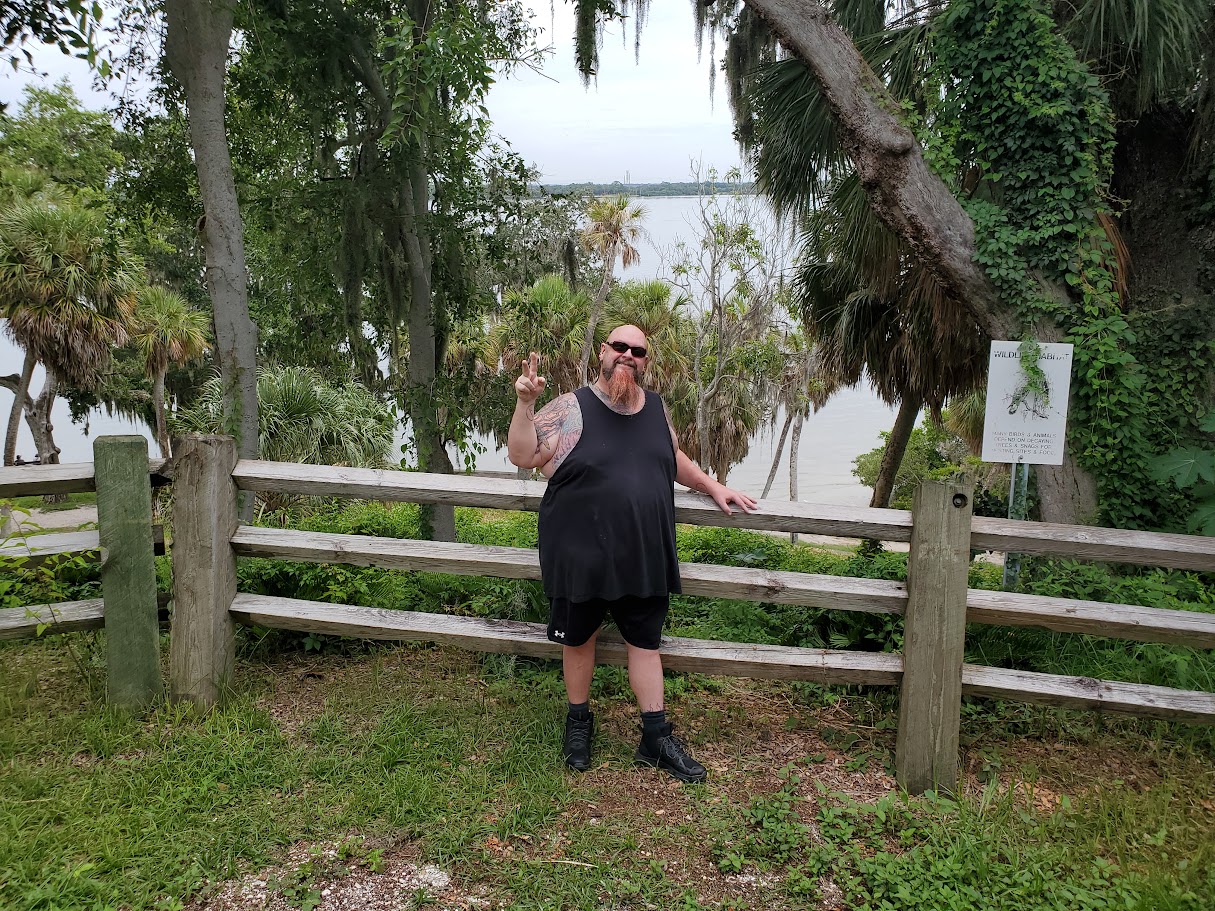
Tocobaga Temple Mound site photo by Shayna Marie AtHope
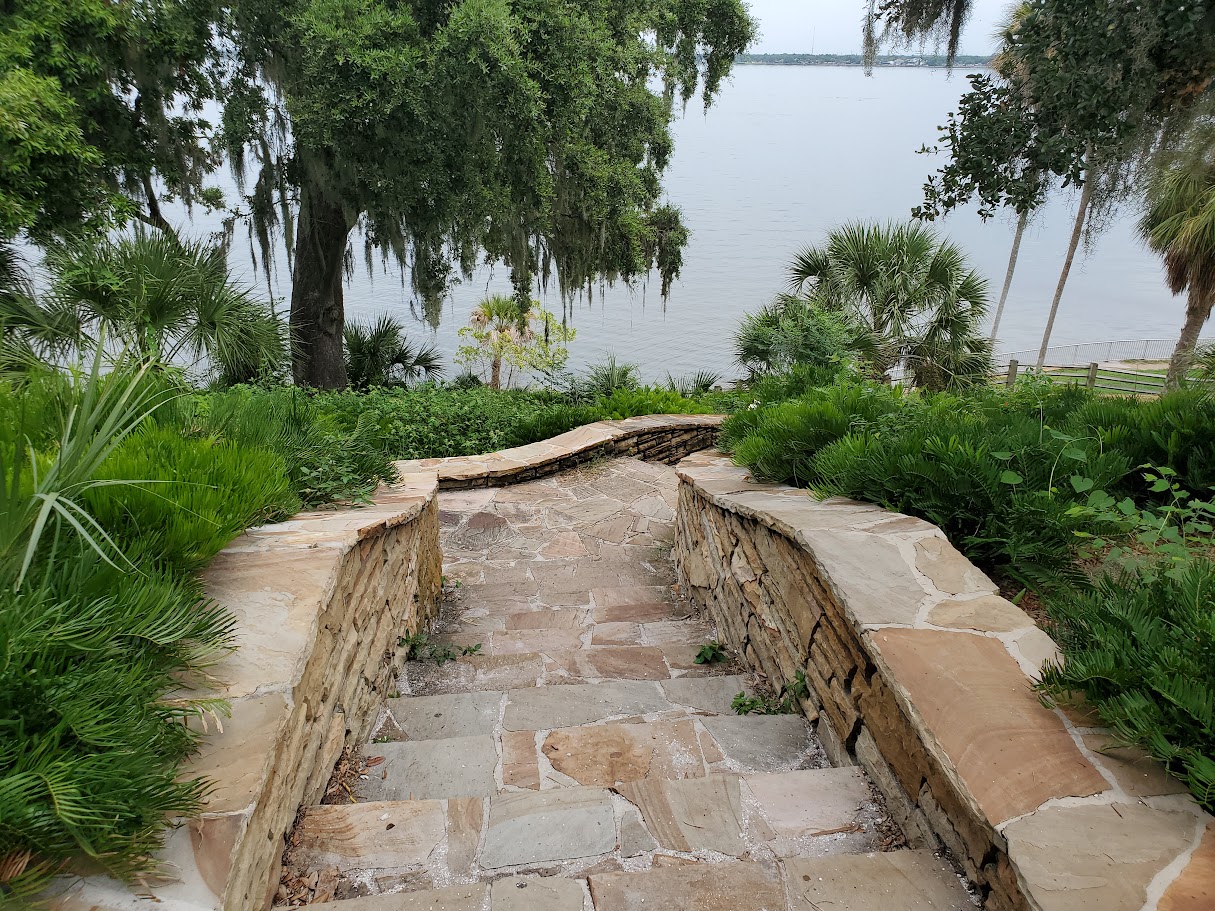
Tocobaga Temple Mound site photo by Damien Marie AtHope
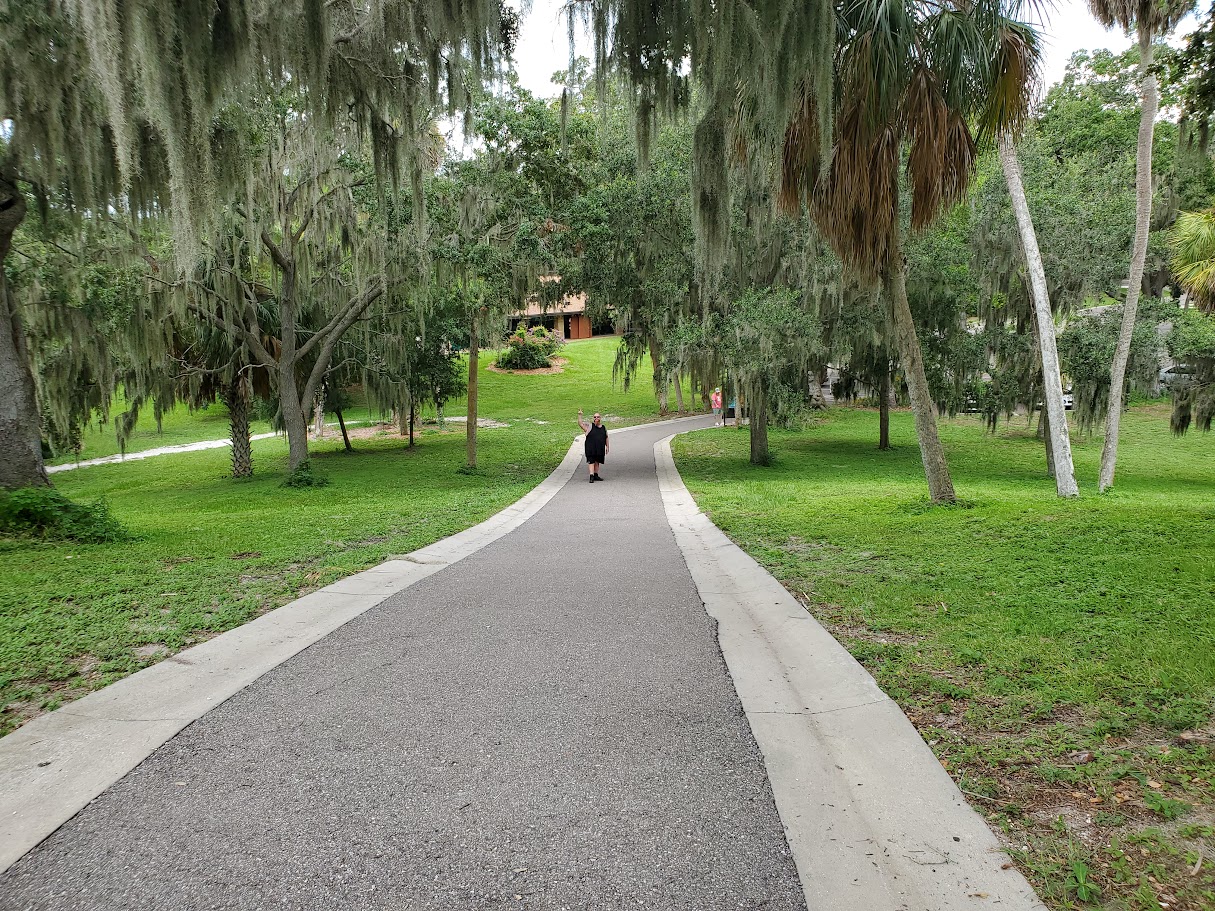
Tocobaga Temple Mound site photo by Shayna Marie AtHope
“A Tocobaga Indian mound that is situated in the park is a National Historic Landmark known as the Safety Harbor Site. The temple mound is one of the last remaining examples of the Tocabaga civilization on the Pinellas Peninsula. Records indicate that in 1566, Pedro Menendez de Aviles, the founder of St. Augustine (1565), visited the site to help broker a truce between the Tocobago and the Culusa tribe to the south. On your next visit to Philippe Park make sure you climb to the top to experience a spectacular view of Old Tampa Bay.” ref
“The site was built by Indigenous People; and reportedly served as capital for the so-called “Tocobaga Chiefdom” and was a village featuring initially a large 20-foot Temple Mound, a smaller burial mound, and two large shell mounds. Archaeologists say that likely a ramp led to a “town plaza” at the base of the mound, and first-of-a-kind artifacts were recovered at the site revealing a culture not previously identified.” ref
“One thousand years ago, Tocabaga Indians gathered here by the hundreds to feast on oysters and clams, the shells of which helped build up the very ground you can see rising 16 feet before you at the Safety Harbor Indian Mound Site. If you could travel back in time 1,000 years, and get a bird’s-eye view, you would see the Tocabaga Indians working and playing in the very same waters that attract visitors today.” ref
“The Temple Mound–at Philippe Park in Safety Harbor–was built by Native Americans known as the Tocobaga. It is the largest remaining mound in the Tampa Bay region. The mound was made of alternating layers of shell and sand. Remains of posts indicate there was at least one structure on top, possibly used for ceremonial purposes or the chief’s dwelling. Archeologists believe the ramp led to a “town plaza” at the base of the mound. The village extended to the south, as well as the west, in an L-shaped pattern. Remains of this village were discovered in the early 20th century. The trash mound, known as a kitchen midden, also left many clues about their culture and social structure.” ref
“When the Spanish arrived, they described the Tocobaga people as tall, well muscled, strong and agile. They were armed with powerful bows, stone-tipped arrows and spears thrown with atlatls. The Tocobaga wore little clothing, but had many tattoos signifying their rank or status within the tribe. This village was a center of political and cultural influence and was home to between 400 and 2500 people. Pan lo de Narvaez came here in 1528 with 400 men in a quest for gold and silver. Many conquistadors, such as Narvaez, had little concern for native peoples’ welfare and treated them cruelly. Cabeza de Vaca was one of only four men that survived this ill-fated expedition. This information comes directly from his journal and is confirmed by the archaeological record. His descriptions of their journey and interactions with the native peoples offer in sights in to both the native and Spanish cultures.” ref
“Historians agree that Pedro Menendez de Aviles, who founded St. Augustine, came here in 1567. He was seeking a direct waterway between Tampa Bay and St. Augustine, which we now know does not exist. Menendez left 30 men to establish a mission and spread Christianity. A Jesuit priest returned in January 1568 to find all 30 men killed and the Tocobaga village abandoned. The demise of the Tocobaga was likely caused by European diseases for which the Native Americans had no immunities. It is believed that any remnant of the Tocobaga probably merged with the Creek peoples moving into peninsular Florida during the 1700’s.” ref
“The significance of this site for several reasons.
- This village was likely the Tocobaga capitol.
- It was occupied solely by the Tocobaga.
- There was no earlier occupation of the site.
- It is the “type site” for the Safety Harbor Culture.
- It represents the Safety Harbor Period.
- It was the site of early Spanish contacts and the mission founded by Menendez.” ref
“The pottery and artifacts found at this site defined the Safety Harbor Culture. The artifacts shown above can be viewed at the Safety Harbor Museum. The pottery was the first of its type to be found and revealed a culture not previously known. The enormous quantity of shells found in the kitchen midden, indicates their reliance on the coastal bays for food. Safety Harbor people made many of their tools and utensils from bone and shell. Archaeologists believe that the Tocobaga people occupied the site as early as 900 AD until the late 1600’s. Spanish written records indicate it was likely the capitol of the Tocobaga culture. Artifacts found on the site confirm it was occupied by Spaniards in the 1500’s.” ref
“The Safety Harbor culture was an archaeological culture practiced by Native Americans living on the central Gulf coast of the Florida peninsula, from about 900 CE until after 1700. The Safety Harbor culture is defined by the presence of Safety Harbor ceramics in burial mounds. The culture is named after the Safety Harbor site, located close to the center of the culture area. The Safety Harbor site is the probable location of the chief town of the Tocobaga, the best known of the groups practicing the Safety Harbor culture. The Safety Harbor people were organized into chiefdoms and lived primarily in villages along the shoreline of Tampa Bay and the adjacent Gulf of Mexico coast. The chiefdoms may have consisted of about 15 mi (24 km) of shoreline, and extended about 20 mi (32 km) inland. Each chiefdom had a principal town or “capital” with a temple mound and central plaza. Fifteen such towns have been identified along the Florida Gulf coast from southern Pasco County to northern Sarasota County, an area that includes all of the Tampa Bay area. Only one principal town has been found inland.” ref
“Descriptions of the villages by Spanish visitors mostly agree with archaeological reconstructions. Capitals had a central rectangular plaza. A truncated pyramidal mound up to 20 ft (6.1 m) high and up to 130 ft (40 m) long on each side at the base stood on one side of the plaza. One or more buildings stood on top of the mound, and a ramp ran from the top of the mound to the plaza. A burial mound would be located off to the side. A shell mound, or midden, ran along the shore, and other middens were sometimes located on other sides of the plaza. The plaza itself was kept clear of debris. The more important residents of the town had their houses around the plaza, while the lower class lived in huts further from the plaza. The Spanish reported that the chief and his family resided on the main mound, and that a “temple” (probably a charnel house) stood on the opposite side of the plaza. Archaeological excavations suggest that the charnel houses were on the mounds. Village sites without mounds, and isolated burial mounds, are also known.” ref
“Tocobaga (occasionally Tocopaca) was the name of a chiefdom of Native Americans, its chief, and its principal town during the 16th century. The chiefdom was centered around the northern end of Old Tampa Bay, the arm of Tampa Bay that extends between the present-day city of Tampa and northern Pinellas County. The exact location of the principal town is believed to be the archeological Safety Harbor site. This is the namesake for the Safety Harbor culture, of which the Tocobaga are the most well-known group. The name “Tocobaga” is often applied to all of the native peoples of the immediate Tampa Bay area during the first Spanish colonial period (1513–1763). While they were culturally very similar, most of the villages on the eastern and southern shores of Tampa Bay were likely affiliated with other chiefdoms, such as the Pohoy, Uzita, and Mocoso.” ref
“The study of archaeological artifacts has provided insight into the everyday life of the Safety Harbor culture. But, little is known about the political organization of the early peoples of the Tampa Bay area. The scant historical records come exclusively from the journals and other documents made by members of several Spanish expeditions that traversed the area in the 1500s. The Tocobaga and their neighbors disappeared from the historical record by the early 1700s, as endemic diseases carried by European explorers decimated the local population. They had no medical acquired immunity to these new diseases. Survivors were displaced by the raids and incursions of other indigenous groups from the north. The Tampa Bay area was virtually uninhabited for over a century.” ref
“The Tampa Bay area was visited by Spanish explorers during Florida’s early Spanish period. In 1528, an expedition led by Pánfilo de Narváez landed near Tampa Bay and soon skirmished with the indigenous population, probably at the principal town of the Tocobaga at the Safety Harbor site. Several years later, the Hernando de Soto Expedition likely landed on the southern shore of Tampa Bay in 1539, and passed through the eastern part of Safety Harbor territory after occupying the village of Uzita.” ref
“Garcilaso de la Vega (known as el Inca), in his history of de Soto’s expedition, relates that Narváez had ordered that the nose of the chief of Uzita be cut off, indicating that the two explorers had passed through the same area. Another town near Uzita encountered by de Soto was Mocoso, but evidence suggests that, while Mocoso was in the Safety Harbor culture area together with Uzita and Tocobaga, the Mocoso people spoke a different language, possibly Timucua. Neither Narvaez nor de Soto remained in the area for long, as they each traveled north in search of gold after several violent encounters with the Tocobaga and their neighbors.” ref
“The missionary expedition of Father Luis de Cancer visited the Tampa Bay area in 1549 to attempt to peacefully convert the locals to Christianity. He intended to build a relationship between the Spanish and indigenous Floridians in the aftermath of earlier visits by aggressive conquistadors. Despite being cautioned to avoid the Gulf Coast, Father Cancer’s expedition came ashore just south of the mouth of Bahia Espiritu Santo (Tampa Bay) in May 1549. There they encountered apparently peaceful and receptive Natives who told them of the many populous villages around Tampa Bay. Father Cancer decided to continue north to visit these towns and was met with violent resistance. Most members of the expedition were killed or captured, and Father Cancer was clubbed to death soon after reaching modern day Pinellas County.” ref
“Hernando de Escalante Fontaneda, a shipwreck survivor who lived with the Natives of southern Florida from 1549–1566 and was rescued from the Calusa by Pedro Menéndez de Avilés, described Tocobaga, Abalachi (Apalachee) and Mogoso (Mocoço) as “separate kingdoms” from the Calusa. Ucita and Mocoço at the time of de Soto’s visit were subject to a chief named Urriparacoxi or Paracoxi (also given as Urribarracuxi). De Soto marched to the town of Paracoxi, which appears to have been inland from Tampa Bay, where he found maize being cultivated. (By contrast, the Safety Harbor people made little or no use of maize, and instead gathered most of their food and resources from the bountiful coastal waters.)” ref
“The name “Tocobaga” first appears in Spanish documents in 1567, when Pedro Menéndez de Avilés visited what was almost certainly the Safety Harbor site. Menéndez had contacted the Calusa and reached an accommodation with Carlos, the Calusa king. Menéndez married Carlos’s sister. As Carlos was anxious to gain an advantage over his enemy Tocobaga, Menéndez took Carlos and 20 of his warriors to Tocobaga by ship. Menéndez persuaded Tocobaga and Carlos to make peace. He recovered several Europeans and a dozen Calusa being held as slaves by Tocobaga. Leaving a garrison of 30 men at Tocobaga ( to encourage the people of the town to convert to Christianity), he returned Carlos and the other Calusa to their town. In January 1568, Spanish boats taking supplies to the garrison at Tocobaga found the town deserted, and all the Spanish soldiers dead.” ref
“In 1608 an alliance of Pohoy and Tocobaga may have threatened Potano people who had converted to Christianity. In 1611 a raiding party from the two chiefdoms killed several Christianized Natives carrying supplies to the Spanish mission (Cofa) at the mouth of the Suwannee River. In 1612, the Spanish launched a punitive expedition down the Suwannee River and along the Gulf coast, attacking Tocobaga and Pohoy, and killing many of their people, including both chiefs. The Tocobaga were weakened by the Spanish attack, and the Pohoy became the dominant power in Tampa Bay for a while. In 1677 a Spanish official inspecting the missions in Apalachee Province visited a village of Tocobaga people living on the Wacissa River one league from the mission of San Lorenzo de Ivitachuco. There is no record of when the Tocobaga settled on the Wacissa River, but they appear to have been there for a while.” ref
“When the Spanish official criticized the Tocobaga for having lived in a Christian province “for many years” without having converted, they replied that no one had come to teach them about Christianity, but that some twenty of their people had converted on their death beds and been buried at the mission in Ivitachuco. The Tocobaga were engaged in transporting produce from Apalachee Province to St. Augustine, carrying it in canoes along the coast and up the Suwannee River and, probably, the Santa Fe River. Other people carried it overland the rest of the way to St. Augustine. The village was listed again in 1683, but it is not clear what happened when Apalachee Province was overrun by English Carolinian colonists and their Native allies in 1704. When the Spanish returned to San Marcos de Apalachee in 1718, they found a few Tocobaga living along the Wacissa River. The Spanish commander persuaded the Tocobaga to move to the mouth of the St. Marks River under the protection of a battery.” ref
“In August that year 25 to 30 Pohoy attacked the Tocobaga settlement, killing eight and taking three away as captives. A small number of Tocobaga continued to live in the vicinity of San Marcos through the 1720s and 1730s. The population of Tocobaga declined severely in the 17th century, due mostly to the spread of infectious diseases brought by the Europeans, to which the native people had little resistance, as they had no acquired immunity. In addition, all of the Florida tribes lost population due to the raids by the Creek and Yamasee around the end of the 17th century. Remnants of the Calusa, who lived to the south of the Tocobaga, were forced into extreme southern Florida. As Florida transitioned to British rule in 1763 following its defeat of France in the Seven Years’ War, the Calusa emigrated with the evacuating Spanish, resettling with them in Cuba, possibly along with the remnants of the Tocobaga. In any case, the Tocobaga disappeared from historical records in the early 18th century.” ref
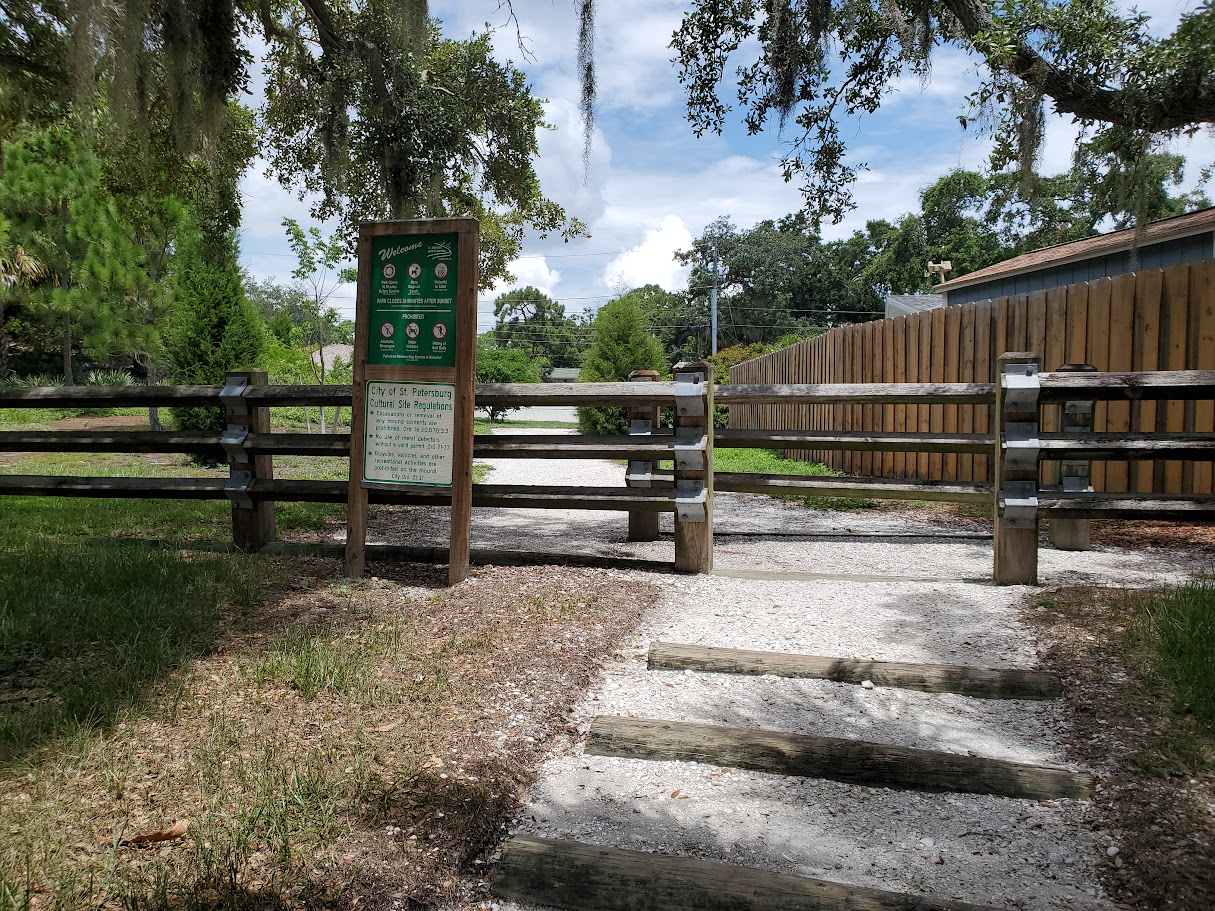
Indian Burial Mounds site photo by Damien Marie AtHope
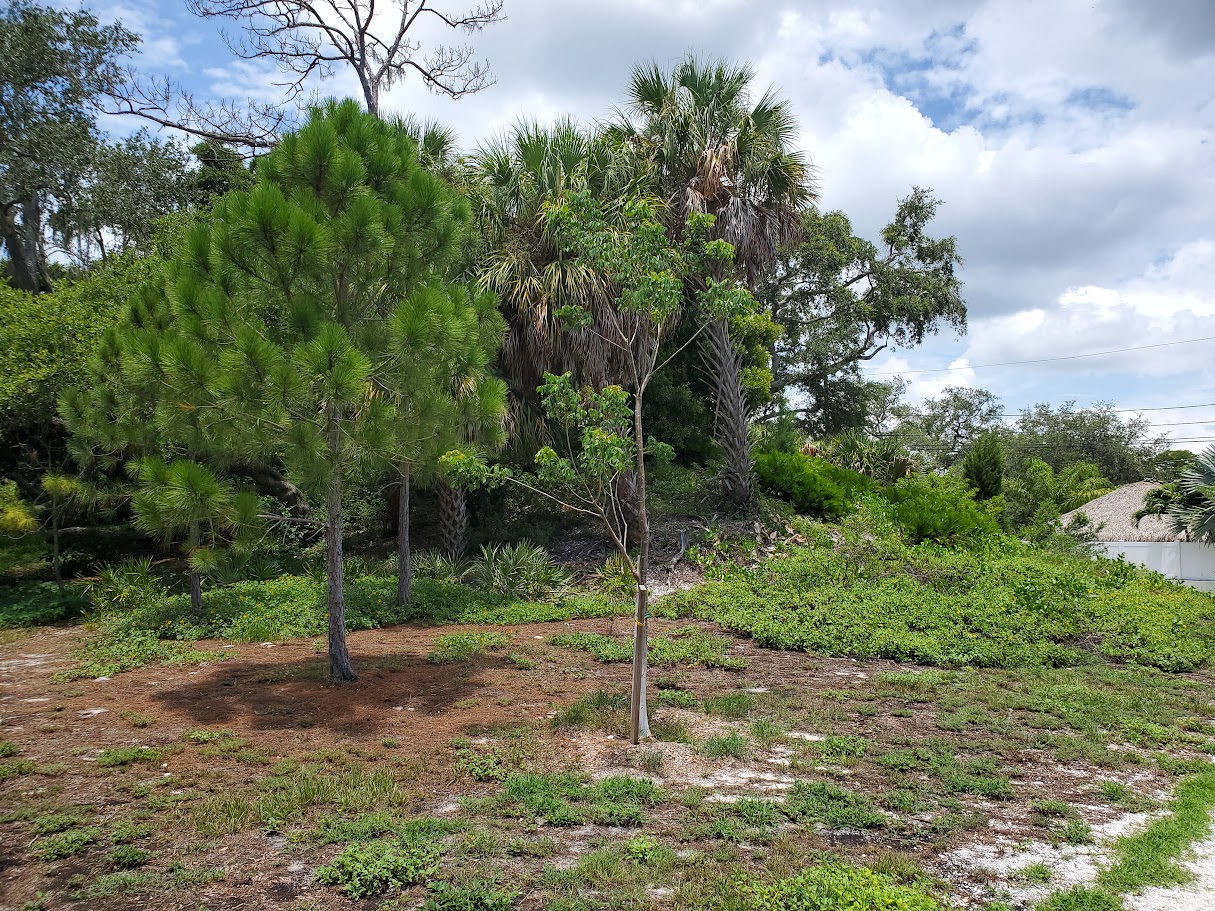
Indian Burial Mounds site photo by Damien Marie AtHope
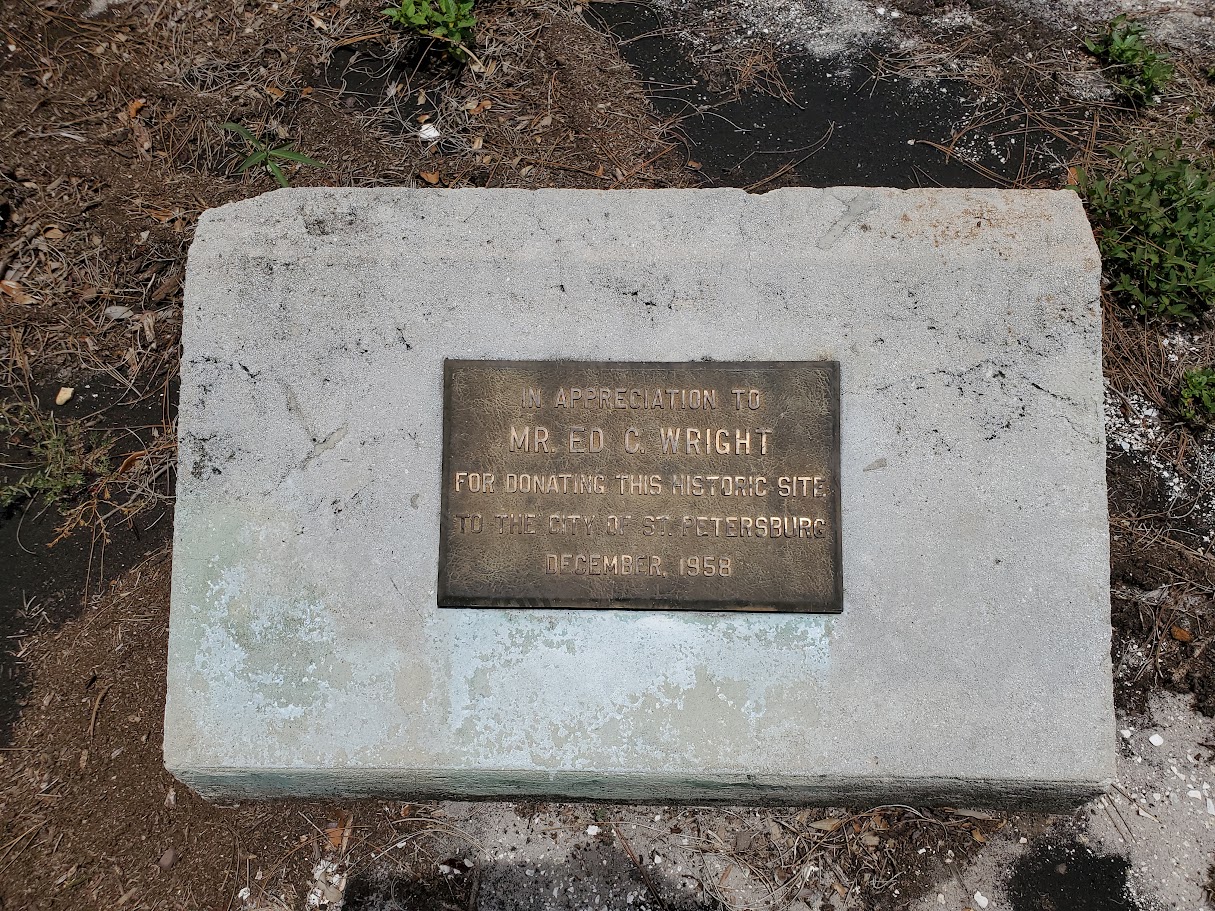
Indian Burial Mounds site photo by Damien Marie AtHope
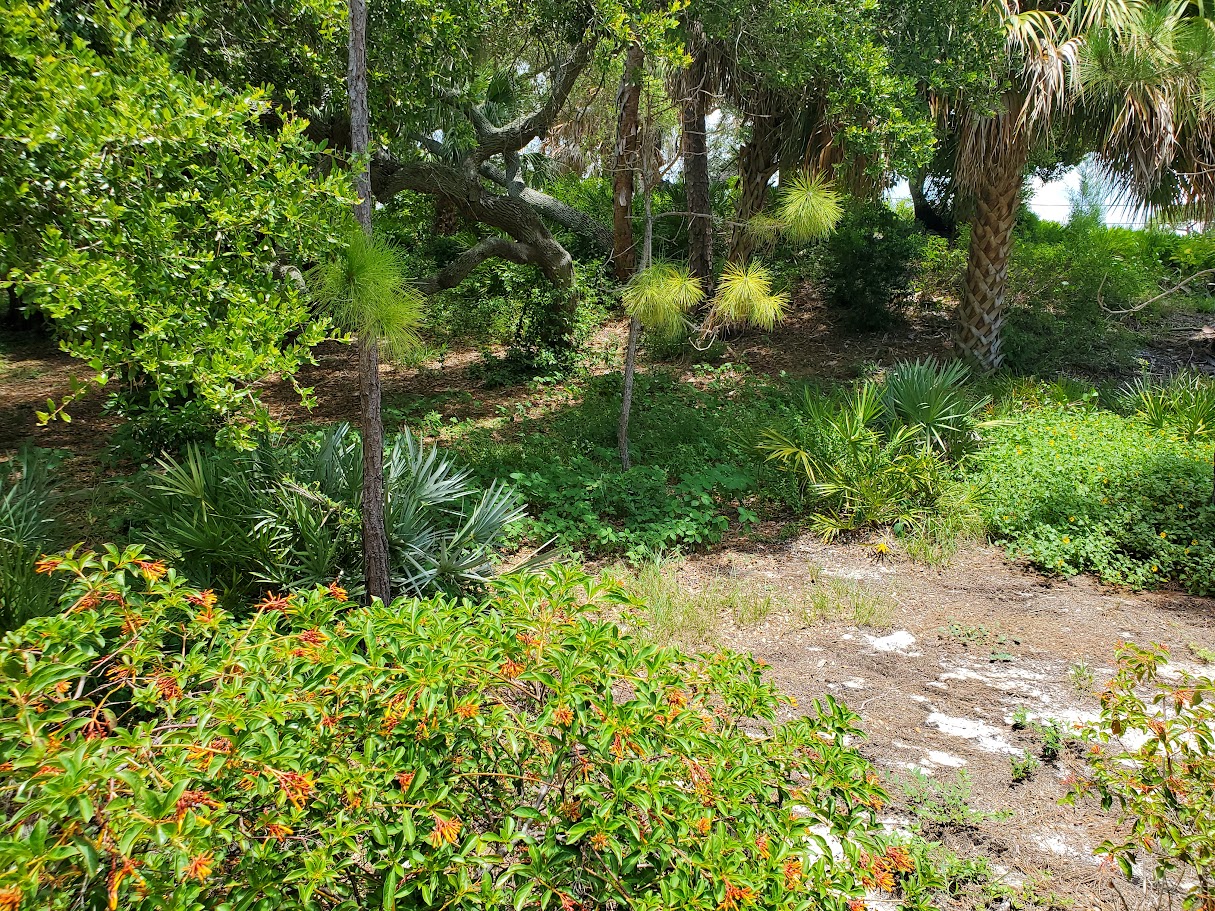
Indian Burial Mounds site photo by Damien Marie AtHope
“Pinellas Point Mound is a temple mound. It is located inside Indian Mound Park in St. Petersburg, FL. The Princess Hirrihigua Indian Mound, which was originally created by the Tocobaga, is at the center of the park. There is a historical marker near the mound which was erected in 1960 by the Princess Hirrihigua Chapter of the Daughters of the American Revolution. The site was donated to the city of St. Petersburg, FL by Mr. Ed C. Wright in 1958. The University of South Florida Libraries have created a reconstruction of the Pinellas Point Mound to show what the mound looked like prior to being partially destroyed in 1929. The reconstruction was based on an 1880 survey and a 2014 terrestrial laser scanning survey. While there are reports that human remains were removed from the area in the 1880s, it remains unclear whether there are more mounds in the park.” ref
“According to survey reports, this site is significant based on the unique pottery designs found and the methods used for constructing elaborate ceremonial and burial mound systems which are associated with the so-called “Weeden Island and Safety Harbor cultures”. Archaeological records also suggest this temple mound was built by Indigenous People called “Tocobaga” who lived in “Pinellas County” and the “Tampa Bay” region. It was thought to have served as the Chief’s abode and used for storing ceremonial objects. Additionally, the site became known for the legend regarding the Chief’s daughter, Princess Hirrihigua, when she joined other women of the village to spare the life of an explorer—a story similar to the Pocahontas legend. An onsite marker describes the ‘History of Hirrihigua.” ref
“Located near the southernmost shore of the peninsula, the “Pinellas Point” Temple Mound stands about 17 feet tall and has a flat top measuring about 104 feet long and 19 feet wide on each end, with a center area of about 29 ft where an access ramp might have been placed. The mound is said to be composed of alternate layers of sandy soil and shells, and its oblong base area measures about 49 by 154 feet. Reportedly, the site was mapped in 1880 showing its full extent and ramp feature to the south; however, in 1929, a portion of this location was removed to construct “property” to the west, so the mound is smaller than its original size.” ref
“Visually appreciating our surroundings, we experienced peacefulness just being in a natural environment of wonderful trees, shrubs and plants gracing the surface of this sacred mound structure. We observed tall sabal palms, carrotwoods, pine trees, saw palmettos, and sword ferns, as well as loads of leafy green vines and other invasive and indigenous vegetation. Amid the dense foliage, we noted what looks like coontie plants, which are described as cycads or living fossils (ancient plants like ferns). Reportedly, Indigenous People exercised care when processing the roots of this plant to make a starchy paste that was dried and used as bread flour.” ref
“Later, several mills began processing coonties for the starch industry, producing what was known as “Florida Arrowroot.” Also, this plant is necessary for survival of the rare Atala butterfly. What an attractive addition to the scenery. Climbing to the top of the mound, we paused to review signage about the presence of “Calusa” culture in the area and telling about the tragic story involving a French friar and the Natives. The canvassing view from on top of the mound is wonderful and we proudly embrace the sensation of connecting with Ancestral Moors as we honor their legacy.” ref
“Before St. Petersburg was the Sunshine City, some early promoters tested a less beachy moniker: The City of Mounds. It might be surprising to learn that the area was dotted with Native American mounds of all sizes and shapes, most notably a complex of a least a dozen mounds close to the Tampa Bay shoreline around the vicinity of Booker Creek, Bayboro Harbor, and Mound Park Hospital, better known today as Bayfront Health St. Petersburg. According to Robert J. Austin in an article published by the Florida Anthropological Society, the Shell Mound at Mound Park Hospital – estimated to be about 20-25-feet tall with a diameter of 90-feet – was one of the most photographed mounds in Florida and a prominent tourist attraction for the growing City of St. Petersburg. In fact, at one time, there was even a staircase for visitors to climb to the top.” ref
“To get a sense of what the shell mounds might have looked like, take a short drive to the Pink Streets in South St. Pete and see what is left of the Pinellas Point Temple Mound. This prominent mound rises above the rooftops of nearby homes. It is also said to be the location of the fascinating tale of the explorer Juan Ortiz, who was sent to find his missing contemporary Panfilo de Narvaez. Distrusting of the Spanish, Tocobagan Chief Hirrihigua condemned Ortiz to death. His daughter, Princess Hirrihigua intervened, sparing Ortiz, setting off a series of close calls until Ortiz was rescued by Hernando de Soto. We can say these events literally happened in our backyards. The story of the city’s mounds has been told and retold so often, to varying degrees of accuracy, that it’s hard to separate fact from legend, especially since nearly all of the mounds were leveled over the years, including the Shell Mound, which was demolished in the 1950s as part of a hospital expansion project. How the mounds came to be here and what they represented is still subject to the shifting sands of history.” ref
“Early settlers told wild stories of a society of extremely tall and docile people. “Tall” tales aside, we know that the mounds were the work of indigenous cultures that lived in the area starting as far back as 5,000-to-7,000 years ago. The Tocobaga, who were living here when Spanish explorers arrived in the 1500s, had been occupying the Tampa Bay area for around 1,000 years. Their villages stretched from Port Charlotte up to Pasco County. Most of St. Petersburg’s shell middens were primarily composed of piles of discarded oyster shells (a main part of the Native American diet) and other byproducts of daily life. But some were burial sites or ceremonial temple sites. Unfortunately, before they could be examined, the majority of them were destroyed, their materials used to fill in the ruts from wagon wheels of horse-drawn carriages. Later, the shells served as fill material for city streets. No one gave much thought to preserving them until there were just a few left.” ref
“Fortunately, there are still a few remaining mounds that can be seen. In addition to the Pinellas Point Temple Mound Park, there are mounds at Abercrombie Park (Park Street and 38th Avenue North), Jungle Prada De Narvaez Park (Park Street and Elbow Lane North), and Maximo Park (Sunshine Skyway Lane South and Pinellas Point Drive South). The city’s park and recreation department preserves and maintains each of these sites. A few years ago, the city partnered with the University of South Florida to document the mounds using 3D survey technology. Go to www.stpeteparksrec.org/historicsites for a virtual tour and more information. There are even remnants of a mound right here in the Old Northeast neighborhood. Behind the Renaissance Vinoy Hotel is Baywood Park, along Beach Drive between 6th and 7th Avenue. Look closely and the undulating land hints at the fact that what looks like a vacant lot is in fact, an historical site. Early accounts mention a “natural ravine” and a spring on the land that stretched all the way from Beach Drive to the water and includes the area that we know today as Vinoy Park.” ref
“Weedon Island is yet another area of historical interest. Today, Weedon Island is part of a 3,700-acre nature preserve on Old Tampa Bay. But between 1,000 and 1,800 years ago, it was the site of a flourishing Native American village with extensive shell middens and temple-mound formations. Portions of the preserve are now on the National Register of Historic Places. In 2011, an ancient dugout canoe dating back to between 690 and 1010 CE was excavated from the area. The canoe is on display in the Weedon Island Preserve Welcome Center.” ref
“But, not all of the artifacts found on Weedon Island artifacts have remained in St. Petersburg. In the early 1900s, archeologists from the Smithsonian Institute studied Weedon Island’s mounds and recovered the remains of over 400 Native Americans, along with ancient indigenous tools and pottery. In accordance with the practice of the time, these artifacts – including the remains – were boxed up and taken for study in Washington, DC. The vast majority of these remains are still in their custody.” ref
“Present day Florida Native Americans have been fighting a battle to recover the remains of those ancestors unearthed a century ago by archeologists. Efforts to repatriate the remains of America’s first people have been ongoing for a generation. The Seminole Indians in Florida found that the repatriation process was stacked against them for a few reasons. First, the Seminoles are a rare example of a tribe that never signed a treaty with the US. Second, the Seminoles are a mix of Creek Indians from Georgia and the Carolinas, runaway slaves, and any remaining descendants of the Tocobaga and other indigenous tribes. The US government denied the Seminoles cultural affiliation, which meant any artifacts from early Native American Indian culture could be held by the Smithsonian.” ref
“But, in keeping with their unconquered reputation, the Seminoles persevered. On October 5, 2020, after decades of pressure from the Seminoles and other tribes, the Smithsonian announced a major policy change and will accept requests to repatriate remains, even if they don’t fit the museum’s long-standing definition of “cultural affiliation.” With thousands of unaffiliated remains in their possession, it will still take time for remains collected by the Smithsonian at Weedon Island and other locations in Florida to make their way to their descendants. But there is a day within sight that these remains will be released from bureaucratic limbo to a burial consistent with their culture. Whether the mounds were studied by archaeologists, shoveled into a muddy swale, or spread beneath red Augusta Block on city streets, St. Pete’s early indigenous residents are still making history.” ref
“At least 8 other markers are within 4 miles of this marker, measured as the crow flies. St. Bartholomew’s Church (approx. 2½ miles away); Miranda Home (approx. 3.1 miles away); First Settlement and Post Office (approx. 3.1 miles away); Osgood Point / Clam Bayou Nature Preserve (approx. 3.3 miles away); Veterans Memorial (approx. 3.8 miles away); Steven Jay Robin (approx. 3.8 miles away); Gulfport Casino (approx. 3.8 miles away); Almon Brown Strowger (approx. 4 miles away). Touch for a list and map of all markers in St. Petersburg.” ref
Princess Hirrihigua
“In 1526 Juan Ortiz, a member of the expedition sent from Cuba to find Panfilo De Narvaez, was captured by Timucan Indians. Chief Hirrihigua, their ruler, hated the white men because of the violence of Narvaez. Juan Ortiz was condemned to death but Princess Hirrihigua, eldest daughter of the Chief, pleaded with her father and saved his life. Princess Hirrihigua saved Ortiz from death three times, and when his life was again in danger, she helped him escape to the sub-Timucan tribe of Chief Mucoso, her bethrothed. Chief Hirrihigua was so angered by the escape of Ortiz that he refused to allow Princess Hirrihigua to marry Chief Mucoso. In 1539 Hernando de Soto rescued Ortiz, who became his guide and interpreter.” ref
Juan Ortiz (captive)
“Juan Ortiz was a Spanish sailor who was held captive and enslaved by Native Americans in Florida for eleven years, from 1528 until he was rescued by the Hernando de Soto expedition in 1539. Two accounts of Ortiz’s eleven years as a captive, differing in details, offer a story of Ortiz being sentenced to death by a Native American chief two or three times, saved each time by the intervention of a daughter (and possibly other female relatives) of the chief, and finally escaping to a neighboring chiefdom, whose chief sheltered him.” ref
“In 1528 Juan Ortiz was on a ship searching Tampa Bay for any sign of the Narváez expedition which had landed in Tampa Bay the year before. Ortiz and one or more companions were enticed on shore by some people who had what the Spanish thought was a message from Narváez. (The Spanish would not learn the fate of the Narváez expedition for another eight years, until Álvar Núñez Cabeza de Vaca and three other survivors reached a Spanish outpost in northwestern New Spain.) Ortiz and his companions were captured by the people on shore and abandoned by their shipmates. All but Ortiz were either killed while resisting capture or shortly after being taken to the town of Uzita. After Ortiz was taken to the town of Uzita (as told by the Gentleman of Elvas), or some time after Ortiz was spared from execution by being shot with arrows (per the Inca), the chief ordered Ortiz tied to a rack set over a fire. The chief’s daughter begged the chief to spare Ortiz, arguing that Ortiz was not a danger to the chief.” ref
“After Ortiz’s burns had been tended to, he was set to guard bodies placed in the charnel house of the town, to keep predators from taking the bodies away during the night. One night a wolf took the body of a young child that had recently died. Ortiz pursued the wolf in the night and killed it, recovering the child’s body. The chief Uzita treated Ortiz better for a while after that. Two or three years after Ortiz had been captured, the chiefdom of Mocoso attacked Uzita, burning the town. The town of Uzita was then moved to a new location, and the chiefdom’s gods demanded that Ortiz be sacrificed. The daughter of Chief Uzita warned Ortiz that he was to be sacrificed and told him he should go to Mocoso, whose chief had asked for Ortiz to be given to him. The daughter led Ortiz out of the town at night, and showed him the path to Mocoso.” ref
“Juan Ortiz was found by the de Soto Expedition when they landed in Tampa Bay in 1539. After first landing at Uzita, de Soto and his men heard of a Christian living in a neighboring chiefdom. While searching for Ortiz, de Soto’s men encountered ten or so Native Americans, and started to attack them. Ortiz was with the group being attacked, but he managed to make the Spanish understand that he was a Christian (one account says he did so by calling out “Sevilla”, which was his home town). Ortiz then led the Spanish to the town of Mocoso, whose chief, also named Mocoso, had sheltered him for many years. Mocoso was friendly to de Soto, which created tension between Mocoso and other chiefdoms around Tampa Bay, including Orriygua, Neguarete, Capaloey, and Uzita.” ref
“Ortiz could speak the languages of both Uzita and Mocoso (which were mutually unintelligible). The language of Mocoso was apparently a dialect of the Timucua language, which made Ortiz very useful to de Soto. As the expedition traveled up the Florida peninsula, it passed through chiefdoms that spoke various dialects of the Timucua language, until the expedition crossed the Aucilla River, and entered the Apalachee Province. From that point the expedition relied on Timucua speakers who could translate from other languages, with Ortiz then providing a translation into Spanish. Juan Ortiz died sometime during the winter of 1541–1542, while the expedition was camped at the town of Autiamque in what is now Arkansas.” ref
“The Inca’s version of the story of Juan Ortiz and the daughter of Chief Hirrihigua has grown into a legend. The daughter of a chief has become “Princess Hirrihigua”, and in some versions has acquired a name, “Uleleh”. The Princess Hirrihigua Chapter of the Daughters of the American Revolution erected a marker in St. Petersburg, Florida, commemorating the story of Juan Ortiz and Princess Hirrihigua in 1960. A longer version of this legend, with the addition of the name “Uleleh”, “The Story of Juan Ortiz and Uleleh”, was published by a historical society in 1908. A children’s book, Uleyli- The Princess & Pirate: Based on the true story of Florida’s Pocahontas, was released in 2018 in both a black-and-white illustrated chapter book version and a full-color illustrated, abridged, junior graphic novel version. In these versions, the chief’s daughter’s name became “Princess Uleyli of Ucita in Hirrihigua Province” and the story is told from her perspective.” ref
“Some scholars have speculated that John Smith‘s story of being saved from death at the hands of Powhatan by his daughter Pocahontas was inspired by the story of Juan Ortiz being saved by the daughter of Chief Uzita. Richard Hakluyt‘s translation into English of A Narrative of the Expedition of Ferdinand de Soto into Florida by the Gentleman of Elvas was published in London in 1609, several years before John Smith published his account of being saved by Pocahontas.” ref
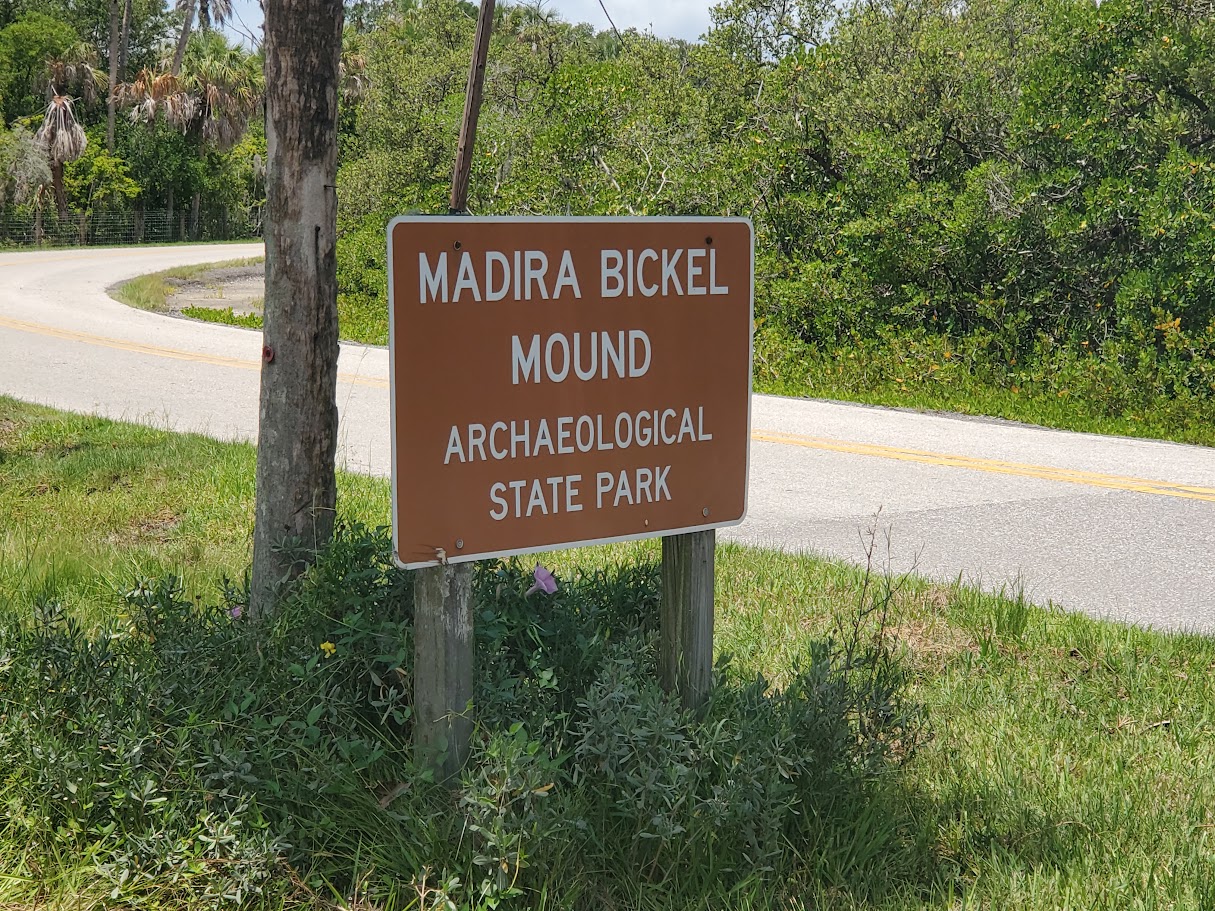
Madira Bickel Mound site photo by Damien Marie AtHope
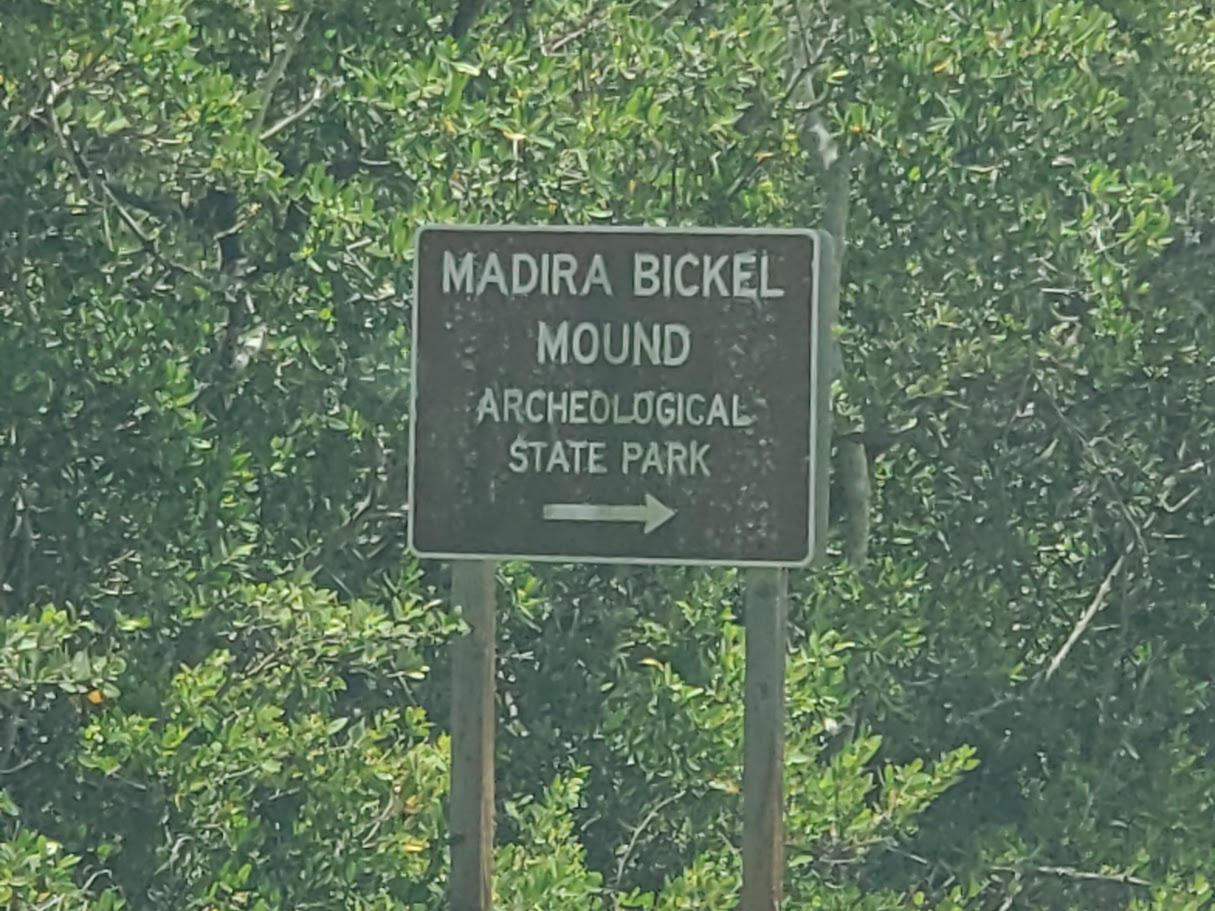
Madira Bickel Mound site photo by Damien Marie AtHope
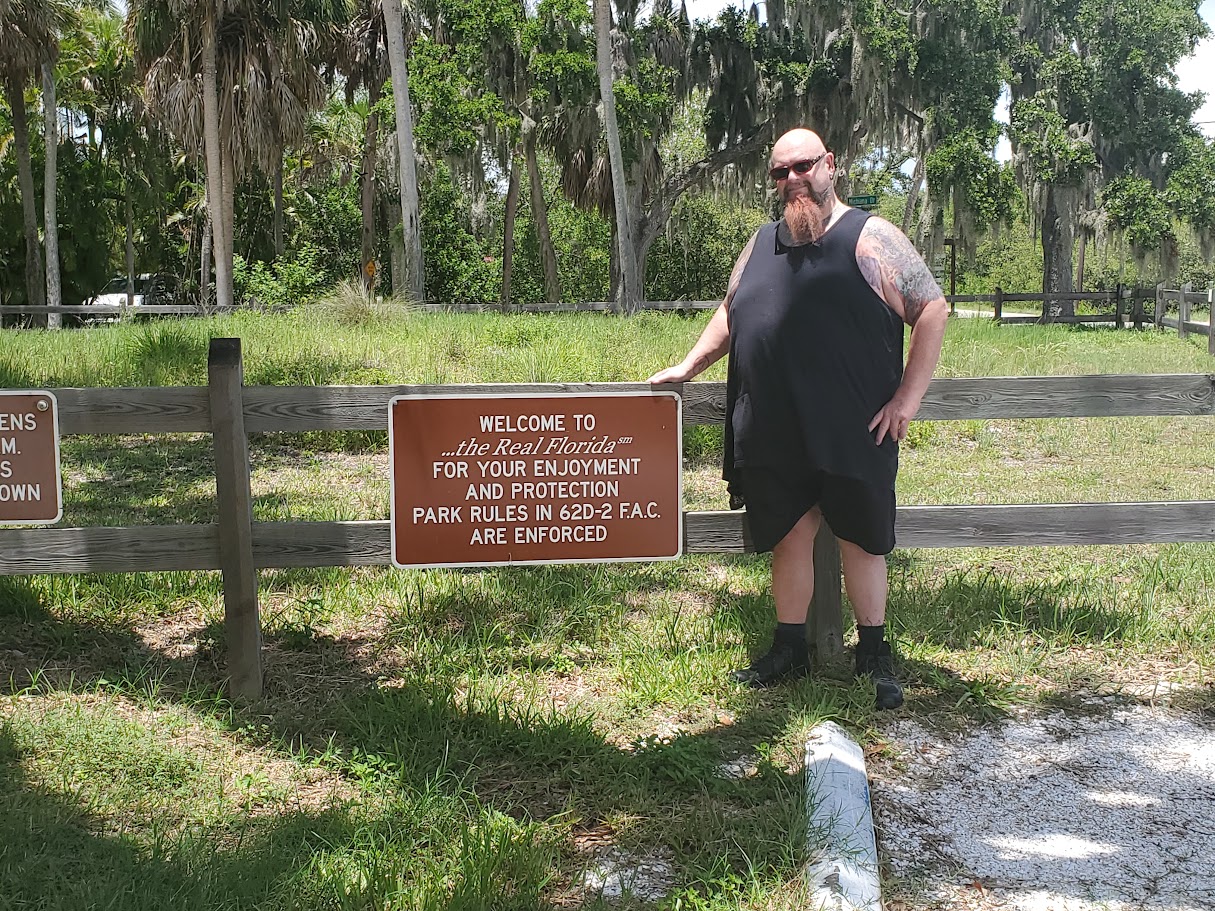
Madira Bickel Mound site photo by Damien Marie AtHope
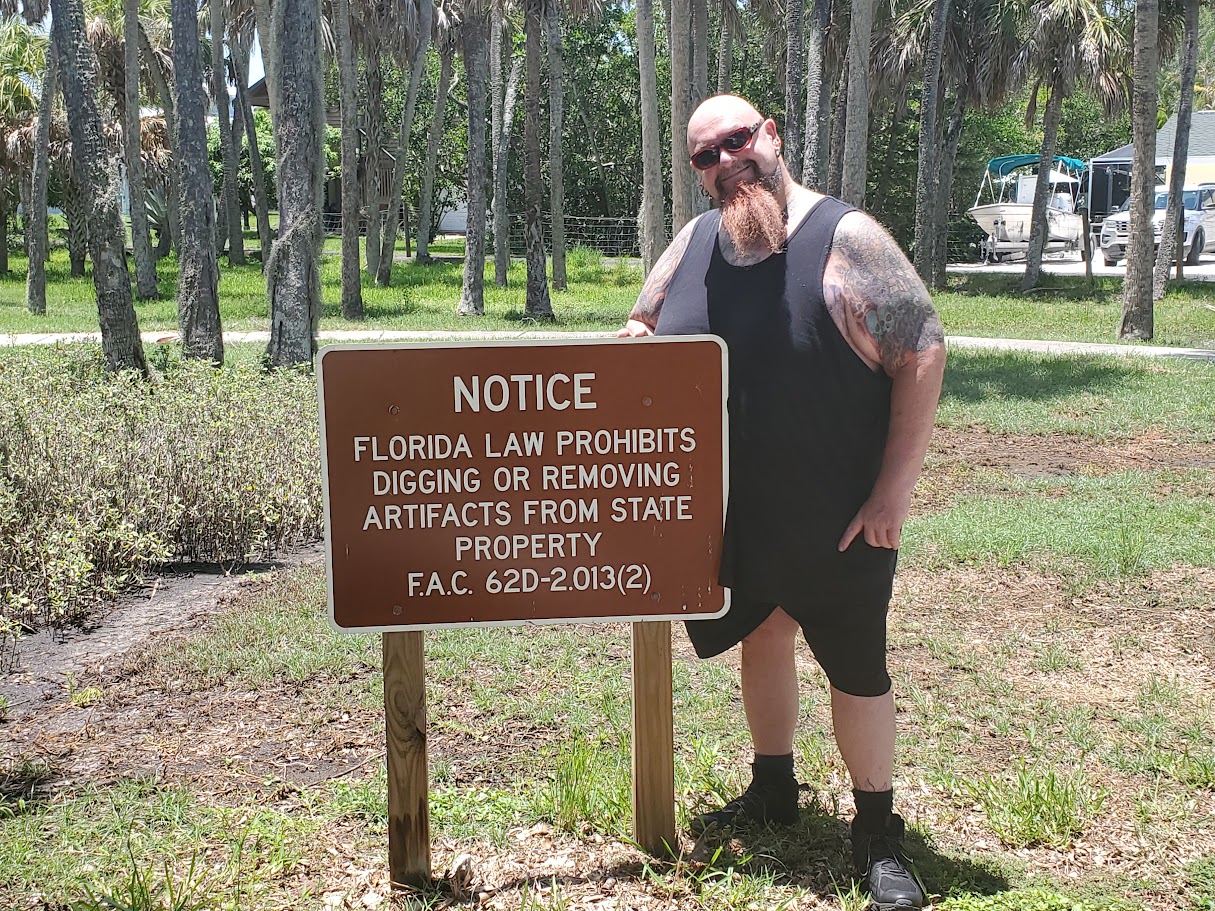
Madira Bickel Mound site photo by Damien Marie AtHope
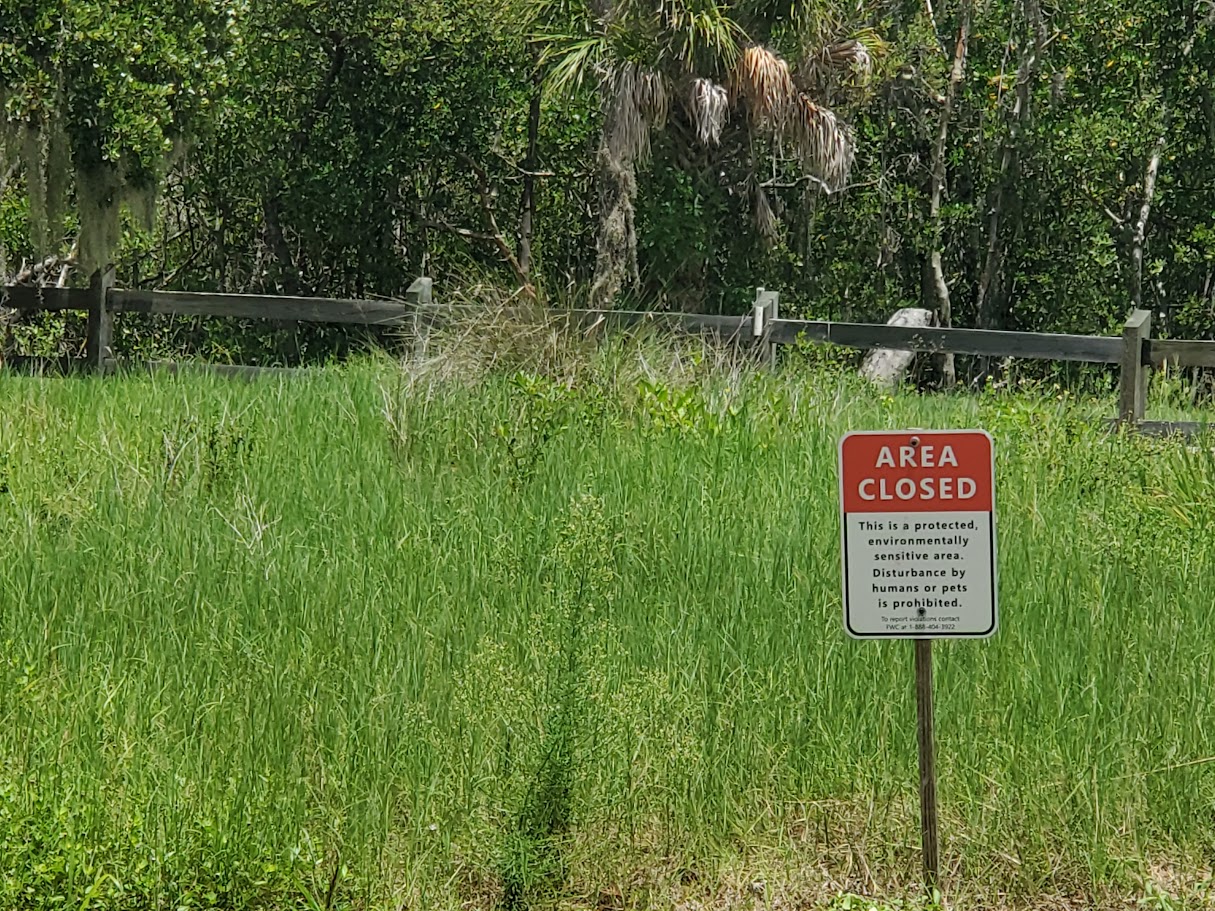
Madira Bickel Mound site photo by Damien Marie AtHope

Madira Bickel Mound site photo by Damien Marie AtHope
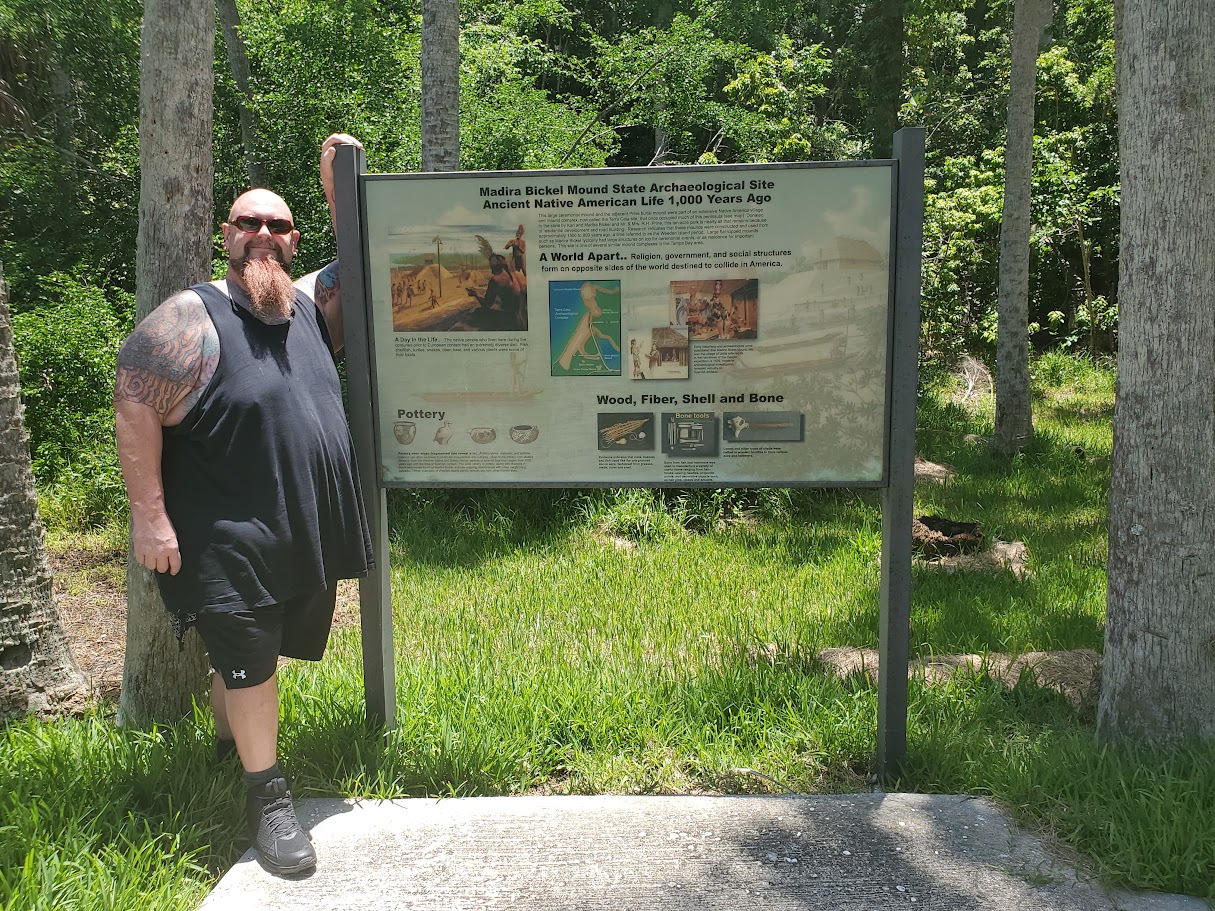
Madira Bickel Mound site photo by Damien Marie AtHope

Madira Bickel Mound site photo by Damien Marie AtHope
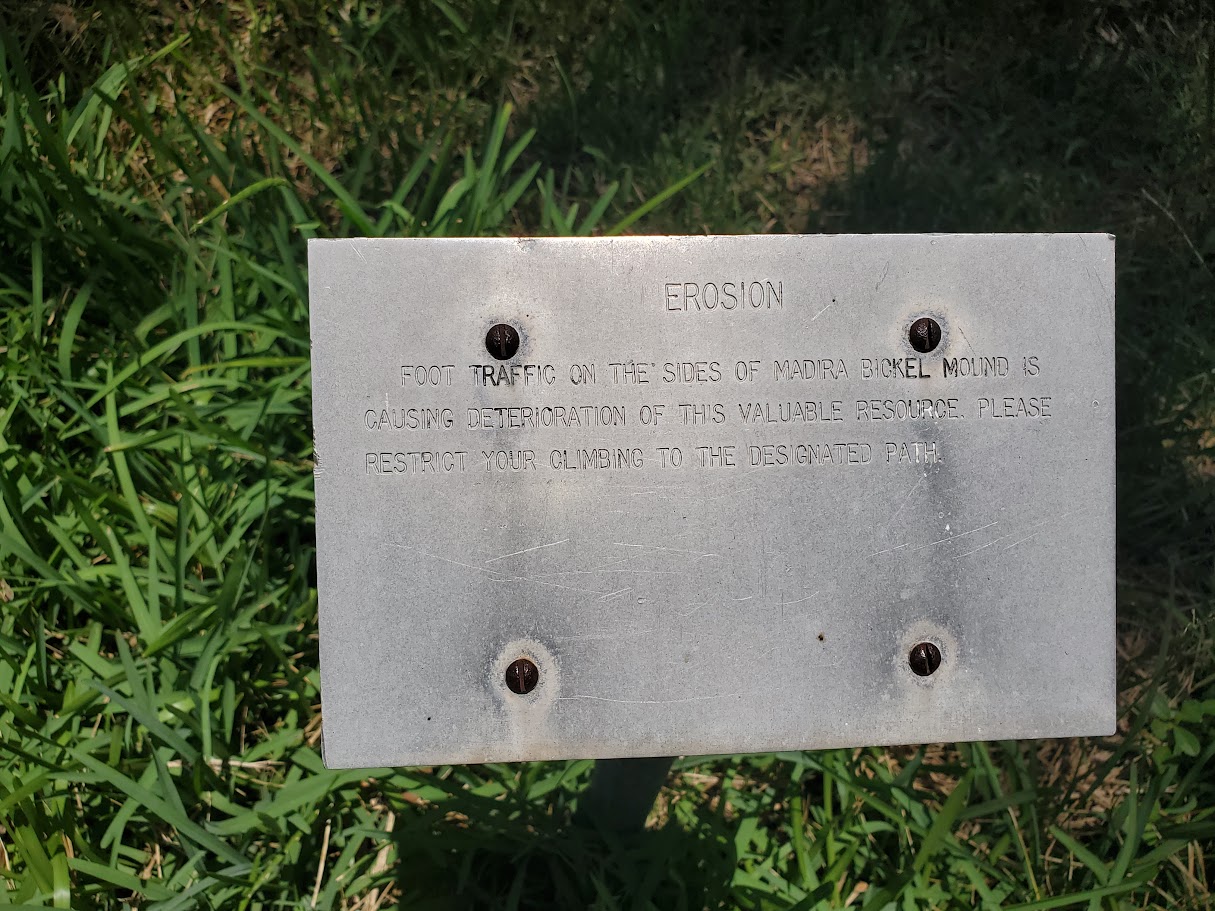
Madira Bickel Mound site photo by Damien Marie AtHope
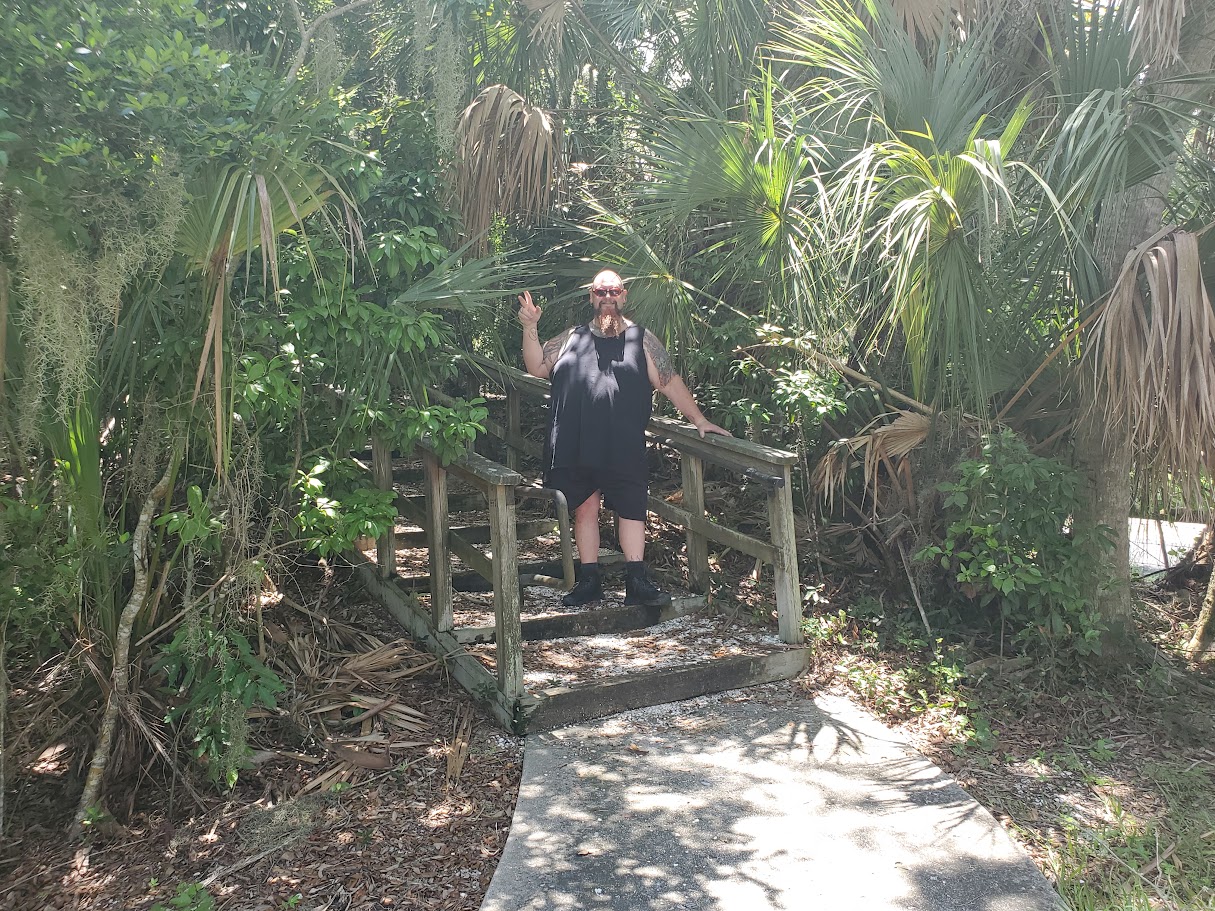
Madira Bickel Mound site photo by Damien Marie AtHope
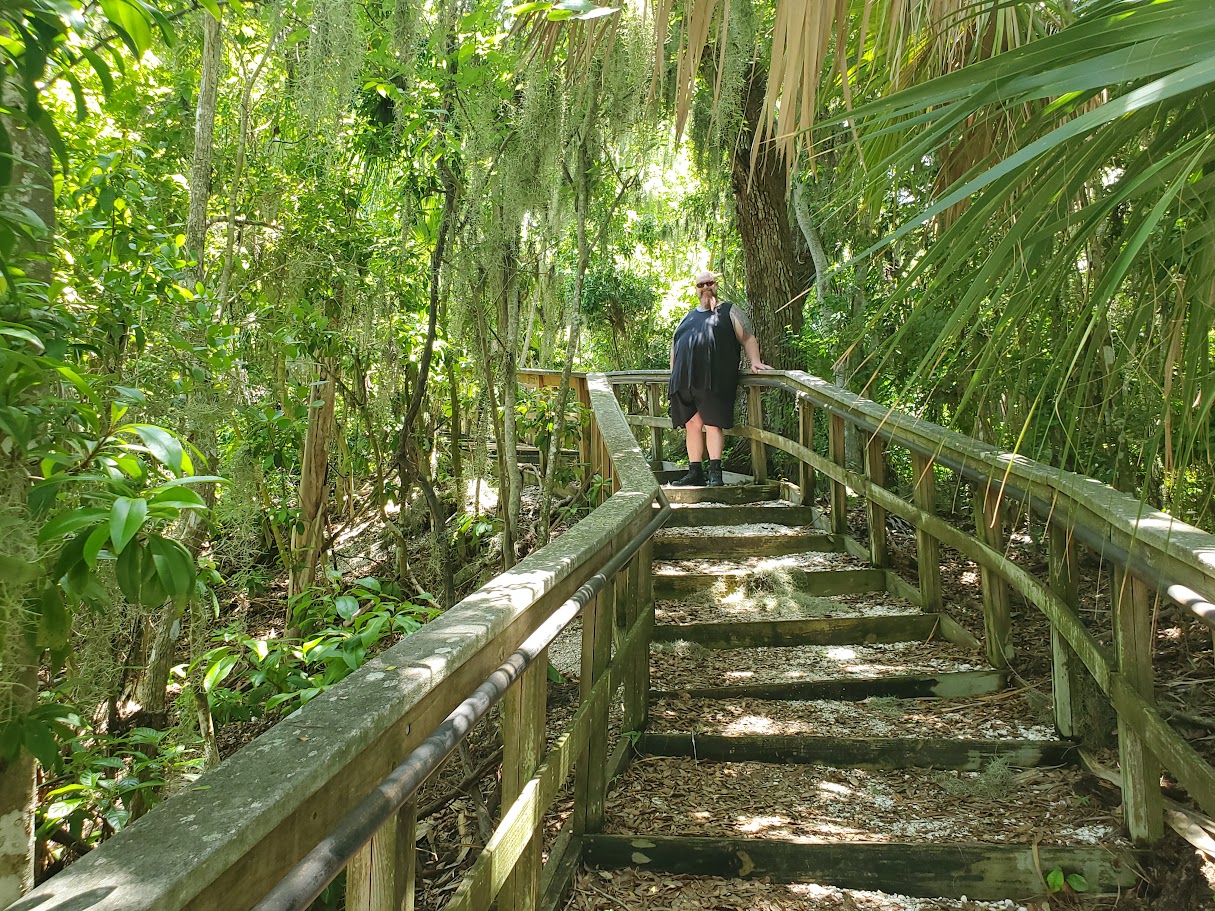
Madira Bickel Mound site photo by Damien Marie AtHope
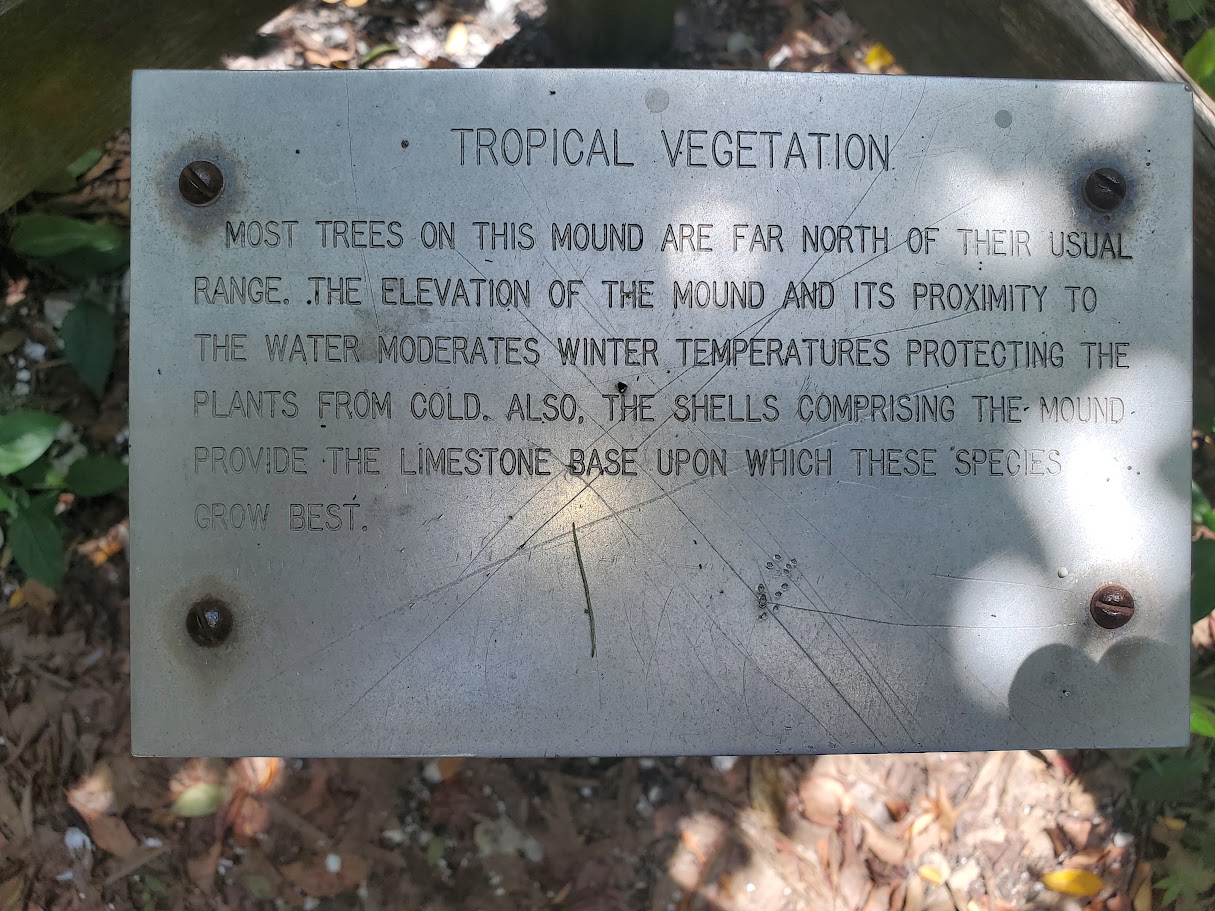
Madira Bickel Mound site photo by Damien Marie AtHope
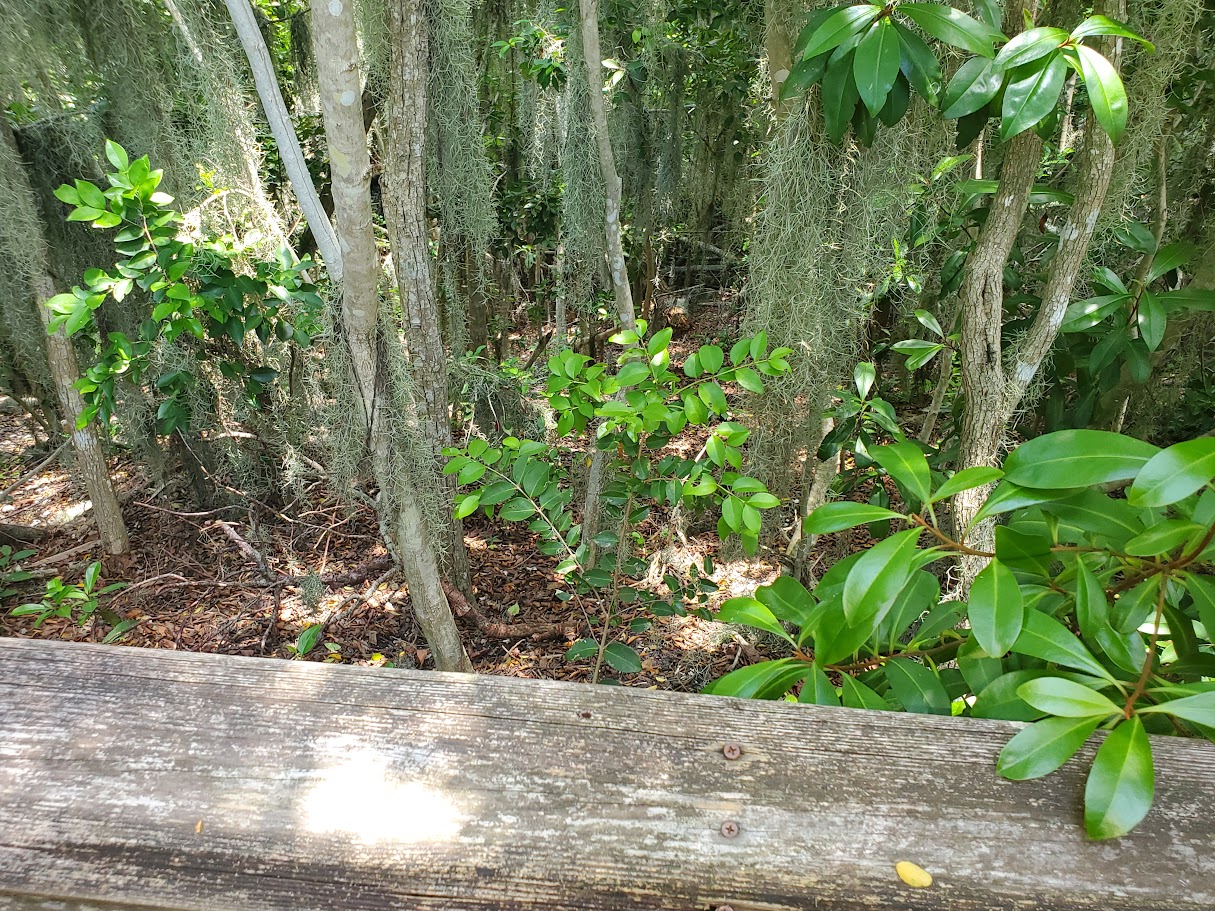
Madira Bickel Mound site photo by Damien Marie AtHope

Madira Bickel Mound site photo by Damien Marie AtHope

Madira Bickel Mound site photo by Damien Marie AtHope
“Karl and Madira Bickel donated the mound and surrounding property to the state in 1948. The flat-topped ceremonial mound – composed of sand, shell and village debris – measures 100 by 170 feet at the base and is 20 feet in height. Archaeological excavations have disclosed at least three periods of Native American cultures, the earliest dating back 2,000 years.” ref
“This large ceremonial mound and the adjacent Prine burial mound were part of an extensive Native America village and mound complex, now called the Terra Ceia site, that once occupied much of this peninsula (see map). Donated to the state by Karl and Madira Bickel and Mr. & Mrs. R.H. Prine, this ten-acre park is nearly all that remains because of residential development and road building. Research indicates that these mounds were constructed and used from approximately 1500 to 800 years ago, a time referred to as the Weeden Island period. Large flat-topped mounds such as Madira Bickel typically had large structures on top for ceremonial events, or as residence for important persons. This site is one of several similar mound complexes in the Tampa Bay area. Early historians and archaeologists once speculated that Madira Bickel Mound site was the village of Ucita referred to in the narratives of the Desoto expedition of 1539, however archaeological investigation revealed virtually no Spanish artifacts.” ref
“The mound itself actually is only a small portion of the 10-acre archaeological site. An extensive shell midden was once found northwest of the mound along Miguel Bay of which, most has been removed over the years. Early historians and archaeologists contemplated that the Madira Bickel Mound site was the village of Ucita. The mound site and surrounding area contains proof of Native American life and culture as it evolved from the simple life at the beginning of the Christian era through artistic pottery and religious expression in the construction of mounds and temples. During the length of time which the site was occupied, the Native American lifestyle changed significantly.” ref
“Archaeological excavations have revealed at least three periods of Native American cultures. During the first period, in which mounds were initiated, life was simple. The main interests were hunting and fishing. Kitchen middens along the shore of the bay were most likely begun during this period. The second, or Weedon Island Period, started from CE 700 till A.D. 1300. This period created some of the most artistic pottery found in Florida. During the third, or Safety Harbor Period, attention towards pottery declined. Villages became larger, as agriculture rose in significance. This is the same period in which the first Spanish explorers arrived.” ref
“Pottery even when fragmented can reveal a lot… Pottery styles, materials, and surface patterns can often be linked to particular time periods and cultures. Most of the pottery from Madira Bickel is from the Weeden Island and Safety Harbor periods, a span of time that ranges from 1500 years ago until the time of Spanish contact. The wide variety of pottery, along with the changes in burial techniques found at Madira Bickel, indicate ongoing relationships with other neighboring cultures. These examples of Weeden Island period vessels are from other Florida sites. Evidence indicates that mats, baskets, and fish traps like the one pictured above were fashioned from grasses, reeds, vines, and shell. Bone from fish and mammals was used to manufacture a variety of useful items ranging from fishhooks, sewing needles, projectile points, and decorative objects such as hair pins, clasps, and amulets. Conch and other types of shells were hafted to wooden handles to form various axes and hammers.” ref
“At least 8 other markers are within 3 miles of this marker, measured as the crow flies. Guerrero Home Site (approx. 0.2 miles away); Atzeroth Home Site (approx. 0.7 miles away); Terra Ceia School/Village Improvement Association Hall (approx. 0.9 miles away); Franklin C. Armstrong (approx. 1.2 miles away); Florida Honors and Remembers our POW’s and MIA’s (approx. 1.9 miles away); Realizing a Dream (approx. 1.9 miles away); Danger Approaches (approx. 1.9 miles away); Veterans of Rubonia (approx. 2.7 miles away). Touch for a list and map of all markers in Terra Ceia.” ref
“The Madira Bickel Mound State Archaeological Site is an archaeological site on Terra Ceia Island in northwestern Palmetto, Florida, United States. It is located on Bayshore Drive, west of U.S. 19, a mile south of I-275. On August 12, 1970, it was added to the U.S. National Register of Historic Places. It is also a Florida State Park. The 10-acre (0.040 km2) site was the first Native American location in Florida to be designated as a State Archaeological Site. Archaeological excavations have established that indigenous occupation reaches back 2,000 years, and across three distinct periods: Manasota, Weedon Island, and Safety Harbor cultures. The people constructed a massive earthwork temple/ceremonial mound from shells, sand and detritus. It is still 20-foot (6.1 m) high, with a base nearly 100 by 170 feet (52 m).” ref
“While this park is small, it is home to thousands of years of history. Visitors can see a piece of the living history by visiting the park’s main attraction, the Native American mound. This 20-foot-tall mound is comprised of sand, fossils, and other debris left behind by the tribe that lived in the area. The walkway winds under towering Spanish moss trees and sable palms leading to the base of a set of stairs at the bottom of the mound. Visitors can then walk up the stairs to the top of the mound to view it in all its ancient glory. Along the path leading to the mound there are interpretive signs telling the story of the area and how it became a prized archaeological site.” ref
“Scholars believe that the mound site continued to be of great ceremonial importance to the historic Tocobaga Indians of the surrounding area, who coalesced as a people before European encounter in the late sixteenth century. They survived into the eighteenth century but disappeared as a tribe due to infectious diseases and warfare. The site is named for Madira Bickel of Sarasota. She and her husband, Karl, purchased the land around the main mound and donated it to the state in 1948. The point of greatest interest at the site is the 20-foot (6.1 m) high temple/ceremonial mound. Composed of shells (obtained from a midden to the west), sand, and detritus, the mound’s base is 100 feet (30 m) by 170 feet (52 m).” ref
“To more easily reach the top, the Tocobaga constructed a curved 10-foot (3.0 m) wide ramp on the western side. The state park has graduated stairways for access, and at the top, has cleared an area (protected by a fence) for overlooking the park. Over the centuries, the mound has become covered with vegetation, including tall trees. Also in the park are the remains of the Prine Burial Mound, which is circular, about 40 feet (12 m) wide, and about 2 feet (0.61 m) high at the center. It was used through the three major archaeological cultures described above, from 800-1500 AD. Since settlement and development, much of the mound’s contents have been disturbed.” ref
“The significant Temple Mound Complex in Terra Ceia, Florida, is located on the southern shore of Tampa Bay and is encompassed by the aquatic preserve at Terra Ceia Bay, where archaeological evidence of early human use has been recorded. Coincidentally, the so-named “Madira Bickel” Mound Site exhibits thousands of years of Indigenous habitation spanning at least three so-called “cultural periods. In addition to the natural environment, another reason why Aboriginal People probably chose this location was its accessibility to abundant waterways that provide sustenance for the People, as well as facilitating transportation and trade between villages.” ref
“Also, many sources report that in 1948, Karl and Madira Bickel donated the site containing the large flat-topped Temple Mound, which is 20 feet tall and 100 by 170 feet at its base, and it is said to be composed of shells, sand, animal bones, and village debris (presumably from the former surrounding village complex of ancient times). Later on, the “Prine” Burial Mound (which is the site of numerous documented burials) was donated by R.H. Prine and Shula Prine. Currently, this mound site is the focal point of a “park” system that manages preservation of these two ancestral monuments within their natural community. Additionally, the site is distinguished as the first archaeological site in ‘Florida’ and features temple mound traditions representative of this territory.” ref
“The information kiosk to peruse descriptions of the temple (ceremonial) mound, burial mound, and other nearby mounds, including colorful depictions of Indigenous People associated with particular cultural periods of habitation and examples of pottery, tools, and other recovered objects. One map outlines all of the significant archaeological locations within the “park” site and areas nearby, such as “Miguel Bay”. This waterway and natural habitat are located across the street, and records disclose an extensive shell mound exists along its shoreline. Incidentally, some sources recorded that this flat top structure was either the Chief’s domicile or a temple; and that a sloping ramp (approximately 10 feet wide) extended in the direction of a mound ridge along the shores of “Miguel Bay”. We are headed up there right now and it’s exciting.” ref
“Near the exit at the base of the mound, we noted the smaller burial mound (called “Prine” Mound), which is said to be approximately 100 feet in diameter and about 18 inches tall; and thirty burials were documented at this sacred site…although the exact location is inconclusive based on past archaeological surveys. However, it is acknowledged that the mound sits near the current “parking area” and portions of it may be found underneath this cleared area, which was already on the property when the “park” was established in 1951.” ref
Religion ideas moved both directly by movements or migrations of people as well as by trade or transfer not related to migration. I see actual movements or migrations having more influence on the similar religion beliefs, to me. But both were involved in how religions evolved.

People don’t commonly teach religious history, even that of their own claimed religion. No, rather they teach a limited “pro their religion” history of their religion from a religious perspective favorable to the religion of choice.

Do you truly think “Religious Belief” is only a matter of some personal choice?
Do you not see how coercive one’s world of choice is limited to the obvious hereditary belief, in most religious choices available to the child of religious parents or caregivers? Religion is more commonly like a family, culture, society, etc. available belief that limits the belief choices of the child and that is when “Religious Belief” is not only a matter of some personal choice and when it becomes hereditary faith, not because of the quality of its alleged facts or proposed truths but because everyone else important to the child believes similarly so they do as well simply mimicking authority beliefs handed to them. Because children are raised in religion rather than being presented all possible choices but rather one limited dogmatic brand of “Religious Belief” where children only have a choice of following the belief as instructed, and then personally claim the faith hereditary belief seen in the confirming to the belief they have held themselves all their lives. This is obvious in statements asked and answered by children claiming a faith they barely understand but they do understand that their family believes “this or that” faith, so they feel obligated to believe it too. While I do agree that “Religious Belief” should only be a matter of some personal choice, it rarely is… End Hereditary Religion!

Animism: Respecting the Living World by Graham Harvey
“How have human cultures engaged with and thought about animals, plants, rocks, clouds, and other elements in their natural surroundings? Do animals and other natural objects have a spirit or soul? What is their relationship to humans? In this new study, Graham Harvey explores current and past animistic beliefs and practices of Native Americans, Maori, Aboriginal Australians, and eco-pagans. He considers the varieties of animism found in these cultures as well as their shared desire to live respectfully within larger natural communities. Drawing on his extensive casework, Harvey also considers the linguistic, performative, ecological, and activist implications of these different animisms.” ref

We are like believing machines we vacuum up ideas, like Velcro sticks to almost everything. We accumulate beliefs that we allow to negatively influence our lives, often without realizing it. Our willingness must be to alter skewed beliefs that impend our balance or reason, which allows us to achieve new positive thinking and accurate outcomes.

My thoughts on Religion Evolution with external links for more info:
- (Pre-Animism Africa mainly, but also Europe, and Asia at least 300,000 years ago), (Pre-Animism – Oxford Dictionaries)
- (Animism Africa around 100,000 years ago), (Animism – Britannica.com)
- (Totemism Europe around 50,000 years ago), (Totemism – Anthropology)
- (Shamanism Siberia around 30,000 years ago), (Shamanism – Britannica.com)
- (Paganism Turkey around 12,000 years ago), (Paganism – BBC Religion)
- (Progressed Organized Religion “Institutional Religion” Egypt around 5,000 years ago), (Ancient Egyptian Religion – Britannica.com)
- (CURRENT “World” RELIGIONS after 4,000 years ago) (Origin of Major Religions – Sacred Texts)
- (Early Atheistic Doubting at least by 2,600 years ago) (History of Atheism – Wikipedia)
“Religion is an Evolved Product” and Yes, Religion is Like Fear Given Wings…
Atheists talk about gods and religions for the same reason doctors talk about cancer, they are looking for a cure, or a firefighter talks about fires because they burn people and they care to stop them. We atheists too often feel a need to help the victims of mental slavery, held in the bondage that is the false beliefs of gods and the conspiracy theories of reality found in religions.
Understanding Religion Evolution:
- Pre-Animism (at least 300,000 years ago)
- Animism (Africa: 100,000 years ago)
- Totemism (Europe: 50,000 years ago)
- Shamanism (Siberia: 30,000 years ago)
- Paganism (Turkey: 12,000 years ago)
- Progressed organized religion (Egypt: 5,000 years ago), (Egypt, the First Dynasty 5,150 years ago)
- CURRENT “World” RELIGIONS (after 4,000 years ago)
- Early Atheistic Doubting (at least by 2,600 years ago)
“An Archaeological/Anthropological Understanding of Religion Evolution”
It seems ancient peoples had to survived amazing threats in a “dangerous universe (by superstition perceived as good and evil),” and human “immorality or imperfection of the soul” which was thought to affect the still living, leading to ancestor worship. This ancestor worship presumably led to the belief in supernatural beings, and then some of these were turned into the belief in gods. This feeble myth called gods were just a human conceived “made from nothing into something over and over, changing, again and again, taking on more as they evolve, all the while they are thought to be special,” but it is just supernatural animistic spirit-belief perceived as sacred.
Quick Evolution of Religion?
Pre-Animism (at least 300,000 years ago) pre-religion is a beginning that evolves into later Animism. So, Religion as we think of it, to me, all starts in a general way with Animism (Africa: 100,000 years ago) (theoretical belief in supernatural powers/spirits), then this is physically expressed in or with Totemism (Europe: 50,000 years ago) (theoretical belief in mythical relationship with powers/spirits through a totem item), which then enlists a full-time specific person to do this worship and believed interacting Shamanism (Siberia/Russia: 30,000 years ago) (theoretical belief in access and influence with spirits through ritual), and then there is the further employment of myths and gods added to all the above giving you Paganism (Turkey: 12,000 years ago) (often a lot more nature-based than most current top world religions, thus hinting to their close link to more ancient religious thinking it stems from). My hypothesis is expressed with an explanation of the building of a theatrical house (modern religions development). Progressed organized religion (Egypt: 5,000 years ago) with CURRENT “World” RELIGIONS (after 4,000 years ago).
Historically, in large city-state societies (such as Egypt or Iraq) starting around 5,000 years ago culminated to make religion something kind of new, a sociocultural-governmental-religious monarchy, where all or at least many of the people of such large city-state societies seem familiar with and committed to the existence of “religion” as the integrated life identity package of control dynamics with a fixed closed magical doctrine, but this juggernaut integrated religion identity package of Dogmatic-Propaganda certainly did not exist or if developed to an extent it was highly limited in most smaller prehistoric societies as they seem to lack most of the strong control dynamics with a fixed closed magical doctrine (magical beliefs could be at times be added or removed). Many people just want to see developed religious dynamics everywhere even if it is not. Instead, all that is found is largely fragments until the domestication of religion.
Religions, as we think of them today, are a new fad, even if they go back to around 6,000 years in the timeline of human existence, this amounts to almost nothing when seen in the long slow evolution of religion at least around 70,000 years ago with one of the oldest ritual worship. Stone Snake of South Africa: “first human worship” 70,000 years ago. This message of how religion and gods among them are clearly a man-made thing that was developed slowly as it was invented and then implemented peace by peace discrediting them all. Which seems to be a simple point some are just not grasping how devastating to any claims of truth when we can see the lie clearly in the archeological sites.
I wish people fought as hard for the actual values as they fight for the group/clan names political or otherwise they think support values. Every amount spent on war is theft to children in need of food or the homeless kept from shelter.
Here are several of my blog posts on history:
- To Find Truth You Must First Look
- (Magdalenian/Iberomaurusian) Connections to the First Paganists of the early Neolithic Near East Dating from around 17,000 to 12,000 Years Ago
- Natufians: an Ancient People at the Origins of Agriculture and Sedentary Life
- Possible Clan Leader/Special “MALE” Ancestor Totem Poles At Least 13,500 years ago?
- Jewish People with DNA at least 13,200 years old, Judaism, and the Origins of Some of its Ideas
- Baltic Reindeer Hunters: Swiderian, Lyngby, Ahrensburgian, and Krasnosillya cultures 12,020 to 11,020 years ago are evidence of powerful migratory waves during the last 13,000 years and a genetic link to Saami and the Finno-Ugric peoples.
- The Rise of Inequality: patriarchy and state hierarchy inequality
- Fertile Crescent 12,500 – 9,500 Years Ago: fertility and death cult belief system?
- 12,400 – 11,700 Years Ago – Kortik Tepe (Turkey) Pre/early-Agriculture Cultic Ritualism
- Ritualistic Bird Symbolism at Gobekli Tepe and its “Ancestor Cult”
- Male-Homosexual (female-like) / Trans-woman (female) Seated Figurine from Gobekli Tepe
- Could a 12,000-year-old Bull Geoglyph at Göbekli Tepe relate to older Bull and Female Art 25,000 years ago and Later Goddess and the Bull cults like Catal Huyuk?
- Sedentism and the Creation of goddesses around 12,000 years ago as well as male gods after 7,000 years ago.
- Alcohol, where Agriculture and Religion Become one? Such as Gobekli Tepe’s Ritualistic use of Grain as Food and Ritual Drink
- Neolithic Ritual Sites with T-Pillars and other Cultic Pillars
- Paganism: Goddesses around 12,000 years ago then Male Gods after 7,000 years ago
- First Patriarchy: Split of Women’s Status around 12,000 years ago & First Hierarchy: fall of Women’s Status around 5,000 years ago.
- Natufians: an Ancient People at the Origins of Agriculture and Sedentary Life
- J DNA and the Spread of Agricultural Religion (paganism)
- Paganism: an approximately 12,000-year-old belief system
- Paganism 12,000 years old: related to “Anarchism and Socialism” (Pre-Capitalism)
- Shaman burial in Israel 12,000 years ago and the Shamanism Phenomena
- Need to Mythicized: gods and goddesses
- 12,000 – 7,000 Years Ago – Paleo-Indian Culture (The Americas)
- 12,000 – 2,000 Years Ago – Indigenous-Scandinavians (Nordic)
- Norse did not wear helmets with horns?
- Pre-Pottery Neolithic Skull Cult around 11,500 to 8,400 Years Ago?
- 10,400 – 10,100 Years Ago, in Turkey the Nevail Cori Religious Settlement
- 9,000-6,500 Years Old Submerged Pre-Pottery/Pottery Neolithic Ritual Settlements off Israel’s Coast
- Catal Huyuk “first religious designed city” around 9,500 to 7,700 years ago (Turkey)
- Cultic Hunting at Catal Huyuk “first religious designed city”
- Special Items and Art as well as Special Elite Burials at Catal Huyuk
- New Rituals and Violence with the appearance of Pottery and People?
- Haplogroup N and its related Uralic Languages and Cultures
- Ainu people, Sámi people, Native Americans, the Ancient North Eurasians, and Paganistic-Shamanism with Totemism
- Ideas, Technology and People from Turkey, Europe, to China and Back again 9,000 to 5,000 years ago?
- First Pottery of Europe and the Related Cultures
- 9,000 years old Neolithic Artifacts Judean Desert and Hills Israel
- 9,000-7,000 years-old Sex and Death Rituals: Cult Sites in Israel, Jordan, and the Sinai
- 9,000-8500 year old Horned Female shaman Bad Dürrenberg Germany
- Neolithic Jewelry and the Spread of Farming in Europe Emerging out of West Turkey
- 8,600-year-old Tortoise Shells in Neolithic graves in central China have Early Writing and Shamanism
- Swing of the Mace: the rise of Elite, Forced Authority, and Inequality begin to Emerge 8,500 years ago?
- Migrations and Changing Europeans Beginning around 8,000 Years Ago
- My “Steppe-Anatolian-Kurgan hypothesis” 8,000/7,000 years ago
- Around 8,000-year-old Shared Idea of the Mistress of Animals, “Ritual” Motif
- Pre-Columbian Red-Paint (red ochre) Maritime Archaic Culture 8,000-3,000 years ago
- 7,522-6,522 years ago Linear Pottery culture which I think relates to Arcane Capitalism’s origins
- Arcane Capitalism: Primitive socialism, Primitive capital, Private ownership, Means of production, Market capitalism, Class discrimination, and Petite bourgeoisie (smaller capitalists)
- 7,500-4,750 years old Ritualistic Cucuteni-Trypillian culture of Moldova, Romania, and Ukraine
- Roots of a changing early society 7,200-6,700 years ago Jordan and Israel
- Agriculture religion (Paganism) with farming reached Britain between about 7,000 to 6,500 or so years ago and seemingly expressed in things like Western Europe’s Long Barrows
- My Thoughts on Possible Migrations of “R” DNA and Proto-Indo-European?
- “Millet” Spreading from China 7,022 years ago to Europe and related Language may have Spread with it leading to Proto-Indo-European
- Proto-Indo-European (PIE), ancestor of Indo-European languages: DNA, Society, Language, and Mythology
- The Dnieper–Donets culture and Asian varieties of Millet from China to the Black Sea region of Europe by 7,022 years ago
- Kurgan 6,000 years ago/dolmens 7,000 years ago: funeral, ritual, and other?
- 7,020 to 6,020-year-old Proto-Indo-European Homeland of Urheimat or proposed home of their Language and Religion
- Ancient Megaliths: Kurgan, Ziggurat, Pyramid, Menhir, Trilithon, Dolman, Kromlech, and Kromlech of Trilithons
- The Mytheme of Ancient North Eurasian Sacred-Dog belief and similar motifs are found in Indo-European, Native American, and Siberian comparative mythology
- Elite Power Accumulation: Ancient Trade, Tokens, Writing, Wealth, Merchants, and Priest-Kings
- Sacred Mounds, Mountains, Kurgans, and Pyramids may hold deep connections?
- Between 7,000-5,000 Years ago, rise of unequal hierarchy elite, leading to a “birth of the State” or worship of power, strong new sexism, oppression of non-elites, and the fall of Women’s equal status
- Paganism 7,000-5,000 years old: related to “Anarchism and Socialism” (Capitalism) (World War 0) Elite & their slaves
- Hell and Underworld mythologies starting maybe as far back as 7,000 to 5,000 years ago with the Proto-Indo-Europeans?
- The First Expression of the Male God around 7,000 years ago?
- White (light complexion skin) Bigotry and Sexism started 7,000 years ago?
- Around 7,000-year-old Shared Idea of the Divine Bird (Tutelary and/or Trickster spirit/deity), “Ritual” Motif
- Nekhbet an Ancient Egyptian Vulture Goddess and Tutelary Deity
- 6,720 to 4,920 years old Ritualistic Hongshan Culture of Inner Mongolia with 5,000-year-old Pyramid Mounds and Temples
- First proto-king in the Balkans, Varna culture around 6,500 years ago?
- 6,500–5,800 years ago in Israel Late Chalcolithic (Copper Age) Period in the Southern Levant Seems to Express Northern Levant Migrations, Cultural and Religious Transfer
- KING OF BEASTS: Master of Animals “Ritual” Motif, around 6,000 years old or older…
- Around 6000-year-old Shared Idea of the Solid Wheel & the Spoked Wheel-Shaped Ritual Motif
- “The Ghassulian Star,” a mysterious 6,000-year-old mural from Jordan; a Proto-Star of Ishtar, Star of Inanna or Star of Venus?
- Religious/Ritual Ideas, including goddesses and gods as well as ritual mounds or pyramids from Northeastern Asia at least 6,000 years old, seemingly filtering to Iran, Iraq, the Mediterranean, Europe, Egypt, and the Americas?
- Maykop (5,720–5,020 years ago) Caucasus region Bronze Age culture-related to Copper Age farmers from the south, influenced by the Ubaid period and Leyla-Tepe culture, as well as influencing the Kura-Araxes culture
- 5-600-year-old Tomb, Mummy, and First Bearded Male Figurine in a Grave
- Kura-Araxes Cultural 5,520 to 4,470 years old DNA traces to the Canaanites, Arabs, and Jews
- Minoan/Cretan (Keftiu) Civilization and Religion around 5,520 to 3,120 years ago
- Evolution Of Science at least by 5,500 years ago
- 5,500 Years old birth of the State, the rise of Hierarchy, and the fall of Women’s status
- “Jiroft culture” 5,100 – 4,200 years ago and the History of Iran
- Stonehenge: Paganistic Burial and Astrological Ritual Complex, England (5,100-3,600 years ago)
- Around 5,000-year-old Shared Idea of the “Tree of Life” Ritual Motif
- Complex rituals for elite, seen from China to Egypt, at least by 5,000 years ago
- Around 5,000 years ago: “Birth of the State” where Religion gets Military Power and Influence
- The Center of the World “Axis Mundi” and/or “Sacred Mountains” Mythology Could Relate to the Altai Mountains, Heart of the Steppe
- Progressed organized religion starts, an approximately 5,000-year-old belief system
- China’s Civilization between 5,000-3,000 years ago, was a time of war and class struggle, violent transition from free clans to a Slave or Elite society
- Origin of Logics is Naturalistic Observation at least by around 5,000 years ago.
- Paganism 5,000 years old: progressed organized religion and the state: related to “Anarchism and Socialism” (Kings and the Rise of the State)
- Ziggurats (multi-platform temples: 4,900 years old) to Pyramids (multi-platform tombs: 4,700 years old)
- Did a 4,520–4,420-year-old Volcano In Turkey Inspire the Bible God?
- Finland’s Horned Shaman and Pre-Horned-God at least 4,500 years ago?
- 4,000-year-Old Dolmens in Israel: A Connected Dolmen Religious Phenomenon?
- Creation myths: From chaos, Ex nihilo, Earth-diver, Emergence, World egg, and World parent
- Bronze Age “Ritual” connections of the Bell Beaker culture with the Corded Ware/Single Grave culture, which were related to the Yamnaya culture and Proto-Indo-European Languages/Religions
- Low Gods (Earth/ Tutelary deity), High Gods (Sky/Supreme deity), and Moralistic Gods (Deity enforcement/divine order)
- The exchange of people, ideas, and material-culture including, to me, the new god (Sky Father) and goddess (Earth Mother) religion between the Cucuteni-Trypillians and others which is then spread far and wide
- Koryaks: Indigenous People of the Russian Far East and Big Raven myths also found in Tlingit, Haida, Tsimshian, and other Indigenous People of North America
- 42 Principles Of Maat (Egyptian Goddess of the justice) around 4,400 years ago, 2000 Years Before Ten Commandments
- “Happy Easter” Well Happy Eostre/Ishter
- 4,320-3,820 years old “Shimao” (North China) site with Totemistic-Shamanistic Paganism and a Stepped Pyramid
- 4,250 to 3,400 Year old Stonehenge from Russia: Arkaim?
- 4,100-year-old beaker with medicinal & flowering plants in a grave of a woman in Scotland
- Early European Farmer ancestry, Kelif el Boroud people with the Cardial Ware culture, and the Bell Beaker culture Paganists too, spread into North Africa, then to the Canary Islands off West Africa
- Flood Accounts: Gilgamesh epic (4,100 years ago) Noah in Genesis (2,600 years ago)
- Paganism 4,000 years old: related to “Anarchism and Socialism” (First Moralistic gods, then the Origin time of Monotheism)
- When was the beginning: TIMELINE OF CURRENT RELIGIONS, which start around 4,000 years ago.
- Early Religions Thought to Express Proto-Monotheistic Systems around 4,000 years ago
- Kultepe? An archaeological site with a 4,000 years old women’s rights document.
- Single God Religions (Monotheism) = “Man-o-theism” started around 4,000 years ago with the Great Sky Spirit/God Tiān (天)?
- Confucianism’s Tiān (Shangdi god 4,000 years old): Supernaturalism, Pantheism or Theism?
- Yes, Your Male God is Ridiculous
- Mythology, a Lunar Deity is a Goddess or God of the Moon
- Sacred Land, Hills, and Mountains: Sami Mythology (Paganistic Shamanism)
- Horse Worship/Sacrifice: mythical union of Ruling Elite/Kingship and the Horse
- The Amorite/Amurru people’s God Amurru “Lord of the Steppe”, relates to the Origins of the Bible God?
- Bronze Age Exotic Trade Routes Spread Quite Far as well as Spread Religious Ideas with Them
- Sami and the Northern Indigenous Peoples Landscape, Language, and its Connection to Religion
- Prototype of Ancient Analemmatic Sundials around 3,900-3,150 years ago and a Possible Solar Connection to gods?
- Judaism is around 3,450 or 3,250 years old. (“Paleo-Hebrew” 3,000 years ago and Torah 2,500 years ago)
- The Weakening of Ancient Trade and the Strengthening of Religions around 3000 years ago?
- Are you aware that there are religions that worship women gods, explain now religion tears women down?
- Animistic, Totemistic, and Paganistic Superstition Origins of bible god and the bible’s Religion.
- Myths and Folklore: “Trickster gods and goddesses”
- Jews, Judaism, and the Origins of Some of its Ideas
- An Old Branch of Religion Still Giving Fruit: Sacred Trees
- Dating the BIBLE: naming names and telling times (written less than 3,000 years ago, provable to 2,200 years ago)
- Did a Volcano Inspire the bible god?
- Dené–Yeniseian language, Old Copper Complex, and Pre-Columbian Mound Builders?
- No “dinosaurs and humans didn’t exist together just because some think they are in the bible itself”
- Sacred Shit and Sacred Animals?
- Everyone Killed in the Bible Flood? “Nephilim” (giants)?
- Hey, Damien dude, I have a question for you regarding “the bible” Exodus.
- Archaeology Disproves the Bible
- Bible Battle, Just More, Bible Babble
- The Jericho Conquest lie?
- Canaanites and Israelites?
- Accurate Account on how did Christianity Began?
- Let’s talk about Christianity.
- So the 10 commandments isn’t anything to go by either right?
- Misinformed christian
- Debunking Jesus?
- Paulism vs Jesus
- Ok, you seem confused so let’s talk about Buddhism.
- Unacknowledged Buddhism: Gods, Savior, Demons, Rebirth, Heavens, Hells, and Terrorism
- His Foolishness The Dalai Lama
- Yin and Yang is sexist with an ORIGIN around 2,300 years ago?
- I Believe Archaeology, not Myths & Why Not, as the Religious Myths Already Violate Reason!
- Archaeological, Scientific, & Philosophic evidence shows the god myth is man-made nonsense.
- Aquatic Ape Theory/Hypothesis? As Always, Just Pseudoscience.
- Ancient Aliens Conspiracy Theorists are Pseudohistorians
- The Pseudohistoric and Pseudoscientific claims about “Bakoni Ruins” of South Africa
- Why do people think Religion is much more than supernaturalism and superstitionism?
- Religion is an Evolved Product
- Was the Value of Ancient Women Different?
- 1000 to 1100 CE, human sacrifice Cahokia Mounds a pre-Columbian Native American site
- Feminist atheists as far back as the 1800s?
- Promoting Religion as Real is Mentally Harmful to a Flourishing Humanity
- Screw All Religions and Their Toxic lies, they are all fraud
- Forget Religions’ Unfounded Myths, I Have Substantiated “Archaeology Facts.”
- Religion Dispersal throughout the World
- I Hate Religion Just as I Hate all Pseudoscience
- Exposing Scientology, Eckankar, Wicca and Other Nonsense?
- Main deity or religious belief systems
- Quit Trying to Invent Your God From the Scraps of Science.
- Archaeological, Scientific, & Philosophic evidence shows the god myth is man-made nonsense.
- Ancient Alien Conspiracy Theorists: Misunderstanding, Rhetoric, Misinformation, Fabrications, and Lies
- Misinformation, Distortion, and Pseudoscience in Talking with a Christian Creationist
- Judging the Lack of Goodness in Gods, Even the Norse God Odin
- Challenging the Belief in God-like Aliens and Gods in General
- A Challenge to Christian use of Torture Devices?
- Yes, Hinduism is a Religion
- Trump is One of the Most Reactionary Forces of Far-right Christian Extremism
- Was the Bull Head a Symbol of God? Yes!
- Primate Death Rituals
- Christian – “God and Christianity are objectively true”
- Australopithecus afarensis Death Ritual?
- You Claim Global Warming is a Hoax?
- Doubter of Science and Defamer of Atheists?
- I think that sounds like the Bible?
- History of the Antifa (“anti-fascist”) Movements
- Indianapolis Anti-Blasphemy Laws #Free Soheil Rally
- Damien, you repeat the golden rule in so many forms then you say religion is dogmatic?
- Science is a Trustable Methodology whereas Faith is not Trustable at all!
- Was I ever a believer, before I was an atheist?
- Atheists rise in reason
- Mistrust of science?
- Open to Talking About the Definition of ‘God’? But first, we address Faith.
- ‘United Monarchy’ full of splendor and power – Saul, David, and Solomon? Most likely not.
- Is there EXODUS ARCHAEOLOGY? The short answer is “no.”
- Lacking Proof of Bigfoots, Unicorns, and Gods is Just a Lack of Research?
- Religion and Politics: Faith Beliefs vs. Rational Thinking
- Hammer of Truth that lying pig RELIGION: challenged by an archaeologist
- “The Hammer of Truth” -ontology question- What do You Mean by That?
- Navigation of a bad argument: Ad Hominem vs. Attack
- Why is it Often Claimed that Gods have a Gender?
- Why are basically all monotheistic religions ones that have a male god?
- Shifting through the Claims in support of Faith
- Dear Mr. AtHope, The 20th Century is an Indictment of Secularism and a Failed Atheist Century
- An Understanding of the Worldwide Statistics and Dynamics of Terrorist Incidents and Suicide Attacks
- Intoxication and Evolution? Addressing and Assessing the “Stoned Ape” or “Drunken Monkey” Theories as Catalysts in Human Evolution
- Sacred Menstrual cloth? Inanna’s knot, Isis knot, and maybe Ma’at’s feather?
- Damien, why don’t the Hebrews accept the bible stories?
- Dealing with a Troll and Arguing Over Word Meaning
- Knowledge without Belief? Justified beliefs or disbeliefs worthy of Knowledge?
- Afrocentrism and African Religions
- Crecganford @crecganford offers history & stories of the people, places, gods, & culture
- Empiricism-Denier?
I am not an academic. I am a revolutionary that teaches in public, in places like social media, and in the streets. I am not a leader by some title given but from my commanding leadership style of simply to start teaching everywhere to everyone, all manner of positive education.



To me, Animism starts in Southern Africa, then to West Europe, and becomes Totemism. Another split goes near the Russia and Siberia border becoming Shamanism, which heads into Central Europe meeting up with Totemism, which also had moved there, mixing the two which then heads to Lake Baikal in Siberia. From there this Shamanism-Totemism heads to Turkey where it becomes Paganism.





Not all “Religions” or “Religious Persuasions” have a god(s) but
All can be said to believe in some imaginary beings or imaginary things like spirits, afterlives, etc.

Paganism 12,000-4,000 years old
12,000-7,000 years old: related to (Pre-Capitalism)
7,000-5,000 years old: related to (Capitalism) (World War 0) Elite and their slaves!
5,000 years old: related to (Kings and the Rise of the State)
4,000 years old: related to (First Moralistic gods, then the Origin time of Monotheism)

ref, ref, ref, ref, ref, ref, ref, ref, ref, ref, ref, ref, ref, ref, ref, ref, ref, ref, ref, ref, ref
Low Gods “Earth” or Tutelary deity and High Gods “Sky” or Supreme deity
“An Earth goddess is a deification of the Earth. Earth goddesses are often associated with the “chthonic” deities of the underworld. Ki and Ninhursag are Mesopotamian earth goddesses. In Greek mythology, the Earth is personified as Gaia, corresponding to Roman Terra, Indic Prithvi/Bhūmi, etc. traced to an “Earth Mother” complementary to the “Sky Father” in Proto-Indo-European religion. Egyptian mythology exceptionally has a sky goddess and an Earth god.” ref
“A mother goddess is a goddess who represents or is a personification of nature, motherhood, fertility, creation, destruction or who embodies the bounty of the Earth. When equated with the Earth or the natural world, such goddesses are sometimes referred to as Mother Earth or as the Earth Mother. In some religious traditions or movements, Heavenly Mother (also referred to as Mother in Heaven or Sky Mother) is the wife or feminine counterpart of the Sky father or God the Father.” ref
“Any masculine sky god is often also king of the gods, taking the position of patriarch within a pantheon. Such king gods are collectively categorized as “sky father” deities, with a polarity between sky and earth often being expressed by pairing a “sky father” god with an “earth mother” goddess (pairings of a sky mother with an earth father are less frequent). A main sky goddess is often the queen of the gods and may be an air/sky goddess in her own right, though she usually has other functions as well with “sky” not being her main. In antiquity, several sky goddesses in ancient Egypt, Mesopotamia, and the Near East were called Queen of Heaven. Neopagans often apply it with impunity to sky goddesses from other regions who were never associated with the term historically. The sky often has important religious significance. Many religions, both polytheistic and monotheistic, have deities associated with the sky.” ref
“In comparative mythology, sky father is a term for a recurring concept in polytheistic religions of a sky god who is addressed as a “father”, often the father of a pantheon and is often either a reigning or former King of the Gods. The concept of “sky father” may also be taken to include Sun gods with similar characteristics, such as Ra. The concept is complementary to an “earth mother“. “Sky Father” is a direct translation of the Vedic Dyaus Pita, etymologically descended from the same Proto-Indo-European deity name as the Greek Zeûs Pater and Roman Jupiter and Germanic Týr, Tir or Tiwaz, all of which are reflexes of the same Proto-Indo-European deity’s name, *Dyēus Ph₂tḗr. While there are numerous parallels adduced from outside of Indo-European mythology, there are exceptions (e.g. In Egyptian mythology, Nut is the sky mother and Geb is the earth father).” ref
Tutelary deity
“A tutelary (also tutelar) is a deity or spirit who is a guardian, patron, or protector of a particular place, geographic feature, person, lineage, nation, culture, or occupation. The etymology of “tutelary” expresses the concept of safety and thus of guardianship. In late Greek and Roman religion, one type of tutelary deity, the genius, functions as the personal deity or daimon of an individual from birth to death. Another form of personal tutelary spirit is the familiar spirit of European folklore.” ref
“A tutelary (also tutelar) in Korean shamanism, jangseung and sotdae were placed at the edge of villages to frighten off demons. They were also worshiped as deities. Seonangshin is the patron deity of the village in Korean tradition and was believed to embody the Seonangdang. In Philippine animism, Diwata or Lambana are deities or spirits that inhabit sacred places like mountains and mounds and serve as guardians. Such as: Maria Makiling is the deity who guards Mt. Makiling and Maria Cacao and Maria Sinukuan. In Shinto, the spirits, or kami, which give life to human bodies come from nature and return to it after death. Ancestors are therefore themselves tutelaries to be worshiped. And similarly, Native American beliefs such as Tonás, tutelary animal spirit among the Zapotec and Totems, familial or clan spirits among the Ojibwe, can be animals.” ref
“A tutelary (also tutelar) in Austronesian beliefs such as: Atua (gods and spirits of the Polynesian peoples such as the Māori or the Hawaiians), Hanitu (Bunun of Taiwan‘s term for spirit), Hyang (Kawi, Sundanese, Javanese, and Balinese Supreme Being, in ancient Java and Bali mythology and this spiritual entity, can be either divine or ancestral), Kaitiaki (New Zealand Māori term used for the concept of guardianship, for the sky, the sea, and the land), Kawas (mythology) (divided into 6 groups: gods, ancestors, souls of the living, spirits of living things, spirits of lifeless objects, and ghosts), Tiki (Māori mythology, Tiki is the first man created by either Tūmatauenga or Tāne and represents deified ancestors found in most Polynesian cultures). ” ref, ref, ref, ref, ref, ref, ref
Mesopotamian Tutelary Deities can be seen as ones related to City-States
“Historical city-states included Sumerian cities such as Uruk and Ur; Ancient Egyptian city-states, such as Thebes and Memphis; the Phoenician cities (such as Tyre and Sidon); the five Philistine city-states; the Berber city-states of the Garamantes; the city-states of ancient Greece (the poleis such as Athens, Sparta, Thebes, and Corinth); the Roman Republic (which grew from a city-state into a vast empire); the Italian city-states from the Middle Ages to the early modern period, such as Florence, Siena, Ferrara, Milan (which as they grew in power began to dominate neighboring cities) and Genoa and Venice, which became powerful thalassocracies; the Mayan and other cultures of pre-Columbian Mesoamerica (including cities such as Chichen Itza, Tikal, Copán and Monte Albán); the central Asian cities along the Silk Road; the city-states of the Swahili coast; Ragusa; states of the medieval Russian lands such as Novgorod and Pskov; and many others.” ref
“The Uruk period (ca. 4000 to 3100 BCE; also known as Protoliterate period) of Mesopotamia, named after the Sumerian city of Uruk, this period saw the emergence of urban life in Mesopotamia and the Sumerian civilization. City-States like Uruk and others had a patron tutelary City Deity along with a Priest-King.” ref
“Chinese folk religion, both past, and present, includes myriad tutelary deities. Exceptional individuals, highly cultivated sages, and prominent ancestors can be deified and honored after death. Lord Guan is the patron of military personnel and police, while Mazu is the patron of fishermen and sailors. Such as Tu Di Gong (Earth Deity) is the tutelary deity of a locality, and each individual locality has its own Earth Deity and Cheng Huang Gong (City God) is the guardian deity of an individual city, worshipped by local officials and locals since imperial times.” ref
“A tutelary (also tutelar) in Hinduism, personal tutelary deities are known as ishta-devata, while family tutelary deities are known as Kuladevata. Gramadevata are guardian deities of villages. Devas can also be seen as tutelary. Shiva is the patron of yogis and renunciants. City goddesses include: Mumbadevi (Mumbai), Sachchika (Osian); Kuladevis include: Ambika (Porwad), and Mahalakshmi. In NorthEast India Meitei mythology and religion (Sanamahism) of Manipur, there are various types of tutelary deities, among which Lam Lais are the most predominant ones. Tibetan Buddhism has Yidam as a tutelary deity. Dakini is the patron of those who seek knowledge.” ref
“A tutelary (also tutelar) The Greeks also thought deities guarded specific places: for instance, Athena was the patron goddess of the city of Athens. Socrates spoke of hearing the voice of his personal spirit or daimonion:
You have often heard me speak of an oracle or sign which comes to me … . This sign I have had ever since I was a child. The sign is a voice which comes to me and always forbids me to do something which I am going to do, but never commands me to do anything, and this is what stands in the way of my being a politician.” ref
“Tutelary deities who guard and preserve a place or a person are fundamental to ancient Roman religion. The tutelary deity of a man was his Genius, that of a woman her Juno. In the Imperial era, the Genius of the Emperor was a focus of Imperial cult. An emperor might also adopt a major deity as his personal patron or tutelary, as Augustus did Apollo. Precedents for claiming the personal protection of a deity were established in the Republican era, when for instance the Roman dictator Sulla advertised the goddess Victory as his tutelary by holding public games (ludi) in her honor.” ref
“Each town or city had one or more tutelary deities, whose protection was considered particularly vital in time of war and siege. Rome itself was protected by a goddess whose name was to be kept ritually secret on pain of death (for a supposed case, see Quintus Valerius Soranus). The Capitoline Triad of Juno, Jupiter, and Minerva were also tutelaries of Rome. The Italic towns had their own tutelary deities. Juno often had this function, as at the Latin town of Lanuvium and the Etruscan city of Veii, and was often housed in an especially grand temple on the arx (citadel) or other prominent or central location. The tutelary deity of Praeneste was Fortuna, whose oracle was renowned.” ref
“The Roman ritual of evocatio was premised on the belief that a town could be made vulnerable to military defeat if the power of its tutelary deity were diverted outside the city, perhaps by the offer of superior cult at Rome. The depiction of some goddesses such as the Magna Mater (Great Mother, or Cybele) as “tower-crowned” represents their capacity to preserve the city. A town in the provinces might adopt a deity from within the Roman religious sphere to serve as its guardian, or syncretize its own tutelary with such; for instance, a community within the civitas of the Remi in Gaul adopted Apollo as its tutelary, and at the capital of the Remi (present-day Rheims), the tutelary was Mars Camulus.” ref
Household deity (a kind of or related to a Tutelary deity)
“A household deity is a deity or spirit that protects the home, looking after the entire household or certain key members. It has been a common belief in paganism as well as in folklore across many parts of the world. Household deities fit into two types; firstly, a specific deity – typically a goddess – often referred to as a hearth goddess or domestic goddess who is associated with the home and hearth, such as the ancient Greek Hestia.” ref
“The second type of household deities are those that are not one singular deity, but a type, or species of animistic deity, who usually have lesser powers than major deities. This type was common in the religions of antiquity, such as the Lares of ancient Roman religion, the Gashin of Korean shamanism, and Cofgodas of Anglo-Saxon paganism. These survived Christianisation as fairy-like creatures existing in folklore, such as the Anglo-Scottish Brownie and Slavic Domovoy.” ref
“Household deities were usually worshipped not in temples but in the home, where they would be represented by small idols (such as the teraphim of the Bible, often translated as “household gods” in Genesis 31:19 for example), amulets, paintings, or reliefs. They could also be found on domestic objects, such as cosmetic articles in the case of Tawaret. The more prosperous houses might have a small shrine to the household god(s); the lararium served this purpose in the case of the Romans. The gods would be treated as members of the family and invited to join in meals, or be given offerings of food and drink.” ref
“In many religions, both ancient and modern, a god would preside over the home. Certain species, or types, of household deities, existed. An example of this was the Roman Lares. Many European cultures retained house spirits into the modern period. Some examples of these include:
- Brownie (Scotland and England) or Hob (England) / Kobold (Germany) / Goblin / Hobgoblin
- Domovoy (Slavic)
- Nisse (Norwegian or Danish) / Tomte (Swedish) / Tonttu (Finnish)
- Húsvættir (Norse)” ref
“Although the cosmic status of household deities was not as lofty as that of the Twelve Olympians or the Aesir, they were also jealous of their dignity and also had to be appeased with shrines and offerings, however humble. Because of their immediacy they had arguably more influence on the day-to-day affairs of men than the remote gods did. Vestiges of their worship persisted long after Christianity and other major religions extirpated nearly every trace of the major pagan pantheons. Elements of the practice can be seen even today, with Christian accretions, where statues to various saints (such as St. Francis) protect gardens and grottos. Even the gargoyles found on older churches, could be viewed as guardians partitioning a sacred space.” ref
“For centuries, Christianity fought a mop-up war against these lingering minor pagan deities, but they proved tenacious. For example, Martin Luther‘s Tischreden have numerous – quite serious – references to dealing with kobolds. Eventually, rationalism and the Industrial Revolution threatened to erase most of these minor deities, until the advent of romantic nationalism rehabilitated them and embellished them into objects of literary curiosity in the 19th century. Since the 20th century this literature has been mined for characters for role-playing games, video games, and other fantasy personae, not infrequently invested with invented traits and hierarchies somewhat different from their mythological and folkloric roots.” ref
“In contradistinction to both Herbert Spencer and Edward Burnett Tylor, who defended theories of animistic origins of ancestor worship, Émile Durkheim saw its origin in totemism. In reality, this distinction is somewhat academic, since totemism may be regarded as a particularized manifestation of animism, and something of a synthesis of the two positions was attempted by Sigmund Freud. In Freud’s Totem and Taboo, both totem and taboo are outward expressions or manifestations of the same psychological tendency, a concept which is complementary to, or which rather reconciles, the apparent conflict. Freud preferred to emphasize the psychoanalytic implications of the reification of metaphysical forces, but with particular emphasis on its familial nature. This emphasis underscores, rather than weakens, the ancestral component.” ref
“William Edward Hearn, a noted classicist, and jurist, traced the origin of domestic deities from the earliest stages as an expression of animism, a belief system thought to have existed also in the neolithic, and the forerunner of Indo-European religion. In his analysis of the Indo-European household, in Chapter II “The House Spirit”, Section 1, he states:
The belief which guided the conduct of our forefathers was … the spirit rule of dead ancestors.” ref
“In Section 2 he proceeds to elaborate:
It is thus certain that the worship of deceased ancestors is a vera causa, and not a mere hypothesis. …
In the other European nations, the Slavs, the Teutons, and the Kelts, the House Spirit appears with no less distinctness. … [T]he existence of that worship does not admit of doubt. … The House Spirits had a multitude of other names which it is needless here to enumerate, but all of which are more or less expressive of their friendly relations with man. … In [England] … [h]e is the Brownie. … In Scotland this same Brownie is well known. He is usually described as attached to particular families, with whom he has been known to reside for centuries, threshing the corn, cleaning the house, and performing similar household tasks. His favorite gratification was milk and honey.” ref

ref, ref, ref, ref, ref, ref, ref, ref, ref, ref, ref, ref, ref, ref, ref, ref, ref
“These ideas are my speculations from the evidence.”
I am still researching the “god‘s origins” all over the world. So you know, it is very complicated but I am smart and willing to look, DEEP, if necessary, which going very deep does seem to be needed here, when trying to actually understand the evolution of gods and goddesses. I am sure of a few things and less sure of others, but even in stuff I am not fully grasping I still am slowly figuring it out, to explain it to others. But as I research more I am understanding things a little better, though I am still working on understanding it all or something close and thus always figuring out more.
Sky Father/Sky God?
“Egyptian: (Nut) Sky Mother and (Geb) Earth Father” (Egypt is different but similar)
Turkic/Mongolic: (Tengri/Tenger Etseg) Sky Father and (Eje/Gazar Eej) Earth Mother *Transeurasian*
Hawaiian: (Wākea) Sky Father and (Papahānaumoku) Earth Mother *Austronesian*
New Zealand/ Māori: (Ranginui) Sky Father and (Papatūānuku) Earth Mother *Austronesian*
Proto-Indo-European: (Dyḗus/Dyḗus ph₂tḗr) Sky Father and (Dʰéǵʰōm/Pleth₂wih₁) Earth Mother
Indo-Aryan: (Dyaus Pita) Sky Father and (Prithvi Mata) Earth Mother *Indo-European*
Italic: (Jupiter) Sky Father and (Juno) Sky Mother *Indo-European*
Etruscan: (Tinia) Sky Father and (Uni) Sky Mother *Tyrsenian/Italy Pre–Indo-European*
Hellenic/Greek: (Zeus) Sky Father and (Hera) Sky Mother who started as an “Earth Goddess” *Indo-European*
Nordic: (Dagr) Sky Father and (Nótt) Sky Mother *Indo-European*
Slavic: (Perun) Sky Father and (Mokosh) Earth Mother *Indo-European*
Illyrian: (Deipaturos) Sky Father and (Messapic Damatura’s “earth-mother” maybe) Earth Mother *Indo-European*
Albanian: (Zojz) Sky Father and (?) *Indo-European*
Baltic: (Perkūnas) Sky Father and (Saulė) Sky Mother *Indo-European*
Germanic: (Týr) Sky Father and (?) *Indo-European*
Colombian-Muisca: (Bochica) Sky Father and (Huythaca) Sky Mother *Chibchan*
Aztec: (Quetzalcoatl) Sky Father and (Xochiquetzal) Sky Mother *Uto-Aztecan*
Incan: (Viracocha) Sky Father and (Mama Runtucaya) Sky Mother *Quechuan*
China: (Tian/Shangdi) Sky Father and (Dì) Earth Mother *Sino-Tibetan*
Sumerian, Assyrian and Babylonian: (An/Anu) Sky Father and (Ki) Earth Mother
Finnish: (Ukko) Sky Father and (Akka) Earth Mother *Finno-Ugric*
Sami: (Horagalles) Sky Father and (Ravdna) Earth Mother *Finno-Ugric*
Puebloan-Zuni: (Ápoyan Ta’chu) Sky Father and (Áwitelin Tsíta) Earth Mother
Puebloan-Hopi: (Tawa) Sky Father and (Kokyangwuti/Spider Woman/Grandmother) Earth Mother *Uto-Aztecan*
Puebloan-Navajo: (Tsohanoai) Sky Father and (Estsanatlehi) Earth Mother *Na-Dene*
ref, ref, ref, ref, ref, ref, ref, ref, ref, ref, ref, ref, ref, ref, ref, ref, ref, ref, ref, ref, ref, ref, ref, ref, ref, ref, ref

Hinduism around 3,700 to 3,500 years old. ref
Judaism around 3,450 or 3,250 years old. (The first writing in the bible was “Paleo-Hebrew” dated to around 3,000 years ago Khirbet Qeiyafa is the site of an ancient fortress city overlooking the Elah Valley. And many believe the religious Jewish texts were completed around 2,500) ref, ref
Judaism is around 3,450 or 3,250 years old. (“Paleo-Hebrew” 3,000 years ago and Torah 2,500 years ago)
“Judaism is an Abrahamic, its roots as an organized religion in the Middle East during the Bronze Age. Some scholars argue that modern Judaism evolved from Yahwism, the religion of ancient Israel and Judah, by the late 6th century BCE, and is thus considered to be one of the oldest monotheistic religions.” ref
“Yahwism is the name given by modern scholars to the religion of ancient Israel, essentially polytheistic, with a plethora of gods and goddesses. Heading the pantheon was Yahweh, the national god of the Israelite kingdoms of Israel and Judah, with his consort, the goddess Asherah; below them were second-tier gods and goddesses such as Baal, Shamash, Yarikh, Mot, and Astarte, all of whom had their own priests and prophets and numbered royalty among their devotees, and a third and fourth tier of minor divine beings, including the mal’ak, the messengers of the higher gods, who in later times became the angels of Judaism, Christianity and Islam. Yahweh, however, was not the ‘original’ god of Israel “Isra-El”; it is El, the head of the Canaanite pantheon, whose name forms the basis of the name “Israel”, and none of the Old Testament patriarchs, the tribes of Israel, the Judges, or the earliest monarchs, have a Yahwistic theophoric name (i.e., one incorporating the name of Yahweh).” ref
“El is a Northwest Semitic word meaning “god” or “deity“, or referring (as a proper name) to any one of multiple major ancient Near Eastern deities. A rarer form, ‘ila, represents the predicate form in Old Akkadian and in Amorite. The word is derived from the Proto-Semitic *ʔil-, meaning “god”. Specific deities known as ‘El or ‘Il include the supreme god of the ancient Canaanite religion and the supreme god of East Semitic speakers in Mesopotamia’s Early Dynastic Period. ʼĒl is listed at the head of many pantheons. In some Canaanite and Ugaritic sources, ʼĒl played a role as father of the gods, of creation, or both. For example, in the Ugaritic texts, ʾil mlk is understood to mean “ʼĒl the King” but ʾil hd as “the god Hadad“. The Semitic root ʾlh (Arabic ʾilāh, Aramaic ʾAlāh, ʾElāh, Hebrew ʾelōah) may be ʾl with a parasitic h, and ʾl may be an abbreviated form of ʾlh. In Ugaritic the plural form meaning “gods” is ʾilhm, equivalent to Hebrew ʾelōhîm “powers”. In the Hebrew texts this word is interpreted as being semantically singular for “god” by biblical commentators. However the documentary hypothesis for the Old Testament (corresponds to the Jewish Torah) developed originally in the 1870s, identifies these that different authors – the Jahwist, Elohist, Deuteronomist, and the Priestly source – were responsible for editing stories from a polytheistic religion into those of a monotheistic religion. Inconsistencies that arise between monotheism and polytheism in the texts are reflective of this hypothesis.” ref
Jainism around 2,599 – 2,527 years old. ref
Confucianism around 2,600 – 2,551 years old. ref
Buddhism around 2,563/2,480 – 2,483/2,400 years old. ref
Christianity around 2,o00 years old. ref
Shinto around 1,305 years old. ref
Islam around 1407–1385 years old. ref

Knowledge to Ponder:
Stars/Astrology:
- Possibly, around 30,000 years ago (in simpler form) to 6,000 years ago, Stars/Astrology are connected to Ancestors, Spirit Animals, and Deities.
- The star also seems to be a possible proto-star for Star of Ishtar, Star of Inanna, or Star of Venus.
- Around 7,000 to 6,000 years ago, Star Constellations/Astrology have connections to the “Kurgan phenomenon” of below-ground “mound” stone/wood burial structures and “Dolmen phenomenon” of above-ground stone burial structures.
- Around 6,500–5,800 years ago, The Northern Levant migrations into Jordon and Israel in the Southern Levant brought new cultural and religious transfer from Turkey and Iran.
- “The Ghassulian Star,” a mysterious 6,000-year-old mural from Jordan may have connections to the European paganstic kurgan/dolmens phenomenon.
“Astrology is a range of divinatory practices, recognized as pseudoscientific since the 18th century, that claim to discern information about human affairs and terrestrial events by studying the apparent positions of celestial objects. Different cultures have employed forms of astrology since at least the 2nd millennium BCE, these practices having originated in calendrical systems used to predict seasonal shifts and to interpret celestial cycles as signs of divine communications. Most, if not all, cultures have attached importance to what they observed in the sky, and some—such as the Hindus, Chinese, and the Maya—developed elaborate systems for predicting terrestrial events from celestial observations. Western astrology, one of the oldest astrological systems still in use, can trace its roots to 19th–17th century BCE Mesopotamia, from where it spread to Ancient Greece, Rome, the Islamicate world and eventually Central and Western Europe. Contemporary Western astrology is often associated with systems of horoscopes that purport to explain aspects of a person’s personality and predict significant events in their lives based on the positions of celestial objects; the majority of professional astrologers rely on such systems.” ref
Around 5,500 years ago, Science evolves, The first evidence of science was 5,500 years ago and was demonstrated by a body of empirical, theoretical, and practical knowledge about the natural world. ref
Around 5,000 years ago, Origin of Logics is a Naturalistic Observation (principles of valid reasoning, inference, & demonstration) ref
Around 4,150 to 4,000 years ago: The earliest surviving versions of the Sumerian Epic of Gilgamesh, which was originally titled “He who Saw the Deep” (Sha naqba īmuru) or “Surpassing All Other Kings” (Shūtur eli sharrī) were written. ref
Hinduism:
- 3,700 years ago or so, the oldest of the Hindu Vedas (scriptures), the Rig Veda was composed.
- 3,500 years ago or so, the Vedic Age began in India after the collapse of the Indus Valley Civilization.
Judaism:
- around 3,000 years ago, the first writing in the bible was “Paleo-Hebrew”
- around 2,500 years ago, many believe the religious Jewish texts were completed
Myths: The bible inspired religion is not just one religion or one myth but a grouping of several religions and myths
- Around 3,450 or 3,250 years ago, according to legend, is the traditionally accepted period in which the Israelite lawgiver, Moses, provided the Ten Commandments.
- Around 2,500 to 2,400 years ago, a collection of ancient religious writings by the Israelites based primarily upon the Hebrew Bible, Tanakh, or Old Testament is the first part of Christianity’s bible.
- Around 2,400 years ago, the most accepted hypothesis is that the canon was formed in stages, first the Pentateuch (Torah).
- Around 2,140 to 2,116 years ago, the Prophets was written during the Hasmonean dynasty, and finally the remaining books.
- Christians traditionally divide the Old Testament into four sections:
- The first five books or Pentateuch (Torah).
- The proposed history books telling the history of the Israelites from their conquest of Canaan to their defeat and exile in Babylon.
- The poetic and proposed “Wisdom books” dealing, in various forms, with questions of good and evil in the world.
- The books of the biblical prophets, warning of the consequences of turning away from God:
- Henotheism:
- Exodus 20:23 “You shall not make other gods besides Me (not saying there are no other gods just not to worship them); gods of silver or gods of gold, you shall not make for yourselves.”
- Polytheism:
- Judges 10:6 “Then the sons of Israel again did evil in the sight of the LORD, served the Baals and the Ashtaroth, the gods of Aram, the gods of Sidon, the gods of Moab, the gods of the sons of Ammon, and the gods of the Philistines; thus they forsook the LORD and did not serve Him.”
- 1 Corinthians 8:5 “For even if there are so-called gods whether in heaven or on earth, as indeed there are many gods and many lords.”
- Monotheism:
- Isaiah 43:10 “You are my witnesses,” declares the LORD, “and my servant whom I have chosen, so that you may know and believe me and understand that I am he. Before me no god was formed, nor will there be one after me.
Around 2,570 to 2,270 Years Ago, there is a confirmation of atheistic doubting as well as atheistic thinking, mainly by Greek philosophers. However, doubting gods is likely as old as the invention of gods and should destroy the thinking that belief in god(s) is the “default belief”. The Greek word is apistos (a “not” and pistos “faithful,”), thus not faithful or faithless because one is unpersuaded and unconvinced by a god(s) claim. Short Definition: unbelieving, unbeliever, or unbelief.

Expressions of Atheistic Thinking:
- Around 2,600 years ago, Ajita Kesakambali, ancient Indian philosopher, who is the first known proponent of Indian materialism. ref
- Around 2,535 to 2,475 years ago, Heraclitus, Greek pre-Socratic philosopher, a native of the Greek city Ephesus, Ionia, on the coast of Anatolia, also known as Asia Minor or modern Turkey. ref
- Around 2,500 to 2,400 years ago, according to The Story of Civilization book series certain African pygmy tribes have no identifiable gods, spirits, or religious beliefs or rituals, and even what burials accrue are without ceremony. ref
- Around 2,490 to 2,430 years ago, Empedocles, Greek pre-Socratic philosopher and a citizen of Agrigentum, a Greek city in Sicily. ref
- Around 2,460 to 2,370 years ago, Democritus, Greek pre-Socratic philosopher considered to be the “father of modern science” possibly had some disbelief amounting to atheism. ref
- Around 2,399 years ago or so, Socrates, a famous Greek philosopher was tried for sinfulness by teaching doubt of state gods. ref
- Around 2,341 to 2,270 years ago, Epicurus, a Greek philosopher known for composing atheistic critics and famously stated, “Is God willing to prevent evil, but not able? Then he is not omnipotent. Is he able, but not willing? Then he is malevolent. Is he both able and willing? Then whence cometh evil? Is he neither able nor willing? Then why call him god?” ref
This last expression by Epicurus, seems to be an expression of Axiological Atheism. To understand and utilize value or actually possess “Value Conscious/Consciousness” to both give a strong moral “axiological” argument (the problem of evil) as well as use it to fortify humanism and positive ethical persuasion of human helping and care responsibilities. Because value-blindness gives rise to sociopathic/psychopathic evil.

“Theists, there has to be a god, as something can not come from nothing.”
Well, thus something (unknown) happened and then there was something. This does not tell us what the something that may have been involved with something coming from nothing. A supposed first cause, thus something (unknown) happened and then there was something is not an open invitation to claim it as known, neither is it justified to call or label such an unknown as anything, especially an unsubstantiated magical thinking belief born of mythology and religious storytelling.


While hallucinogens are associated with shamanism, it is alcohol that is associated with paganism.
The Atheist-Humanist-Leftist Revolutionaries Shows in the prehistory series:
Show two: Pre-animism 300,000 years old and animism 100,000 years old: related to “Anarchism and Socialism”
Show tree: Totemism 50,000 years old: related to “Anarchism and Socialism”
Show four: Shamanism 30,000 years old: related to “Anarchism and Socialism”
Show five: Paganism 12,000 years old: related to “Anarchism and Socialism”
Show six: Emergence of hierarchy, sexism, slavery, and the new male god dominance: Paganism 7,000-5,000 years old: related to “Anarchism and Socialism” (Capitalism) (World War 0) Elite and their slaves!
Prehistory: related to “Anarchism and Socialism” the division of labor, power, rights, and recourses: VIDEO
Pre-animism 300,000 years old and animism 100,000 years old: related to “Anarchism and Socialism”: VIDEO
Totemism 50,000 years old: related to “Anarchism and Socialism”: VIDEO
Shamanism 30,000 years old: related to “Anarchism and Socialism”: VIDEO
Paganism 12,000 years old: related to “Anarchism and Socialism” (Pre-Capitalism): VIDEO
Paganism 7,000-5,000 years old: related to “Anarchism and Socialism” (Capitalism) (World War 0) Elite and their slaves: VIEDO
Paganism 5,000 years old: progressed organized religion and the state: related to “Anarchism and Socialism” (Kings and the Rise of the State): VIEDO
Paganism 4,000 years old: related to “Anarchism and Socialism” (First Moralistic gods, then the Origin time of Monotheism): VIEDO
I do not hate simply because I challenge and expose myths or lies any more than others being thought of as loving simply because of the protection and hiding from challenge their favored myths or lies.
The truth is best championed in the sunlight of challenge.
An archaeologist once said to me “Damien religion and culture are very different”
My response, So are you saying that was always that way, such as would you say Native Americans’ cultures are separate from their religions? And do you think it always was the way you believe?
I had said that religion was a cultural product. That is still how I see it and there are other archaeologists that think close to me as well. Gods too are the myths of cultures that did not understand science or the world around them, seeing magic/supernatural everywhere.
I personally think there is a goddess and not enough evidence to support a male god at Çatalhöyük but if there was both a male and female god and goddess then I know the kind of gods they were like Proto-Indo-European mythology.
This series idea was addressed in, Anarchist Teaching as Free Public Education or Free Education in the Public: VIDEO
Our 12 video series: Organized Oppression: Mesopotamian State Force and the Politics of power (9,000-4,000 years ago), is adapted from: The Complete and Concise History of the Sumerians and Early Bronze Age Mesopotamia (7000-2000 BC): https://www.youtube.com/watch?v=szFjxmY7jQA by “History with Cy“
Show #1: Mesopotamian State Force and the Politics of Power (Samarra, Halaf, Ubaid)
Show #2: Mesopotamian State Force and the Politics of Power
Show #3: Mesopotamian State Force and the Politics of Power (Uruk and the First Cities)
Show #4: Mesopotamian State Force and the Politics of Power (First Kings)
Show #5: Mesopotamian State Force and the Politics of Power (Early Dynastic Period)
Show #6: Mesopotamian State Force and the Politics of Power
Show #7: Mesopotamian State Force and the Politics of Power (Sargon and Akkadian Rule)
Show #9: Mesopotamian State Force and the Politics of Power (Gudea of Lagash and Utu-hegal)
Show #12: Mesopotamian State Force and the Politics of Power (Aftermath and Legacy of Sumer)

The “Atheist-Humanist-Leftist Revolutionaries”
Cory Johnston ☭ Ⓐ Atheist Leftist @Skepticallefty & I (Damien Marie AtHope) @AthopeMarie (my YouTube & related blog) are working jointly in atheist, antitheist, antireligionist, antifascist, anarchist, socialist, and humanist endeavors in our videos together, generally, every other Saturday.
Why Does Power Bring Responsibility?
Think, how often is it the powerless that start wars, oppress others, or commit genocide? So, I guess the question is to us all, to ask, how can power not carry responsibility in a humanity concept? I know I see the deep ethical responsibility that if there is power their must be a humanistic responsibility of ethical and empathic stewardship of that power. Will I be brave enough to be kind? Will I possess enough courage to be compassionate? Will my valor reach its height of empathy? I as everyone, earns our justified respect by our actions, that are good, ethical, just, protecting, and kind. Do I have enough self-respect to put my love for humanity’s flushing, over being brought down by some of its bad actors? May we all be the ones doing good actions in the world, to help human flourishing.
I create the world I want to live in, striving for flourishing. Which is not a place but a positive potential involvement and promotion; a life of humanist goal precision. To master oneself, also means mastering positive prosocial behaviors needed for human flourishing. I may have lost a god myth as an atheist, but I am happy to tell you, my friend, it is exactly because of that, leaving the mental terrorizer, god belief, that I truly regained my connected ethical as well as kind humanity.
Cory and I will talk about prehistory and theism, addressing the relevance to atheism, anarchism, and socialism.
At the same time as the rise of the male god, 7,000 years ago, there was also the very time there was the rise of violence, war, and clans to kingdoms, then empires, then states. It is all connected back to 7,000 years ago, and it moved across the world.
Cory Johnston: https://damienmarieathope.com/2021/04/cory-johnston-mind-of-a-skeptical-leftist/?v=32aec8db952d
The Mind of a Skeptical Leftist (YouTube)
Cory Johnston: Mind of a Skeptical Leftist @Skepticallefty
The Mind of a Skeptical Leftist By Cory Johnston: “Promoting critical thinking, social justice, and left-wing politics by covering current events and talking to a variety of people. Cory Johnston has been thoughtfully talking to people and attempting to promote critical thinking, social justice, and left-wing politics.” http://anchor.fm/skepticalleft
Cory needs our support. We rise by helping each other.
Cory Johnston ☭ Ⓐ @Skepticallefty Evidence-based atheist leftist (he/him) Producer, host, and co-host of 4 podcasts @skeptarchy @skpoliticspod and @AthopeMarie
Damien Marie AtHope (“At Hope”) Axiological Atheist, Anti-theist, Anti-religionist, Secular Humanist. Rationalist, Writer, Artist, Poet, Philosopher, Advocate, Activist, Psychology, and Armchair Archaeology/Anthropology/Historian.
Damien is interested in: Freedom, Liberty, Justice, Equality, Ethics, Humanism, Science, Atheism, Antiteism, Antireligionism, Ignosticism, Left-Libertarianism, Anarchism, Socialism, Mutualism, Axiology, Metaphysics, LGBTQI, Philosophy, Advocacy, Activism, Mental Health, Psychology, Archaeology, Social Work, Sexual Rights, Marriage Rights, Woman’s Rights, Gender Rights, Child Rights, Secular Rights, Race Equality, Ageism/Disability Equality, Etc. And a far-leftist, “Anarcho-Humanist.”
I am not a good fit in the atheist movement that is mostly pro-capitalist, I am anti-capitalist. Mostly pro-skeptic, I am a rationalist not valuing skepticism. Mostly pro-agnostic, I am anti-agnostic. Mostly limited to anti-Abrahamic religions, I am an anti-religionist.
To me, the “male god” seems to have either emerged or become prominent around 7,000 years ago, whereas the now favored monotheism “male god” is more like 4,000 years ago or so. To me, the “female goddess” seems to have either emerged or become prominent around 11,000-10,000 years ago or so, losing the majority of its once prominence around 2,000 years ago due largely to the now favored monotheism “male god” that grow in prominence after 4,000 years ago or so.
My Thought on the Evolution of Gods?
Animal protector deities from old totems/spirit animal beliefs come first to me, 13,000/12,000 years ago, then women as deities 11,000/10,000 years ago, then male gods around 7,000/8,000 years ago. Moralistic gods around 5,000/4,000 years ago, and monotheistic gods around 4,000/3,000 years ago.
To me, animal gods were likely first related to totemism animals around 13,000 to 12,000 years ago or older. Female as goddesses was next to me, 11,000 to 10,000 years ago or so with the emergence of agriculture. Then male gods come about 8,000 to 7,000 years ago with clan wars. Many monotheism-themed religions started in henotheism, emerging out of polytheism/paganism.


Damien Marie AtHope (Said as “At” “Hope”)/(Autodidact Polymath but not good at math):
Axiological Atheist, Anti-theist, Anti-religionist, Secular Humanist, Rationalist, Writer, Artist, Jeweler, Poet, “autodidact” Philosopher, schooled in Psychology, and “autodidact” Armchair Archaeology/Anthropology/Pre-Historian (Knowledgeable in the range of: 1 million to 5,000/4,000 years ago). I am an anarchist socialist politically. Reasons for or Types of Atheism
My Website, My Blog, & Short-writing or Quotes, My YouTube, Twitter: @AthopeMarie, and My Email: damien.marie.athope@gmail.com

